

17 Top-Rated Attractions & Things to Do in Trieste
Written by Barbara Radcliffe Rogers Updated Dec 23, 2023 We may earn a commission from affiliate links ( )
The first thing you notice about Trieste may be how little it looks like Italy. There's a good reason: from 1382 until 1919 it was part of Austria.
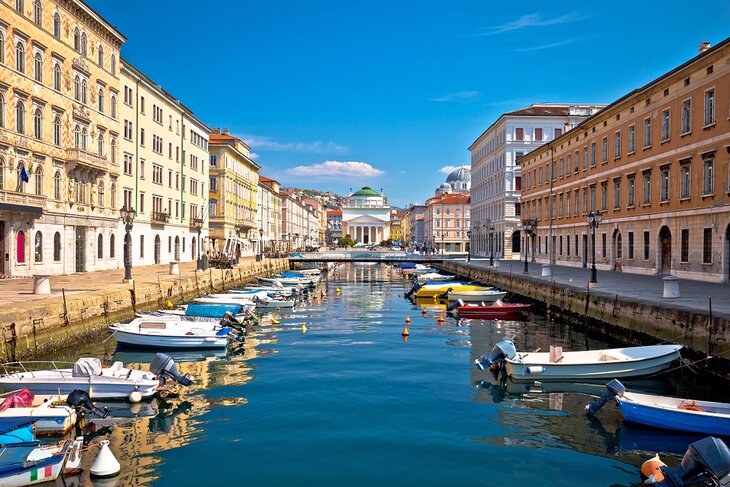
You'll notice bits of all this history in Trieste's colorful mix of people, languages, cuisines, attractions, and architecture, and other attractions, and it is the last of these that will strike you first. Grand buildings in traditional Habsburg style that would be at home in Vienna stand between those in Neoclassical, Baroque, Art Nouveau, and other styles, punctuated by a few remains of the Roman city of Tergeste.
All these arrange themselves in a near-perfect setting of broad streets and squares facing the Adriatic. At the heart of this is the Canale Grande , a wide basin that extends into the city and reflects the colors of elegant buildings that line its banks. The most important places to visit are in this busy central area. As you explore Trieste, be sure to stop and enjoy its lively café scene.
Plan your days of sightseeing in and around the city with our list of top attractions and things to do in Trieste.
See also: Where to Stay in Trieste
1. Piazza dell'Unità d'Italia
2. castello di miramare, 3. castello di san giusto, 4. museum riseria di san sabba, 5. museo revoltella, 6. stroll along the molo audace and harbor, 7. cattedrale di san giusto, 8. canale grande and san spiridione, 9. savor trieste's coffee culture, 10. take a day trip to lake bled and ljubljana, 11. teatro romano (roman theater), 12. see the panorama from faro della vittoria, 13. explore the grotta gigante, 14. take a day trip to predjama castle and postojna cave, 15. museo civico di storia naturale (museum of natural history), 16. museo del mare (maritime museum), 17. explore gorizia on a day trip, where to stay in trieste for sightseeing.
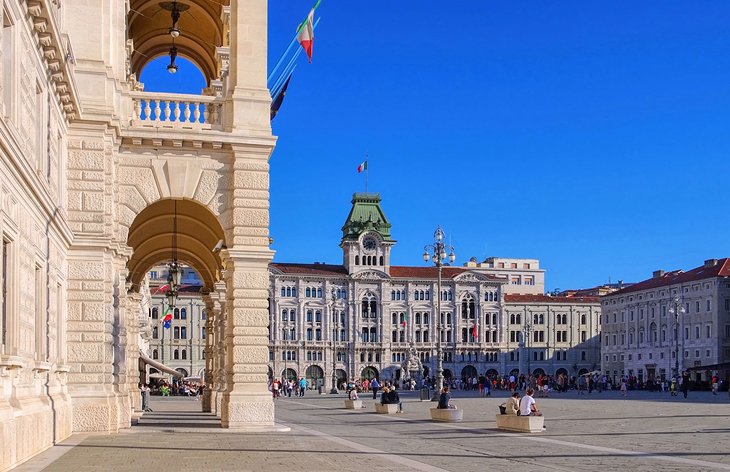
The largest square in the older part of Trieste is the Piazza dell'Unità d'Italia, facing onto the harbor. On its north side is the Palazzo del Governo (1904), on the south side, the massive 1882 palazzo of Lloyd Triestino, a shipping line founded in 1836 as the Austrian Lloyd company.
On the east side, the 1876 Palazzo del Municipio (City Hall) completes the square in late 19th-century harmony. Northeast of the Piazza dell'Unità d'Italia, the Teatro Verdi faces the water. For good views of the town and harbor, cross to the Molo Audace , the pier opposite the theater.
For more information on the best places to visit, stop in the Trieste tourism information office, located in the piazza.
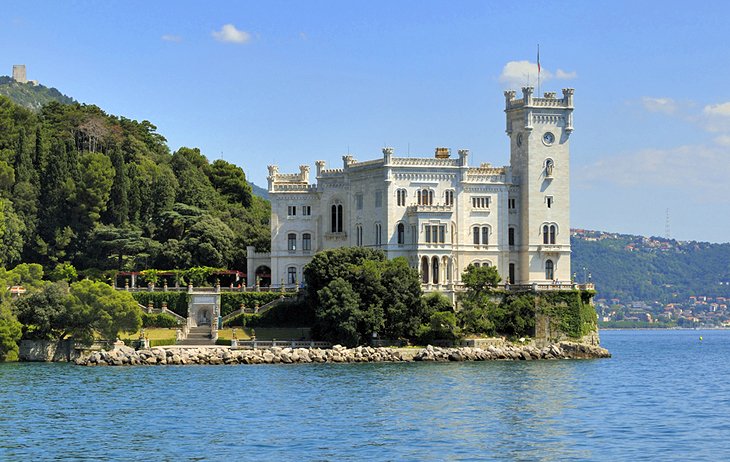
This white fairy-tale palace was built for Archduke Maximilian of Austria and his wife Charlotte of Belgium in 1855-60, before they went off to become (briefly) emperor and empress of Mexico. It stands above the sea, with views artfully framed by almost every window in its sumptuously decorated and furnished rooms.
Along with the interior, tour the terraced gardens in the park for even more magnificent views over the Adriatic. The 54-acre grounds, designed by the archduke himself and now protected as the Parco Marino di Miramare , are filled with tropical and exotic trees and plants.
Address: Viale Miramare, Trieste
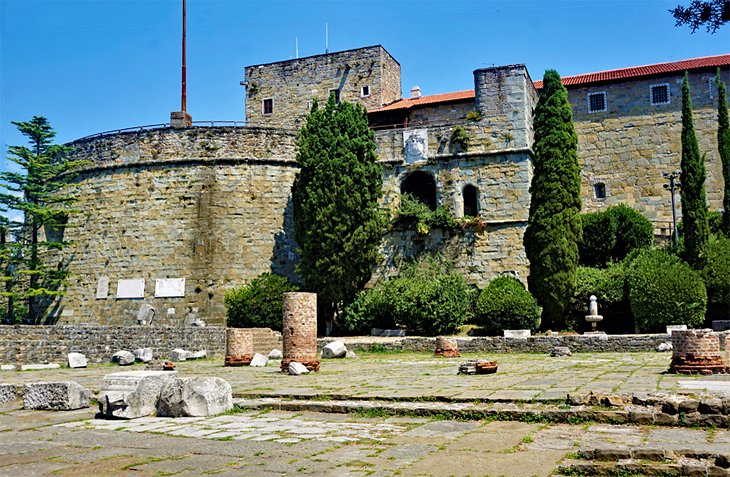
Crowning San Giusto Hill is the castle, built by the Habsburgs in the 15th to 17th centuries to enlarge a medieval Venetian fortress that replaced earlier Roman fortifications. Enter the castle over a wooden drawbridge across a narrow moat to explore its vaulted halls and climb to its ramparts.
The views are panoramic, covering the city, the Gulf of Trieste, and the surrounding hills. Inside the castle are displays of weapons from medieval times to the 19th-century, as well as furniture and tapestries; the Lapidario Tergestino contains 130 Roman stone finds from the city, including statues from the amphitheater.
Halfway up Castle Hill, at Piazza San Silvestro, stop to admire the Baroque interior of the 17th-century Jesuit church of Santa Maria Maggiore .
Address: Piazza della Cattedrale 3, Trieste
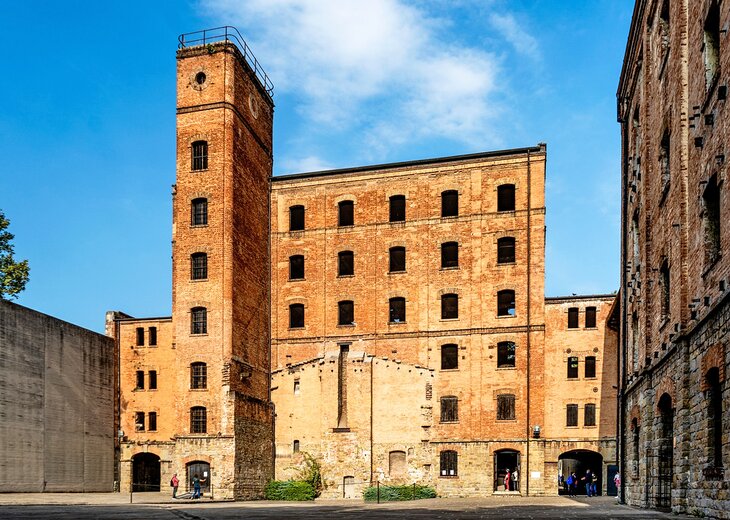
Touching, often heartbreaking mementos and documentation that recall the horrors of the Nazi occupation of Trieste fill this former rice processing factory that became a concentration camp during World War II.
Here, the Nazi police carried out their systematic killing of partisans, political prisoners, and Jews, as well as processing other detainees before deportation to concentration camps in the Reich. Property confiscated from Jewish families in Italy, Croatia, and Slovenia was stored here, as well.
Visitors interested in World War II history might also want to look into the tours of the underground shelters built by the Germans to protect the German governor and army and select civilians from bombing raids in the latter days of the war. Known as Kleine Berlin (Little Berlin), this network of shelters is not a museum, but tours are conducted once a month by volunteers. Consult the tourist office for information.
Address: Via Giovanni Palatucci, 5, 34148 Trieste
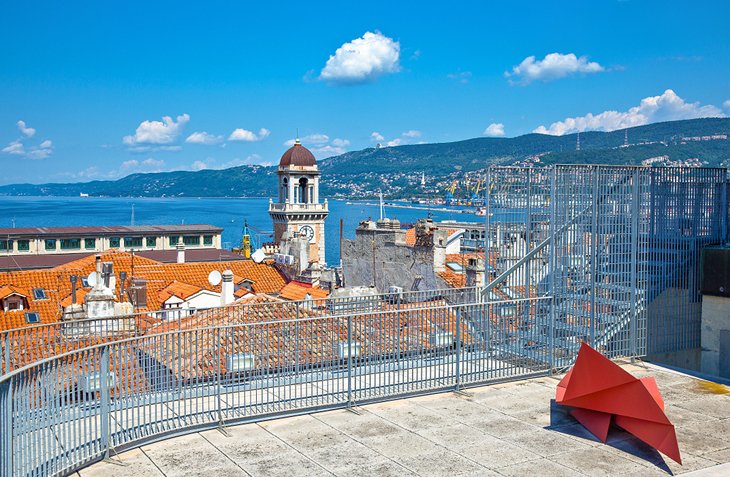
At the corner of the Piazza Venezia, the Museo Revoltella is one of Italy's major museums of modern art, with more than a thousand paintings and 800 sculptures, as well as prints and drawings. Its six floors and 40 rooms cover all the major movements from the mid-1800s through to the modernists.
The collections include works by nearly all the most significant names in 20th-century Italian art: Carlo Carrà, Giorgio Morandi, Lucio Fontana, and Mario Sironi among them - and it is fitting that the renovation of the adjacent Brunner Palace, completed in 1991, was designed by the preeminent Italian architect Carlo Scarpa. There is a beautiful view of the harbor from the museum's terrace.
Address: Via Armando Diaz, 27, 34123 Trieste TS, Italy
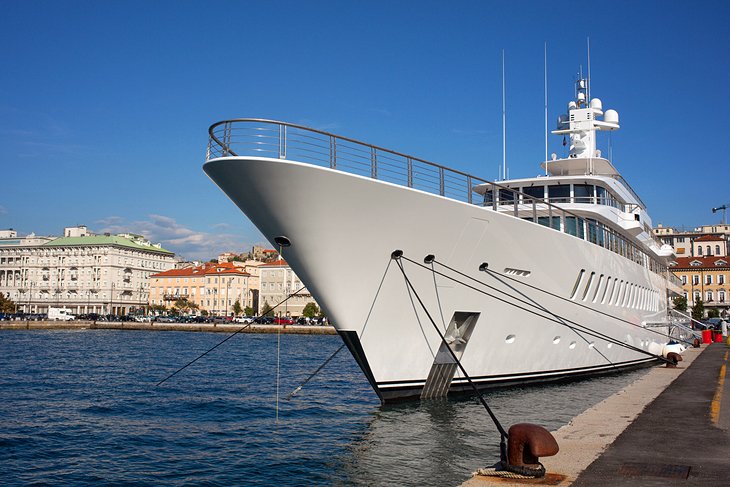
Trieste spreads around and above its harbor like a giant amphitheater with the Adriatic as its stage. Wide boulevards run along its perimeter connecting the four piers and long breakwater of the old port of Punta Franco Vecchio on the north with the Campo Marzio station and the Punto Franco Nuovo (New Free Port) and large shipyards to the south.
Along the harbor are a succession of large squares and the Canale Grande . Tourists join locals to catch the breeze and watch the sunset from the long Molo Audace , a pier that extends more than 250 meters into the Adriatic. There are beautiful views of the city from here, too.
Several tourist attractions are along the harbor, including an aquarium, railway museum, and the maritime museum. The harbor is always your best landmark if you lose your way.
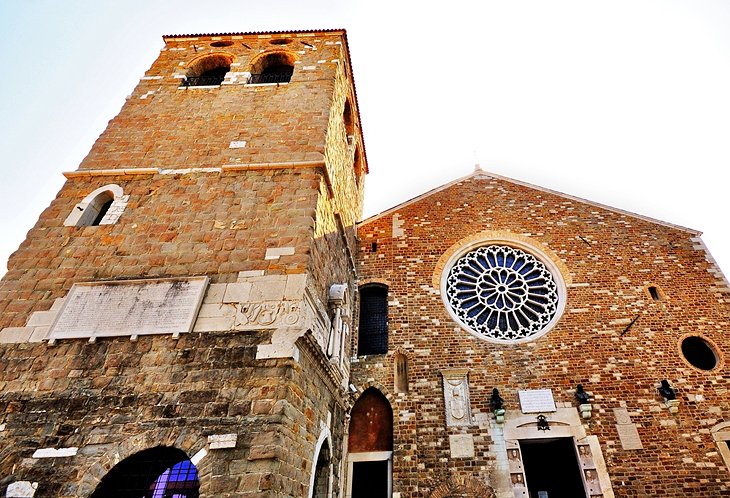
The cathedral of San Giusto was formed in the 14th century by combining two churches from the 6th and 11th centuries. On the right was the church of San Giusto and on the left, Santa Maria; their side aisles were combined to make the cathedral's central aisle (the nave).
Along with the two churches, bits of Roman stonework were recycled into the building - look for them in the doorway and the campanile. Look also for the excellent mosaic work from the 7th and 12th centuries in the altars at the end of the side aisles. To fully appreciate them, you can activate the lights for a '1 coin.
In the cathedral are the tombs of eight House of Bourbon claimants to the Spanish throne, who were promoted by the Carlist movement. You may hear another note of European history ring out here, as the cathedral bell was cast in 1829 from a cannon left by Napoleon.
His troops had fired cannon balls at the cathedral, some of which you can still see imbedded high on the façade. Outside are the remains of the second-century Roman forum and a first-century temple.
Address: Piazza Cattedrale 2, Trieste

North of Piazza dell'Unità d'Italia is the Canale Grande (1756), a long harbor formerly used by sailing ships, and now filled with small boats. Cafés line the wide walkways at either side, and behind them stand beautifully maintained buildings.
Relax or stroll here at any time of day, but be sure to return in the evening, when the lights and reflections shimmer on the water. The area was a favorite of James Joyce, who lived in Trieste from 1904 to 1915. He is commemorated by a statue on one of the bridges across the Canale Grande.
The canal was once longer, but the upper end was filled in to create Piazza Sant'Antonio. Above the square stands Trieste's largest church, the Neoclassical Sant'Antonio, built in 1849. To the right is the Serbian Orthodox church of San Spiridione , built in 1868 and reminiscent of Byzantine-style Eastern churches.
Along with frescoes and paintings, the church contains four outstanding early 19th-century Russian icons in the iconostasis, covered in gold and silver. The large silver candelabrum in front of the iconostasis was a gift of a Romanov Grand Duke.
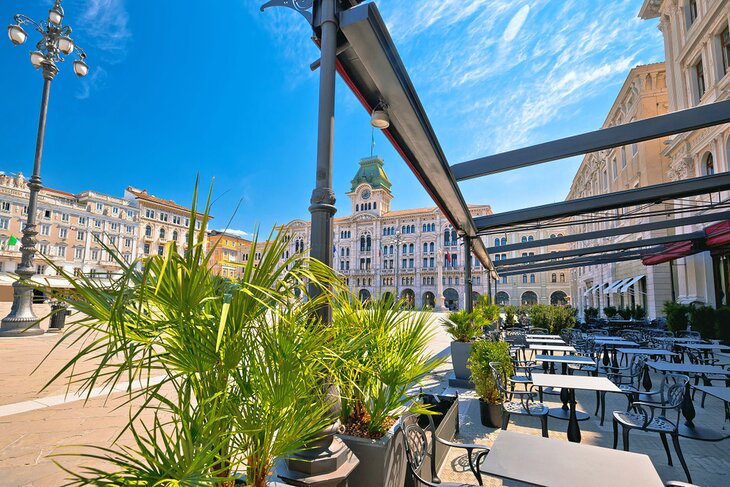
Trieste's position as the main port for trade with the East also made it the Mediterranean's main coffee port, a position it still holds today. One of Italy's biggest coffee brands is based here, and coffee is a way of life.
Trieste is considered Italy's coffee capital , and its café scene rivals that of even Vienna. All along the seafront and in almost every piazza, café tables spill out into the street, and they seem to be perpetually full. Unlike other Italian cities, where coffee is usually downed at a bar, in Trieste it's all about sitting down and savoring it.
Cafés are the center of social life. Become a part of the local scene by spending time in one — or several — of these. And go inside, even if the weather is beautiful outside. The cafés are elegantly decorated bastions of leisurely living, and worthy of a place on your sightseeing agenda.
Sink into a red leather chair at Caffè degli Specchi, overlooking Piazza Unità d'Italia since the early 1800s, or the nearby and equally historic Caffè Tommaseo . Order a caffelatte , the Trieste term for a cappuccino, and enjoy some people watching.
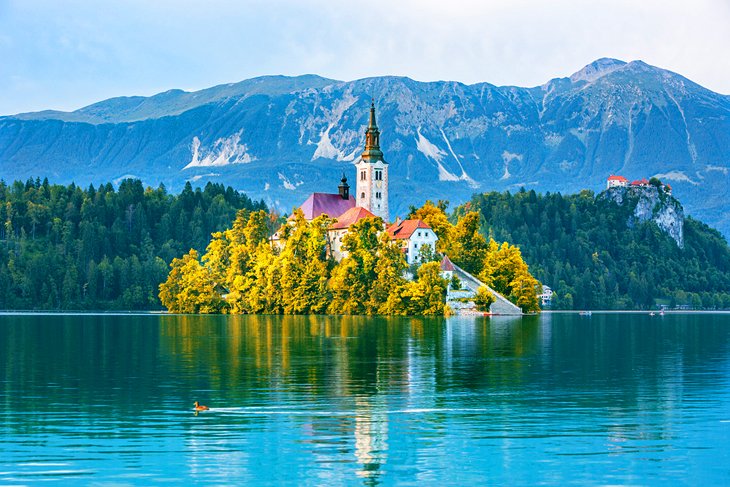
One of the most idyllic spots in neighboring Slovenia, Lake Bled, is only about 100 kilometers from Trieste. The beautiful, clear glacial lake sits under a background of a mountain range, with a pretty village along its wooded shore and a postcard-perfect island set in its center.
The island rises to a beautiful spired Gothic church. Swans swim in the lake, and walking paths lead along its shore from the village, where the 12th-century Bled Castle perches atop a steep 130-meter cliff above the lake.
Although you can get here by bus via the capital city of Ljubljana , itself worthy of a visit for its unique architectural heritage, the easiest way is to combine the two attractions on the seven-hour Lake Bled and Ljubljana Tour from Trieste . After a pickup from your hotel or the harbor and a ride through the Slovenian countryside, you'll explore Ljubljana on a guided walking tour, seeing Ljubljana Cathedral, Prešeren Square , the Town Hall, Triple Bridge, Shoemakers' Bridge, and other landmarks. From here, you'll travel to Lake Bled, where there's plenty of time to walk along the shore and explore the village.
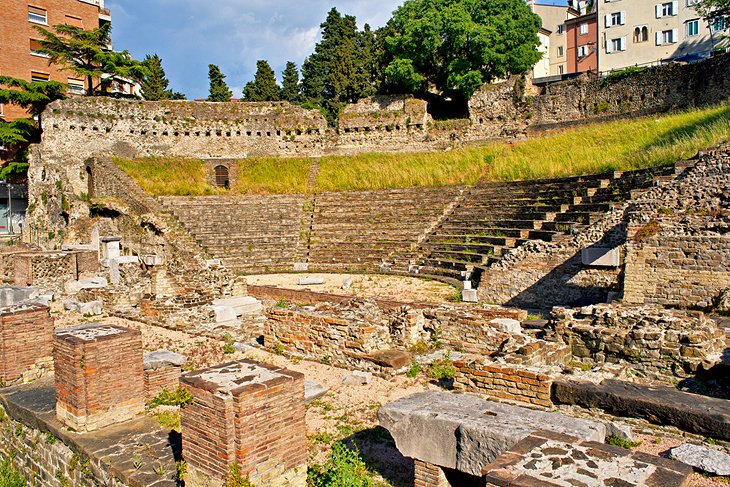
Leave the "modern" elegance of Trieste's waterfront and follow the broad Via del Teatro Romano southeast from Piazza dell'Unità d'Italia to the Roman theater, built in the first century AD, when the Romans were busy developing Tergeste at the orders of Emperor Octavius.
The stone theater uses the slope of the San Giusto hill as its base, and the upper steps and the stage were probably made of wood. You can see some of the statues that adorned the theater, which was brought to light in the 1930s, in the Castello San Giusto .
Several other tourist attractions are on this hill, which is the old city of Trieste, with narrow winding streets and venerable buildings, quite a contrast to the Austrian-Hungarian part of the city below. It's a nice place to stroll, and if you're wondering where to eat in Trieste, you'll find a number of restaurants and cafes here.
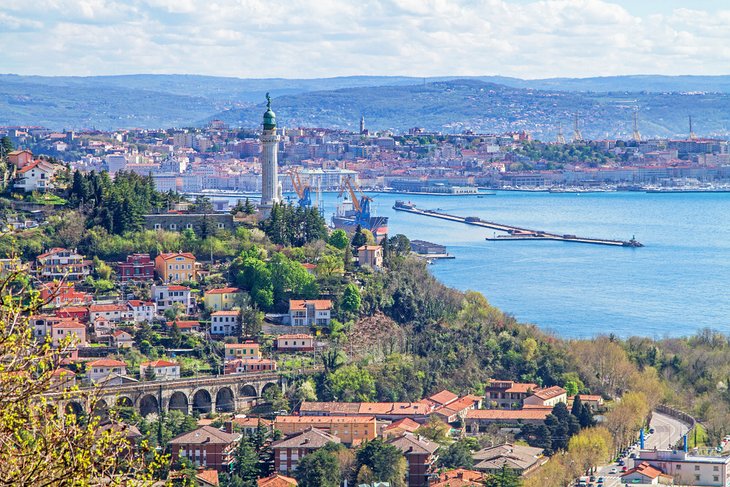
Both a monument and a working lighthouse, Faro della Vittoria was built after World War I, commemorating those who had died at sea during the war, and celebrating Trieste's joining the Kingdom of Italy following its long occupation by the Austrian Empire.
The location, too, has symbolic significance, as the lighthouse stands on the foundations of an important former Austrian fort. Atop the lighthouse, a seven-meter-tall statue of the Winged Victory holds a raised torch in one hand, a laurel branch in the other.
Below, standing against the base of the tower is an 8.6-meter statue representing an unknown Seaman, also created by sculptor Giovanni Meyer. Below the statue is the anchor of the destroyer Audace, commemorating the historic entry of the first Italian ship in Trieste.
The lighthouse is often open to visitors, who are treated to panoramic views of the harbor, the city, and the Adriatic Coast.
Address: Str. del Friuli 141, Trieste
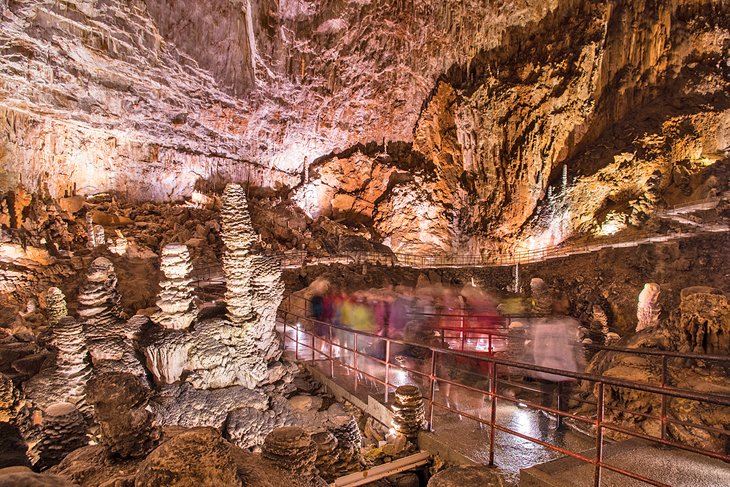
The 50-minute guided tour of this karst cave, about 20 kilometers from the city center, cannot possibly show you all of it. But you'll be impressed as you stand inside the main underground chamber, which is 98 meters high, 76 meters wide, and 167 meters long.
This and other galleries you'll see are studded with stalactites and stalagmites in all sorts of colors and convoluted shapes. Until 2010, the Guinness Book of Records listed Grotta Gigante as the largest cave in the world that's open for tourists, but the record was broken with the opening of La Verna cave in southwest France.
Bring a jacket, as the temperature inside never goes above 55 degrees.
Location: Borgo Grotta Gigante 42, Sgonico, Trieste
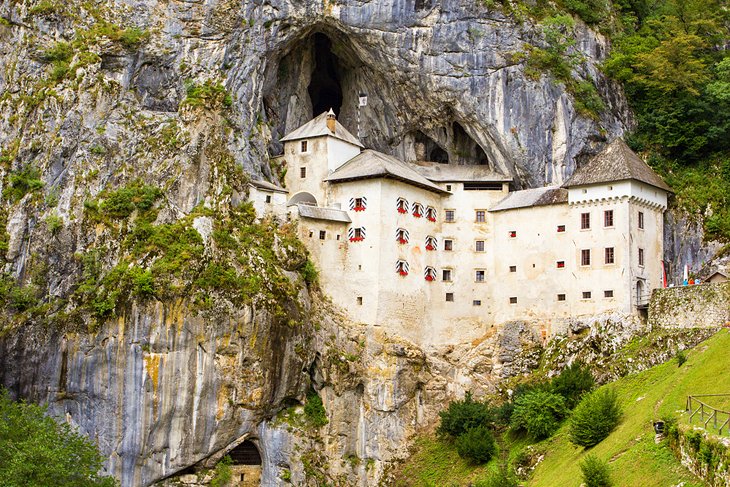
Only a few minutes apart, and 48 kilometers from the city center in neighboring Slovenia, the 800-year-old Predjama Castle and Postojna Cave are among the most popular places to visit near Trieste.
Close to the pretty little village of Predjama, the castle is an amazing sight, built high on a vertical 123-meter-high cliff, set right into the mouth of a giant cave. So good a defensive position was this that it withstood a siege of more than a year, thanks to an underground water source and supply tunnels inside the network of caves.
Part of the same karst cave system, the nearby Postojna Cave is one of the world's largest karst caverns and the only one of its size that can be toured on an electric train. The tour takes you on a route through a web of tunnels, passages, and fantastic galleries filled with a variety of diverse features and amazing colors.
A convenient way to see both these attractions is on the five-hour Postojna Cave and Predjama Castle from Trieste tour , which includes guided visits and entrance fees to both these attractions and pickup from your Trieste hotel.
The prize of this excellent museum has to be the fossil of a 3.6-meter-long hadrosaurus found near Trieste, almost entirely intact and anatomically connected. Its other paleontology exhibits are worthwhile, and there is a section on the evolution of hominids (humans and their fossil ancestors), with the skull of the Man from Mompaderno, which was found in Istria in the late 1800s. Along with the fossils themselves are casts of important fossil hominids, including the famous "Lucy."
The zoological exhibits show mammals from all over the world, as well as fresh and saltwater fish, corals, reptiles, amphibians, and birds. There is a good mineral collection and a large exhibit on local plants and those from elsewhere in Italy and the Adriatic.
Address: Via dei Tominz 4, Trieste
Ship models, many of them works of art in themselves, make up much of the collection in the Museo del Mare , which focuses on the sailing ships of the Adriatic and Tyrrhenian Sea, as well as fishing craft through the ages. Along with beautifully crafted models of sailing ships are intricately detailed models of some of the most prestigious cruise liners in history, commissioned to convince shipping companies to invest.
The exhibits are not all models. There is one of only two known examples in the world of the "zopolo," an ancient dugout canoe used in the Mediterranean, and made by hollowing out a single log. A highlight is the collection of ancient nautical instruments, showing ancient cross-staffs, and the original wireless key used by Guglielmo Marconi.
Even rowing gets a nod, with the boat that delivered the first Olympic gold in the sport.
Address: Via Campo Marzio 5, Trieste
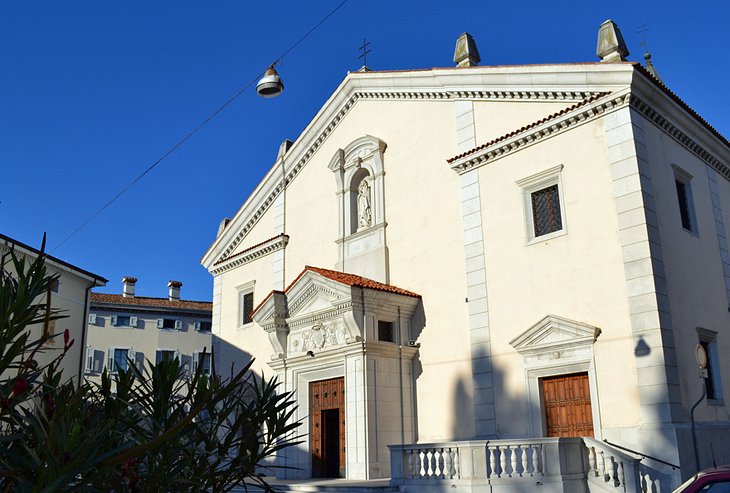
The old town of Gorizia was part of Austria until 1918 and was largely destroyed in the First World War. In 1947, the eastern suburbs were transferred to what was then Yugoslavia, and are now part of Slovenia, known as Nova Gorica. At the foot of the castle hill is the triangular Piazza della Vittoria , with the 17th-century Jesuit church of Sant'Ignazio.
South of this is the Gorizia Cathedral, whose origins are 14th century, but which was completely rebuilt in 1927. Notice especially, the angels on the ceiling of St. Acathius' Chapel, painted in the mid-15th or early 16th century. The cathedral treasury contains gold and silver works of the 12th to 14th centuries.
Address: Piazza del Duomo, Gorizia
We recommend these highly rated hotels in Trieste close to the city's top sites:
- Starhotels Savoia Excelsior Palace : The grand luxury hotel has bay views from its spacious and elegantly decorated guest rooms. These have marble bathrooms, and the fitness center has a sauna and offers spa services.
- NH Trieste : With mid-range pricing and a great location, the hotel has a modern décor and helpful front desk staff. Breakfast is included in the rate.
- Hotel Residence L'Albero Nascosto : The 3-star boutique hotel is furnished with antiques and serves excellent espresso.
- Nuovo Albergo Centro : This owner-run budget hotel has a bright décor and comfortable beds. Guests can choose between rooms with private or shared baths.
More Related Articles on PlanetWare.com
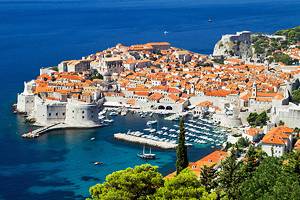
Places to Visit near Trieste: This far eastern corner of Italy, known as the Friuli-Venezia Giulia, is still one of Italy's secrets, stretching northeast from Venice through scenic foothills into the ski resorts of the Dolomite Alps . Even closer to Trieste, heading south through a narrow strip of Slovenia are the Adriatic beaches and historic cities of Croatia .
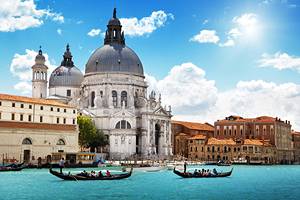
In and around Venice: Trieste is only a two-hour train ride from Venice, where you could spend days exploring St. Mark's Basilica , the palaces along the Grand Canal or gliding through Venice on a gondola. After exploring the attractions in Venice , you'll find plenty of nearby adventures in our list of top day trips from Venice .
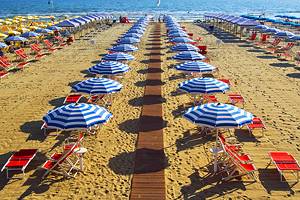
Italian Vacation Ideas: Visitors who enjoyed exploring the lovely seaside gardens at Miramare can find other beautiful gardens in Italy , and if thoughts of Adriatic beaches appeal, refer to our list of Italy's best beach resorts . For insider advice on seeing the top attractions in Italy , whether traveling by train, bus, or car (even by boat), see Plan Your Trip to Italy: Top Itineraries.

More on Italy


Home » Travel Guides » Italy » 15 Best Things to Do in Trieste (Italy)
15 Best Things to Do in Trieste (Italy)
At the easternmost region of Italy, there is a small strip of land that borders with Slovenia – This is the Friuli Venezia Region and has a distinct style, culture and history that is quite different to the rest of mainland Italy. Trieste is one of the largest cities within this beautiful region and sits on the coast between the Adriatic Sea and Slovenia. Due to its proximity to other nations and regions, Trieste has been influenced over the years by various other cultures and civilizations. The city has a current population of 204,000 and is one of this richest economical places in Italy due to its extensive port and commercial shipping trade.
Trieste has been inhabited since the second millennium BC and was part of the Roman Republic. Once the Roman Empire had declined, Trieste became a free commune and then was subsequently part of the Hapsburg Empire and resisted many sieges and attacks by the Ottomans throughout the Middle Ages. Although the city saw decline during WW2, it underwent a huge economic revival in later years and its ports were developed extensively. Today, Trieste has a pleasing mix of historical buildings and Piazzas, stunning seaside locations and interesting Museums that make it a premier tourist destination in this region of Italy.
Lets explore the best things to do in Trieste :
1. Trieste Harbour

The port and harbour of Trieste is truly impressive and rightly so as it serves as the cities principal form of economy.
Practically the entire coastline next to Trieste is occupied by either the public harbour or the commercial shipping operations – These two parts of the city offer some truly fantastic and interesting sights.
Near the Piazza Venezia is the main harbour and this area is filled with beautiful yachts, sailing boats and fishing boats.
Furthermore, the port area on the south western section of the coast offers a great insight into how a busy shipping operation works – You can see large cargo ships entering the docks and being offloaded.
2. Piazza Unita Italia

This colossal square lies at the forefront of the historic old town and faces out towards the Adriatic Sea.
Due to its immense size, the Piazza Unita italia is known as the largest square situated next to the sea in Europe.
Several prestigious and important buildings line the square including the Town Hall, the Palazzo del Lloyd Triestino, the Palazzo del Governo and the Palazzo Pitteri – Each of which features a stunning design and beautiful architecture.
Aside from the buildings, there is also several impressive monuments and statues placed at various intervals in the square – In particular, the two iron sculptured columns that frame the entrance of the Piazza.
3. Canale Grande

Located in the heart of the historic old town, not far from the Piazza Unita, the Grand Canal is a small waterway that has stood since the 1700’s to allow boats direct access into the city to unload their cargo.
Approximately 200m in length, the canal stretched from the Riva Tre Novembre to the Via S. Spiridione and ends at the Piazza Sant’Antonio Nuovo and the Chiesa di Sant’Antonio Taumaturgo.
This pleasant waterway is crossed by three bridges and has numerous boats moored at each side.
Surrounding the canal is a series of fine buildings including the Palazzo Carciotti and the Palazzo Gopcevich.
Furthermore, there is a selection of restaurants and cafes with outdoor seating.
4. Trieste Roman Theatre

Trieste has a long and celebrated history and throughout the city there are various remnants of bygone eras.
One such relic is the Roman Amphitheatre that is located on the Via del Teatro Romano In the centre of the historic old town and only a stone’s throw from the Piazza Unita Italia.
This ancient structure is in a fantastic condition and the original seating and stage area is still visible together with various columns and walls.
Original statues from the theatre are now on display at one of the local museums but some are still visible at the sight.
When walking through the city of Trieste, this theatre is a must see and is a fine example of Roman architecture.
5. Castle of Saint Giusto

Located next to Trieste Cathedral, the Castle of Saint Giusto is an ancient structure that has stood for many years and is one of the cities icons.
This structure now serves as a museum and was originally created in the 15th century by the Hapsburgs.
Built on the Capitoline Hill, the castle has a commanding view over the city and has an extremely strategic location.
Today, the castle stands in fine condition and it is possible to climb up to the top of the tower for amazing panoramic views of Trieste and its ports.
Inside the main keep there is a fine display of artefacts and information about the history of the castle including military banners, coats of arms and an armory with a wide variety of ancient weaponry.
6. Cathedral of Saint Giusto

Also known as Trieste Cathedral, this church is dedicated to Saint Justus and serves as the main church of the city.
Originally constructed in 1320, the church features a Romanesque and Gothic design and the front façade has a huge circular window with a beautiful lattice design.
Inside, the church features a plethora of decoration and the archways in the main aisle are covered with coloured patterns and ornate sculptures.
Furthermore, the dome of the main altar is covered with a stunning fresco that is bursting with a myriad of bright colours.
There are also several mosaics and works of art depicting the Our Lady of the Assumption.
7. Grotta Gigante

To the north west of Trieste approximately 20 minutes by car is the Grotta Gigante.
As the name implies, the Grotte Gigante is a gigantic cave.
Its central cavern is over 100m high, 65m wide and 130m long which makes it one of the largest tourist caves in the world.
Throughout its known history, this cave has been in the Guiness Book of Records, and a 4 person hot-air balloon has even flown through it! Today, guided tours are available of this immense natural phemonenon and your tour guide will explain about its history and the various features of the cave including the stalactites and stalagmites.
If you visit this cave, ensure to take a jacket as the underground temperatures are not favourable!
8. Miramare Castle

Although not an ancient castle, this building and grounds is still a fantastic place to explore and has to be the most picturesque castle in this region of Italy.
Created in the 19th century, this castle is located approximately 15 minutes to the north west of Trieste in the small village of Grignano.
The structure itself is immensely beautiful with white-washed walls and decorative crenulations.
Furthermore, the grounds of the castle feature extensive gardens and woodland that you can explore.
Due to the position that Miramare Castle faces, the sunsets here are particularly beautiful – Looking out across the Gulf of Trieste the sun lights the sea and sky up in a beautiful display of colours.
9. Museo Del Mare

Trieste is a city that has an extensive seafaring history – For hundreds of years it has maintained a huge naval and commercial shipping port and the Gulf of Trieste has been the sight of many naval conflicts throughout history.
To understand this rich naval history, the Museo del Mare provides a wealth of information and interesting displays about how the ports and naval operations at Trieste evolved.
Here you can find a myriad of beautifully crafted model ships, cross sections of various different parts of vessels such as the hull and anchor, and also a variety of equipment salvaged from historical ships.
The Museo Del Mare is a great place to visit whilst down at the Harbor to gain and insight into the history of Trieste.
10. Carso Triestino

This area of Trieste lies in close proximity to the Val Rosana and is a fantastic place to admire the scenery and take some stunning photographs.
Various mountains, rocky outcrops, forested glens and deep valleys offer numerous hiking and cycling options.
Mount Carso is the main mountain here and it is possible to scale the peak and gain superb views of the surrounding countryside.
If you wish, you can also travel into Slovenia and visit some of the small bordering villages such as Kozina and Nasirec.
11. Molo Audace

The Molo Audace is a fascinating promenade in the heart of Trieste and sits directly next to the end of the Piazza Unita Italia.
Stretching out towards the sea for approximately 300m, this stone paved promenade allows tourists and locals alike a place to admire the coastal scenery of Trieste and even take a dip in the water if they wish.
Spread along the promenade is a series of benches and old iron mooring points.
From here you can look out to the sea, admire the extensive port system and skyline of Trieste and also take some fantastic photographs.
12. Piazza della Borsa

Located next to the Piazza Unita Italia, the Piazza dell Borsa is just as interesting and is a great place to take in the local life and enjoy a fine meal.
During the 19th century, this square actually served as the city’s economic centre and the chamber of commerce building is actually located at the far end and features a beautiful columned entrance with an ornate marble pediment.
Triangular in shape, at the end closest to the Piazza Unita, there are several restaurants and shops, whilst in the middle is a decorative statue of the sea god Neptune.
Markets and small fairs are sometimes held here and it is a great place for shopping and mingling.
13. Val Rosandra

Located on the Italian/Slovenian border, Val Rosandra is a natural valley that is cut through by the Rosandra River.
This valley is a beautiful part of the region and features some fantastic scenery, forests and mountain landscapes.
A main attraction of the valley is a 40ft waterfall that plummets over the stone cliffs down into the river below.
Starting from Bagnoli Superiore or Hervati, you can follow the trails and explore this region on foot – For the adventurous or the intrepid hiker; the Val Rosandra is the perfect place to be at one with nature.
14. Sistiana Bay

Approximately 20 minutes to the west of Trieste is the charming town of Sistiana which is a wonderful coastal resort complete with a harbour and several beautiful beaches.
Several hotels and resorts have been established here and there is also a selection of bars, restaurants and beach shops from where you can enjoy a fine meal or purchase some supplies.
The harbour is a fantastic semi-circular shape and the clear turquoise waters are simply divine.
Although the beach contains pebbles, the fine Mediterranean weather makes up for this fact and you can still comfortably sun bathe.
If you want to escape from the city, Sistiana Bay offers the perfect retreat.
15. Eat a fine Italian Pizza at the Al Barattolo Restaurant

Trieste has an abundance of fine restaurants, but no such finer establishment than the Al Barattolo that is located next to the Grande Canal and the Piazza Sant’Antonio Nuovo.
If you are looking for a delicious and authentic Italian Pizza then this is the place to go! Pizzas here are freshly prepared and cooked and you can choose from a variety of different toppings including the fan favourite Pepperoni.
Aside from Pizza, Al Barattolo also serves a variety of seafood dishes and has a wonderful selection of complimentary wine.
15 Best Things to Do in Trieste (Italy):
- Trieste Harbour
- Piazza Unita Italia
- Canale Grande
- Trieste Roman Theatre
- Castle of Saint Giusto
- Cathedral of Saint Giusto
- Grotta Gigante
- Miramare Castle
- Museo Del Mare
- Carso Triestino
- Molo Audace
- Piazza della Borsa
- Val Rosandra
- Sistiana Bay
- Eat a fine Italian Pizza at the Al Barattolo Restaurant
27 Best Things to Do in Trieste, Italy (PLUS Map, BEST Tours & Day Trips)
From italy's largest cave to coastline castles with epic sea views, here are the best things to do in trieste.
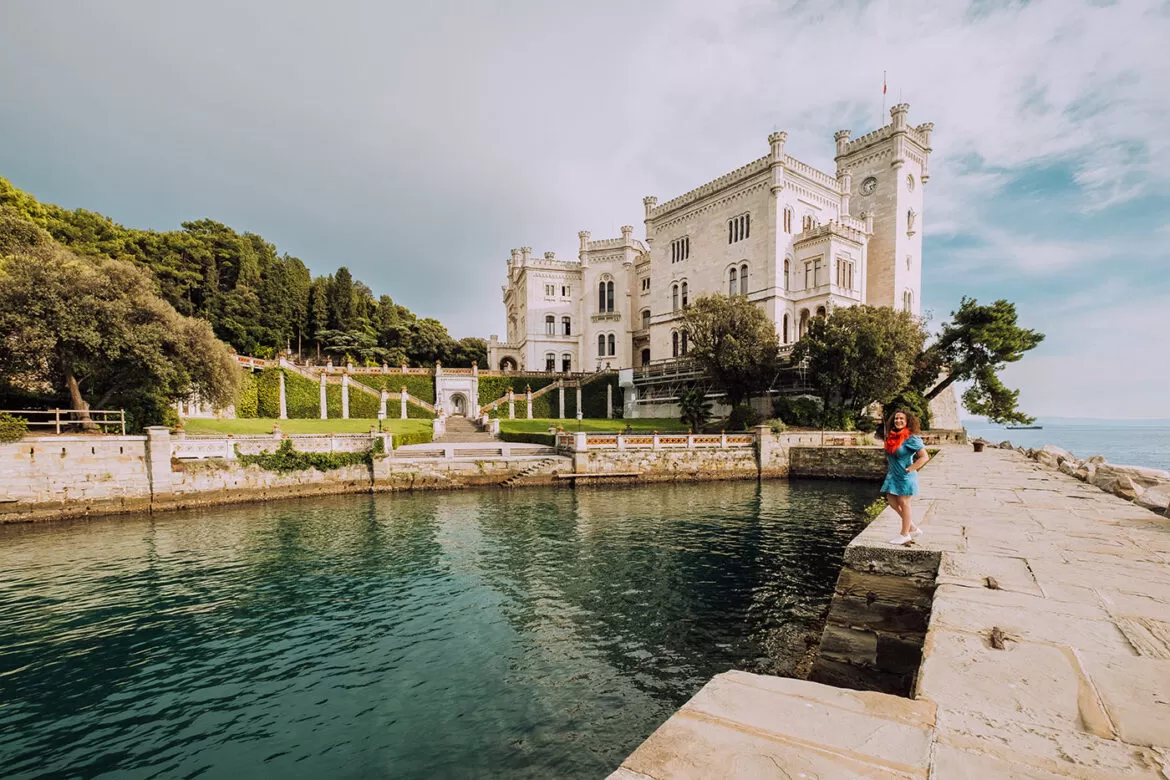
The City of Wind, Vienna by the Sea, and the City of Coffee are just a few expressions used to describe Trieste. Gorgeous, aristocratic, and distinctively cosmopolitan, this small city in the far northeastern corner of Italy checks all the boxes for curious travellers. While Trieste may not be at the top of your Italy bucket list, reading this guide on the best things to do in Trieste , you’ll see why it’s a real gem to explore.
Trieste is a charming port city and the capital of the region Friuli Venezia Giulia. Located just 8 km (5 mi) from Slovenia and 30 km (19 mi) from Croatia, Trieste is beautifully framed by a landscape of cliffs, karstic plateaus, and lush greenery. Plus, it boasts a border-town character that makes it truly unique.
The thing with Trieste is that it’s quite different from the image of Italy you are used to, and that alone makes it worth visiting! The city wasn’t always Italian. In fact, Trieste spent most of its history under the Habsburgs and the Austro-Hungarian Empire. Six hundred years to be precise: from the late 14th to the early 20th centuries, with some brief interruptions in between.
To help you plan your trip to Trieste, I’ve written a guide to the best hotels in Trieste plus this comprehensive guide on the best things to do in Trieste which includes everything from a city map to top city tours and recommended day trips.
Let’s go and experience the best things to do in Trieste! Andiamo! (Let’s go!)
Map of the best things to do in Trieste
Watch my video on the best things to do in trieste.
A brief history of Trieste
Inhabited since the 2nd millennium BC, Trieste developed with the Romans who founded a Military settlement in the 1st century BC to control the area and push out the Celtics and prevent invasions from barbarians on the other side of the alps.
The settlement was built on top of the hill, a strategic position chosen for its view of the area and coastline. Once safe, it became a colony and people began moving here from all around. There was a Roman Basilica, forum (the Roman version of a piazza or marketplace with shops), a temple, and a theatre.
I say Roman Basilica, but it’s not the kind of church you think of nowadays. A Roman Basilica was a public building where officials met and did business and enforced the law. Many centuries later, the Basilica of the Roman empire was used as an architectural module when Christianity was introduced and churches were built.
Later the area of Trieste fell under Byzantine and Frankish rule. Then, in the 12th century, it became a free municipality, but when its autonomy was threatened, the city placed itself under the protection of Leopold III of Austria in 1382. This marked the beginning of its long relationship with the Habsburgs.
Fast forward to 1719, the Hapsburg Empire declared Trieste a free port and spared no money to develop the city. After all, it was the only maritime gateway of its land-locked territories. During this time, Trieste blossomed as a key trading center, welcoming merchants and entrepreneurs from all over the Mediterranean and soon the city became a favourite destination of artists.
Until 1918 the Hapsburg monarchy was one of the Great Powers of Europe and Trieste was its most important seaport. At the beginning of the 20th century, Trieste became a major center of the irredentism (ee·ruh·den·tuh·zm) movement, which sought to annex to Italy all the lands that were not included in the unified Italian Kingdom although historically Italian. After the fall of the Hapsburg Empire after WWI and the end of the Nazi occupation following WWII, Trieste lived for a few years as an independent state under the protection of the UN before being officially annexed to Italy in 1954.
Today, this intricate patchwork of rulers, cultures, and people that shaped Trieste’s history is everywhere you look – from its varied architectural styles to its multi-faith soul and a truly unique culinary identity.
Why is it called Trieste?
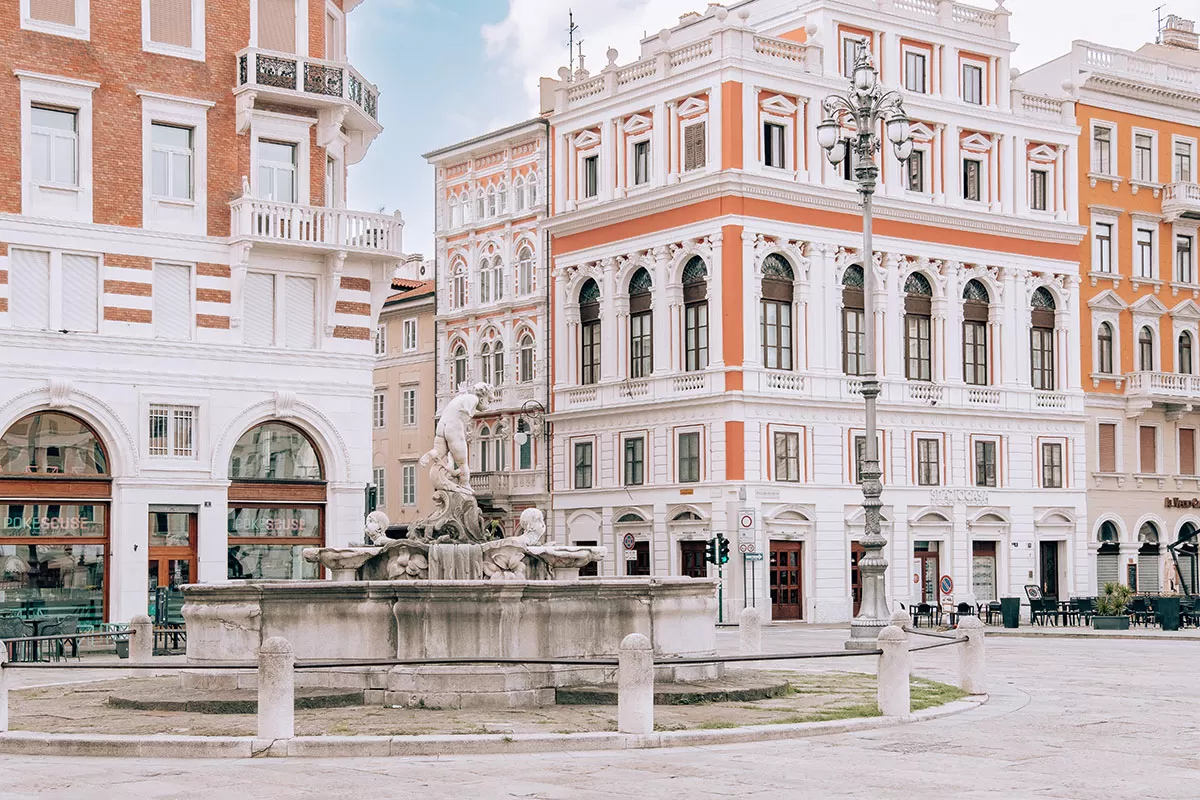
Giovannin Ponterosso Fountain in Piazza del Ponterosso
The name “Trieste: is derived from its ancient name “Tergeste”. Even though the Romans settled here, its name isn’t entirely Latin. Instead, it gives us a clue to the pre-Roman origins of the city, in the last phase of the local prehistory, and its economical importance.
One theory is that the place name “Tergeste” comes from “Ter” meaning three and “Egeste” meaning “to build” or” erect”, suggesting that the city was rebuilt three times. Another theory is that “Trg” comes from the Slavic language and means “square” or “market”, while “este” means “city” in Old Venetian, hence it could mean “market-city”.
Nowadays, Trieste goes by many names: “ Città della Barcolana ” (City of the Barcolana, a historic international sailing regatta) , “ Città della bora ” (City of the Bora, referring to the northerly to north-easterly katabatic wind), “ Città del vento ” (City of Wind), “ Vienna by the Sea ” and “ City of Coffee ” are just a few expressions used to describe Trieste.
Want to learn all about the city’s history while seeing the sights? Join the same private Trieste walking tour I did with the lovely Sonia.
How to visit trieste and travel around.
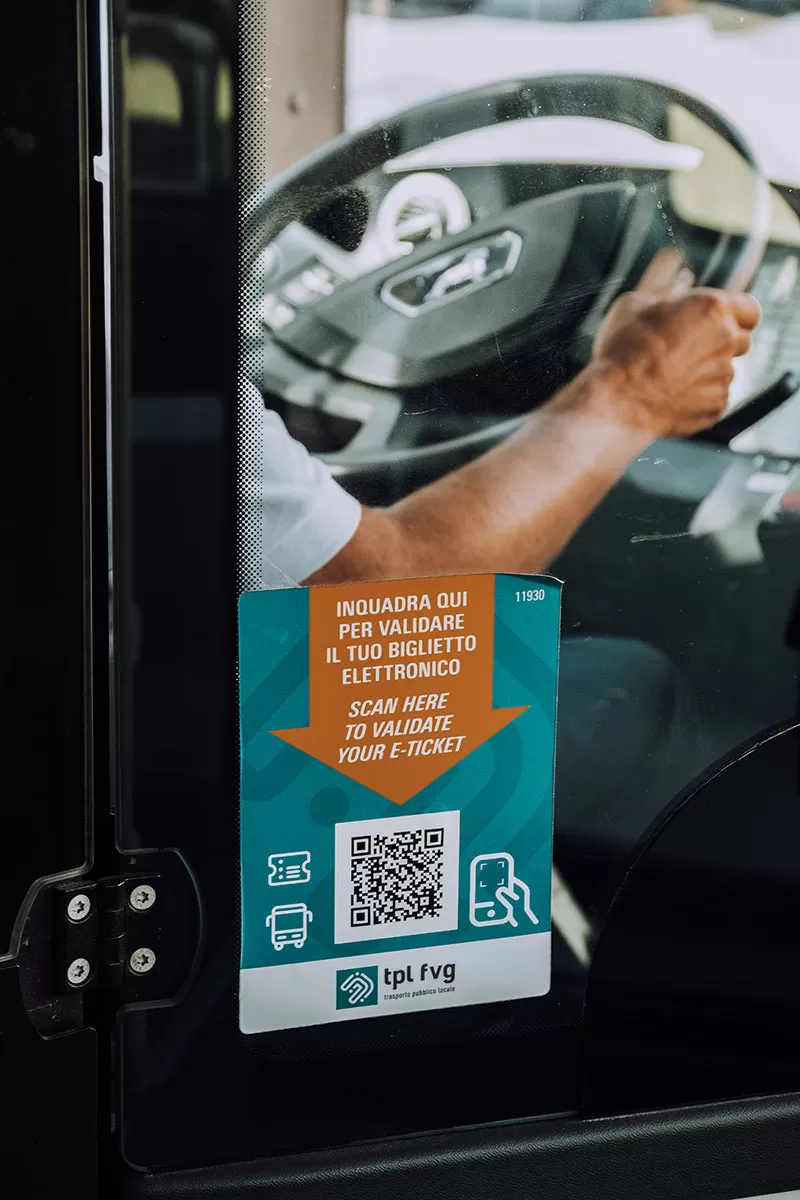
Download the FVG Mobile app
Trieste Airport is about 35km from the city and offers direct connections to 14 destinations in Italy and Europe, including Rome, London, and Frankfurt. Travelling by train is a great alternative, with daily high-speed connections to main Italian cities through Trenitalia and Italo . Trenitalia also has trains running between Trieste and Ljubljana. As for cars, while it’s true they allow you to maximise your time, you also have to be aware of the numerous Limited Traffic Zones (ZTL) located in the city.
Trieste is best explored on foot as it’s pretty compact and easy to navigate, plus most of the top sights are within easy walking distance. There’s a convenient bus network with single tickets starting at €1.35. For this, I recommend downloading the TPL FVG app so you can easily purchase single journey or daily tickets instead of having to hunt down a Tabacchiera every time. Bicycles can be rented through the city’s handy bike-sharing scheme (rides under 30 minutes are free). Finally, a ferry service ensures connections within the Gulf of Trieste.
27 Top things to do in Trieste
When it comes to tourist attractions, Trieste has many activities to enjoy. With its rich history and maritime tradition, the city’s attractions include anything from visually stunning architecture to culturally fascinating sights.
Below, I have gathered the best things to do in Trieste with tips and information that will help you plan your city break. It’s a good mix of top attractions and a few hidden gems. You’ll also find a Google map highlighting all the locations. Save this for later!
1. Take a tour of Miramare Castle
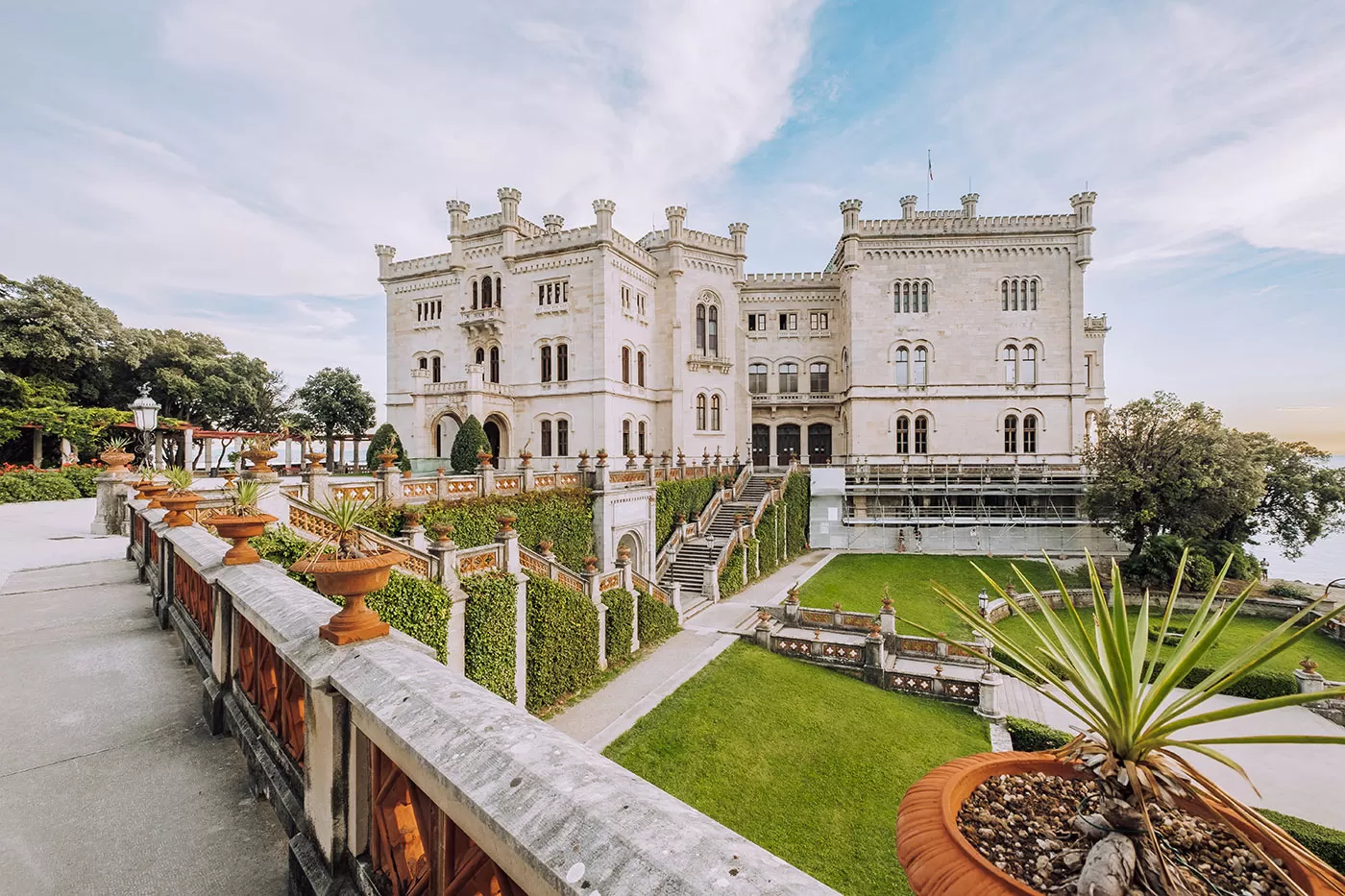
There’s no doubt that the Miramare Castle is on everyone’s bucket list of things to do in Trieste, and for good reason. Although it lacks the ancient history you’d expect from a castle (it dates from the mid-1800s), this white fairy-tale palace is a real beauty. So much so that it’s often listed among Italy’s most beautiful castles.
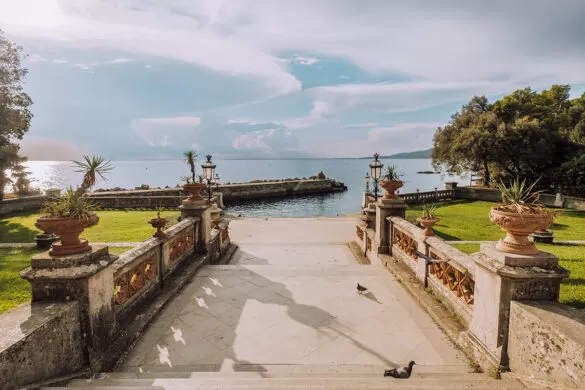
The Miramare Castle sits on a cliff overlooking the sea and boasts an eclectic blend of Gothic, Medieval and Renaissance styles, in line with the fashion of the time. Rooms dazzle with their sumptuous furnishings, while the 22-hectare park outside is filled with woodland and exotic trees. Plus, the castle’s unique location makes sunsets here a real treat.
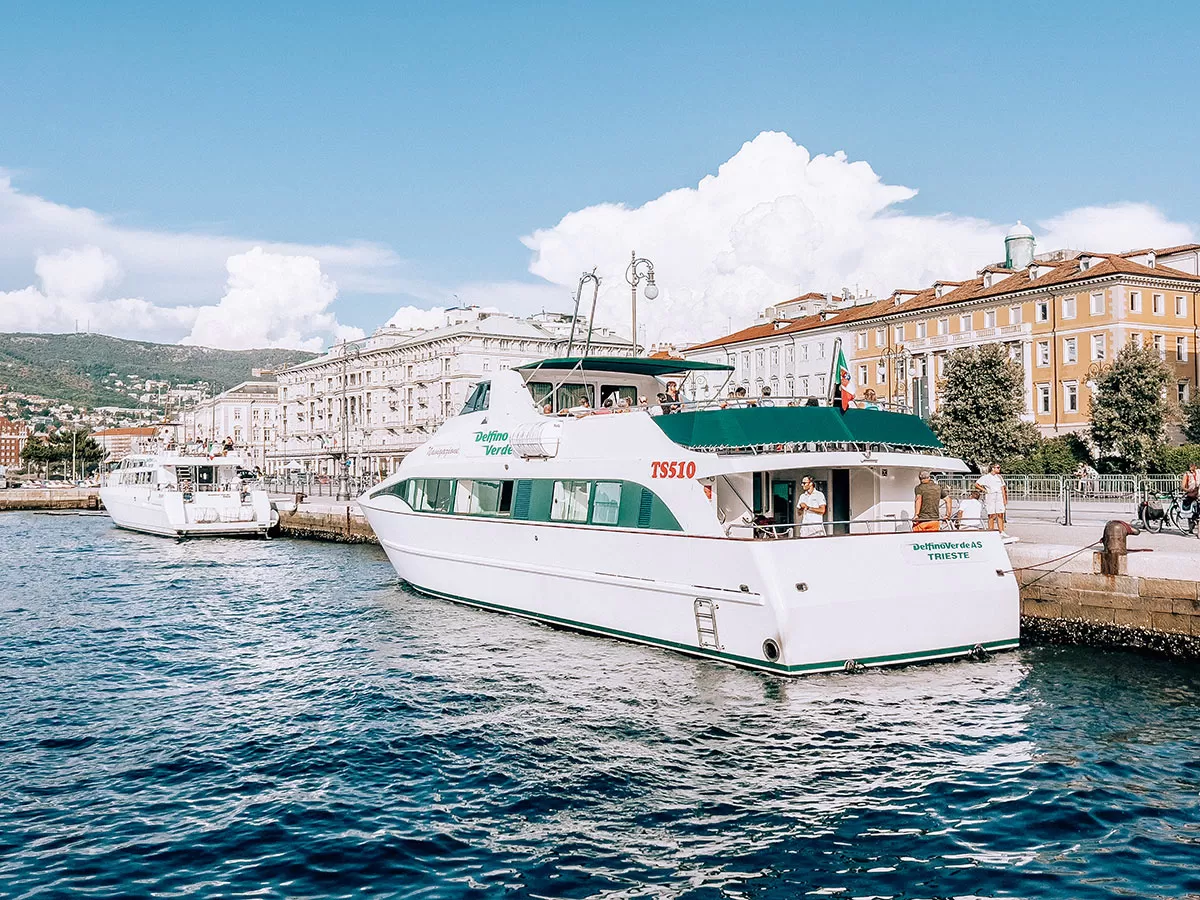
Don’t miss: reach the castle with a ferry boat to admire the castle in all its beauty from the sea. The line is called Delfino verde and operates in the summer months from the quay near the aquarium. Timetables are available here .
Join this experience that combines a panoramic tour of Trieste and Miramare Castle. The price includes transportation and admission to the castle.
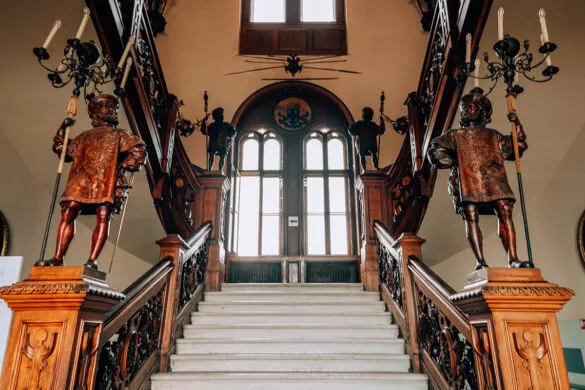
2. Arco di Riccardo
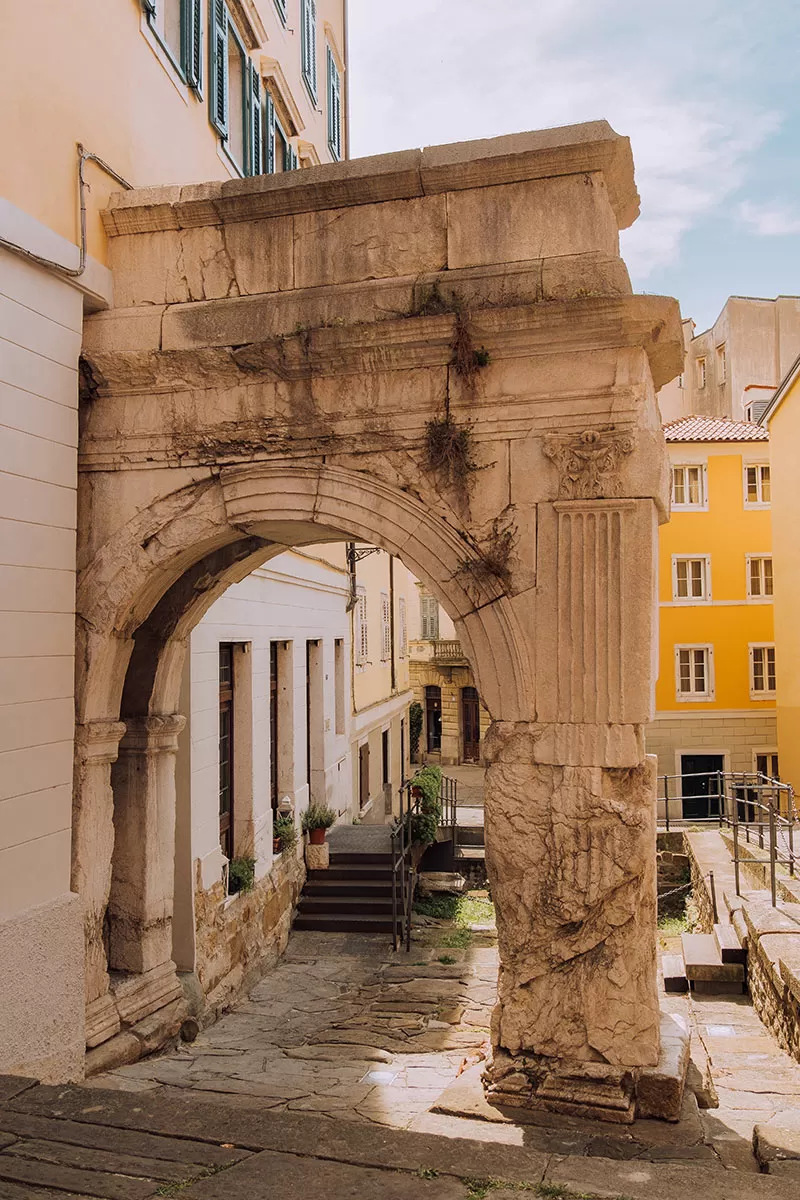
The “Arco di Riccardo” is one of the most important monuments in Trieste. Made of white stone from the cave of Aurisina it stands around 7 meters high. Dating from 33 BC, the arch is said to be a Roman gate in the city walls when the emperor Augusto established the Roman colony Tergeste . The gate was located along the main roman way that connect the sea to the hills.
The origins of its name are debated but there are several prevalent theories. The Riccardo , or Richard, might refer to English king Richard I the Lionheart, who was said to have been a captive in Trieste while on his way back north. Another theory is that it originates from the word cardo , which was the name of one of the two main roads of the Roman settlements and finally some refer to the term ricario , the name of a medieval courthouse, located in the area.
A local legend refers to the transformation of the name Carlo Magno , to whom the arch was dedicated after his passage on his return from his belligerent victories in neighbouring Istria. The truth? I guess we’ll never know for sure!
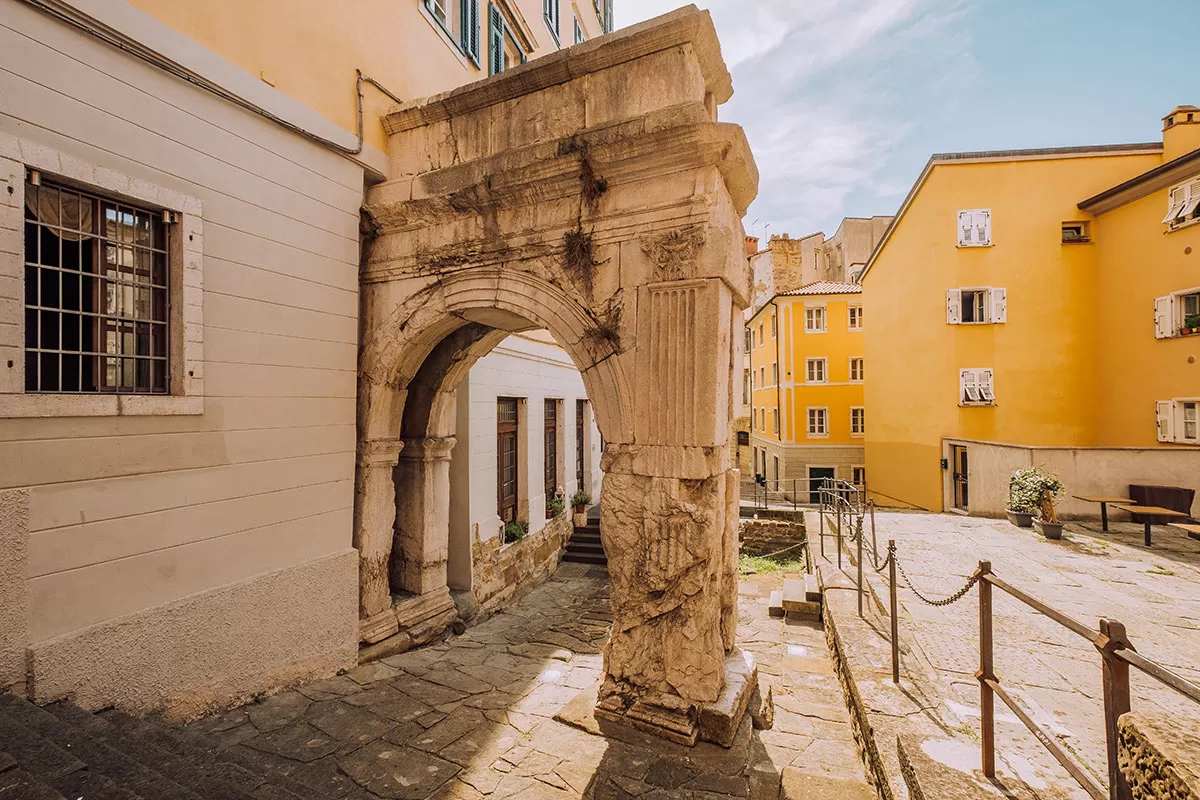
3. Visit the Duino Castle
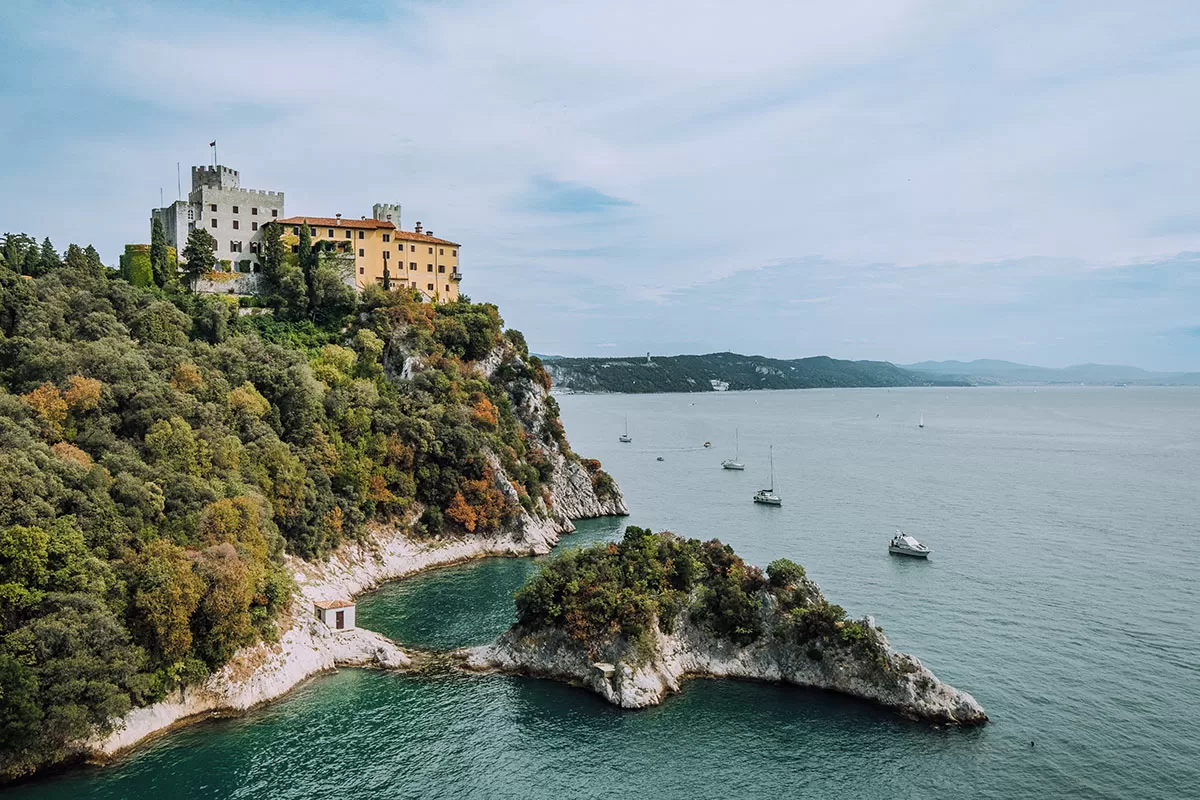
Nestled on a promontory overlooking the Gulf of Trieste, just north of the city, this beautiful historic residence predates the Miramare Castle by about five centuries. It’s owned by the Princes of Torre and Tasso, who have played hosts to great artists and illustrious personalities over the years. These include Empress Sissi, Paul Valery, Gabriele D’Annunzio, and Reiner Maria Rilke, who wrote some of his most famous lyrical poems here.
Planted firmly on the last rock spur of the Carso high above the Gulf of Trieste, Duino Castle is not just another stately home. An unusual case in Italy, and far more interesting, it that it is still the residence of the princely family of Torre e Tasso.
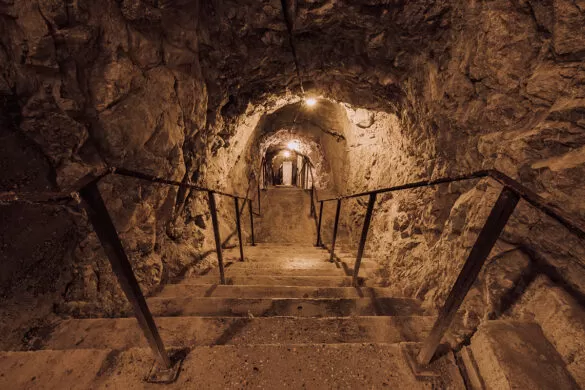
Despite the devastation of the First World War and the depredations of the Second, the Castle still boats artistic masterpieces and rare historical relics. Overlooking vast horizons of the sea are its gardens, with their romantic avenues embellished with period statues and objects and panoramic terraces. The owners have decided to open the gardens and most of their Castle home to the public for tours, conferences, concerts, gala dinners and other events.
Set out over a number of levels, the gardens display multi-coloured beds and cascades of all types of flowers, forming attractive splashes of colour amid the classical Meditteranean vegetation and acting as a backdrop for a wealth of status and an old well decorated with the family coat of arms.
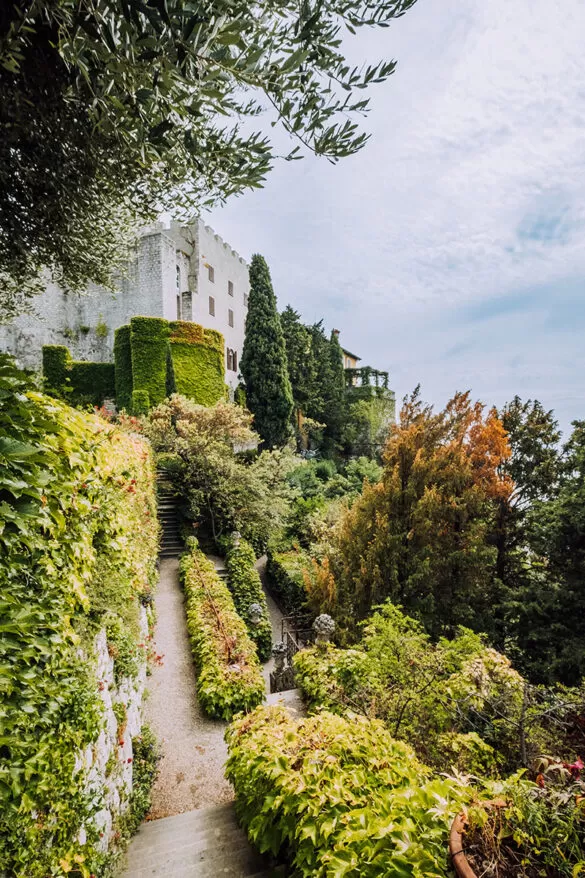
The Castle itself is a solid composite construction dominated by a 16th-century tower which holds intact a structure whose origins go back 2,000 years, as witnessed by the commemorative stone placed there in the 3rd century to mark a visit by Emperor Diocletian.
It was around this tower, on the ruins of a Roman military outpost, that building started on the present Castle in the 14th century. Its location was not far from that of its ancient forerunner, which is traditionally thought to have been dedicated to the worship of the Sun god and has been given the romantic name “The White Lady”.
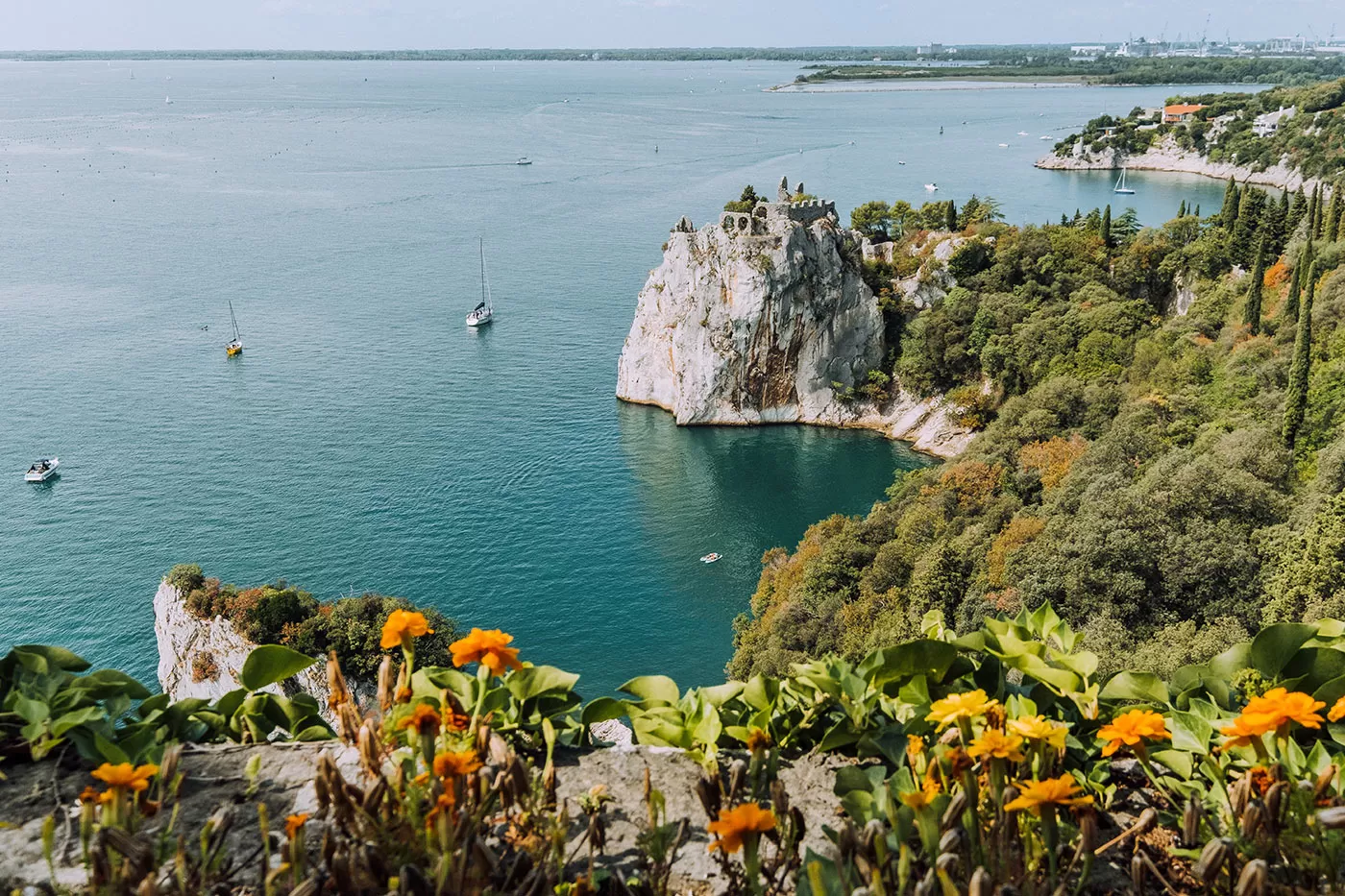
There are about 20 rooms to visit, filled with precious artworks and period pieces. The visit also includes the bunker that the Germans built when they occupied the castle during WWII.
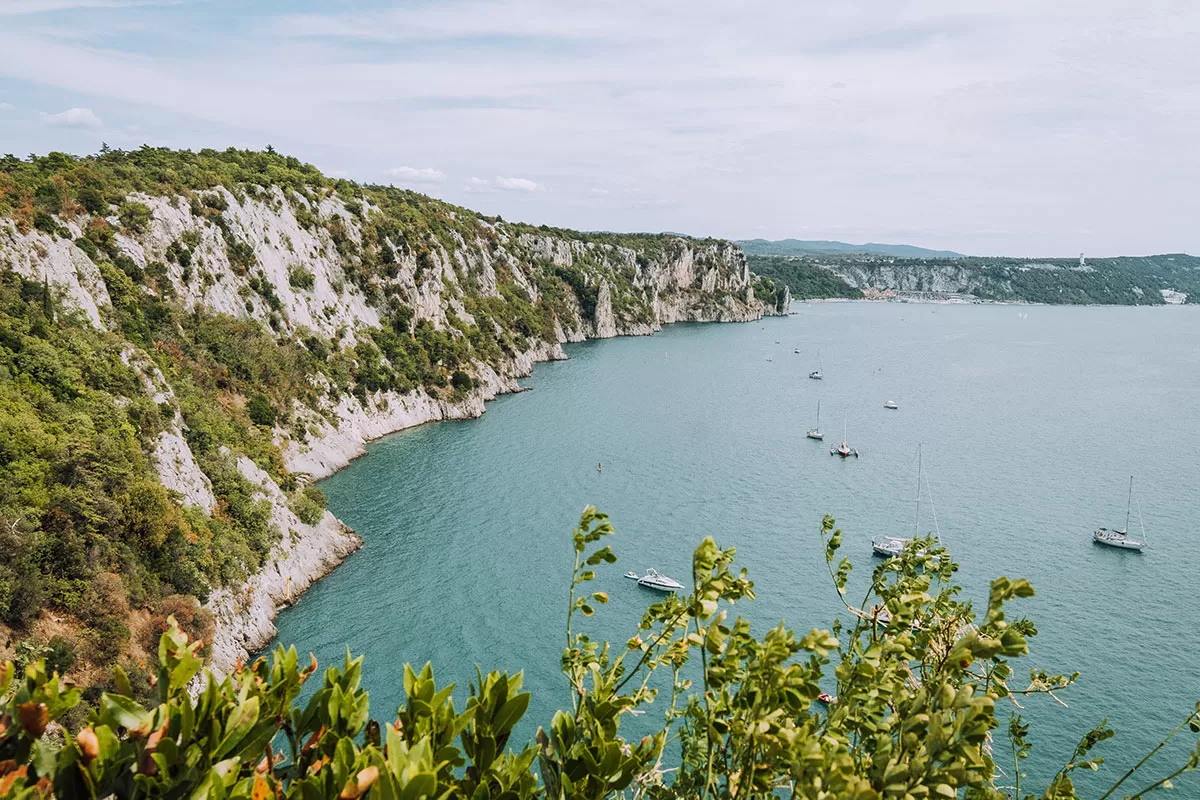
Rilke trail
Don’t miss: Take a panoramic walk along the Rilke trail. Named after the great German poet, it’s a stunning 2km coastal path connecting the castle to the bay of Sistiana.
4. Explore the Giant Cave (Grotta Gigante)
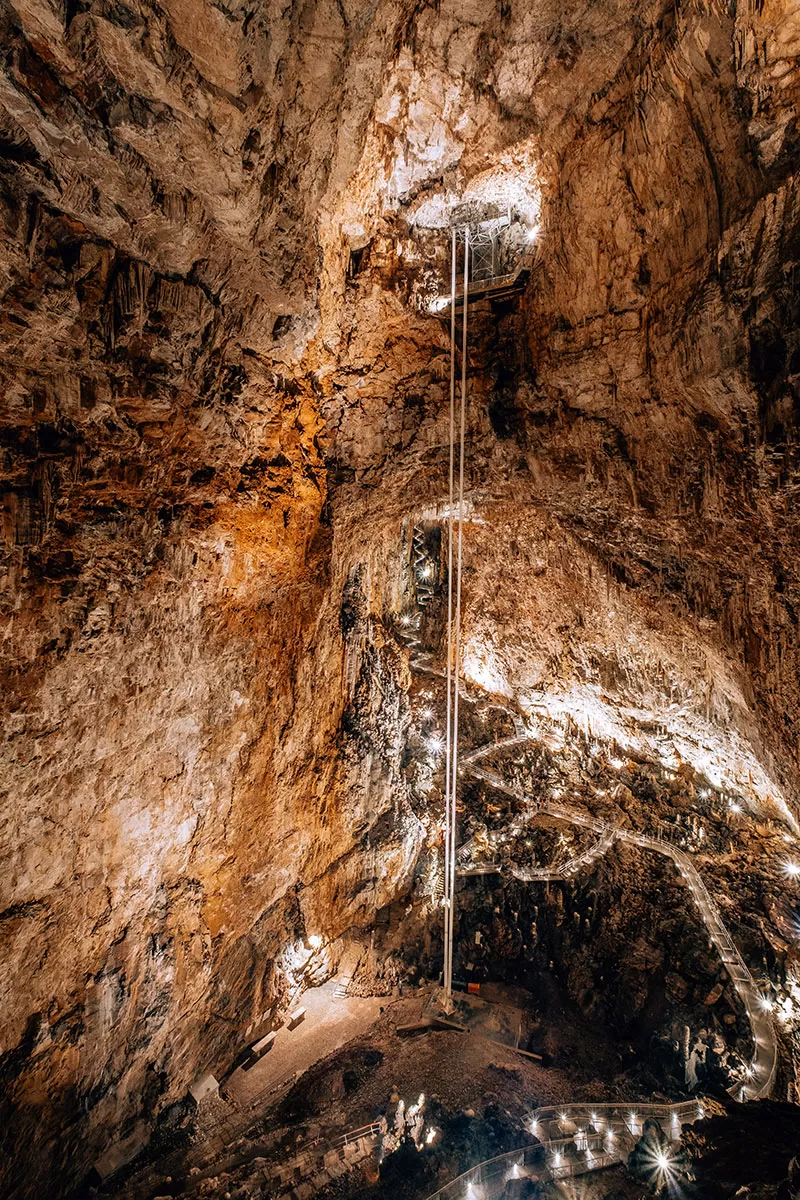
Located on the Trieste plateau ( Altopiano Triestino ) which covers an area of about 200 square kilometres (77 sq mi) there are 2,760 caves of various sizes on the Italy side of the border and 180 of them were inhabited by prehistoric man. The most famous is the Grotta Gigante (meaning “Giant Cave:), a name which says it all! Grotta Gigante is the largest tourist cave in the world, with a single cavity large enough to contain St Peter’s in Rome!
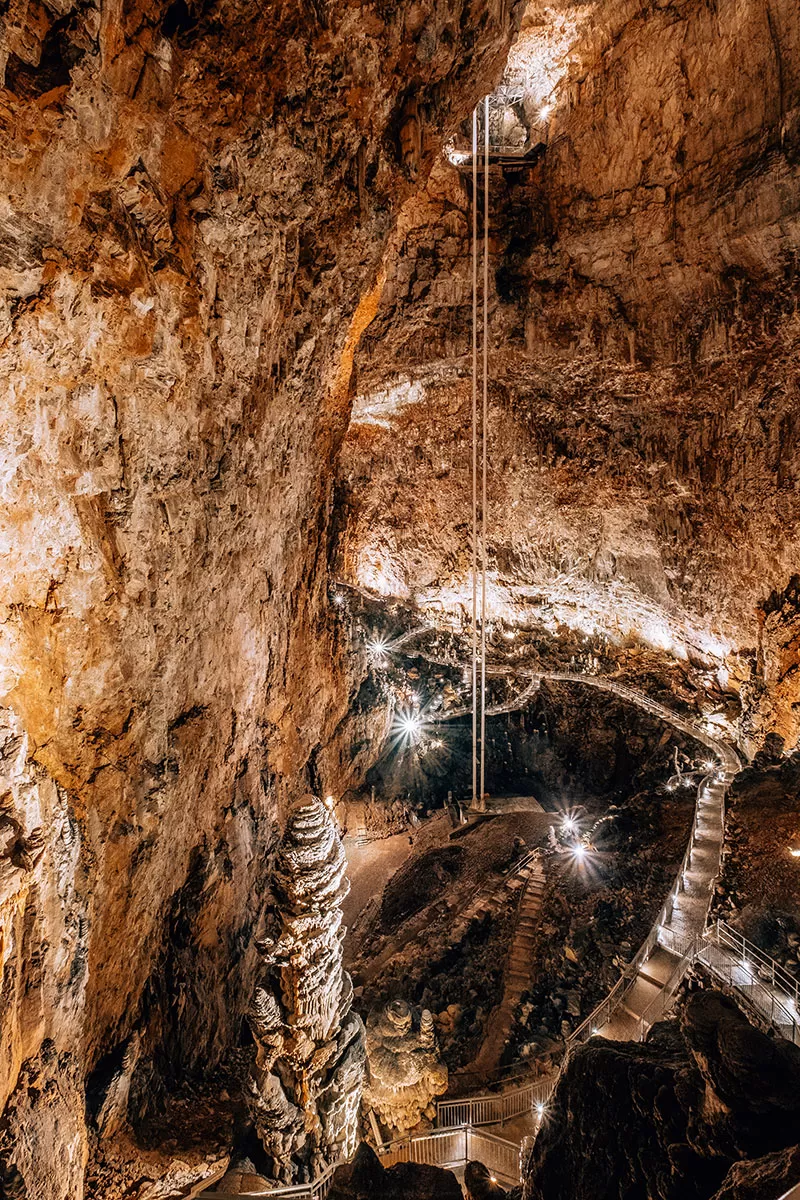
The cave started forming over 10 million years ago when two rivers diverged and formed this giant cavity underground. Today you can visit this space by taking 500 steps down and following a 167m pathway before winding up the other side of the cavity via 500 more steps.
During your visit, don’t miss the cave’s biggest stalagmite which stands 12 metres tall and is 150,000 years old and is still active! This means that it’s still growing at a formula pace of 1mm every 10-15 years!
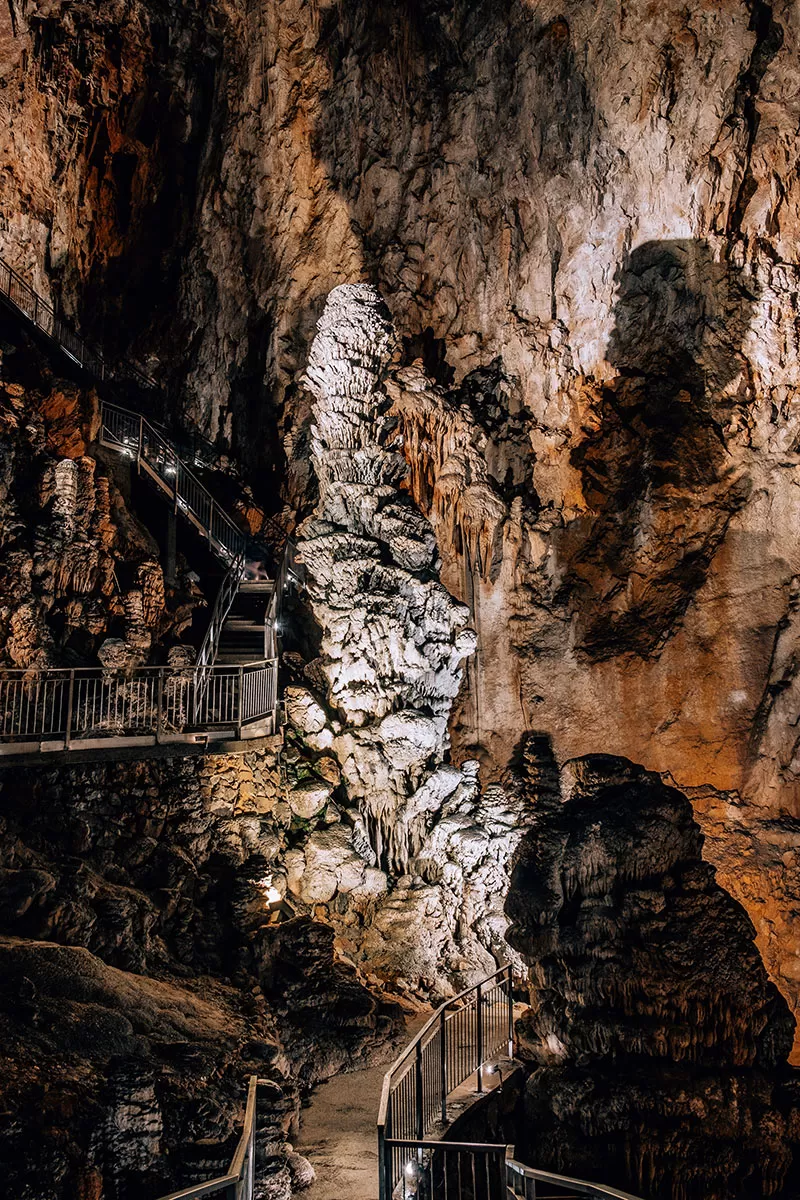
Grotta Gigante biggest stalagmite
As you take the steps leading back up, see if you can spot the original steel cable ladders’ with wooden steps. It’s scary to think these were used in the early days of the cave’s exploration when it was discovered in the 1800s while searching for a solution to water shortages.
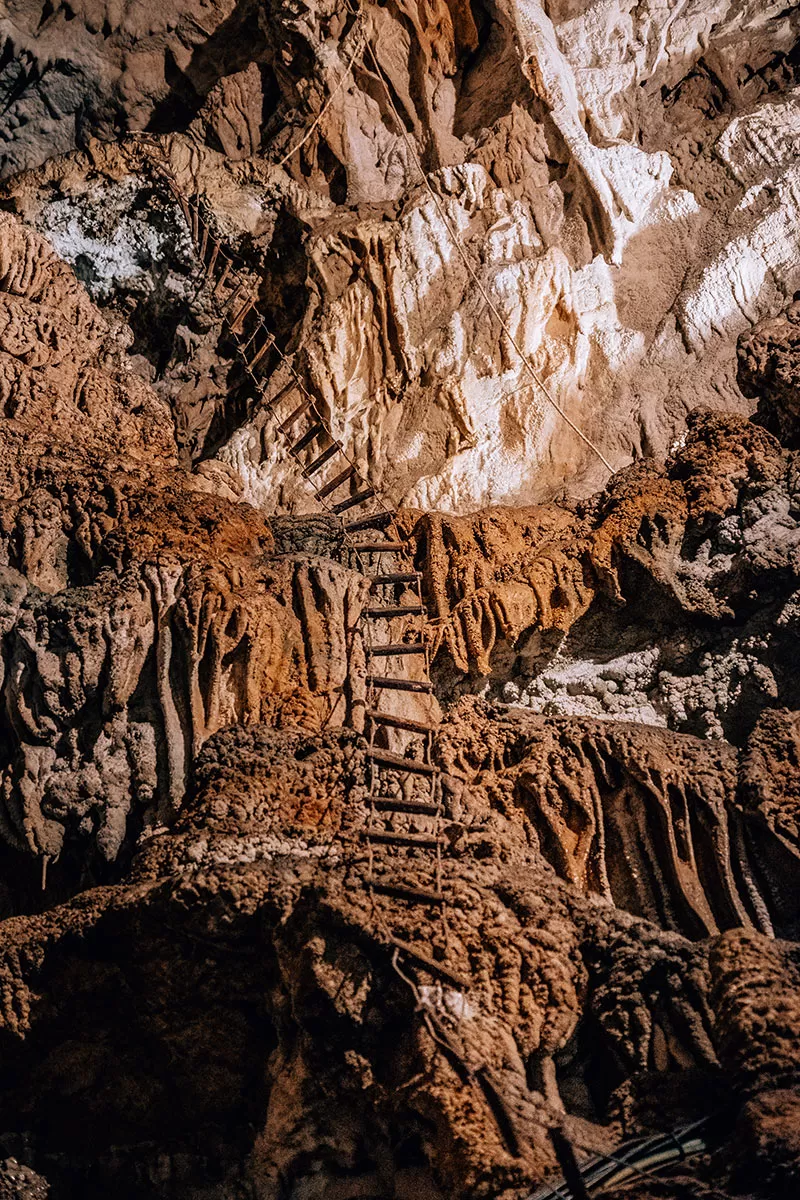
You can visit the Giant Cave and Duino Castle from Trieste on this guided half-day tour.
Don’t miss: get an adrenaline rush with a speleo expedition (the scientific study or exploration of caves) that goes 252 meters deep into a secret cave system. For further information, visit grottagigante.it
5. Experience Trieste’s coffee culture at a historic café
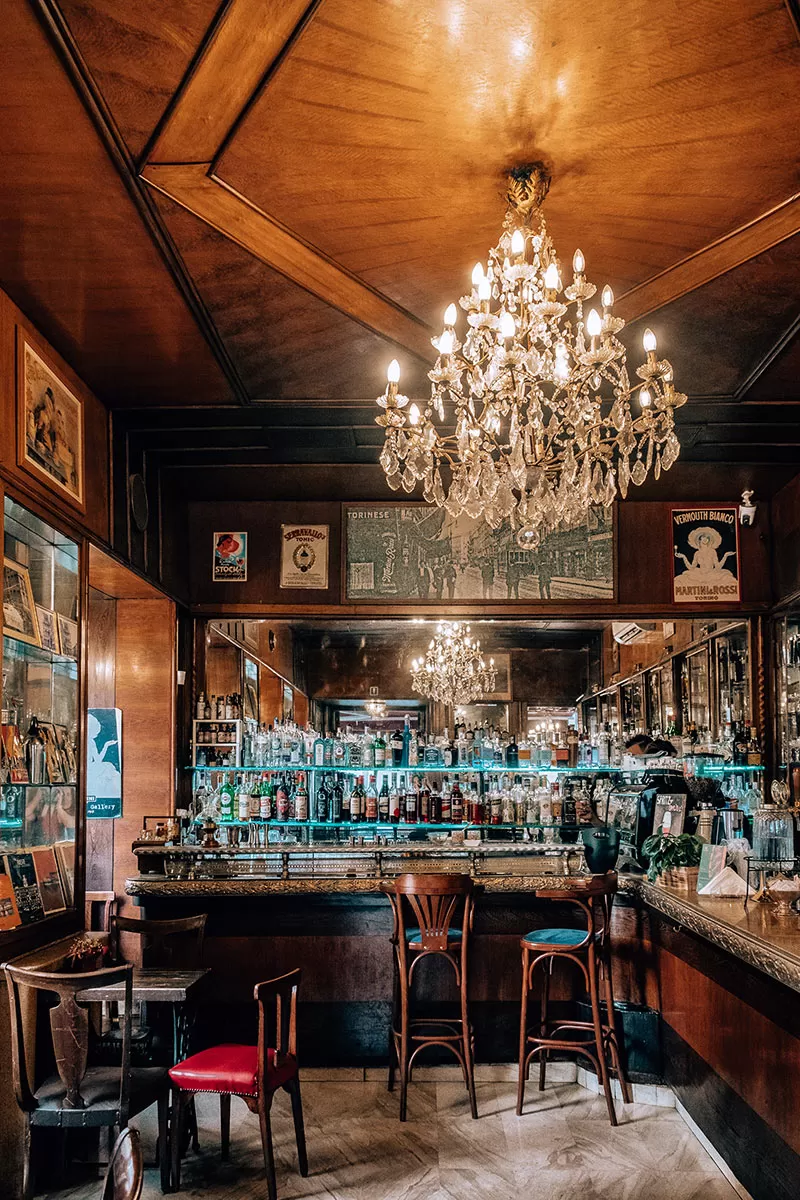
Caffè Torinese

During that time, an impressive amount of cafés were built, becoming a place for artists and intellectuals to socialize and find inspiration. Kafka, Freud, and Svevo all had their favourite café in Trieste, and it is said that James Joice came up with the idea for Ulysses while drinking cappuccino in Trieste. Caffè San Marco , Caffè Tommaseo, Caffè Torinese , and Caffè degli Specchi are among the best coffeehouses in Trieste to choose from.
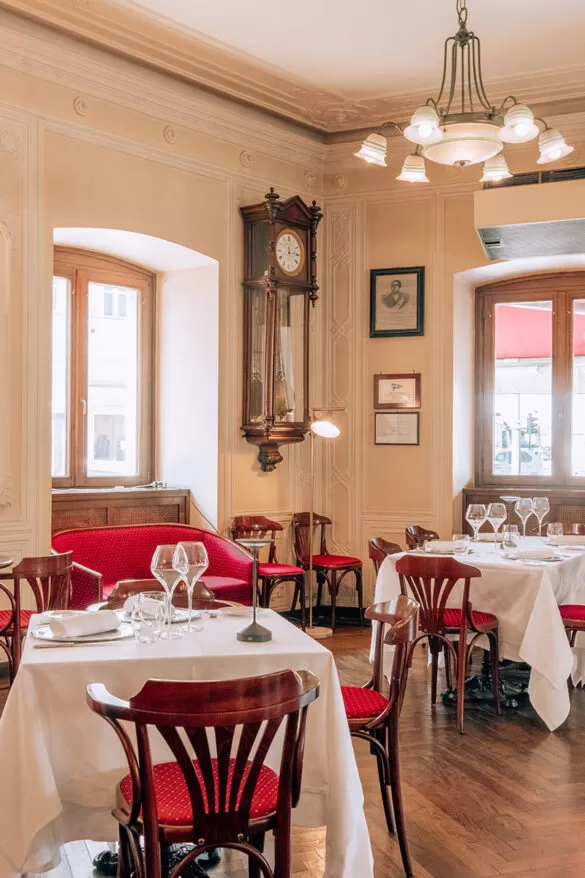
Don’t miss: The locals use a coffee terminology that’s unique to the city. The espresso in Trieste is called a nero , the coffee with milk is called a capo , and the cappuccino is a caffelatte . Brush up on your Italian and learn how to order food and drink in Italian .
6. Indulge in a traditional dessert at Pasticceria La Bomboniera
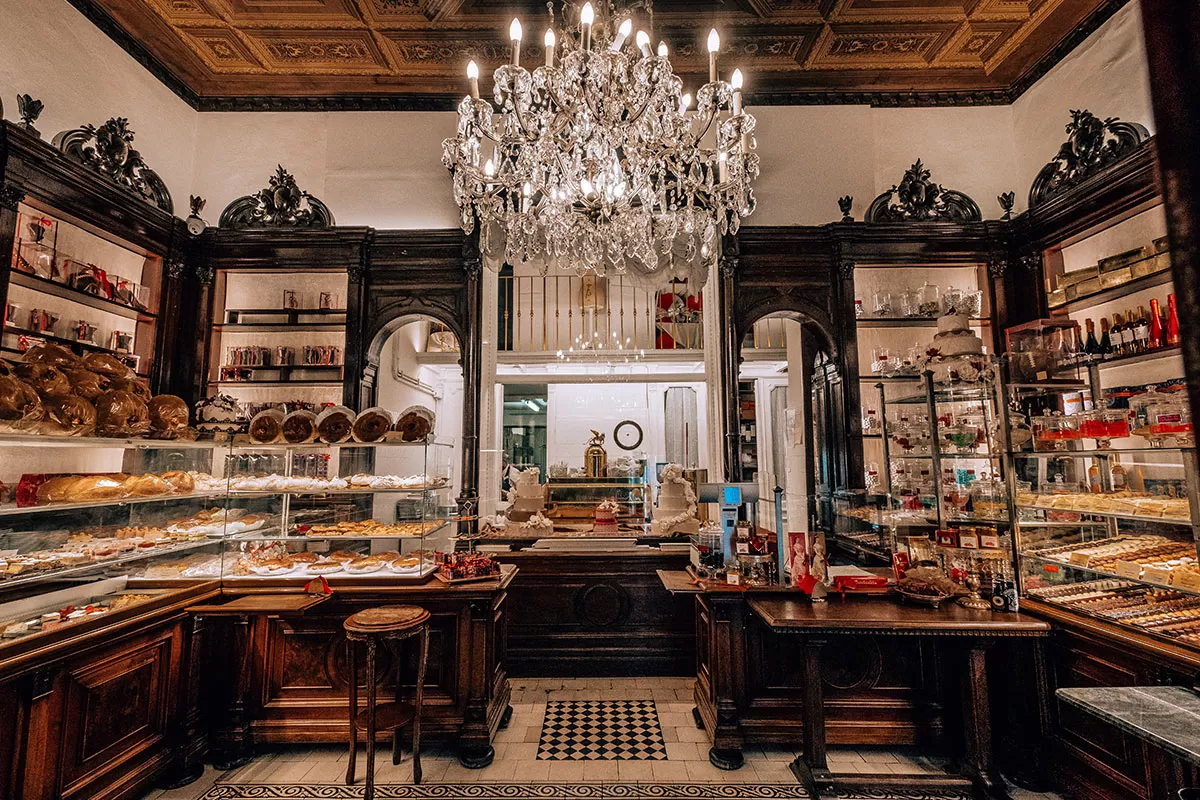
Each display case is filled with homemade cakes all baked in their original wood-fired oven, the only one of its kind in Italy. Choose from the following:
- Torta Rigojancsi – A traditional Hungarian cube-shaped chocolate sponge cake and chocolate cream pastry named after a famous Hungarian violinist Jansci Rigò.
- Pischinger – A cake consisting of layers of thin wafers and chocolate filling.
- Torta Sacher – A chocolate cake, or torte of Austrian origin, invented by Franz Sacher in 1832 for Prince Metternich in Vienna.
- Torta Linzer – Named after the city of Linz in Australia, this traditional Austrian pastry is topped with fruit preserves and sliced nuts with a lattice design on top.
- Presnitz – The most famous is the Presnitz, a circular-shaped strudel made with pastry dough and filled with a mix of hazelnuts, walnuts, almonds, pinenuts, prunes, dried figs, dried apricots, raisins, eggs, sugar, cinnamon, cloves, a touch of dark chocolate, and sometimes also with coffee and rum or marsala. As the story goes, the circular design of the cake is said to have had an inscription that read “ se giri il mondo, ritorna qui” (“if you travel around the world, come back here”)
Other items to look out for are Jewish marzipan desserts, “fave dei morti” almond biscuits, and white and brown chequerboard mandorlati almond biscuits. The list goes on!
7. Go to the beach in Trieste
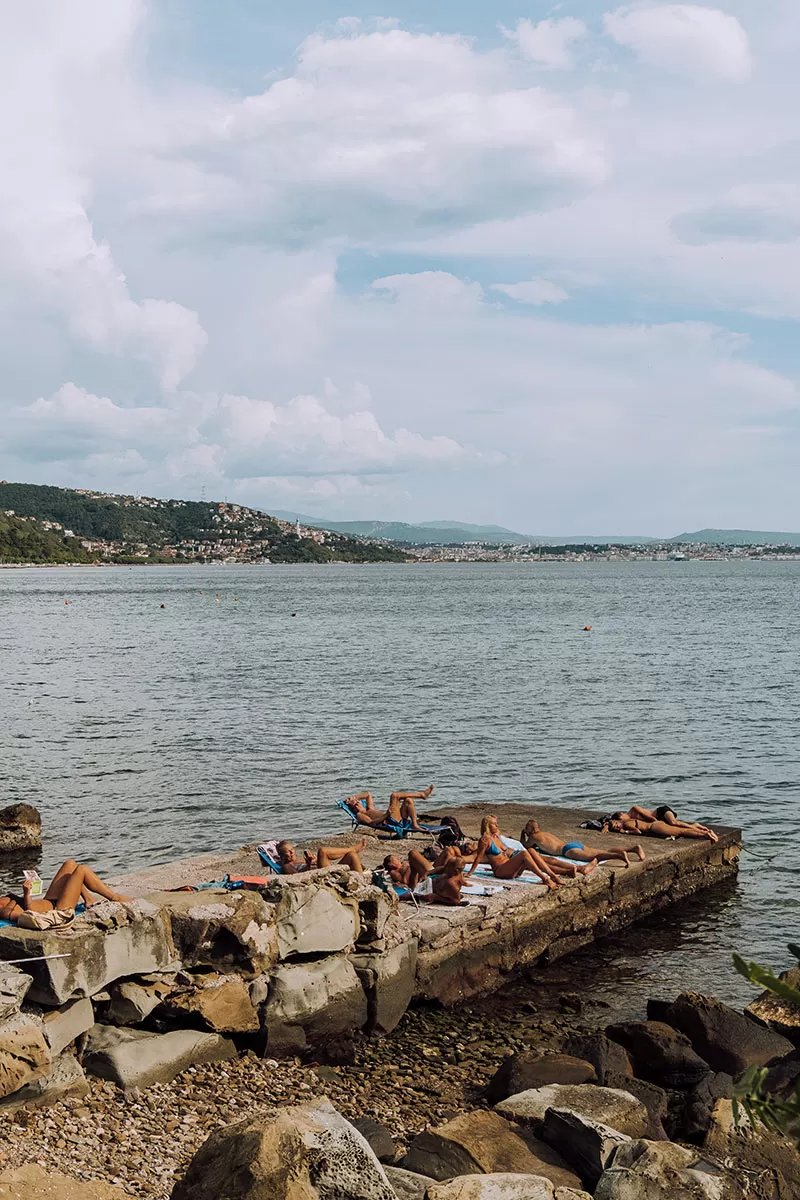
Barcola Beach at sunset
There’s nothing like going to the beach in Trieste. Not just for the beautiful landscapes, but also for the unique character of some of its most popular lidos.
For a real local experience, El Pedocin beach on the Lantern Pier is a local institution and still has a wall separating the men’s and women’s parts – the only one of its kind in Italy.
Another popular beach in Trieste is Barcola , a stretch of concrete (yep, no sand!) backed by pine trees. The same goes for Topolini , where ten semicircular terraces are a favorite among the city’s youth.
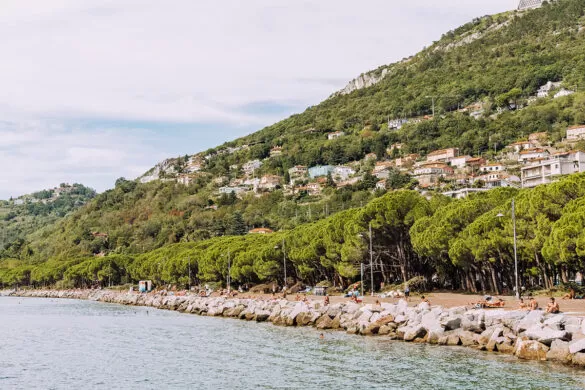
Another summer highlight in the city is Ausonia , a beach club from the 1930s complete with a pool, trampolines, and a terrace restaurant. There’s also a pretty beach called Sticco on the way to Miramare Castle. It’s got crystal clear water and retro changing booths.
If you’re travelling with your furry friend, you might want to check out Fido Lido , which offers dog-friendly facilities on Trieste’s outskirts.
Don’t miss: If you’re looking for a beach getaway outside of the city, Sistiana is a great option. About 20 minutes west of Trieste, it has beaches lapped by turquoise water, a pretty harbour, and many shops and restaurants.
8. Visit the Civic Museum of Natural History (Museo di Storia Naturale)
If you visit Trieste with kids or simply love dinosaurs, then the city’s Civic Museum of Natural History should definitely be on your sightseeing list. It’s located just outside the historic center and has 4 million finds gathered over a century. These include the largest and most complete dinosaur discovered in Italy: an impressive 3.6 meter-long Tethyshadros insularis named Antonio which was found almost intact near Trieste.
Among the most interesting exhibits inside the museum ia a section on the evolution of hominids, a zoological room with mammals from all over the world, and a space filled with imposing skeletons of sea animals including Carlotta, a 5.4-meter-long white shark.
Don’t miss: look for the human jaw from over 6,400 years ago in which you can see a dental filling made with beeswax, which represents the world’s oldest example of dental care!
For further information, visit museostorianaturaletrieste.it
9. Marvel at the sheer beauty of Piazza dell’Unità d’Italia

This piazza showcases a striking mix of prestigious buildings that are a photographer’s delight. There’s the City Hall with its beautiful clock tower topped by the statues of two Moors, and the Palace of the Government with its Art Nouveau facade. Also not to miss are the Palazzo del Lloyd Triestino, a shipping line founded in 1836, and the Grand’Hotel Duchi d’Aosta which looks straight out of a Wes Anderson film.

At this time, Trieste was the most international city in Italy, with its cosmopolitan and frontier soul. It also had one of the largest Jewish communities in the country. That day Mussolini wanted the major international newspapers in Trieste to spread his message about the “enemy”, the necessary solutions and the new “separation policy” that he believed everyone needed to hear loud and clear.
Don’t miss: Beautiful by day, Piazza Unità d’Italia shines at night when warm lighting illuminates its magnificent buildings, creating something magical.
10. Go for a sunset passeggiata along Molo Audace
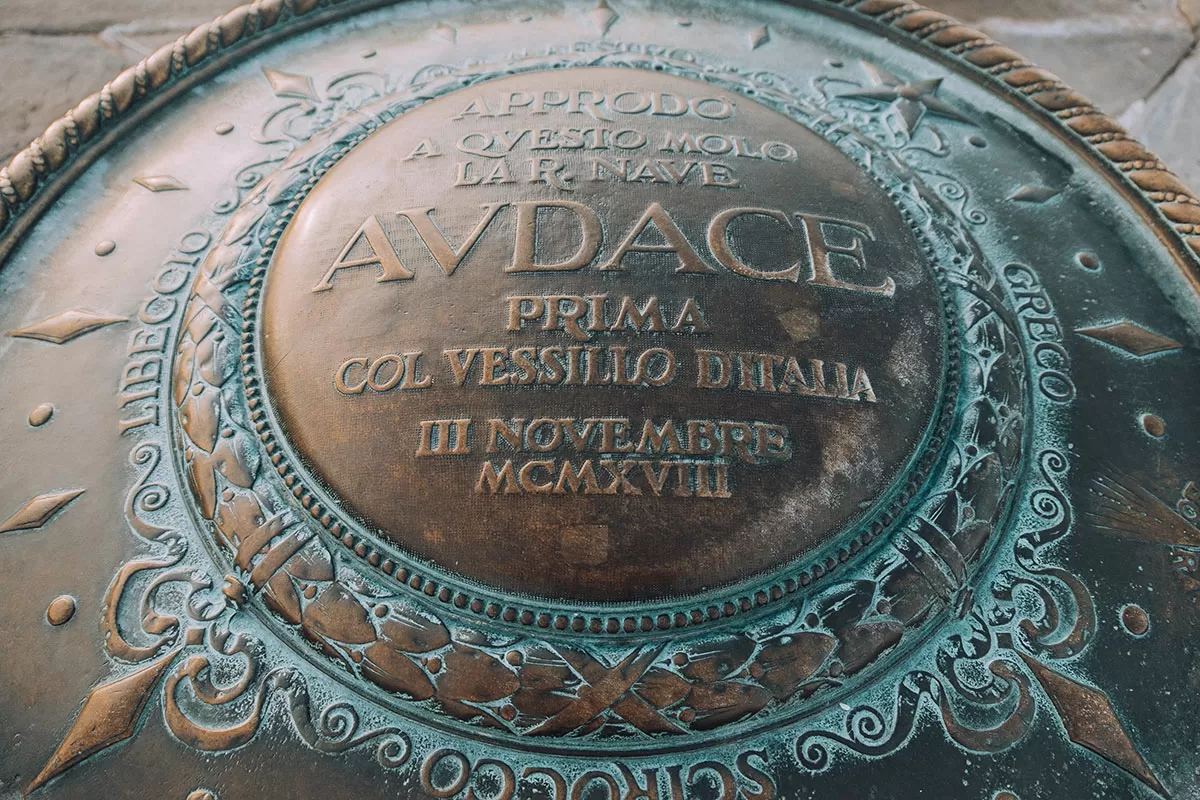
Next to Piazza Unità d’Italia, the Molo Audace promenade is really beautiful and one of the must-see places in Trieste. Stretching for more than 250 meters into the Adriatic Sea, it’s a great spot for a passeggiata (Italian for ‘stroll’) in the early morning or after dark.
The promenade is lined with benches where locals seat to chat, read the newspaper, or simply soak up the gorgeous views of the coastal scenery that stretch as far as the Miramare Castle on clear days. On summer evenings, it’s not unusual to stumble upon great street music performances.
Don’t miss: Molo Audace is a prime spot to admire the boats taking part in the Barcolana in October, the largest sailing regatta.
11. Travel back in time at Trieste Roman Theatre (Teatro Romano di Trieste)
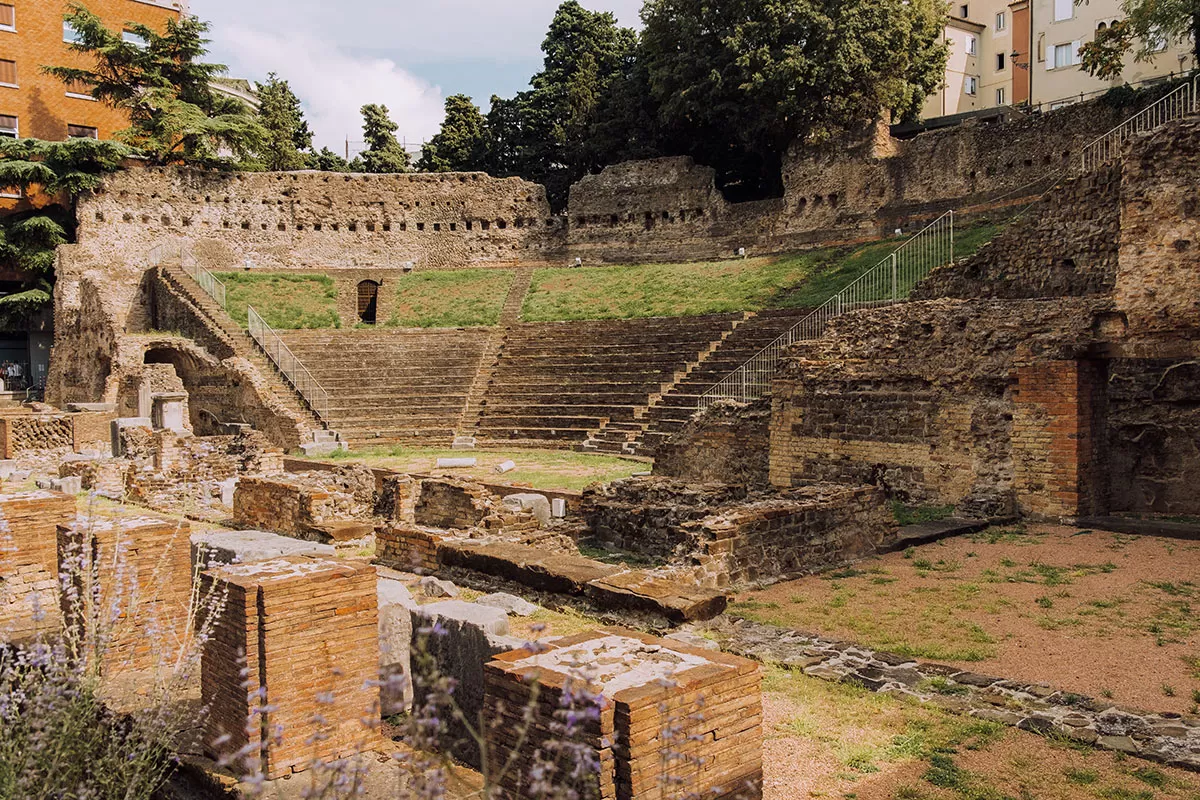
In the Middle Ages, it was hidden by the houses that were built over it. 2,000 years later is was excavated and restored in 1938 and today is still the site of shows and artistic events.
The location is quite scenic, situated at the foot of the San Giusto hill it provided a natural setting for the amphitheatre. The structure, mostly made of masonry, is still in great shape, with the original stage and seating areas still visible along with a variety of columns. The original ornamental statues are on display at the Civic Museum of History and Art in the Castle of San Giusto.
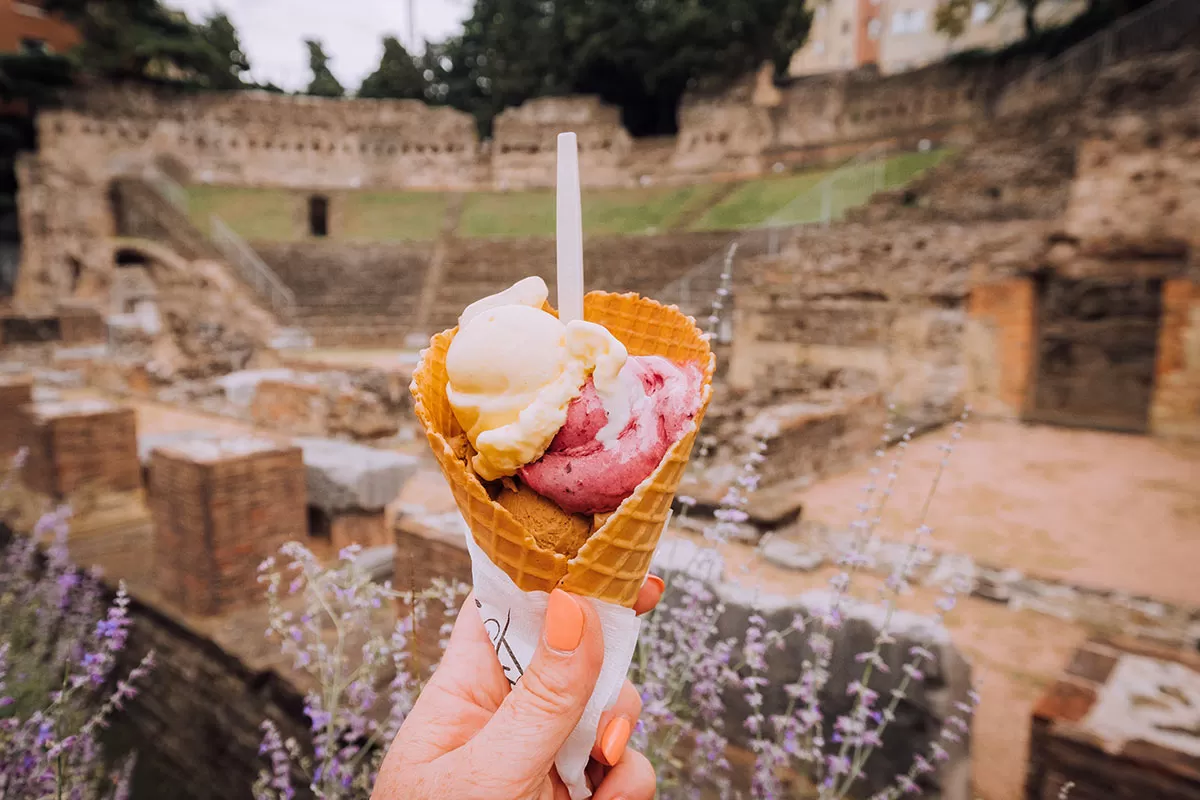
12. Discover Piazza della Borsa
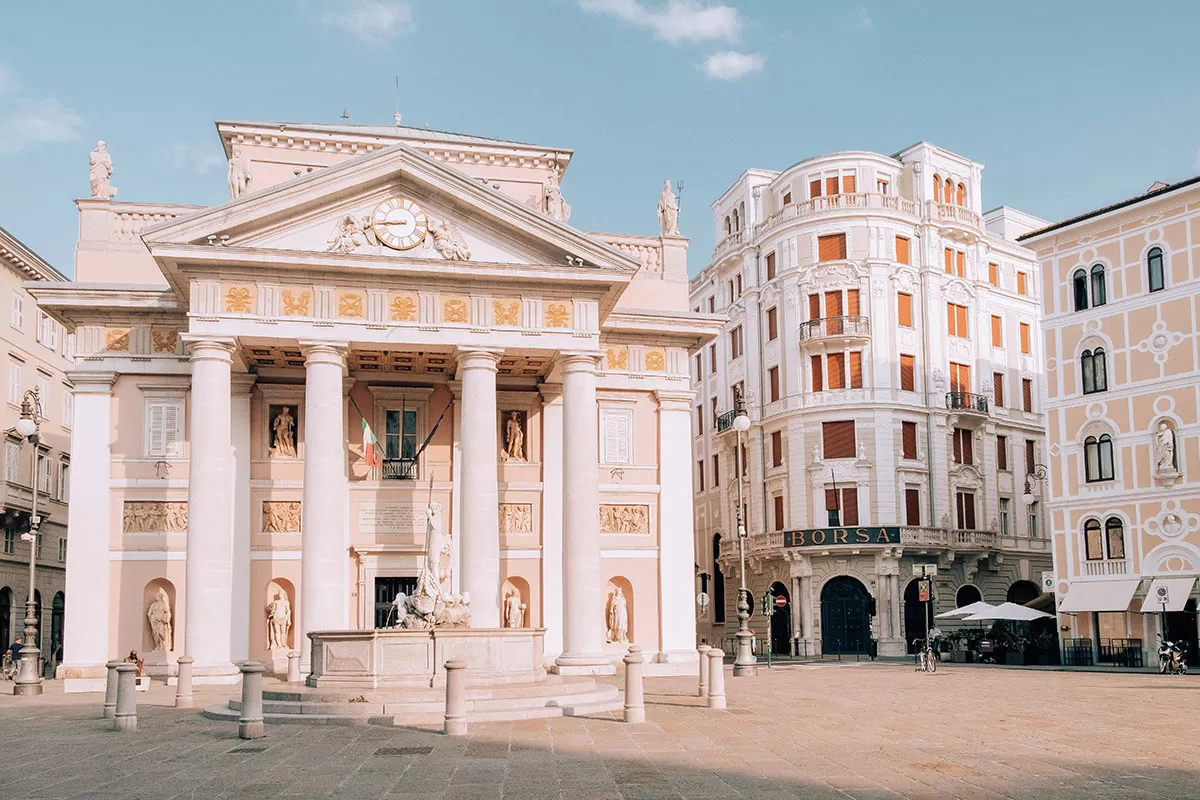
Piazza della Borsa is a great place to shop and meet people. There are lots of restaurants and boutiques, and sometimes small fairs and markets are held here. In the center of the piazza stands Neptune’s fountain, once used by locals for washing clothes.
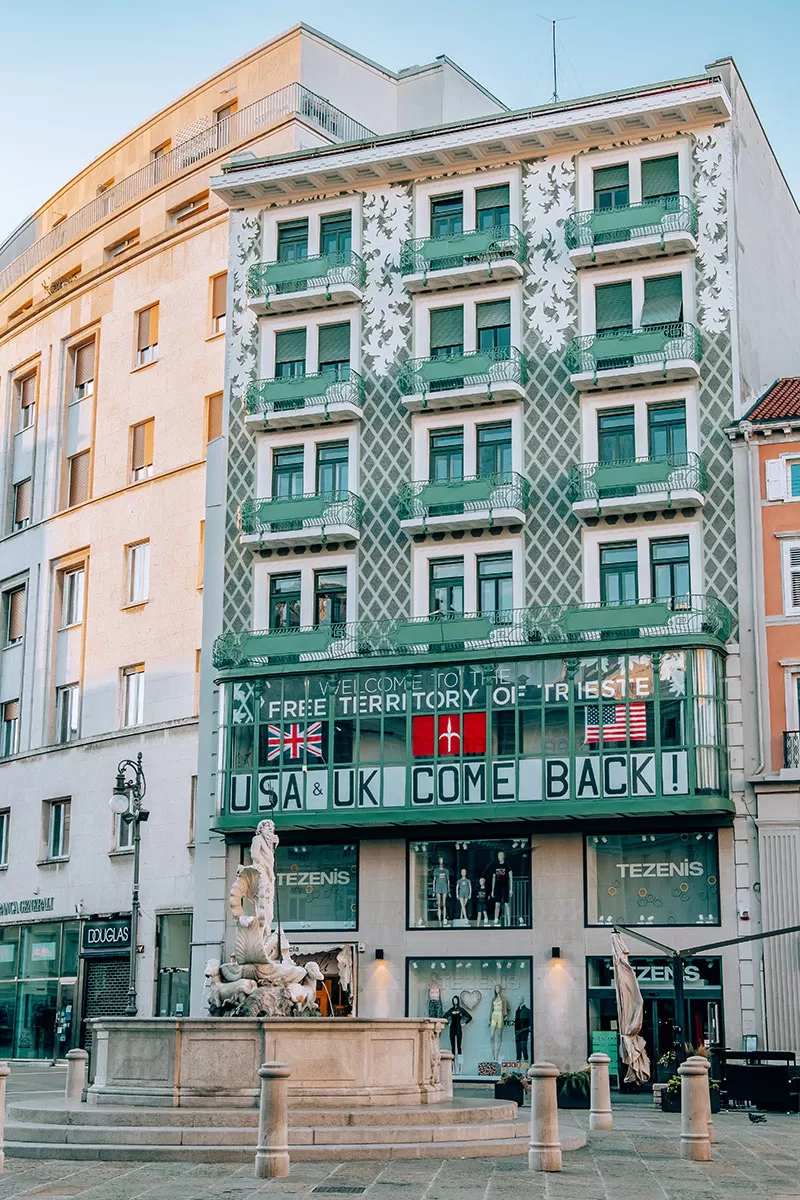
Casa Bartoli
Don’t miss: Among the palaces that line Piazza della Borsa, Casa Bartoli is the most famous liberty-style building in Trieste. It is also known as the Green House due to the colour of the floral decorations on the main facade.
13. Explore San Giusto Castle
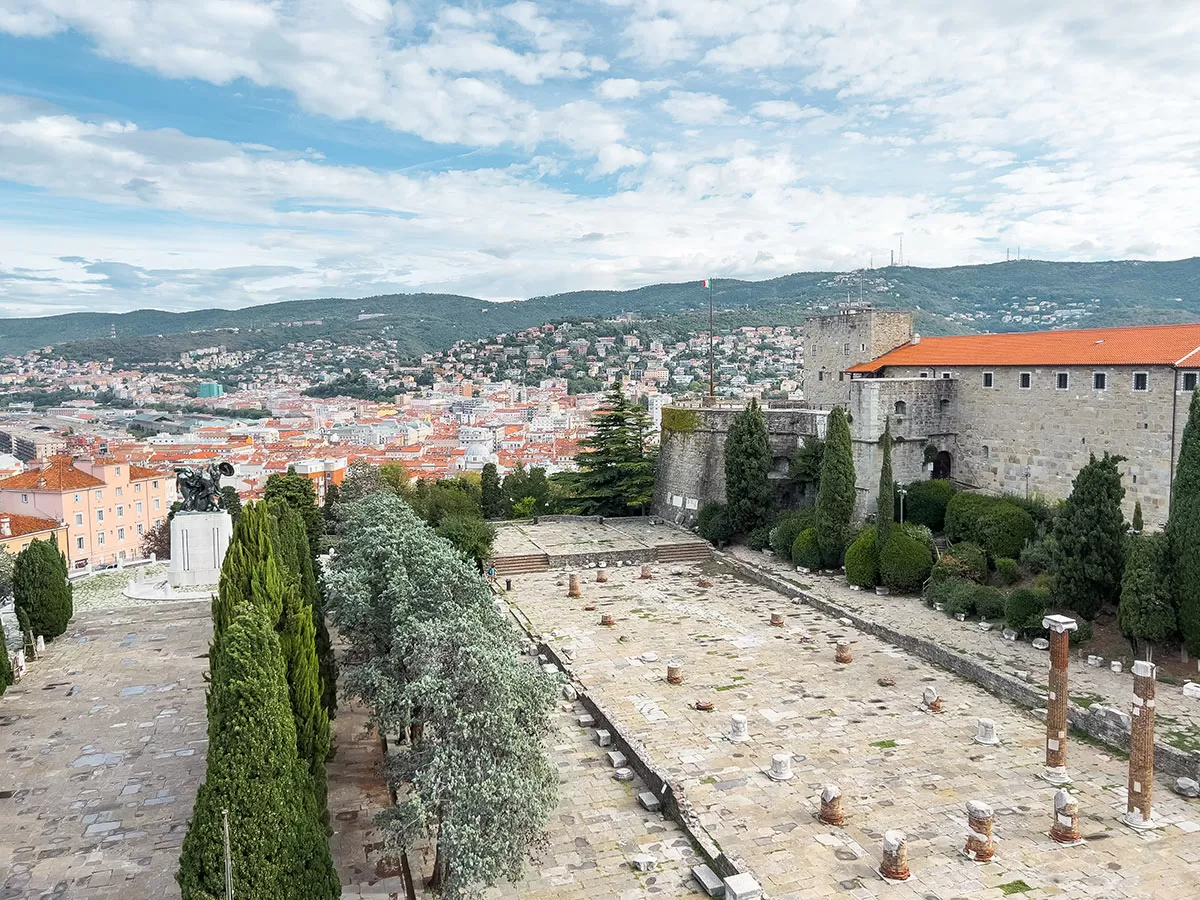
Overlooking the city from the top of the San Giusto Hill, this castle deserves a spot on the list of what to do in Trieste for its history and collections. It was built by the Habsburgs between the 15th and 17th centuries, with interventions also by the Republic of Venice when it regained rule over Trieste in the early 16th century.
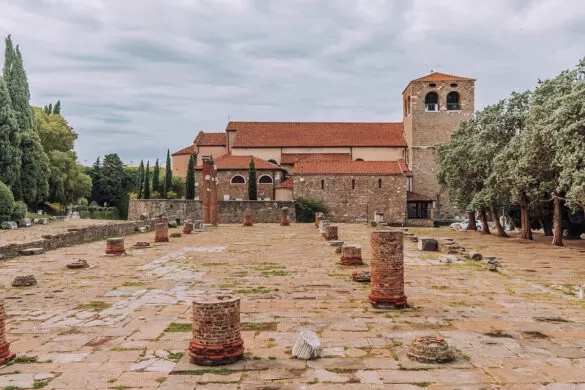
After a scenic entrance via a wooden drawbridge, you can explore its beautiful vaulted halls and climb up the ramparts for some of the best views of Trieste and its gulf. There are also some museums displaying ancient weapons, rich tapestries and statues from the Roman amphitheatre.
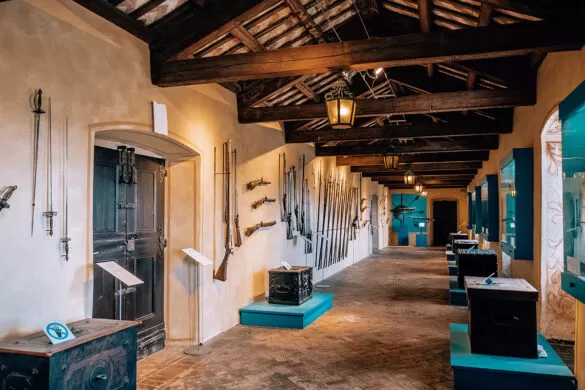
Don’t miss: on your way to the castle, stop at Piazza San Silvestro to admire the beautiful Baroque interior of the 17th-century Church of Santa Maria Maggiore.
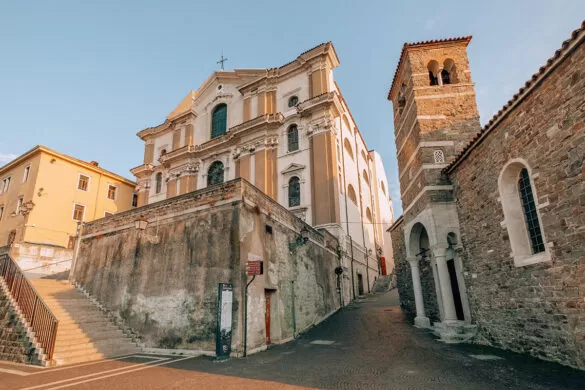
For further information, visit castellodisangiustotrieste.it
14. Visit the Cathedral of San Giusto

Next to the castle, the Cathedral of San Giusto is Trieste’s most important religious building. Its current look comes from the aggregation of two churches back in the 14th century and the result is architecturally impressive. There’s a beautiful Gothic rose window adorning the brick facade while a statue of San Giusto stands above the entrance to the bell tower.
The interior features beautiful mosaics dating from the 12th-13th centuries and frescoes depicting stories of the saint. You can also see traces of 5th-century mosaic flooring, while the cathedral bell was cast from a cannonball left by Napoleon.
Don’t miss: You can climb up the bell tower for great views of Trieste and close-ups of the five enormous bells that toll the hours.
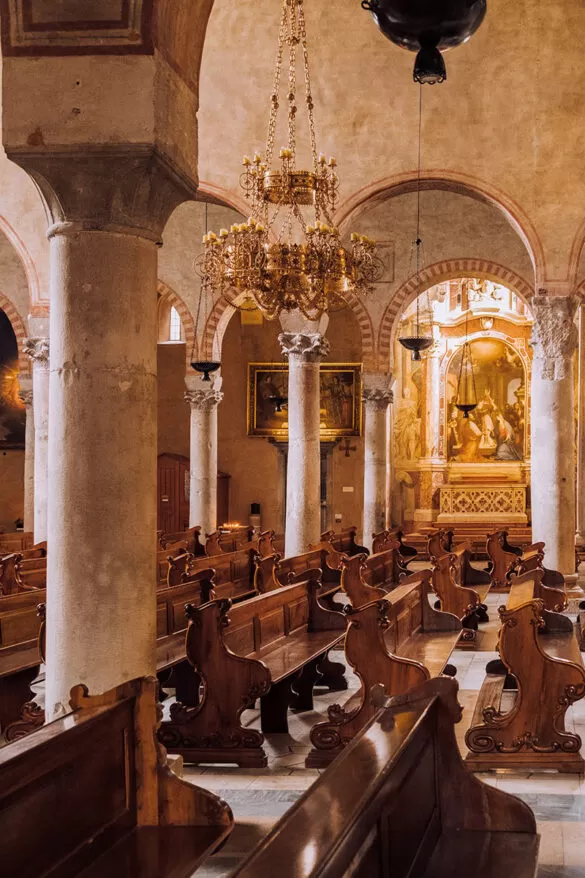
15. Stand on the steps of Giants at the Giant’s Stairway (Scala dei Giganti)
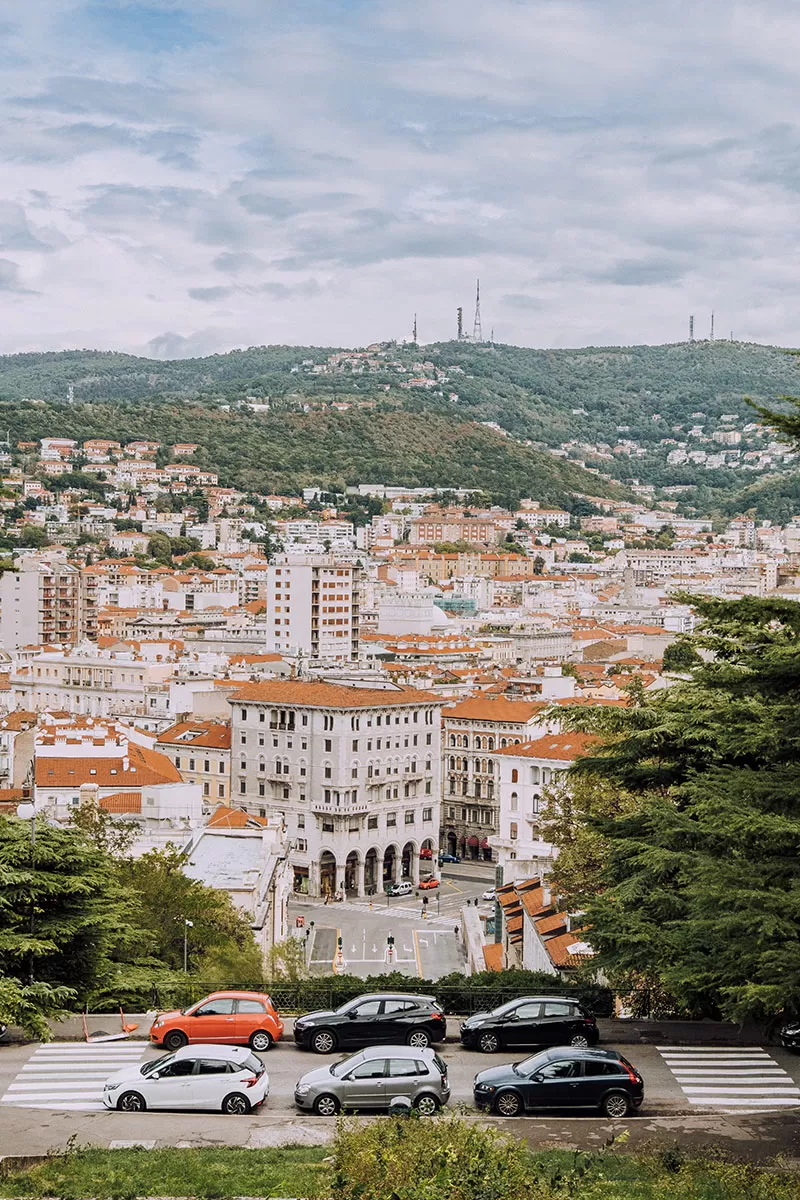
Located between Piazza Goldoni and Via del Monte, Scala dei Giganti, is a steep and stately stairway that connects the heart of Trieste with the archaeological site on San Giusto Hill. Built in 1970, Scala dei Giganti was designed by the Berlams, a well-known Triestine family of architects. Designed in a neoclassical style, it features a double stairway, niches and statues, and a large fountain. From the top of the hill, the tree-lined path frames a wonderful view over the city of Trieste.
16. Snap a postcard picture at Trieste’s Grand Canal
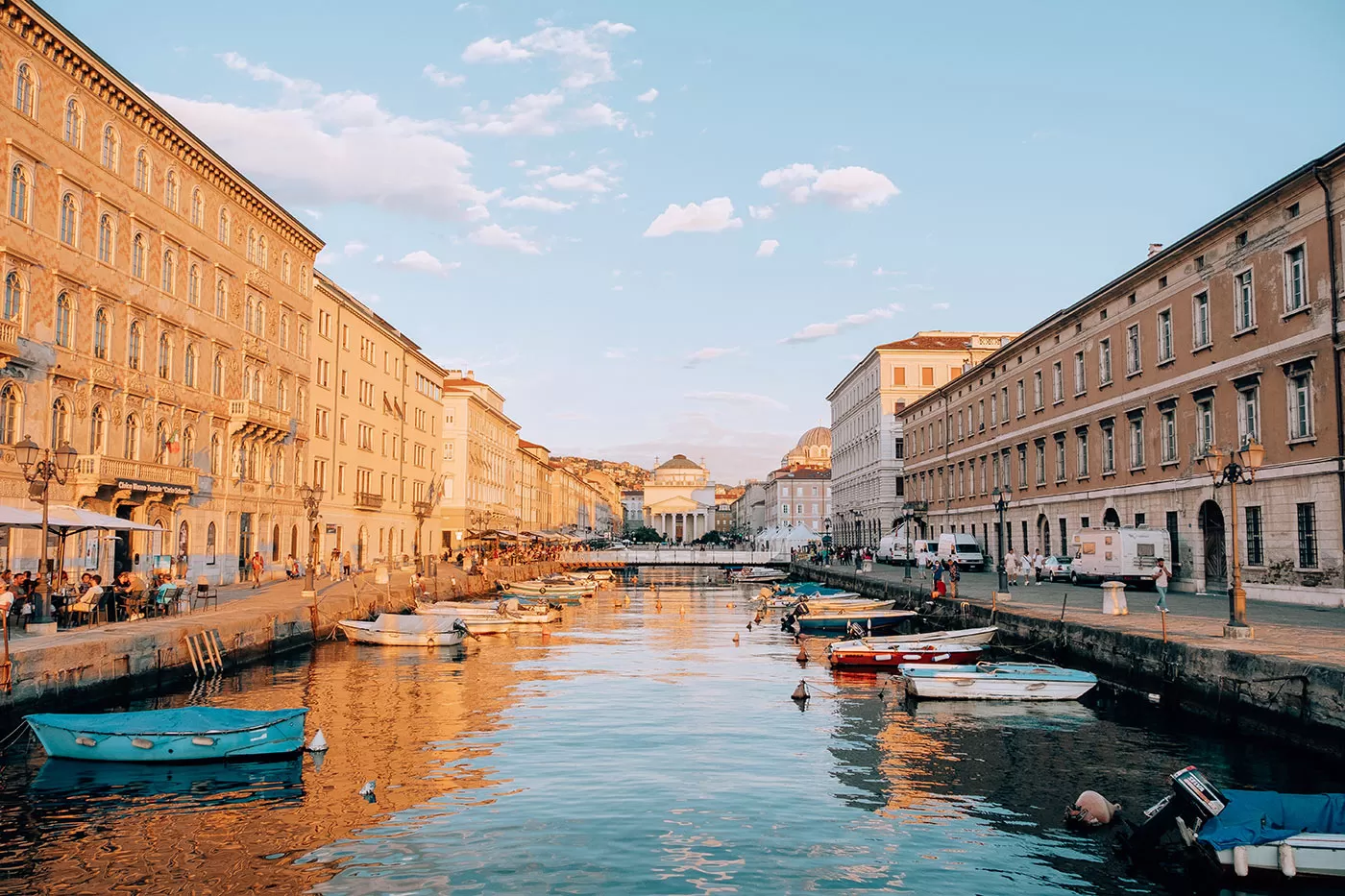
The Grand Canal in Trieste isn’t as grand as Venice’s , but it’s certainly worth more than a look while you’re in town. It’s near Piazza Unità d’Italia,in the heart of the historic old town, where it was built in the mid-1700s so that boats could unload their cargo directly into the city.
This spot is just so pretty: it has cute little boats moored at both sides and is surrounded by elegant buildings with the St. Spyridon Serbian Orthodox Church peeking out. Surely, one of the best Instagrammable places in Trieste. Additionally, it hosts various events all year long, including the Christmas markets.
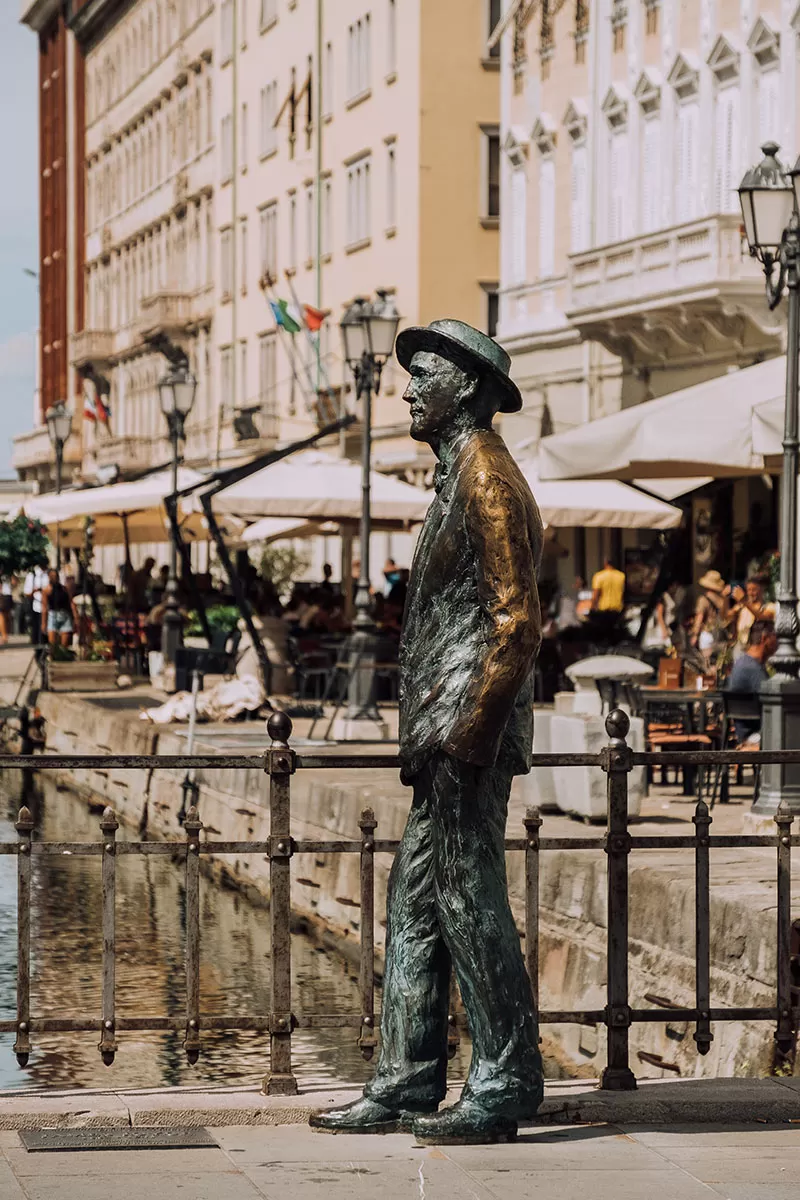
Don’t miss: On one of the bridges across the Grand Canal, there’s a statue of James Joyce, who lived in Trieste in 1904-1915 and loved this area.
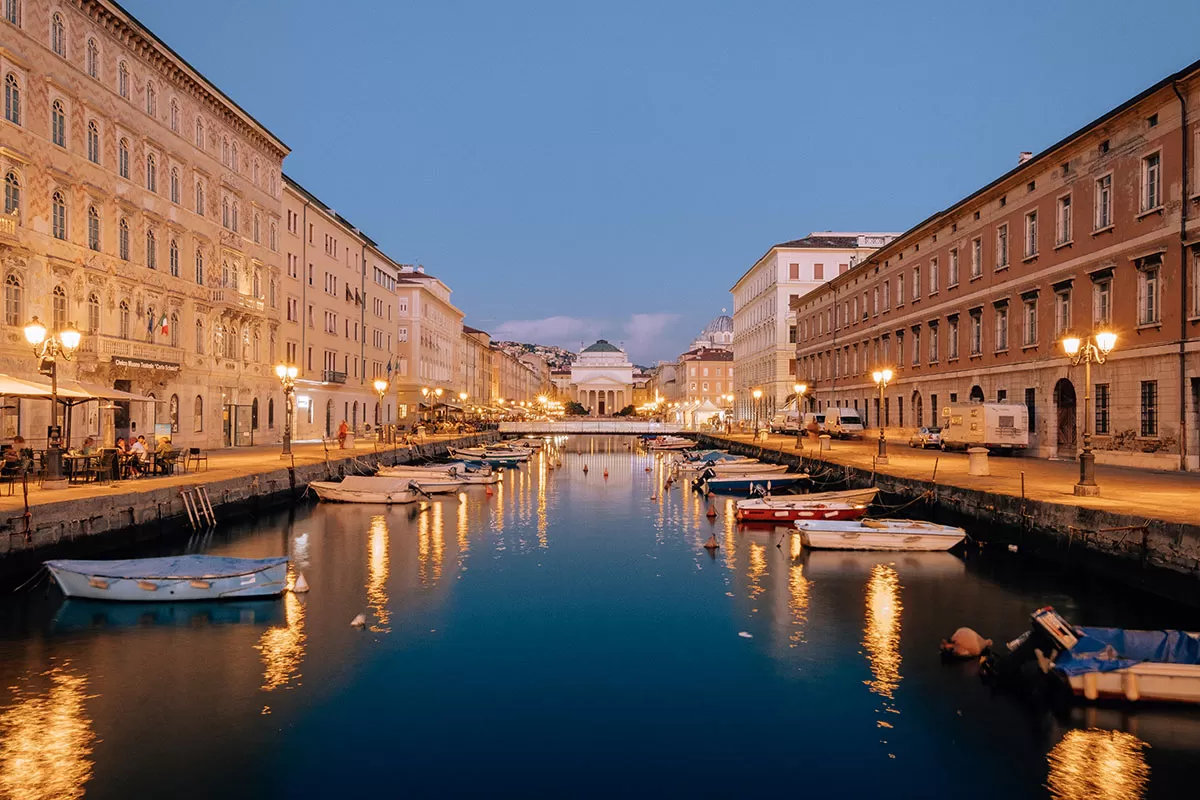
17. Admire the glorious Victory Lighthouse (Faro della Vittoria)
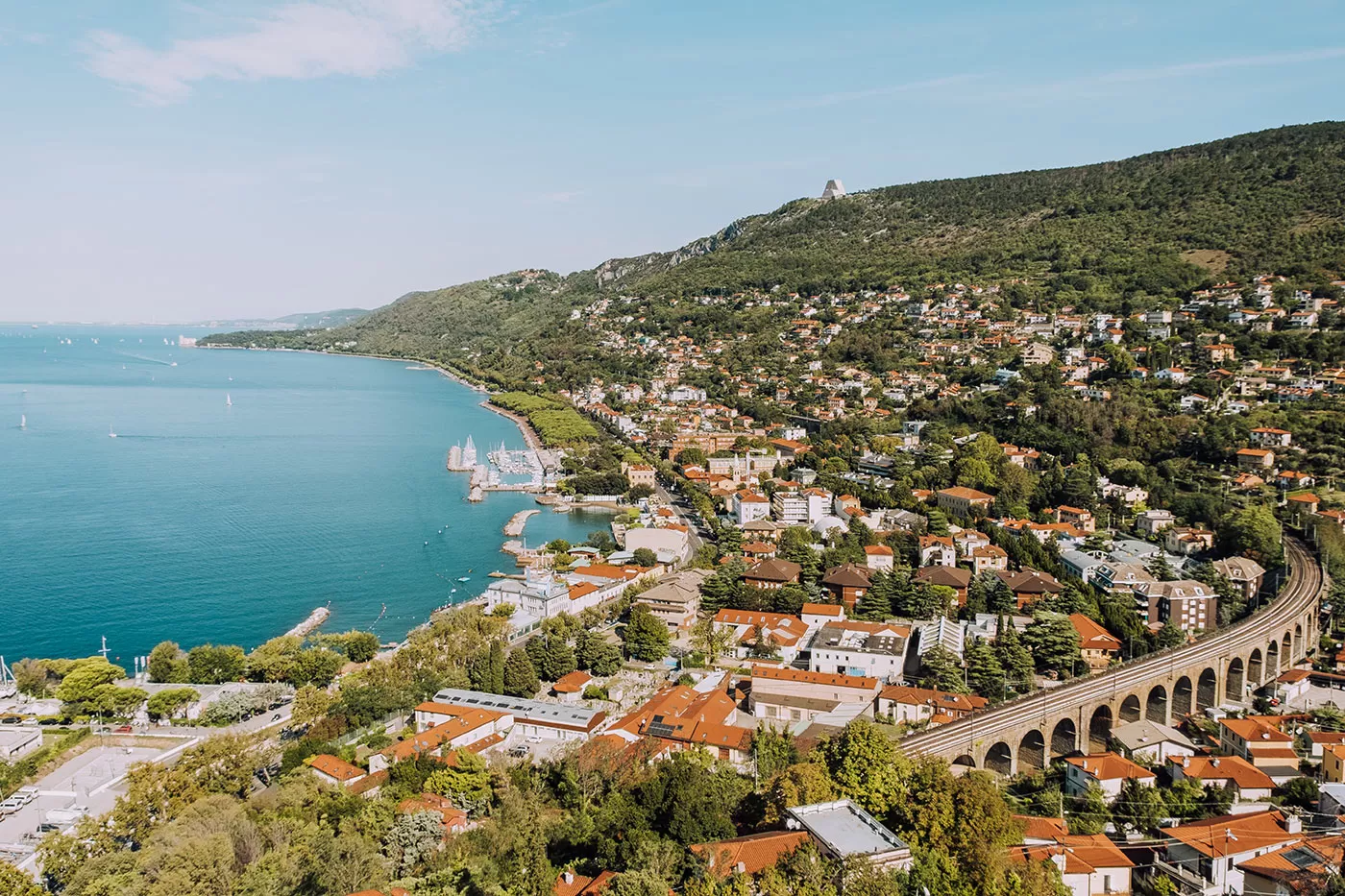
Standing high on a hill overlooking the Gulf of Trieste, is Faro della Vittoria or Victory Lighthouse, a symbol of Trieste.At a height of 223 feet (68 m) it is one of the tallest lighthouses in the world. It’s both graceful and formidable, matching the motivations for its erection. It was built in the 1920s to celebrate the inclusion of Trieste into the Kingdom of Italy after the long occupation by the Austrian Empire, but also to honour those who died at sea during WWI.
The lighthouse is still working and is often open to visitors. The climb up the viewing gallery is via some 300 steps, but there’s also a lift. Once at the top, you’re rewarded with stunning panoramic views of the city and the coast, and the Gulf of Trieste.
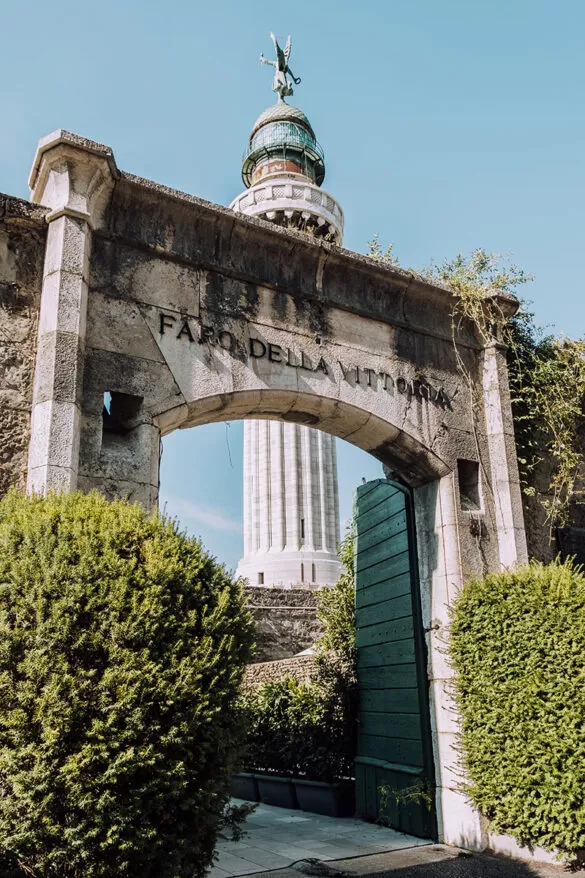
Don’t miss: Look for the anchor at the base of the statue of the Unknown Seaman. It commemorates the historic entry of the first Italian ship into Trieste, called Audace which translates to audacious .
For more information, visit https://www.farodellavittoria.it/
18. Explore a gloomy chapter of local history at Risiera di San Sabba
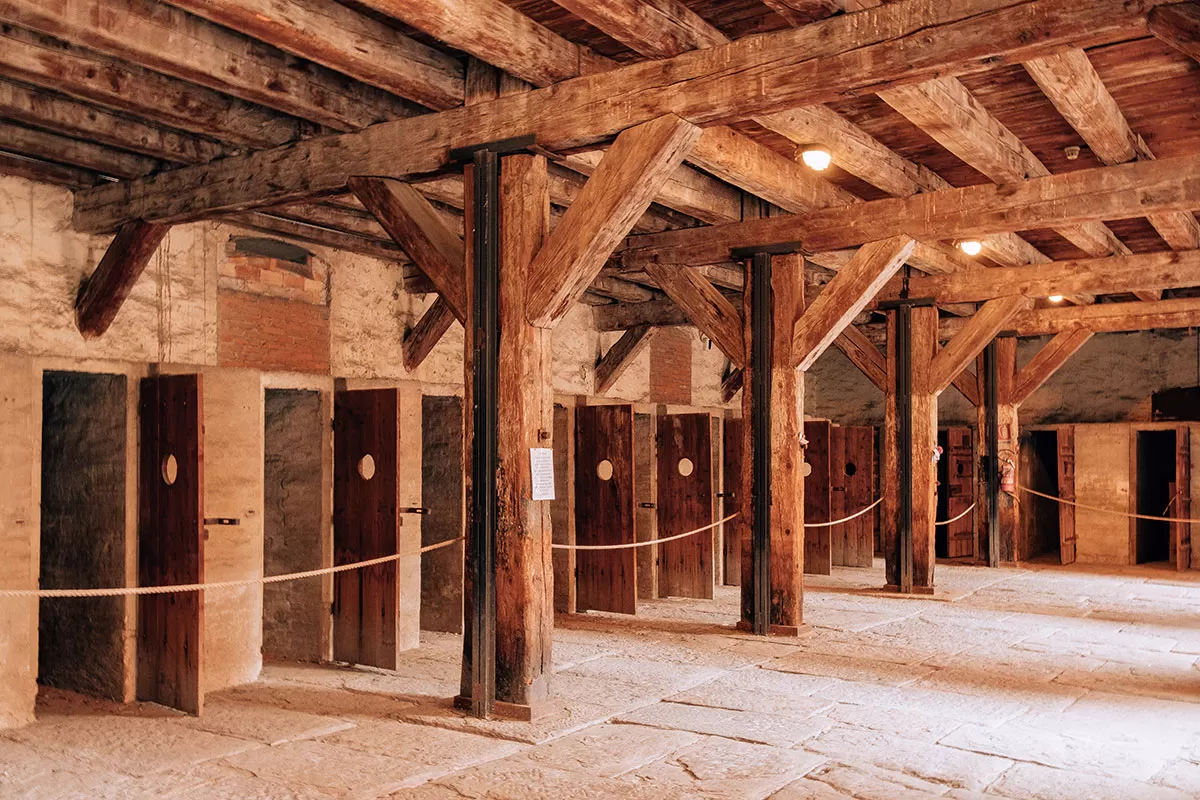
Being a border territory, Trieste had its fair share of dark moments, but the worst came with the Nazi occupation in 1943-1945. The prime testimony of the horrors the city experienced in those years is the Risiera di San Sabba, a former rice-husking factory (hence the name, Risiera in Italian) that turned into a concentration camp during WWII.
The Nazi regime killed an estimated 3,000 political prisoners at the Risiera di San Sabba, and thousands more were deported to larger concentration camps, mainly Auschwitz.
In Italy, there were only two concentration camps; Trieste was the only one with a crematorium. In the 1970s, it became a civic museum with a permanent exhibition about the Nazi crimes in the region.
One of the rooms you can visit is called “ La sala delle croci “(Hall of crosses). Originally divided into floors, on the third floor lived Jewish prisoners that were later deported to Germany. On the second floor were political suspects and on the ground floor were those who worked in the tailor and cobbler workshops.
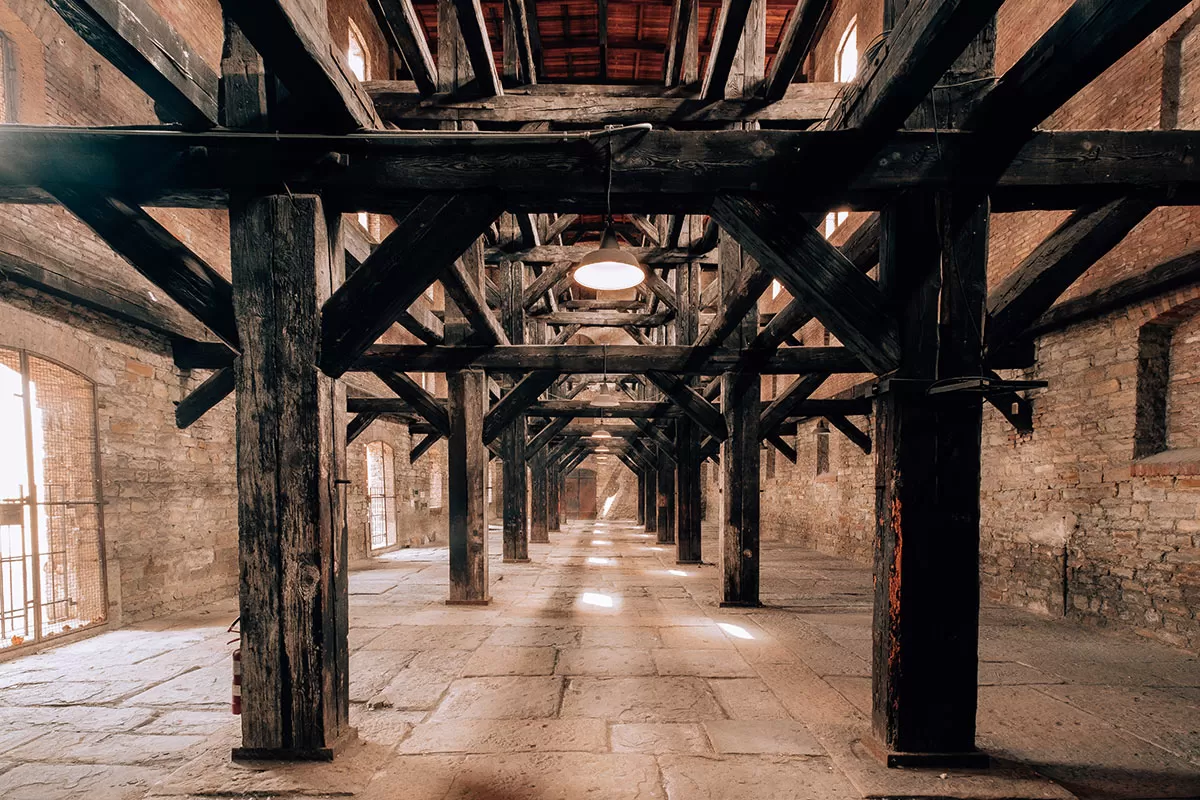
I think it’s important that everyone visits a historical monument such as this. It definitely makes all those history lessons at school more tangible and deepens one’s awareness of what happened. It’s hard to imagine that all this happened not that long ago and in the lifetime of our grandparents.
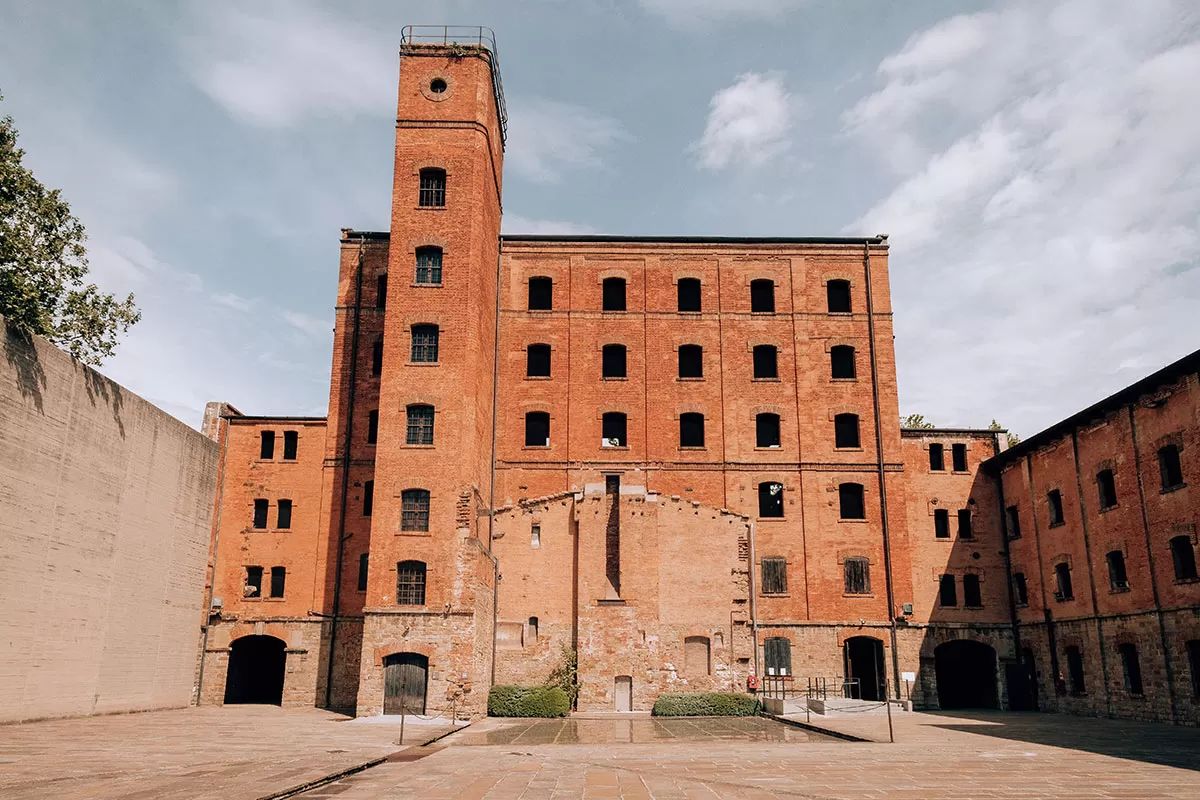
Visiting Risiera di San Sabba is free and takes just a 20 minutes bus ride from the city centre.
Don’t miss: The local tourist office organises monthly tours of Little Berlin, a network of underground shelters built by the Nazis to protect themselves from bombing raids.
For further information, visit risierasansabba.it
19. Browse Revoltella Civic Museum – one of Italy’s major modern art museums
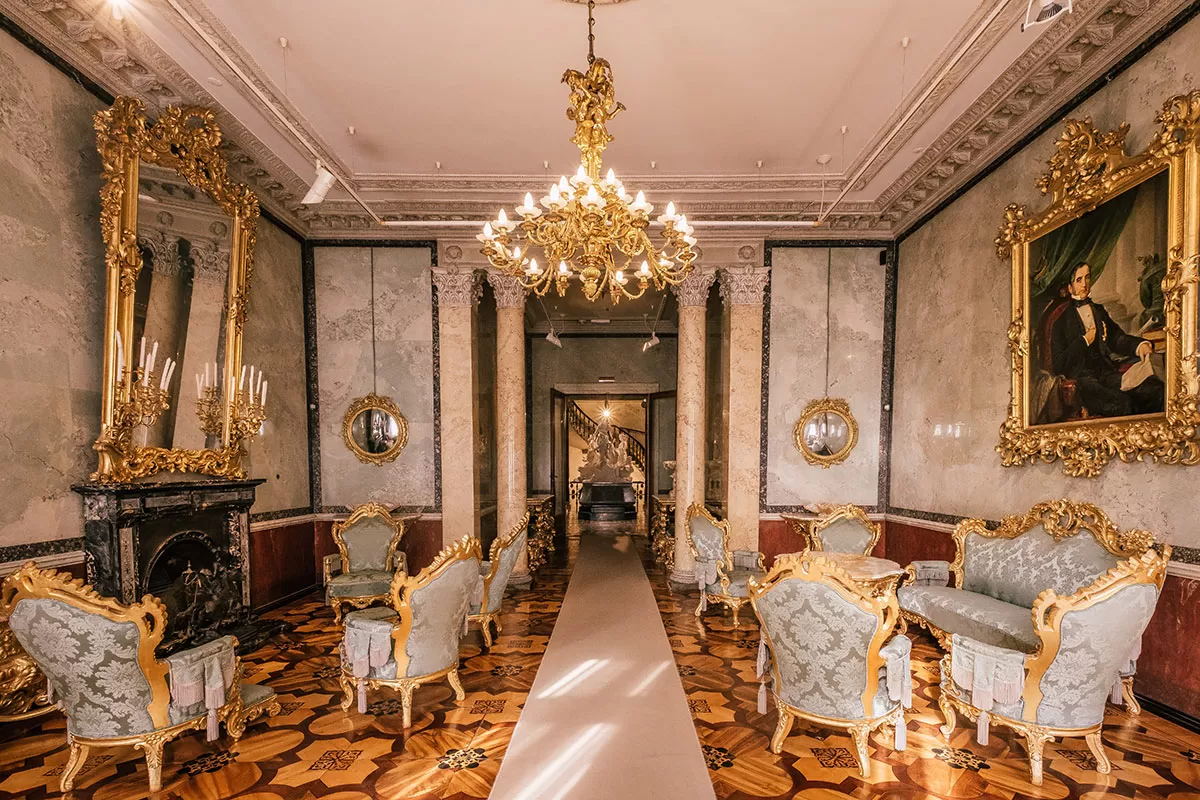
The majority of the collection, as well as one of the buildings occupied by the museum, were bequeathed to the city by Pasquale Revoltella, an entrepreneur who played a crucial role in the opening of the Suez Canal. Artists showcased in its 40 rooms include Mario Sironi, Francesco Hayez, Lucio Fontana, and Giorgio De Chirico.
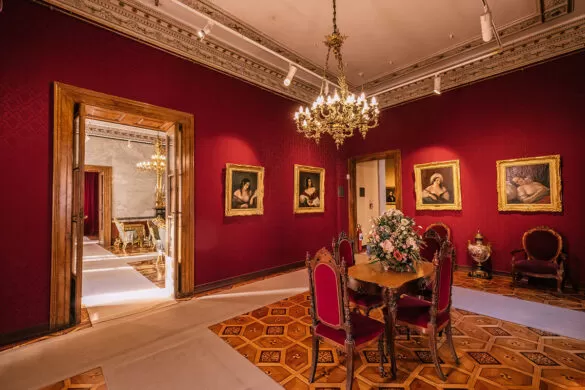
Don’t miss: During your visit head to the museum’s rooftop terrace which is open to the public for views over the harbour. In the evening, during August, there’s even a bar where you can enjoy the views as the sun goes down.
For further information, visit museorevoltella.it
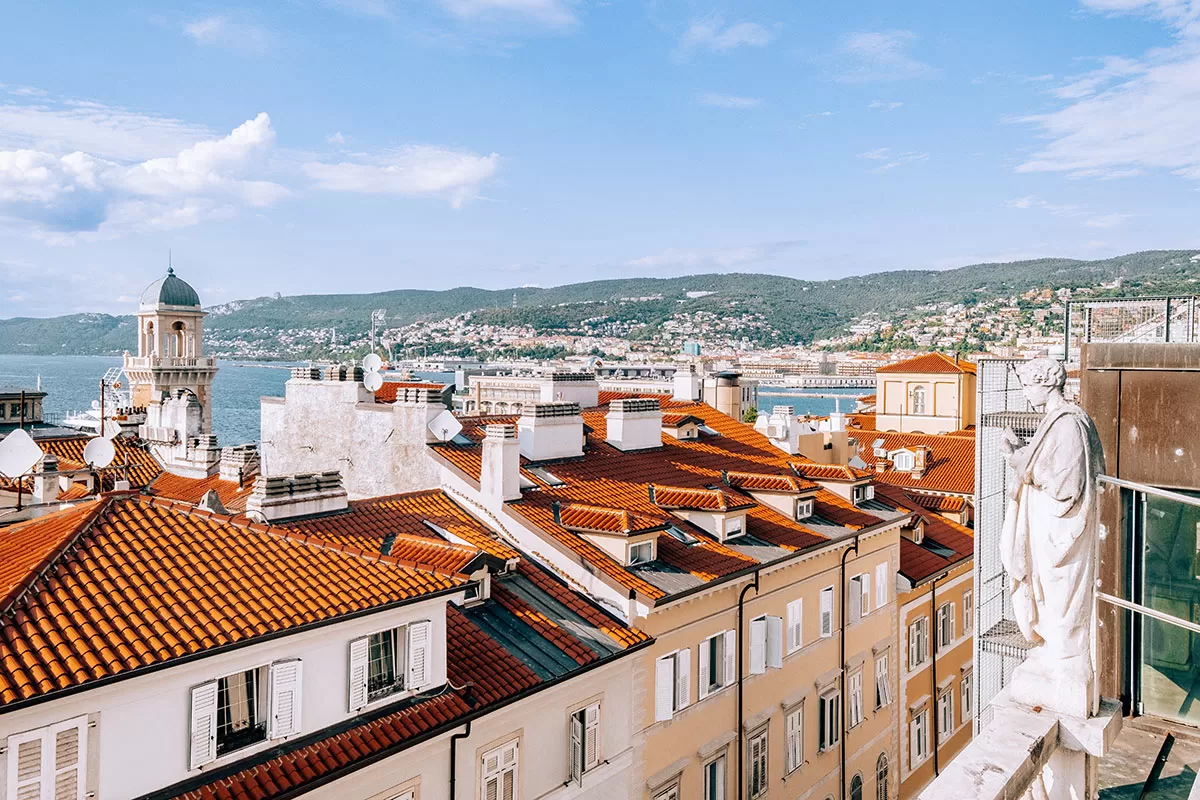
20. Visit one of Europe’s largest Synagogues
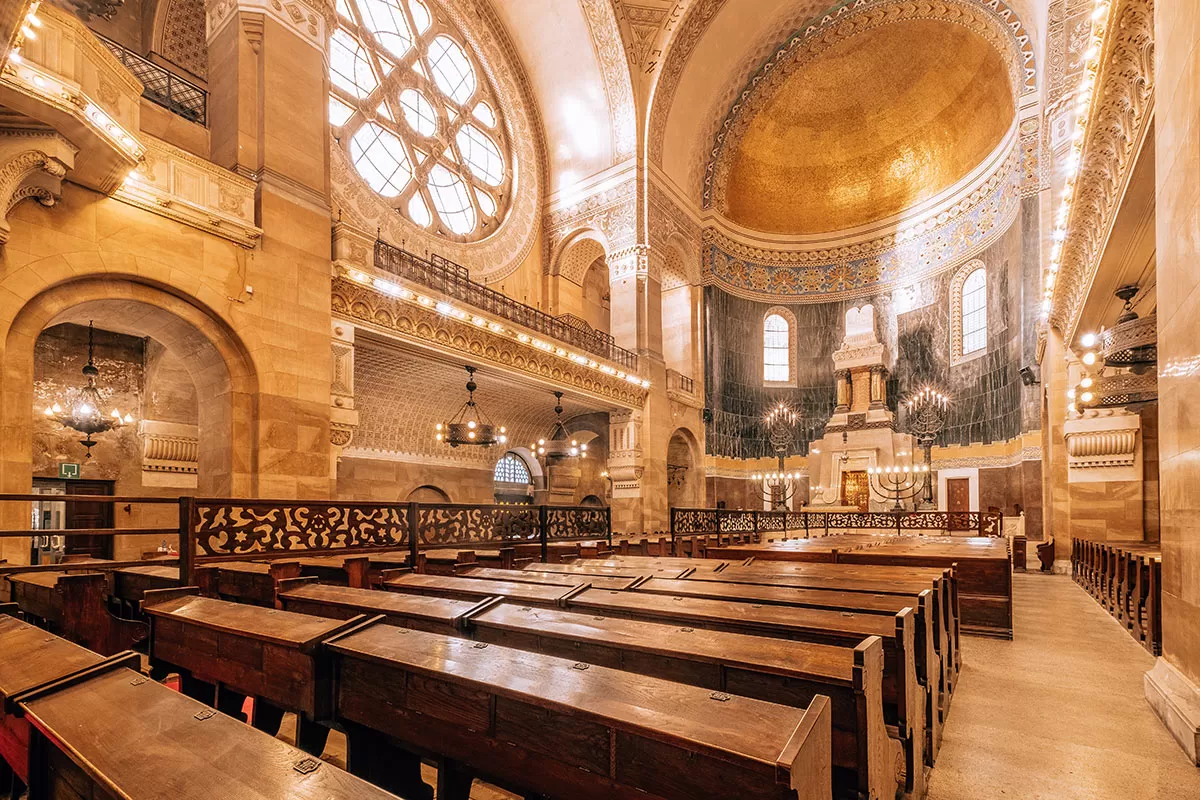
The Jewish community in Trieste has roots in the 13th century, but most arrived in the city during the Empire period, engaging in trade and banking. This grand synagogue is the second largest Jewish temple (holding 1500 people) in Europe after the one in Budapest (which holds 1200 people but is larger in size) and stands as a testament to the cultural importance of the Jewish community to Trieste.
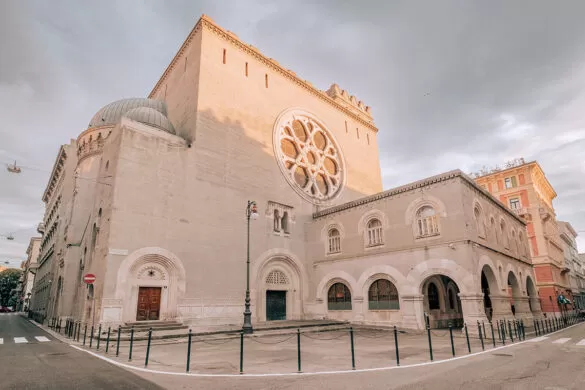
You can visit the synagogue as part of a 60-90 minute guided tour where you’ll learn about the history of the Jewish community of Trieste from the Middle Ages all the way up to the present day. To join a tour, booking is essential and can be organised via the Trieste Ebraica website.
Don’t miss: Located between Piazza della Borsa and the Roman Theater and close to Piazza Unità d’Italia is the old Jewish ghetto. Enjoy the magical atmosphere while browsing through its antique shops and second-hand bookstores.
21. See the Saint Spyridon Church
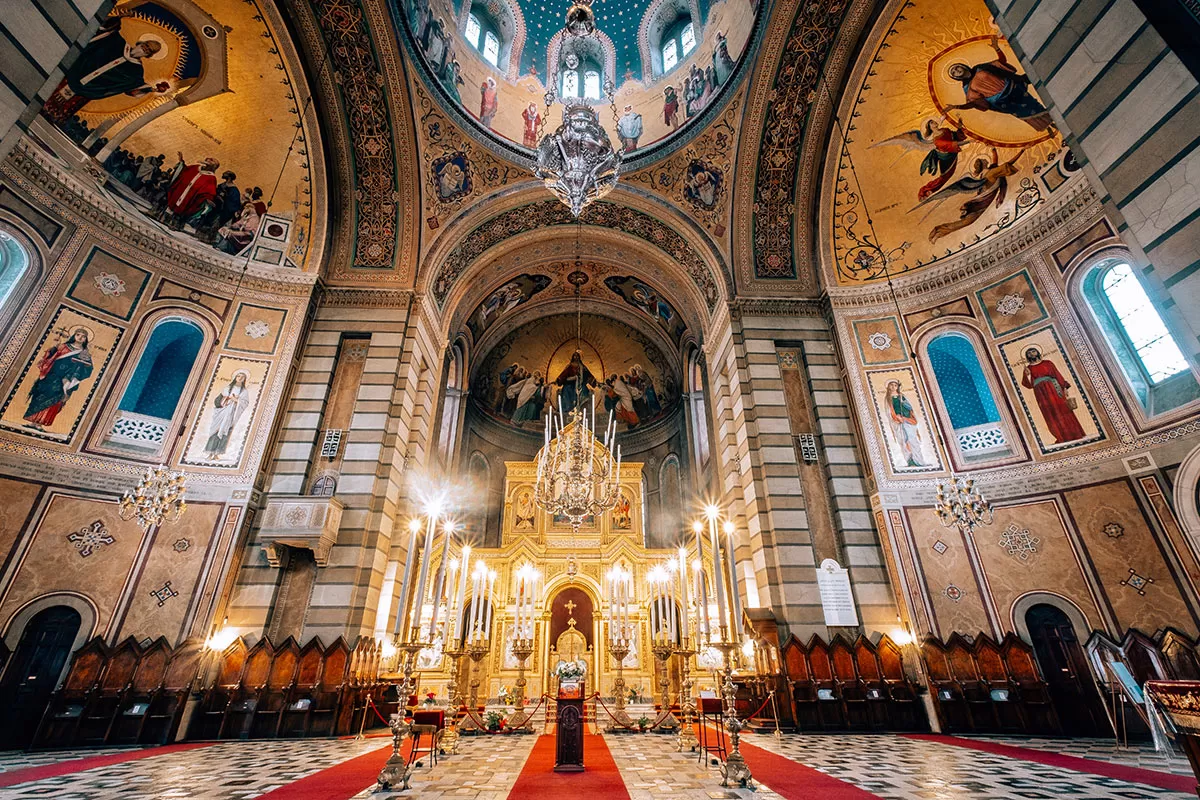
The church was built in the second half of the 19th century after Empress Maria Theresa granted them the right to establish their own religious community. Today, it’s one of the best places to see in Trieste to learn more about the local Orthodox Serbian community, which is the largest in Italy. It boasts all the distinctive architectural traits of Eastern churches, with interiors covered in beautiful frescoes and glittering mosaics.
Don’t miss: Listening to the vesper chants performed by the church’s 24-member choir is pure magic.
22. Explore the Civic Sea Museum (Civico Museo del Mare)
Documenting the city’s extensive naval heritage, the Civic Sea Museum is a must-see in Trieste. Its collection is so rich, that it’s ranked among the most important maritime exhibitions in the Mediterranean. There’s a particular focus on the history of Lloyd Triestino, the shipping company which greatly contributed to making Trieste the flourishing port of the Austro-Hungarian Empire.
The exhibition features documents, model ships and period equipment. They all provide insights into the evolution of the maritime industry as well as life aboard prestigious cruise liners. The collection also includes rare pieces like the zopolo , an ancient canoe carved from a single log, and even the radio technical equipment on the laboratory ship on which Guglielmo Marconi conducted most of the experiments.
Don’t miss: Look for the small key that Marconi used to switch on the Sydney Town Hall on 26 March 1930, at 11:03, by sending a radio signal from Genoa to Australia.
For further information, visit museodelmaretrieste.it
23. Relax with a view at Pier The Roof with sea terrace
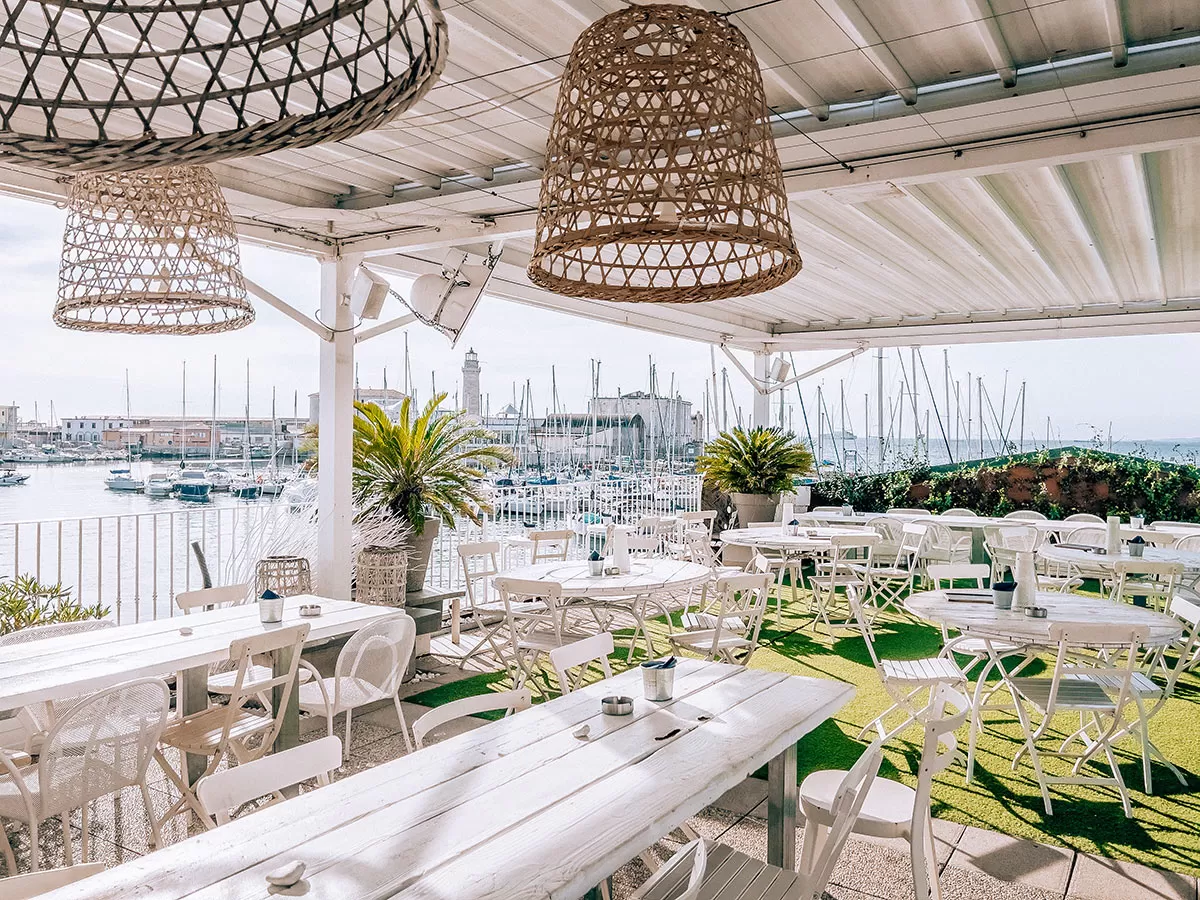
Divided into three areas offering different food & wine concepts, you can come here any time of day for something special. For something casual and informal, head to the outdoor café on the ground floor for breakfast, an aperitif and choose from an à la carte menu.
During summer you can relax at the lounge bar on the upper floor. Here DJ sets help you unwind as you sink into one of their large poufs or beach chairs while nursing one of their many cocktails. When it comes to mealtime, their fish-based menu offers typical Trieste dishes with some international forays.
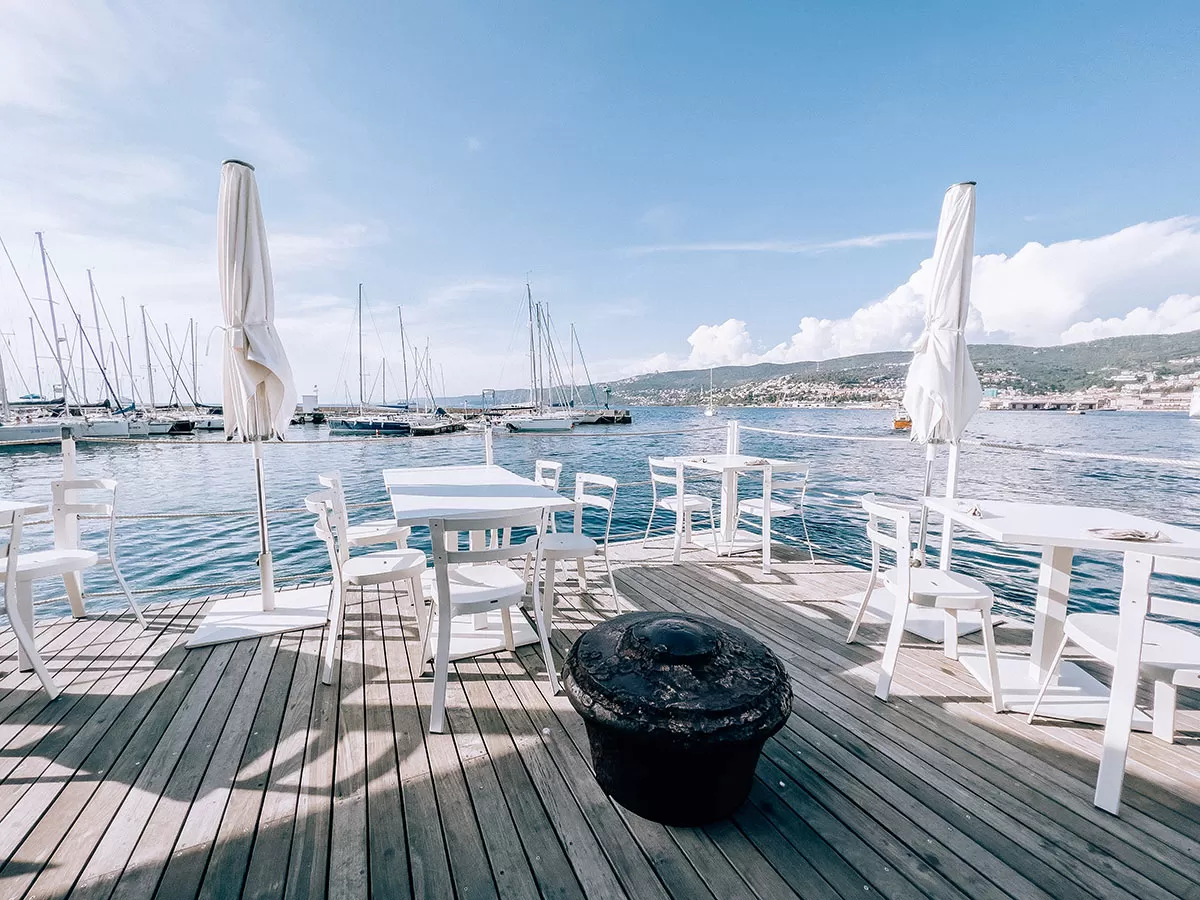
24. The best gelato you’ll ever eat at OGGI Gelato
“It tastes like real melon!” – Me, two seconds after sampling an OGGI gelato.
Located behind Viale XX Settembre lined with restaurants popular with young locals, OGGI Gelato makes high-quality gelato on-site each day. Using only seasonal ingredients, evrey flavour tastes as if you’re eating the actual food itself. The flavours are so rich and creamy that I had to go back twice.
There is an open kitchen where you can see the magic happen from the ingredients fruit being washed, cut and prepared to the gelato machine swirling all the ingredients together. Flavour change often, giving you a good excuse for a return visit.
25. Put your apron on for a fun cooking class
Trieste’s landmarks are enough to keep you busy for days, but why not go further and enhance your visit with a first-hand cooking experience? Considering the city’s unique history and location, the local cuisine has taken on layers of influences from every culture that settled there, making cooking classes all the more interesting.
There’s a lot of seafood in local kitchens, and also meat that’s based on Mittel European traditions. The first courses are tasty and varied (a must-eat is the jota soup), and the desserts are reputed to be among Europe’s finest.
Don’t miss: For a taste of authentic local cuisine, try one of the city’s typical buffet . An institution in Trieste, these eateries specialise in Triestine comfort food like boiled meats cooked in a traditional pot called “caldaia”.
Want to attend a cooking class in Trieste and dazzle family and friends back home? Then I recommend booking this fabulous Pasta and Tiramisu class !
26. take a day trip.
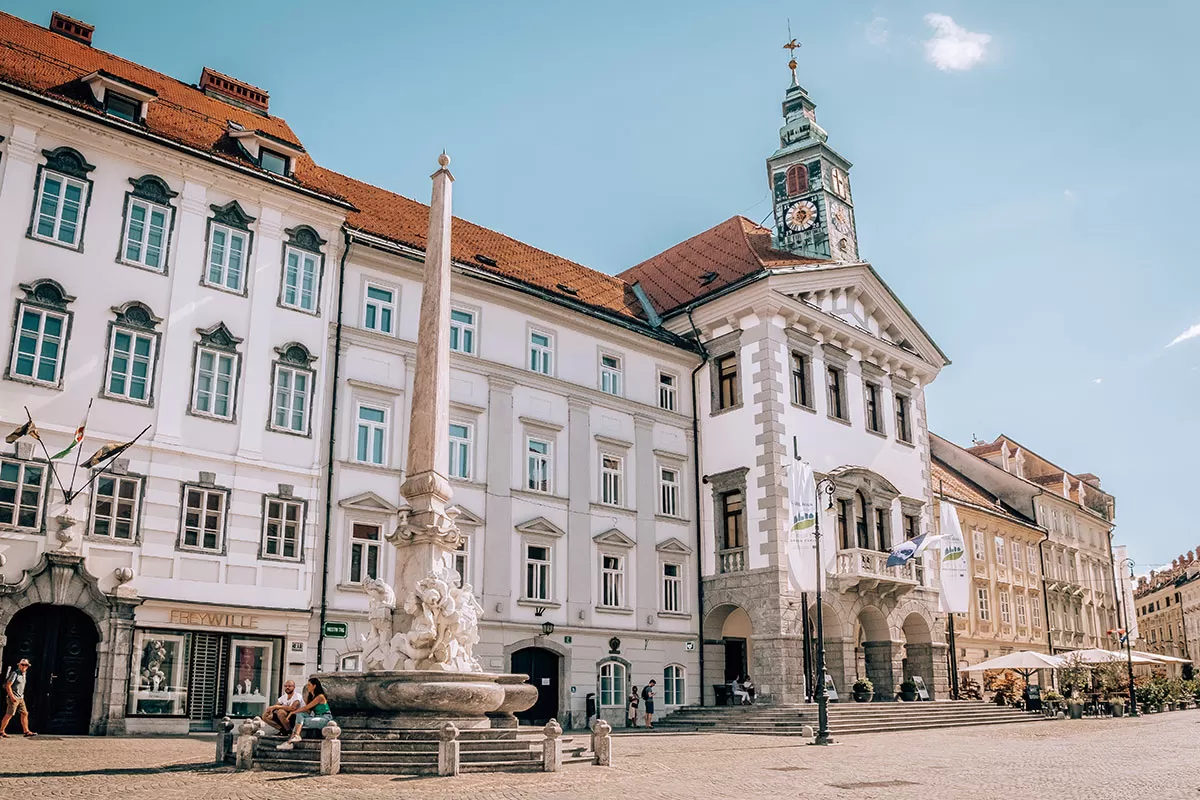
Trieste is a great destination on its own, but if you’ve got extra time on your hands, a day trip is a great way to explore a bit of Friuli Venezia Giulia. Regional highlights include the Roman archaeological site of Aquileia, the beautiful beaches of Grado, Gorizia’s scenic old town, and mini-Venice Muggia.
If you like hiking and cycling, then exploring the Carso Triestino is one of the best things to do in Trieste. It’s a rock plateau of great naturalistic importance that the city shares with southwestern Slovenia, offering plenty of trails. This area is also home to Val Rosandra, a large nature reserve with a 40ft waterfall.
Neighbouring Slovenia is another popular destination from Trieste, offering fairy-tale landscapes and postcard-perfect villages to explore. You could combine a tour of its vibrant capital city with a visit to the country’s famous lake on this Lake Bled and Ljubljana guided tour from Trieste . Or you can explore one of Slovenia’s largest cave systems and an amazing cave-built castle on a 5-hour Postojna Cave and Predjama Castle from Trieste .
27. Take a day trip to Lake Bled and Ljubljana
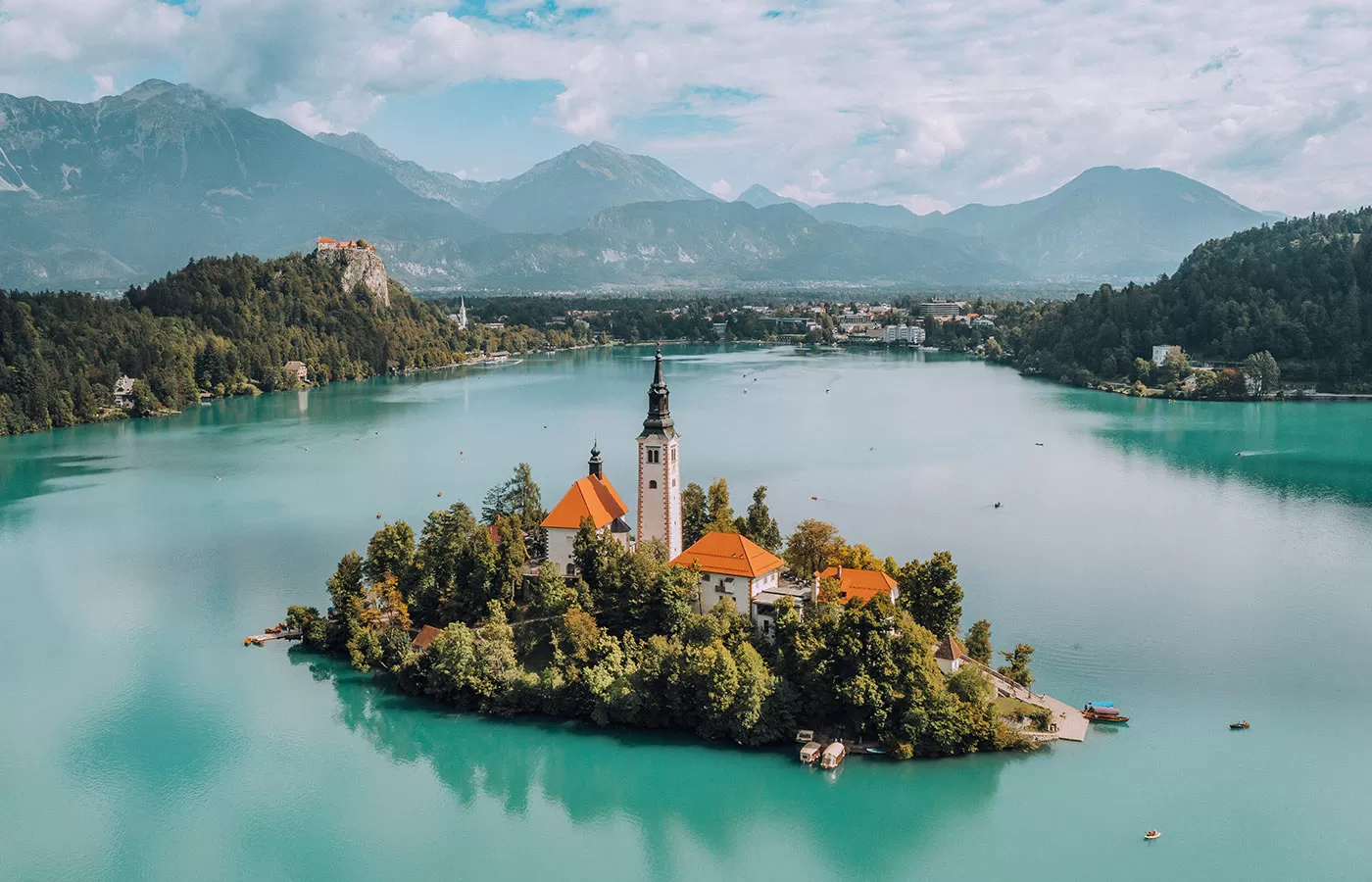
If you go by public transport it will take you almost 5 hours just to reach Lake Bled from Trieste or 2.5 hrs to reach Ljubljana. On this tour, it only takes a little over an hour to reach your first stop, the stunning Lake Bled with a small island floating in the middle.
Called Bled Island, (Blejski otok), the island has several buildings, the main one being the pilgrimage church dedicated to the Assumption of Mary, built in its current form near the end of the 17th century. The church frequently hosts weddings where traditionally it is considered good luck for the groom to carry his bride up the steps on the day of their wedding before ringing the bell and making a wish inside the church.
The traditional transportation to Bled Island is a wooden boat known as a pletna. The word pletna is borrowed from Bavarian German Plätten, meaning ‘flat-bottomed boat’. Some sources claim the pletna was used in Lake Bled as early as 1150 AD, but most historians date the first boats to 1590 AD. Similar in shape to Italian gondolas in Venice , a pletna seats 20 passengers.
While you’re here you have to try the area’s culinary speciality, a cream pastry called kremšnita or cremeschnitte , which was designated a protected dish of designated origin in 2016 by the Slovene government. Also known as vanilla slice or custard slice, kremšnita is a custard and chantilly cream cake dessert commonly associated with the former Austro-Hungarian Monarchy.
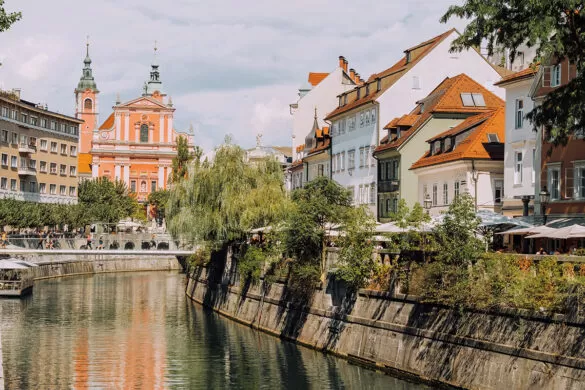
After an hour of wandering around the lake, it’s time to head to the capital for a short guided tour of the historical centre before enjoying some free time.
To find out more about this guided tour I joined, you can check availability and book your tour here.
Don’t be treated like a tourist. learn italian with my 80/20 method.
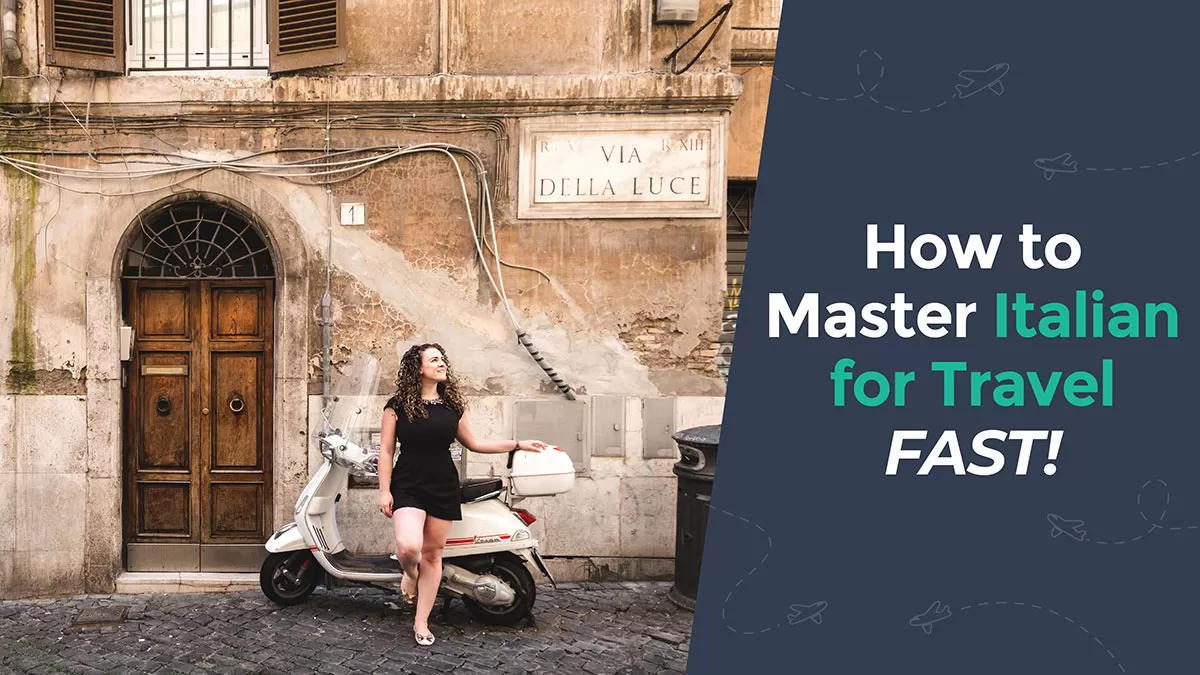
Travelling to Italy? Don’t be treated like a tourist! Live your best travel experiences and learn Italian for less than the cost of eating at a tourist trap restaurant or a taxi driver who has “taken you for a ride”. I’ve made it easy for you to master the Italian language so you can create lifelong memories as you mingle with locals , get local tips , avoid tourist traps , and make new friends . Who knows, you might even be invited over for afternoon tea by a lovely Sicilian family like I was! Read all about how speaking Italian changed my life and check out my online Italian video course here.
Here’s what my students are saying:

I really enjoyed the Intrepid Italian course, it certainly exceeded my expectations. The learning methodology is great, and easy to follow and found that I progressed much faster in the last 4 weeks than I ever did on my own or using other language apps. Grazie mille Michele, I can’t wait until I can put my new skills into action! – Roma Small
Click here for instant access!
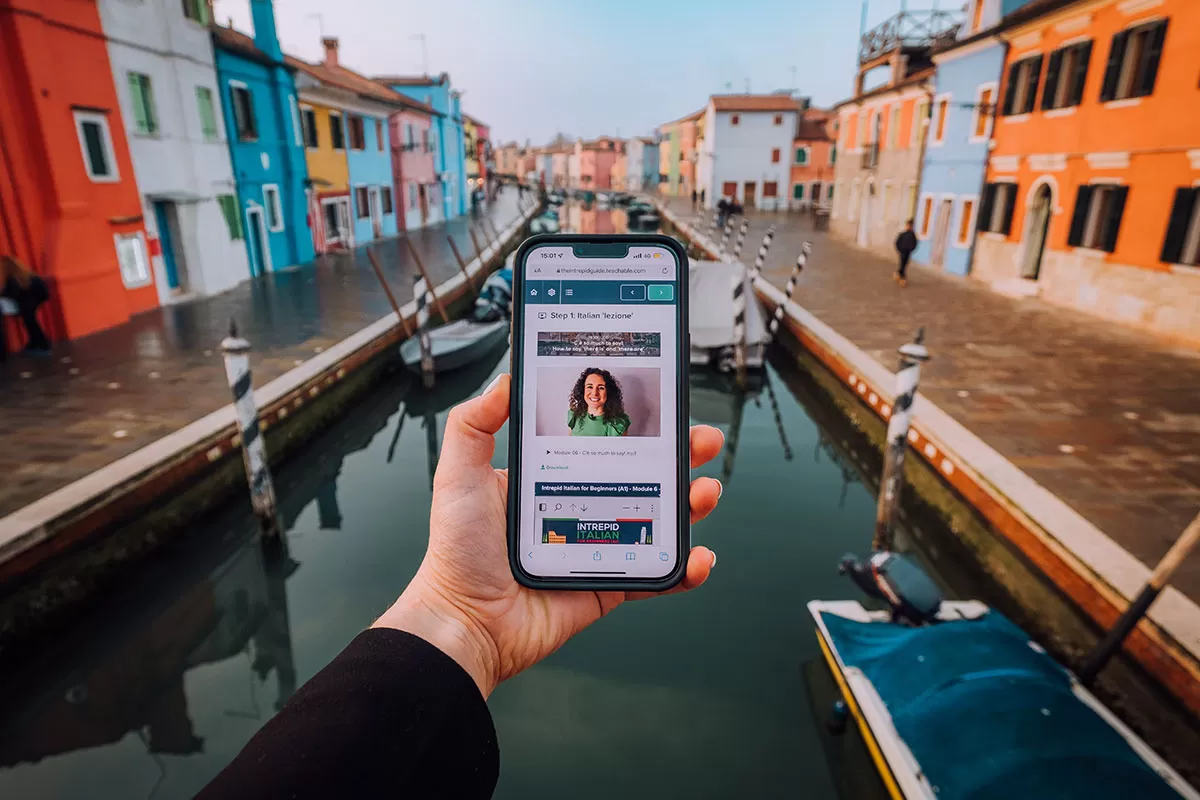
Don’t miss these Italy travel guides
- 33 Italy Travel Tips That Will Save You Time, Money and Disappointment
- Best Time to Visit Italy // PLUS Tips to Avoid Crowds and SAVE $$$
- Rome Tips and Tricks: 27 Things You Should Know Before You Go to Rome
- 29 Amazing Day Trips from Rome By Train, Car & Guided Tour
- 36 Wonderful Things to do in Umbria, Italy (PLUS Map of Umbria)
- 21 Best Things to Do in Venice, Italy (From Rooftop Views to Private Tours)
- Top 10 Things to Do in Rome That Aren’t On Your List
- Where to Stay in Rome | Best Hotels and Best Neighborhoods to Stay in Rome
- Top 10 Absolute Best Views of Rome That Will Blow Your Mind
- Domus Aurea: Visit Rome’s Secret Hidden Palace
- Self-Guided Trastevere Walking Tour: Where to See Rome’s Most Beautiful Streets
- 12 BEST Things to do in Burano, Italy (Tips from a Local Guide)
- Absolute Best Things to do in Verona, Italy | 26 Must-See Attractions
- Where to Stay in Verona: Best Hotels in Verona Neighbourhoods
- Where to Stay in Venice | Best Hotels in Venice for Every Budget
- THE 15 BEST Hotels in Trieste, Italy [2023 Edition]
- What it’s like Staying at DoubleTree by Hilton Trieste
- Top 7 Authentic Tours and Experiences in Rome [Run by Locals]
- Lakes, Mountains & Castles: 21 Best Things to do in Trento, Italy
- Italy Fun Facts: 126 Unique Things You Didn’t Know About Italy
Like it? Pin it for later!
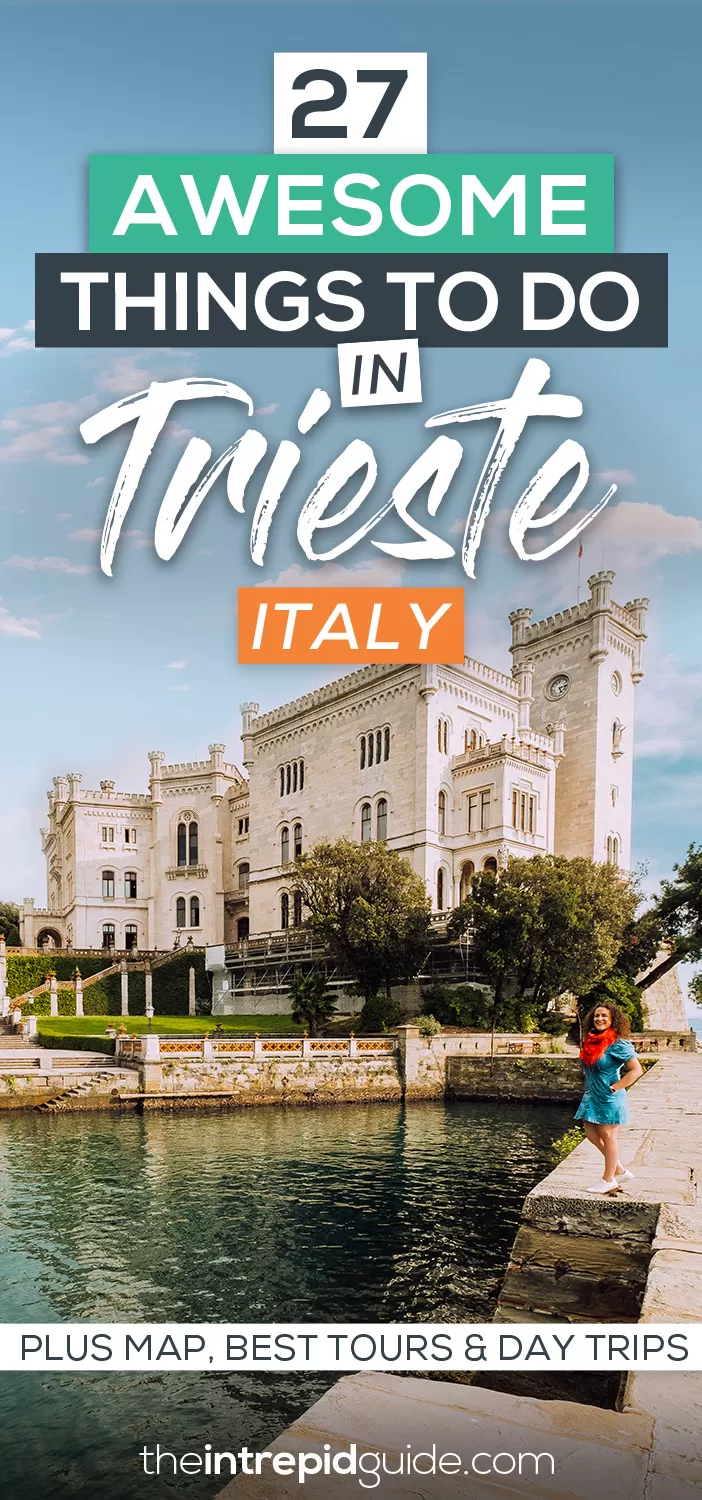
Over to you!
Got a question about visiting Trieste? Let me know using the comments section below or join me on social media to start a conversation.
Thanks for reading and I hope you enjoyed this post.
Like what you see? Subscribe using the form below to have all of my posts delivered directly to your email.
Success! Now check your email to confirm your subscription.
There was an error submitting your subscription. Please try again.
Get my best language and travel tips FREE by email...
Subscribe to my newsletter to receive detailed travel guides, exclusive travel and language learning tips, priority access to giveaways and more!
I will never give away, trade or sell your email address. You can unsubscribe at any time.
Michele creates language learning guides and courses for travel. What separates her from other instructors is her ability to explain complex grammar in a no-nonsense, straightforward manner using her unique 80/20 method. Get her free guide 9 reasons you’re not fluent…YET & how to fix it! Planning a trip? Learn the local language with her 80/20 method for less than the cost of eating at a tourist trap restaurant Start learning today!
20 TOP Things to do in Porto Santo Island // A Perfect Day Trip from Madeira
33 best things to do in thessaloniki, greece (the ultimate itinerary), you may also like, 15 best hotels in trieste, italy [2024 edition], doubletree by hilton trieste: a detailed review [2024], leave a comment cancel reply.
Save my name, email, and website in this browser for the next time I comment.
This site uses Akismet to reduce spam. Learn how your comment data is processed .

If you don't know where you are , how do you know where you're going? Find out how well you know Italian grammar today!
- South Africa
- El Salvador
- Bosnia and Herzegovina
- North Macedonia
- Czech Republic
- Transnistria
- Liechtenstein
- North Cyprus
- New Zealand
- Map with posts
- Alternative Guides
- Architecture Guides
- Cafe Guides
- Itineraries
- Neighborhood Guides
- Travel Guides
- Travel Tips
- Photo Galleries
- Photo Locations
- Solo female travel
- Train Travels
- Work with me
- Privacy Policy
25 Wonderful Things to Do in Trieste, Italy
Located right at the border with Slovenia , Trieste is one of the most interesting cities to visit in Italy. For centuries the place was at the crossroads, under different rules and influences that created a peculiar cosmopolitan city and its unique vibe that visitors can enjoy today.
But still, not that many people visit Trieste (in comparison with other popular destinations in the area) and I believe they miss a lot.
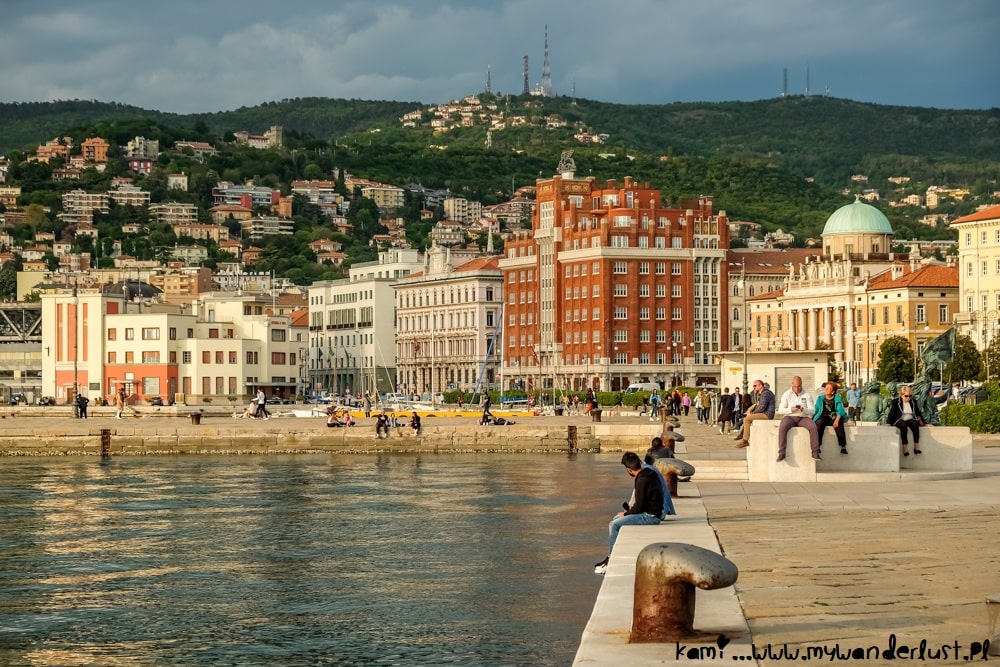
I’ve been to Trieste twice and I know I will be returning there in the future again as the city is pretty amazing and I couldn’t get enough of its stunning architecture, distinctive atmosphere, and all the amazing things to do in Trieste.
If you plan a trip to Trieste I put together this Trieste guide that will help you enjoy the city to the fullest.
Planning a trip to Trieste?
Here are the highly-rated hotels, tours, and services recommended for your trip:
Accomodation:
- Boutique Hotel Albero Nascosto (9.2/10)
- Residence Theresia (8.5/10)
- 9 stanze – Boutique Rooms (9.2/10)
Tours and activities:
- Experience Trieste
- Prosecco’s Roots & the Karst Region
- Postojna Cave & Predjama Castle from Trieste
Internet: Stay connected with Airalo eSim card – click here to get yours!
Insurance: Get insured for your trip to Italy with SafetyWing
Car rental: Compare prices and find the best deals on rental cars in Italy on Discover Cars .

Table of Contents
Where is Trieste
Trieste, the city of over 200 thousand inhabitants and the capital of the Friuli Venezia Giulia region, is located in the very north-east corner of Italy, literally right at the border with Slovenia.
The nearest capital is Ljubljana (the capital of Slovenia) which is less than 100 km away from Trieste. Other “nearby” popular cities include Venice (160 km away), Milan (400 km away) or Bologna (300 km away).

Why visit Trieste
Trieste is probably the most cosmopolitan and multicultural city in Italy.
Even if the first settlements in the area date back to ancient times (and you still can find numerous remnants of those in the city), most of Trieste’s history is connected with Austria. During the Habsburg rule, Trieste was the main port of the Austrian empire, its window to the world. Many of the grand Trieste monuments are from that era and are a perfect testimony to the times of prosperity.
Trieste became part of Italy only in the 20th century and the city you can visit today is this unique blend of different cultures and influences. The city is packed with monuments and attractions but is also a good base to explore more of the Friuli Venezia Giulia region as well as nearby Slovenia .
But one of the best things about Trieste is its cosmopolitan, distinctive vibe that is so different from the rest of Italy.
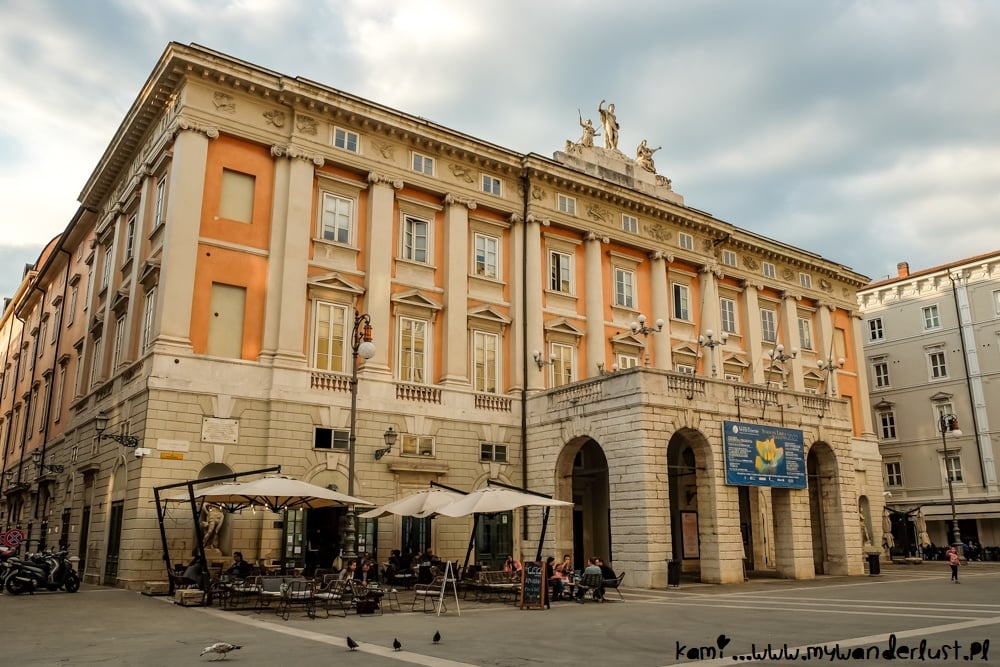
How to get to Trieste
Trieste is easily reachable from numerous destinations in Italy, as well as from abroad.
There are frequent direct trains from Udine and Venice as well as fast trains from Rome, Florence, Milan, and Turin. There are also daily direct connections with Slovenia and Austria ( Vienna ).
You can also reach Triest by bus from some places in Italy as well as from Slovenia (including Koper which is just 25 km away) and Croatia (mostly Istria ).
Trieste also has its own international airport with flights from both Italian and European airports.

How many days for visiting Trieste
If you want to see the city properly you need at least two days in Trieste. This way you can also see attractions located a bit away from the center and enjoy the amazing local cafe culture.
Add some extra days for day trips from Trieste as there are a few really fine places to visit nearby.
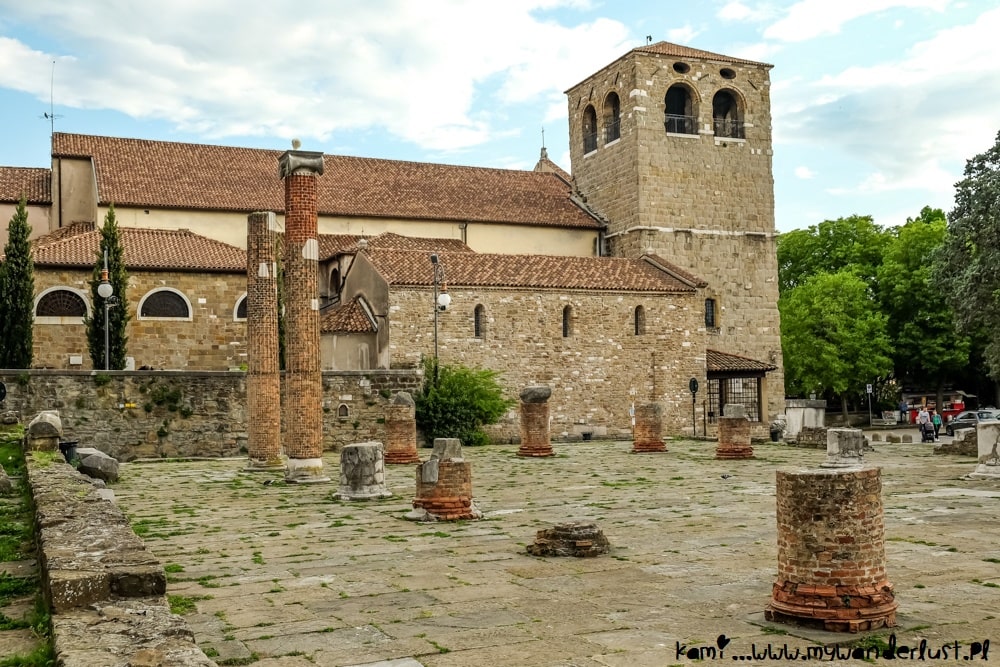
How to get around Trieste
You can reach all the centrally located attractions on foot and well, wandering around is actually one of the best things to do in Trieste.
If you need to get to places a bit further away you can use the public transport system with frequent buses covering the whole city. The fare is 1,25€, the tickets can be bought from kiosks or machines and need to be validated when entering the bus.
You can also use the hop-on-hop-off bus that will take you to all the best Trieste attractions – click here for details and to get the ticket.

Things to do in Trieste
And now, without any further ado, let’s talk about the best things to do in Trieste, in no particular order.
Stop for a drink in a historical cafe
Before you start a proper Trieste sightseeing, sit down in one of the many historical cafes to soak in the atmosphere of the city and its history.
Trieste is known for the unique cafe culture that is a bit different than in the rest of Italy. Here cafes are a testimony of the Habsburg past since the city was the main harbor in Austria-Hungary, the window to the world, and the first entry point of coffee brought to the empire from all over the world (Austria-Hungary was known for its amazing cafe culture).
Today, many historical cafes are a reminder of that times. In fact, coffee consumption is twice as high as the average number in Italy and the locals have their own slang when ordering coffee (i.e. “Capo in B” is “cappuccino”).
The first cafe was opened in 1768 and since then many cafes appeared in the city. Some of them have their own coffee brands and blends and you can wander from one cafe to another and try different drinks everywhere. Many historical cafes have also a beautiful vintage interior that makes spending time there even more relaxing.
Some of the best and most important historical cafes in Triest are Caffè San Marco, Caffè degli Specchi, Caffè Tommaseo, or Antico Caffè Torinese.
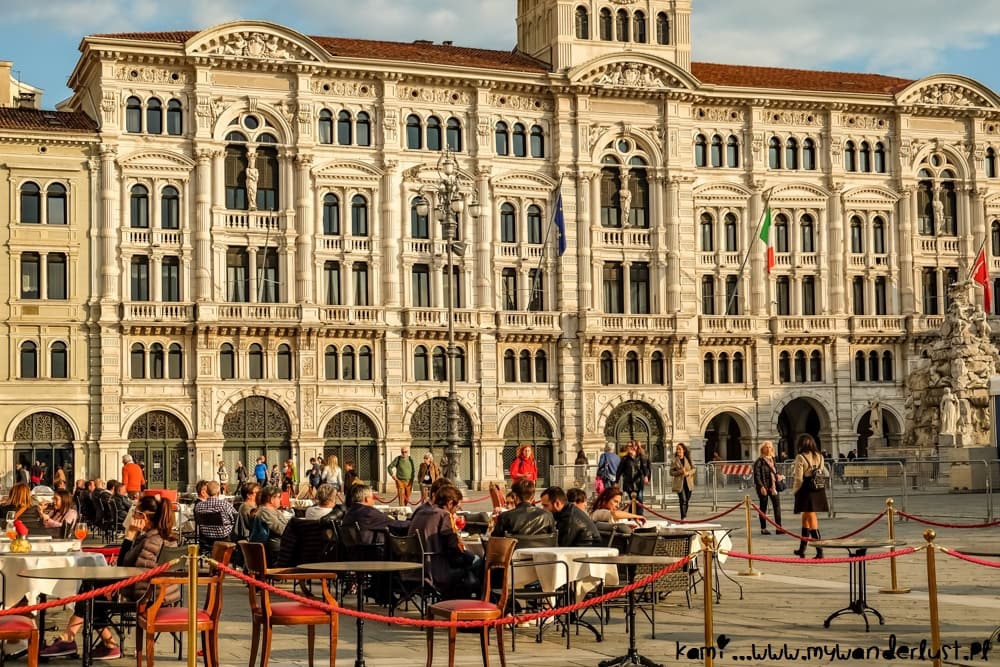
Marvel at the stunning Piazza Unità d’Italia
The main square of Trieste, Piazza Unità d’Italia, is also where you will find the most spectacular architecture in the city. As soon as you stop at the square, your jaw will surely drop at all the beauty around.
Located between the seaside and the castle hill, Piazza Unità d’Italia was built during the Austria-Hungary rule and it is still believed to be the largest European square facing the sea.
The most important institutions in the city are located here: the city’s municipal building, the Prefecture of Trieste, and the former head office of Italia Marittima, just to name a few. They all are placed in stunning old palaces, which facades are packed with details.
Piazza Unità d’Italia is a real architectural gem of the city, I spent so much time looking at the buildings and admiring their beauty. The square is often used for various events (which was sadly the case when I visited hence I couldn’t fully grasp it) and is one of the Triest top places to visit, to observe the people and to enjoy the city’s vibe.
You can learn more about Piazza Unità d’Italia as well as about other important places in Trieste and its Habsburg past on the highly-rated tour – click here for details and to book the place.

See the picturesque Canal Grande
One of the most picturesque (and Instagrammable) places to visit in Trieste is Canal Grande, located halfway between the train station and Piazza Unità d’Italia.
It dates back to the mid-18th century and was built to help the boats delivering goods arrive closer to the center to unload. Originally, the canal was even longer than today, reaching past the church of Sant’Antonio (that is now a very distinctive spot in the city’s scenery).
Buildings along the canal include churches and palaces and are among the most interesting you can find in Trieste, most of them dating to the first half of the 19th century. There are also a few bridges that help cross the canal and some interesting statues, like James Joyce.
Canal Grande is yet another of Trieste’s highlights that you shouldn’t miss!

Admire the panorama of Trieste from Castello di San Giusto
The best place to admire the impressive panorama of Trieste is Castello di San Giusto, located a short uphill walk from the center of the city.
The first fortified settlement here was built already in ancient Roman times but the castle we can visit today dates back to the 16th century. When visiting the castle you can see an interesting collection of ancient artifacts but the main reason to come here is for the panorama of Trieste.
From the fortification walls and bastions, you can admire the breathtaking vista of the whole city, that’s where you can fully appreciate the beauty and greatness of Trieste. It’s definitely worth paying the small entrance fee to see this view!

Admire the beautiful Trieste waterfront
Trieste waterfront is one of the best places in the city for a leisure stroll. It seems like no one is in hurry here, everyone seems to enjoy to the laid-back vibe of the place.
That’s also where you will find some of the most impressive buildings in Trieste and some fancy palaces that are a true testimony of the wealth and importance of the city.
The only downside of the waterfront for me was that there were not enough benches around as I would have gladly sat down there to enjoy the place more.

Visit Museo Revoltella
If you have time to visit only one museum in Trieste, it must be Museo Revoltella.
This collection of modern art is located in the beautiful palace from 1858 as well as neighboring buildings. Museo Revoltella is home to the collection of art (including Italian and European artists), furniture, and other items left by Baron Pasquale Revoltella at the end of the 19th century.
Besides art and stunning interiors, you can also admire a beautiful panorama of the city from the museum’s rooftop.

Relax in Villa Revoltella Park
Another place worth visiting in Trieste that is connected to the Revoltella family is the Villa Revoltella Park, located on the hill on the outskirts of the city. It is named after Pasquale Revoltella who, in his will, donated the park to the city, ensuring that it will always be open to the public.
The green oasis is a perfect escape from the hustle and bustle of the city. It is divided into three parts and besides the beautiful garden, you can also find there a church and a chalet residence.

Witness the past at Teatro Romano
Right in the heart of Trieste, you can find probably the best testimony of the city’s great past – the Roman Theater. The ruins date back to the 1st or 2nd century AD and the theater could fit around 3500 spectators in its glory times.
For centuries it was hidden by the newer buildings in the city and it was brought to light only in 1938 (although its existence has been known since 1814). You can find the Roman Theater at the side of Via del Teatro Romano, not far from the Piazza Unità d’Italia.
Even if these are only ruins, the place is still impressive, especially in these modern surroundings. All the old artifacts that were found on site are kept in the museum in Castello di San Giusto.

Visit Trieste Cathedral
When visiting Trieste Castle don’t miss the Cathedral, located just a few steps away. The first religious site was built here already in the 6th century, but the current Romanesque/Gothic structure dates back to the early 14th century.
Even if the building isn’t very rich in decoration, it still is very impressed with the old elements (such as the original mosaic floor) from the time when the church was completed.
At the end of the 19th century, the cathedral was granted the title of the basilica minor, which significantly increased its rank.

Be amazed by jellyfish
Each year in springtime many jellyfish arrive on the shores near Trieste but when I visited the city in early May 2022 the waters in the center (including the Canal Grande) were literally packed with these creatures. And not small ones but giant jellyfishes that could as well be seen in the aquarium.
I was mesmerized, never seen so much maritime beauty in the wild (although in the middle of the big city).
When you visit Trieste in the springtime, be sure to check the surrounding waters for jellyfish too as they surely are amazing! There might not be such an invasion as I witnessed but even one or two of these water animals can be fascinating.

Stroll down Molo Audace
One of the most popular places for a stroll in Trieste is Molo Audace pier, extending over 200 meters into the sea, not far from Piazza Unità d’Italia.
It was built in the place where the San Carlo ship sunk at the end of the 18th century originally the pier was 95 meters long, extended to the current shape during two reconstructions. At first, it was named after the said ship but after World War 1 the locals started calling the place Molo Audace, after the warship with the same name that arrived at Trieste harbor.
Today the pier is a busy spot where locals walk around or hang out with friends. You should definitely stroll Molo Audace too as you can admire a beautiful panorama of the Trieste waterfront and the main square from there.

Peep into the Old Harbour
Trieste has one of the largest and most important harbors on the Adriatic Sea. It was also the main port of the Austrian Empire when the city was part of it.
There is a part of the harbor that dates back to these times, currently closed to the public but you can still peep into it from the nearby parking lot.
The Old Harbour in Trieste was built between 1868 and 1887. There are several large buildings that still wear all signs as well as the old railway line with some rusty trains.
This must be a wonderful place for some urbex exploration but unfortunately, I didn’t find any way to get it (although I didn’t look close enough, I admit).
I’m not sure what the city’s plans are for this area but I hope that even after a possible reconstruction the Old Harbour will keep its vintage charm as it has now.

Admire the stunning architecture
One of the things I enjoyed the most about Trieste is the stunning architecture in the central part of the city. It’s a peculiar mix of influences from Austria and Italy as well as, thanks to its important port, from all over the world. Some of the incredible buildings reminded me of a few grand structures in Madrid or South America.
The most impressive buildings are located along the waterfront, with numerous palaces and buildings of public use, but even if you go a bit away from the seaside, the architecture still can impress.
When wandering around it’s worth looking up a bit to spot fine details of houses built in art nouveau, eclectic or neoclassic styles – they will help you to appreciate Trieste’s architecture even more.

Visit Miramare Castle
One of the biggest Trieste attractions, Miramare Castle, is located a bit away from the center but is easily reachable by public transport (trains and buses).
This beautiful and majestic castle was built in the mid-19th century right on the shore of the Adriatic Sea, for Archduke Ferdinand Maximilian Habsburg (a younger brother of Franz Joseph, the Emperor of Austria). The castle is surrounded by an equally beautiful park with rare and exotic plants and trees that were brought from all over the world here by the Archduke himself.
Miramare Castle was a favorite home of the Archduke and his wife but they could live here only for 4 years, before leaving for Mexico where Ferdinand Maximilian was crowned and shortly after executed. According to the legend, the devastated ghost of his wife still wanders around the park.
When visiting the castle, it’s worth going inside too to see the original interiors that are a perfect example of the 19th-century aristocratic lifestyle.

Say hello to Sissi
The most beloved ruler in Austrian history, Empress Elisabeth known also as Sissi, is until today a popular figure, known by people beyond the region of Central Europe . There were numerous movies and books telling the story of her life (and more are soon to come).
When traveling around the former Habsburg Empire you will easily spot memorabilia dedicated to Sissi and her husband, emperor Franz Joseph. And Trieste is no different.
Across the train station, at Piazza Della Liberta, you will find a fairly modest monument dedicated to the Empress, with just one word, “Elisabetta”. Originally it was erected in that place in 1912 but removed nine years later and for most of the 20th century, it was kept in storage, returning to its original spot only in 1997.

See the impressive lighthouse
One of the most recognizable Trieste landmarks, visible from most parts of the city, is the Victory Lighthouse. Even if it is located a bit away from the center, it’s really hard to miss it.
The impressive lighthouse, with a height of 68 meters, is among the tallest lighthouses in the world. At first, it was planned to build the lighthouse near Pula in current Croatia but eventually Trieste and Gretta hill was chosen due to their perfect height and solid foundations of the former Austrian fort.
The lighthouse was opened in 1927 and is still working today. The place is dedicated to those who died at the sea during WW1 and commemorates the Italian victory.
It is possible to visit the Victory Lighthouse but opening times are rather limited so better check them in advance.

See Roman ruins next to the castle
When visiting the castle don’t miss the Roman ruins displayed on the square in front of it. There are fairly many of them, of different kinds, shapes, and conditions. They date back to ancient times when Trieste was known as the Roman colony of Tergeste and are yet another testimony of the long history of the city.
Wandering around the ruins and checking all the details can give you a great sense of the old times.

Find the Roman arch
On the way up to the castle, turn into one of the backstreets to find the ancient Roman Arco di Riccardo. The impressive structure dates most likely to the 1st century AD, to the times of Tergeste as it was the gate in the city walls back then.
What makes it special is the surrounding – the arch is located on a small square, surrounded by modern buildings. It creates a big contrast between old and new and is a symbolical bridge between Trieste’s ancient and recent history.

See beautiful churches
While Trieste cathedral is the most impressive of the sacral buildings in the city, there are more interesting churches that are worth seeing.
One of the most characteristic Trieste landmarks is the New Church of Saint Antonio, located at the end of the Grand Canale. Dating back to the mid-18th century, this is one of the largest churches in Trieste, designed in the neoclassical style.
Next to it, you will find Saint Spyridon Church, the Serbian Orthodox church from the mid-19th century. This beautiful building doesn’t really fit the area but is a great testimony of the multicultural past of Trieste.
On the way to the castle, don’t miss the Parish Church of Santa Maria Maggiore from the 17th century, beautiful both outside and inside.
These are only a few of the beautiful churches you can find in Trieste. There are more of them, each special and worth visiting in its own way.

Go for a tram ride
The tram line in Trieste is among the most unique ones in the world and every fan of public transport can’t miss it. The line was opened in 1902 and connects central Trieste (Piazza Oberdan) with the village Villa Opicina in the hills above the city.
What makes this tram line unique is the mix between a typical tram and a funicular, in the more steep parts of the line. Still today you can use the tram car with the number “1” (or “401”) which was used when the line was opened and is the oldest tram that is used in Europe.
After the 2016 accident trams were suspended but after locals’ petition, they are back in use and are a great, unique attraction to add to your Trieste itinerary.

Try local food
Like everywhere in Italy, the food in Trieste is excellent. What makes it unique is the blend of influences from all over the region and a mix of Austrian, Italian and Slovenian cuisine.
When visiting Trieste be sure to try some of its local dishes, especially jota (a stew), chifeletti (a dough-like mixture of mashed potatoes, flour, butter, and eggs), gulasch alla Triestina (a local variation of the Hungarian goulash minutes the peppers), and – for the dessert – Strucolo de pomi (the local apfelstrudel).
There are many restaurants all over the city, mostly family-owned, so no matter which one you choose, you should expect an exquisite culinary experience.

Visit Grotto Gigante
One of the places that you can’t miss when visiting Trieste is Grotto Gigante, located just outside of the city.
This spectacular cave was included in the 1995 Guinness Book of Records as the world’s largest show cave (in 2010 the record was broken by the cave in France) and that already is the reason itself to visit this wonder of nature.
The central part of the cave is 107 m high, 65 m wide and 130 m long and its grandness surely can make your jaw drop. When planning your trip to Grotto Gigante be sure to take some warmer clothes with you as the inside temperature is around 11C.

See Trieste synagogue
The Trieste synagogue was built between 1908 and 1912 when the city was still under Austrian rule. It was designed to serve the local Jewish community and replaced four smaller synagogues operating in the city. The synagogue was closed in 1942 and later devastated by Nazis but never fully destroyed.
What makes the synagogue in Trieste special is the peculiar mix of architectural styles which were supposed to connect the ancient Holy Land with the modern-day Roman and Habsburg empires.
The synagogue is open to the public and it’s worth visiting it inside too to see its beautiful interior.

Admire the monumental Santuario di Monte Grosso
When looking at the panorama of Trieste, you will quickly spot the monumental triangular building, located on the hills above the city, on mount Grisa. That’s Santuario di Monte Grosso, built between 1963 and 1965.
The shape of the building is supposed to resemble the letter “M”, the symbol of Mary, the mother of Jesus. This is the most impressive example of brutalist architecture in Trieste and one of the most amazing churches ever built in that style.
From the church, you can admire the stunning panorama of the Bay of Trieste and the Adriatic Sea.

Go for day trips
Due to its location, Trieste can be a great base to explore area and go for day trips not only within Italy but also abroad, to Slovenia and Croatia .
Some of the best places you can easily visit from Trieste include Gorizia, Udine, Muggia, or Aquileia.
If you don’t mind venturing a bit abroad then Slovenia is literally a stone’s throw away from Trieste and since both countries are in the Schengen you won’t even notice the border. Some of the best places to visit in Slovenia, such as Koper and Piran on the seaside, Skocjan Caves , Postojna Cave , or Ljubljana , are easily reachable from Trieste as a day trip.
You can even go to the Istria region in Croatia (although that’s not in the Schengen zone anymore so you need to go through passport control at the border).
Here are some recommended day trips from Trieste that you can book:
- Lake Bled and Ljubljana Tour
- Postojna Cave & Predjama Castle
- Piran and Slovenia Coast Tour from Trieste
- Trieste: History of Prosecco and the Karst Region
- Lipica Stud Farm and Škocjan Caves from Trieste
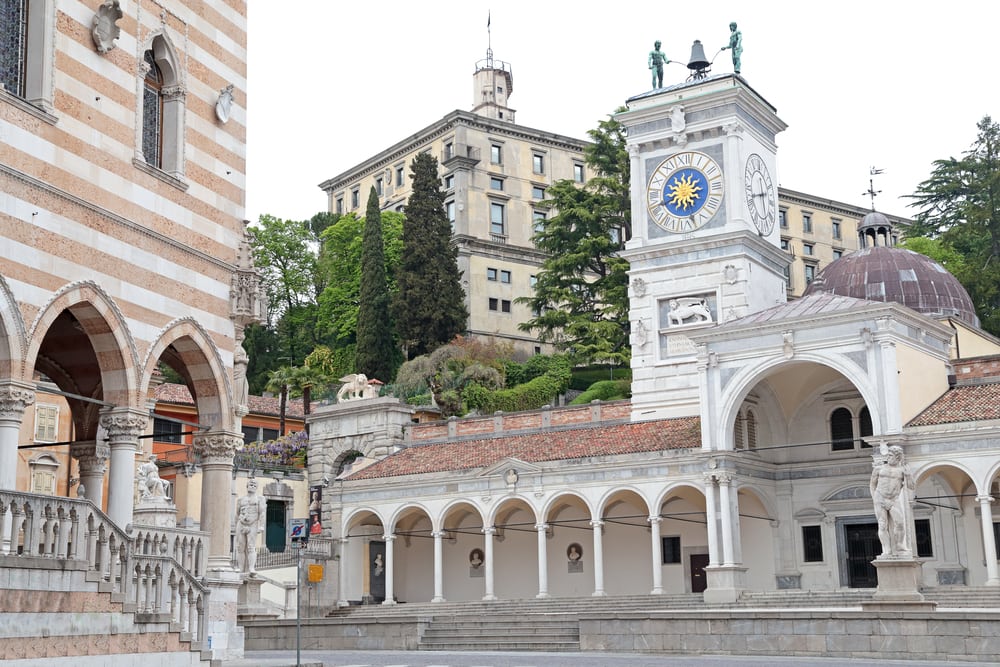
Final thoughts on visiting Trieste
I honestly can’t recommend visiting Trieste enough. The city is vibrant, has its own unique charm, is full of history and beautiful architecture and attractions, and offers more than just monuments. Being in Trieste is simply pleasant and it’s really not hard to enjoy and fall for this place.
While I think Trieste itself is a perfect destination for the city break, I know it’s not exactly on the main tourist routes. But if you are visiting Slovenia or Venice do yourself a favor and include Trieste in your itinerary. I can guarantee you won’t be disappointed!
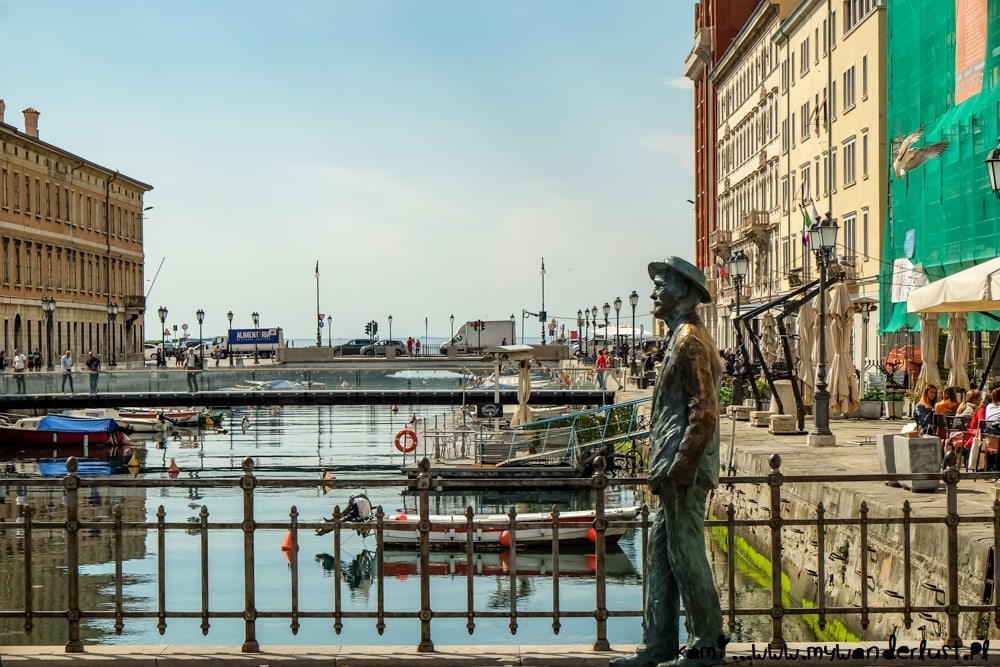
Travel Resources
Below you can find the brands I trust and use when planning trips:
- You can find the best accommodation options at Booking . They have many discounts and excellent customer service. Click here to look for the place to stay in Trieste
- I recommend joining organized tours to get to know the place better and to visit more places during your trip. You can find a great selection of tours at Viator or Get Your Guide .
- To always stay connected I use Airalo eSim cards – click here to get yours!
- For transportation and booking tickets online , I usually use 12Go or Omio
- Looking for the airport pickup ? Check Welcome Pickups!
- Never travel without travel insurance , you never know what might happen and better safe than sorry. You can check the insurance policy for Italy here.
- If you plan to rent a car during your trip to Italy check Discover Cars to compare prices and find the best deals
- Make sure to have the offline map always installed on your phone, they can save you so many troubles. I always use the free app Maps.Me .
For the end I left a few announcements that might interest you:
- Sign up to my newsletter or follow me on Bloglovin to get updates about the new posts
- Join my Facebook group about Eastern Europe, the Balkans and former USSR and connect with fellow travellers and enthusiasts of these regions – just click here!
- I’ve included a few handy links of services and products I personally like and use so you can plan your own trip to Italy too. They are often affiliate links. This means I will get a small commission if you book/purchase anything through my links, at no extra costs for you. Thank you!
LIKED IT? PIN THIS POST FOR LATER!

If you enjoyed that post why don't you share it with your friends? That would mean so much to me! Also be sure to join 30.000+ fellow travelers and follow me on Facebook , Twitter , or Instagram for travel updates and even more pictures! If you don't want to miss new posts sign up to my newsletter or follow on Bloglovin !

Morten Krogh
Can u swim in the harbour/city center?
not really, I haven’t seen any beach in the center
Jacinthe Tremblay
Trieste looks very nice and we’re looking forward to visit it. My friend and I are planning to fly to Trieste from Canada, stay few days and then we need to go to Motovun in Croatia (Montona in Italian). Would you recommend that we travel by train or by bus? Would you recommend places to stay downtown? We would appreciate your recommendations . Thank you!
I think the only way to get to Motovun is by bus, there are direct connections from Trieste to Istria you can take (I used it too, it was a fine trip). In Trieste I stayed in the center in this place Residence Theresia and I can definitely recommend that. Trieste is amazing, I’m sure you will enjoy it! Have a great trip!
Another inspiring post Kami. I am researching this year’s Interrail trip and rail works mean I have to relook at my route. That led me to Trieste and searching for things to see and do. As always, when I saw Kami, I knew I would find what I was looking for. I was thinking two nights, but it looks like there is a lot more to Trieste than I thought and I might stay for three nights. Thanks Kami.
Thank you so much for your kind words! Trieste is amazing, it’s such a pleasant city, I’m sure you will enjoy it!
Leave a Reply Cancel Reply
Sign me up for the newsletter!
Let’s become friends!
Join me on Facebook for even more travel updates!
Kami and the rest of the world
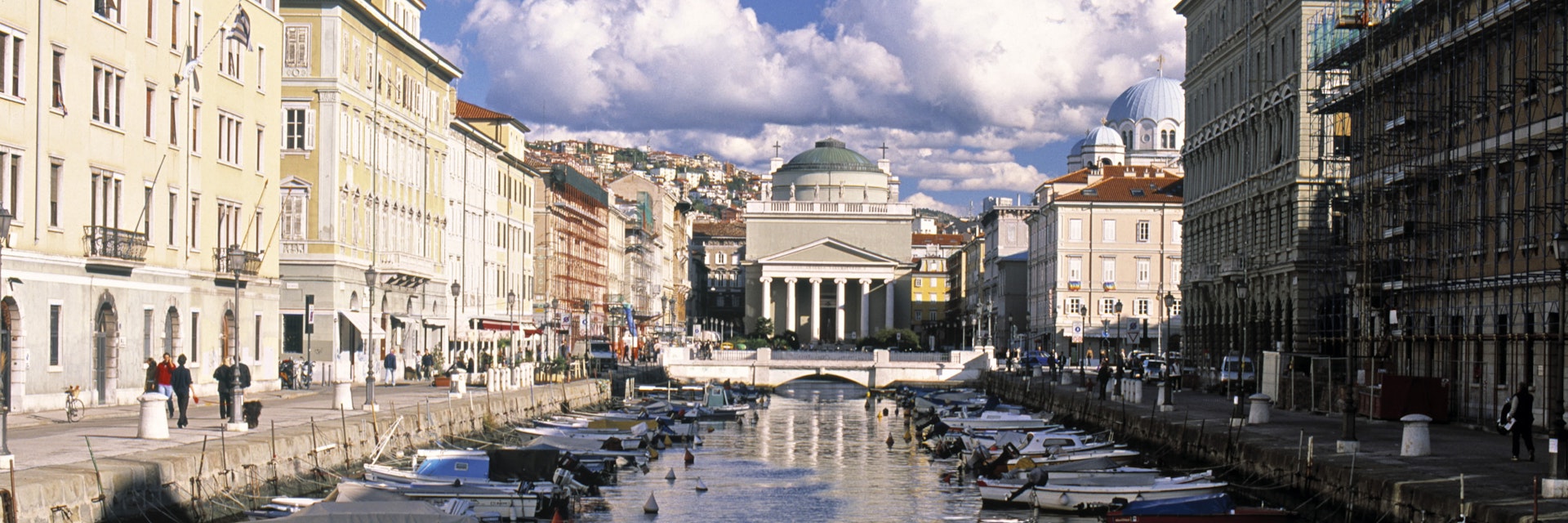
Getty Images/AWL Images RM
Tumbling down to the Adriatic from a wild, karstic plateau and almost entirely surrounded by Slovenia, Trieste is physically and psychologically isolated from the rest of the Italian peninsula. As such, it preserves its own unique border-town culture and retains a fascinating air of fluidity encapsulated in the Triestini dialect, a strange melange of Italian, Austrian-German, Croatian and Greek.
Leave the planning to a local expert
Experience the real Trieste. Let a local expert handle the planning for you.
Attractions
Must-see attractions.
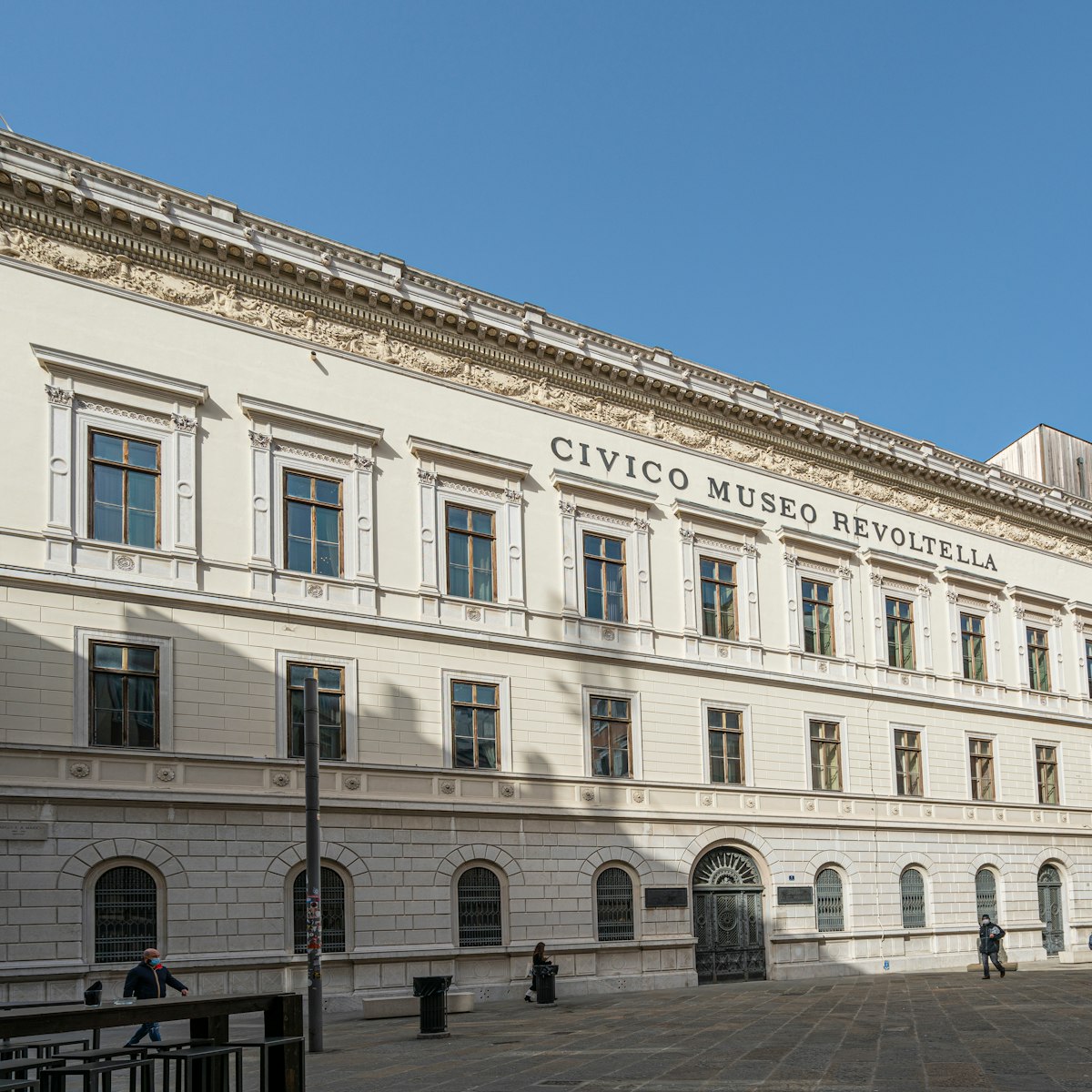
Museo Revoltella
This extraordinary house-museum was the home of wealthy Triestini merchant Pasquale Revoltella, who made his fortune in the timber industry and had a hand…

Chiesa di Santo Spiridione
Constructed from pearly white Istrian stone in 1868, the Serbian Orthodox church has a typical Byzantine style, its large central dome flanked by four…

Faro della Vittoria
Trieste’s elegant lighthouse, with its 68m-high, fluted tower and copper dome sporting a soaring Winged Victory, is perched on the Gretta Hill and worth a…
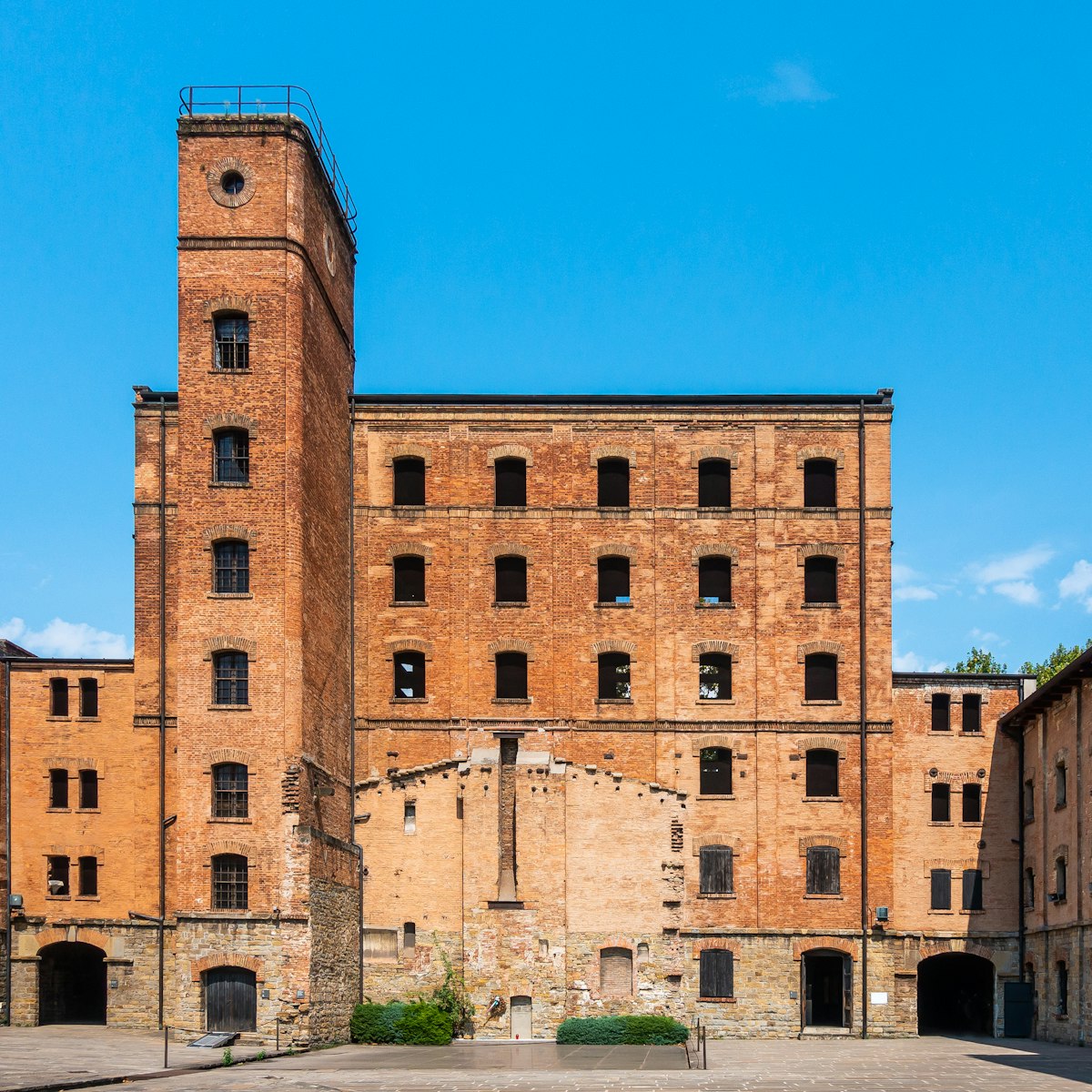
Risiera di San Sabba
This former rice-husking plant became a concentration camp in 1943 and has been a national monument and museum since the 1960s. The site commemorates the…
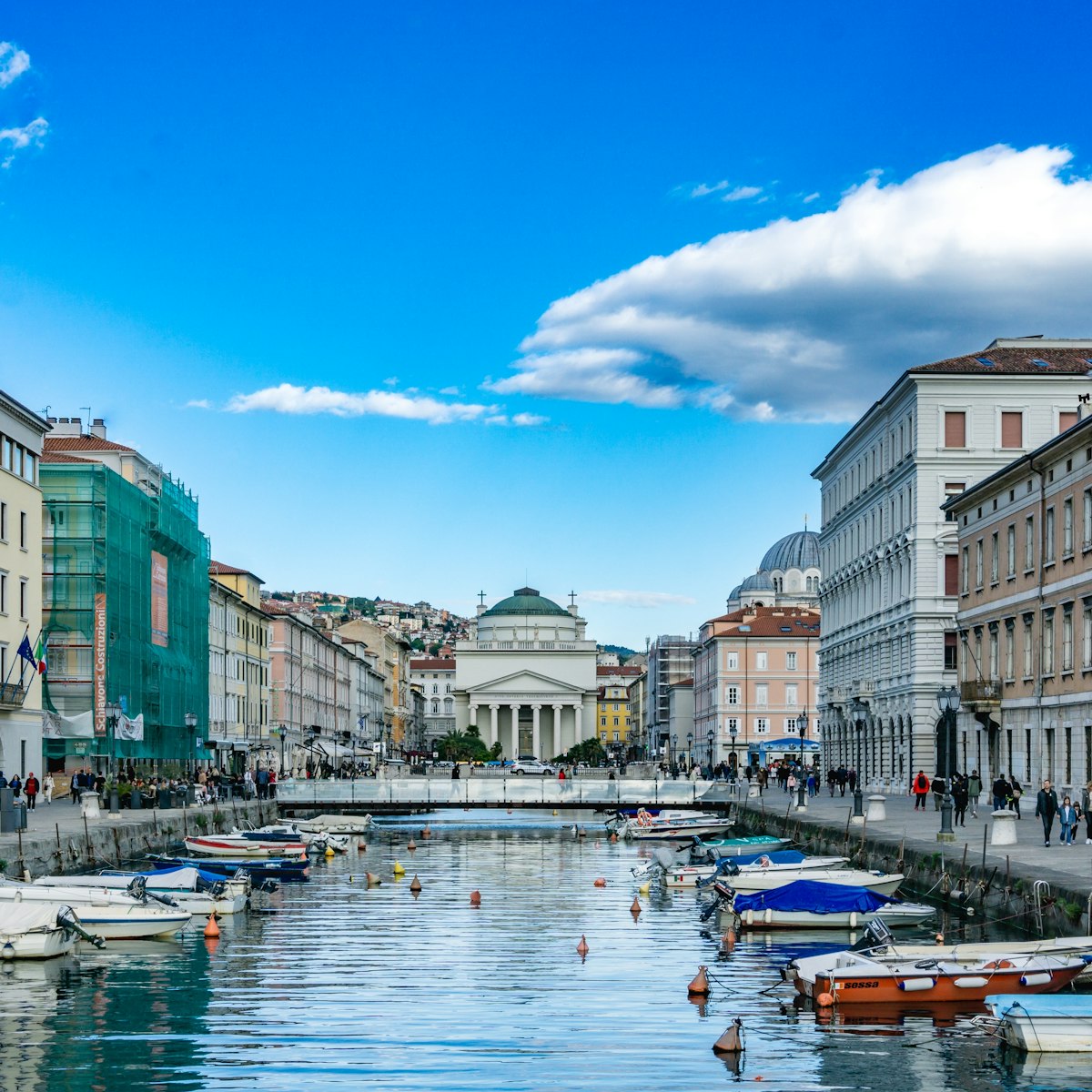
Borgo Teresiano
Much of the graceful city-centre area north of Corso Italia dates to the 18th-century reign of Empress Maria Theresa, including the photogenic Canal…
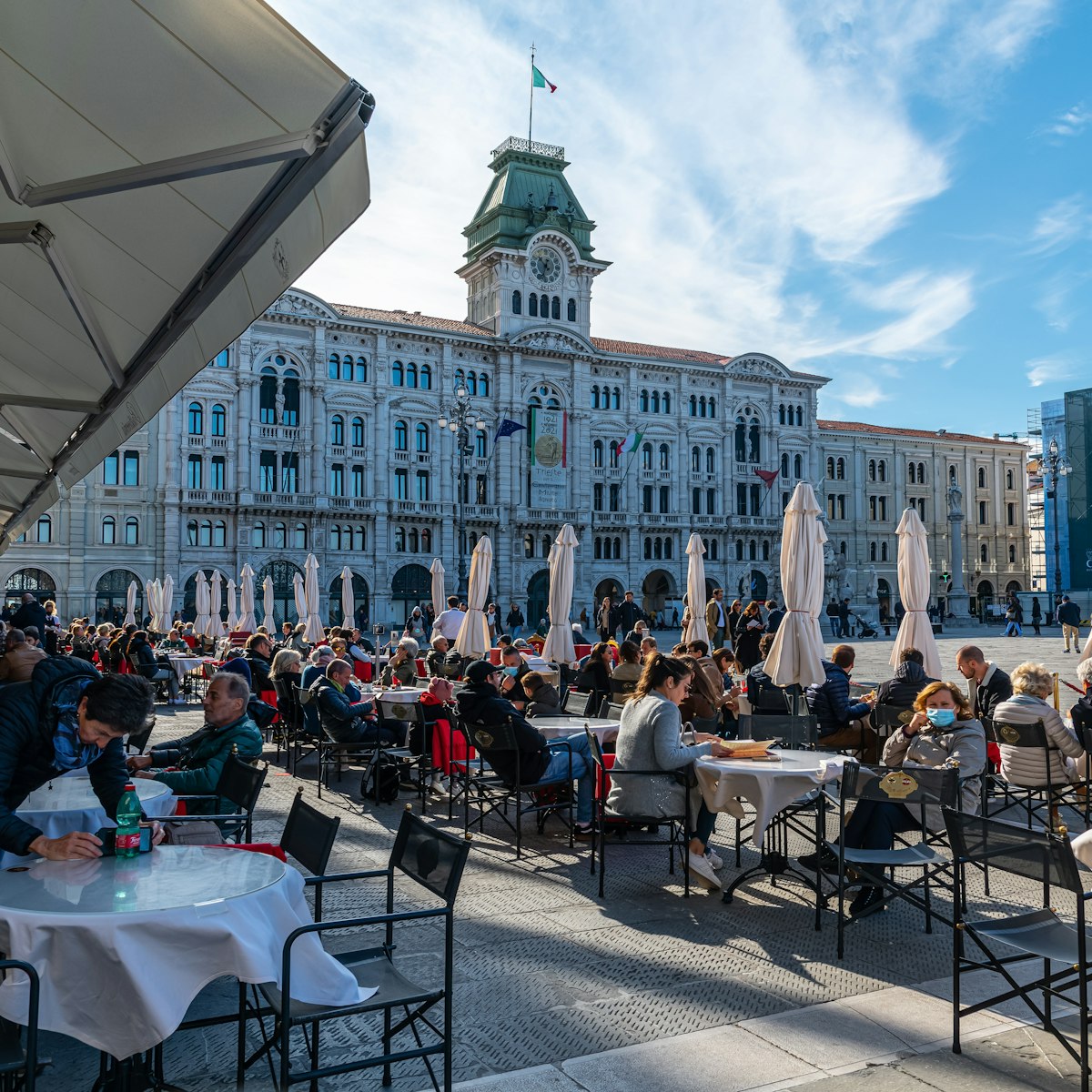
Piazza dell'Unità d'Italia
This vast public space – Italy's largest sea-facing piazza – is an elegant triumph of Austro-Hungarian town planning and contemporary civil pride…
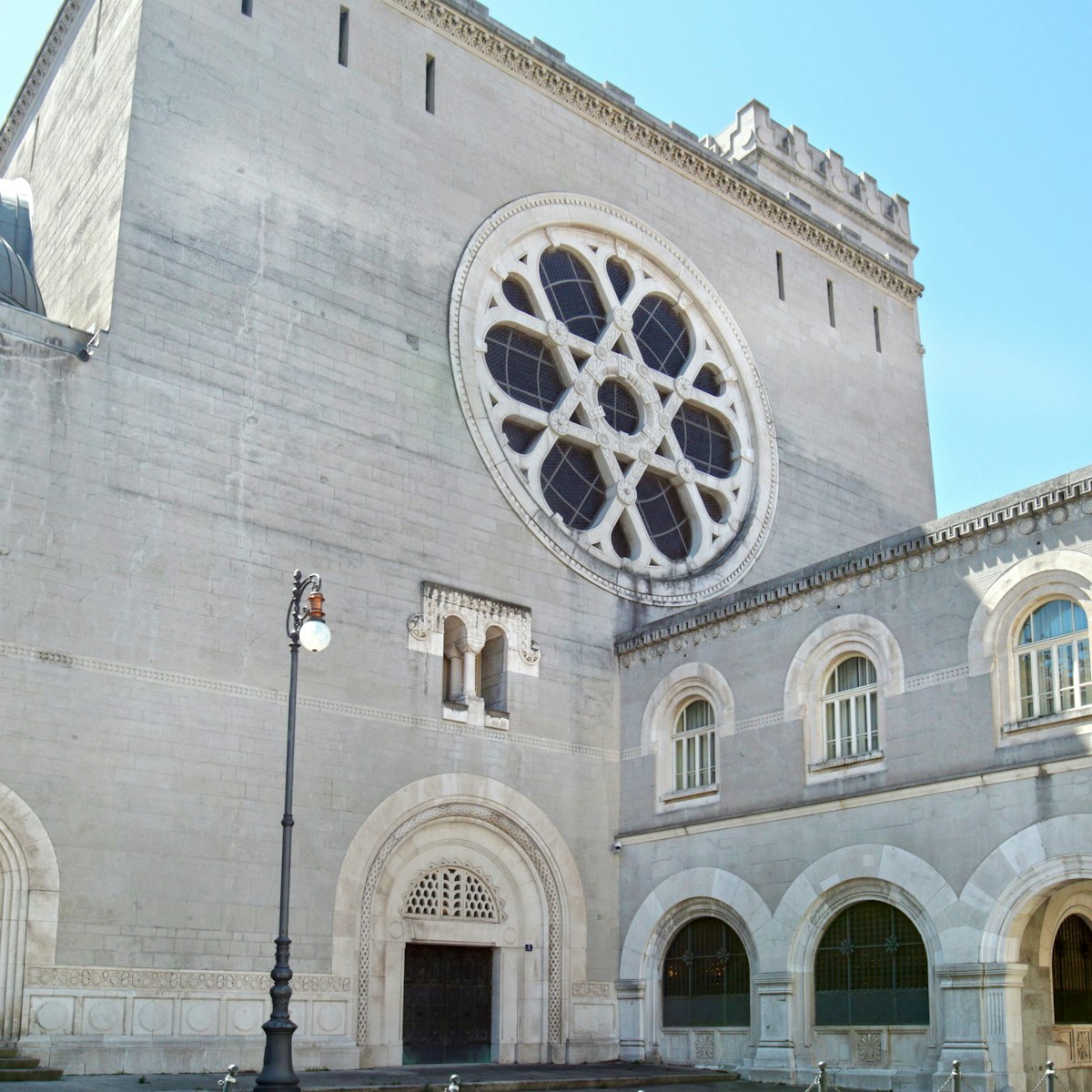
This imposing and richly decorated neoclassical synagogue, built in 1912, is testament to Trieste's once significant Jewish community. Heavily damaged…

Civico Museo Sartorio
This elegant urban villa set in a large garden belonged to the haute bourgeoisie Sartorio family, who amassed a huge collection of art, ceramics and…
Plan with a local
Experience the real Italy
Let a local expert craft your dream trip.

Latest stories from Trieste
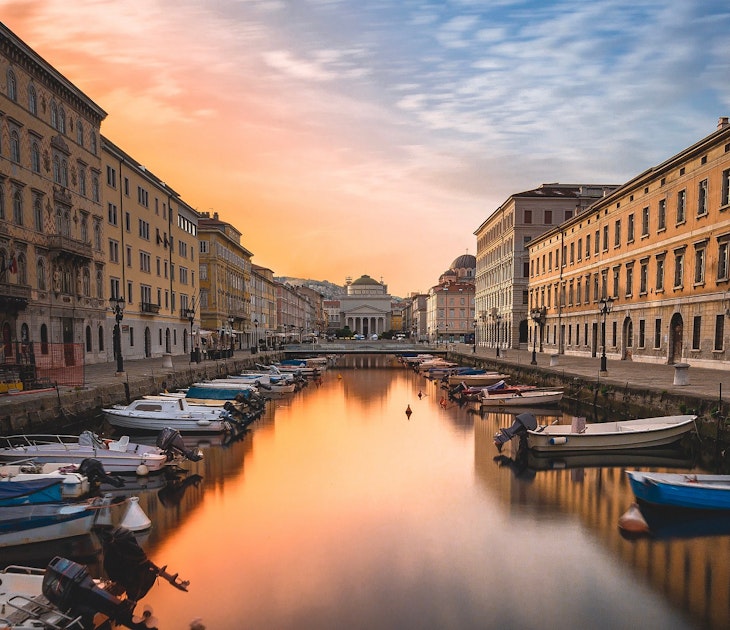
Oct 21, 2019 • 6 min read
Italy's northeastern outpost Trieste is finally on the map, and in 2020 will be Europe’s Capital of Science. Find out why now is the time to visit Trieste.
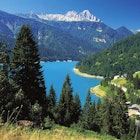
Oct 14, 2015 • 5 min read
in partnership with getyourguide
Book popular activities in Trieste
Purchase our award-winning guidebooks.
Get to the heart of Trieste with one of our in-depth, award-winning guidebooks, covering maps, itineraries, and expert guidance.

35 Best Things to Do in Trieste (Italy) Top Attractions
Last Updated on March 18, 2024 by gregor
Trieste is a city in northeastern Italy and the capital of the autonomous Friuli Venezia Giulia region. The city is located at the head of the Gulf of Trieste and has a population of about 205,000. It is also the capital of the Province of Trieste. The city has a long history dating back to Roman times and has been ruled by several different empires over the centuries. Today, Trieste is a thriving port city with a lively cultural scene. Here are the best places to visit in Trieste one of the most beautiful cities in Italy
BEST THINGS TO DO IN TRIESTE (ITALY)
Wander through the historic center of trieste.
The Historic Center of Trieste is a great place to wander and explore. There are many beautiful buildings, including the Cathedral of San Giusto, which is worth a visit. The center is also home to many restaurants and cafes, so you can stop for a bite to eat or a drink while you explore.
Marvel at the beauty of Miramare Castle
Marvel at the beauty of Miramare Castle , a 19th-century castle located on a cliff overlooking the Adriatic Sea in Trieste, Italy. The castle, which was once the home of Austrian Archduke Ferdinand Maximilian and his wife Charlotte of Belgium, is now a museum. Visitors can explore the castle’s lavish interiors, including the grandiose State Rooms and the Archduke’s study, as well as its gardens and grounds.
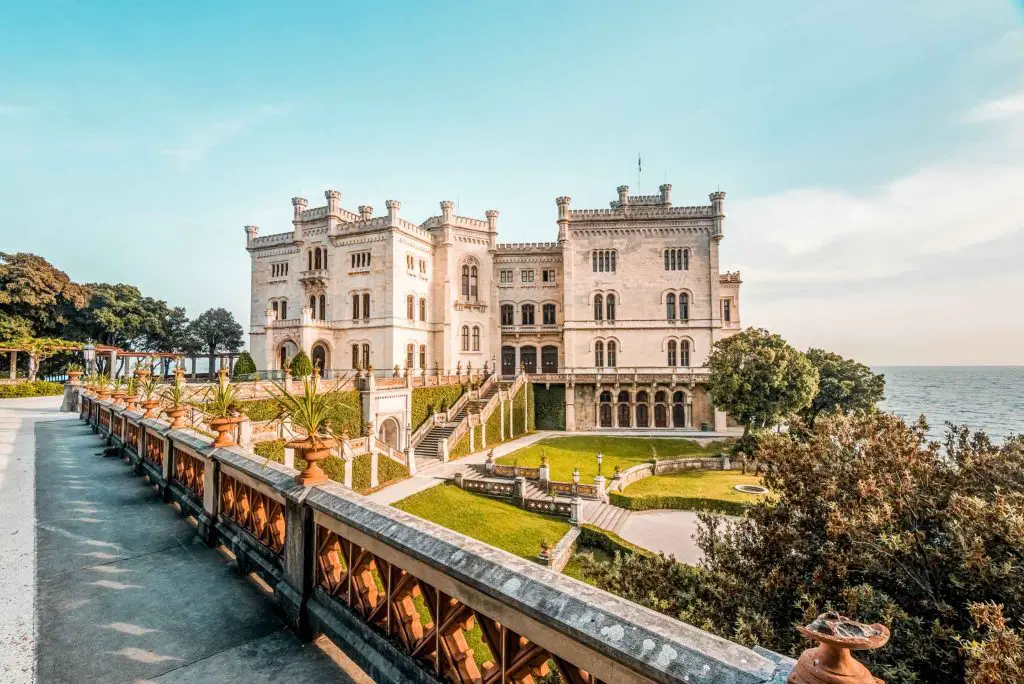
Contact Details: V.le Miramare, 34151 Trieste TS, Italien
+39 040 224143
Tickets: Miramare Castle Skip-the-Line Entrance Ticket
Explore the Piazza dell’Unità d’Italia
The Piazza dell’Unità d’Italia is the main square of Trieste, Italy. It is located in the center of the city, on the edge of the Adriatic Sea. The square is named after the Italian unification, which took place in 1861. The piazza is home to many important political and cultural events. It is also a popular meeting place for locals and tourists alike.
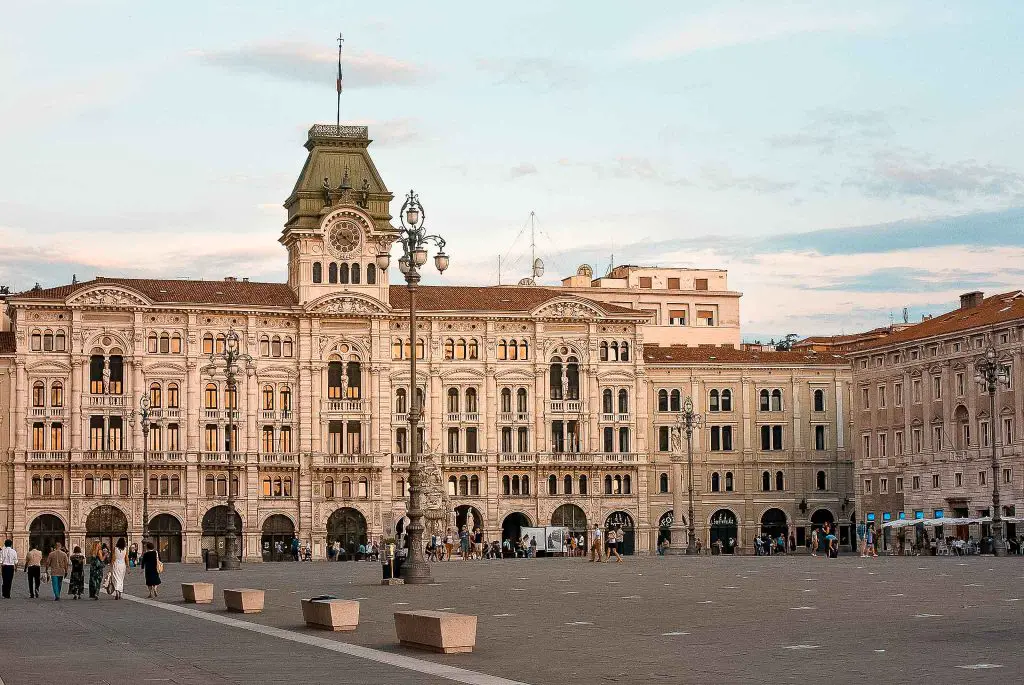
Check out the Revoltella Museum
The Revoltella Museum is a great place to learn about the history of the city of Trieste. The museum has a wide variety of exhibits that cover the city’s history from its founding to the present day. The museum is also home to several important artworks, including works by Canaletto, Tiepolo, and Guardi. The Revoltella Museum is an excellent place to learn about the history and culture of Trieste.
Via Armando Diaz, 27, 34123 Trieste TS, Italien
museorevoltella.it
Visit the Saint Spyridon Church
Saint Spyridon Church is a beautiful place to visit. It is a traditional church with stunning architecture and lovely grounds. The church is located in the heart of the city and is easy to find. It is definitely worth a visit!
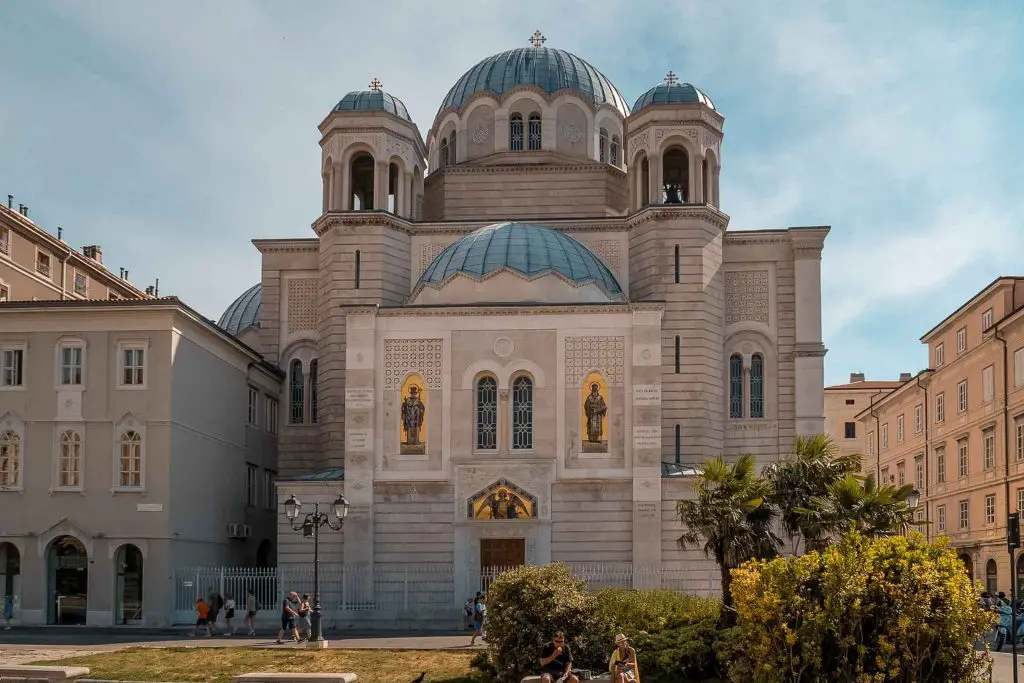
Via Spiridione, 9, 34122 Trieste TS, Italien
www.comunitaserba.org
+39 040 631328
Enjoy the views from San Giusto Castle in Trieste
San Giusto Castle is a beautiful castle located in Trieste, Italy. The views from the castle are amazing and definitely worth a visit. The castle is also home to a museum which is definitely worth checking out.
P.za della Cattedrale, 3, 34131 Trieste TS, Italien
www.castellodisangiustotrieste.it
+39 040 309362
Admire the Trieste Cathedral
The Trieste Cathedral, also known as the Cathedral of San Giusto, is a Roman Catholic cathedral in Trieste, Italy. It is the seat of the Bishop of Trieste and is dedicated to Saint Justus, the patron saint of the city. The cathedral is considered one of the most important examples of Romanesque architecture in northern Italy. It was built between 1202 and 1252, and has been renovated several times since then. The facade is decorated with two rows of arches and a large rose window. The interior is spacious and filled with light, thanks to the many windows. The cathedral houses several important works of art, including a 13th-century painting by Pietro Lombardo.
P.za della Cattedrale, 2, 34121 Trieste TS, Italien
www.sangiustomartire.it
+39 040 260 0892
Feast on some hearty Triestine cuisine
If you’re in the mood for some hearty, filling cuisine, then you’ll want to check out Triestine cuisine . This cuisine is from the Trieste region of Italy, and it’s known for its use of meats, cheeses, and other rich ingredients. Dishes like jota (a stew made with sauerkraut, beans, and pork), gulasch (a beef and paprika stew), and strucolo (a baked pudding made with raisins, nuts, and spices) are all staples of Triestine cuisine. So if you’re looking for something to really stick to your ribs, this is the cuisine for you.
Visit the Risiera di San Sabba in Trieste
The Risiera di San Sabba is a former concentration camp in Trieste, Italy. The camp was operated by the Nazis during World War II and was used to detain and execute political opponents, Jews, and Roma (Gypsies). Today, the Risiera di San Sabba is a memorial site and museum dedicated to the victims of Nazi atrocities. Visitors can tour the grounds, view exhibitions of artifacts and documents, and learn about the history of the camp.
Take photos of the Grand Canal in Trieste
The Grand Canal in Trieste is a beautiful sight. I recommend taking photos of it when you have the chance. The colors are stunning and the architecture is amazing.
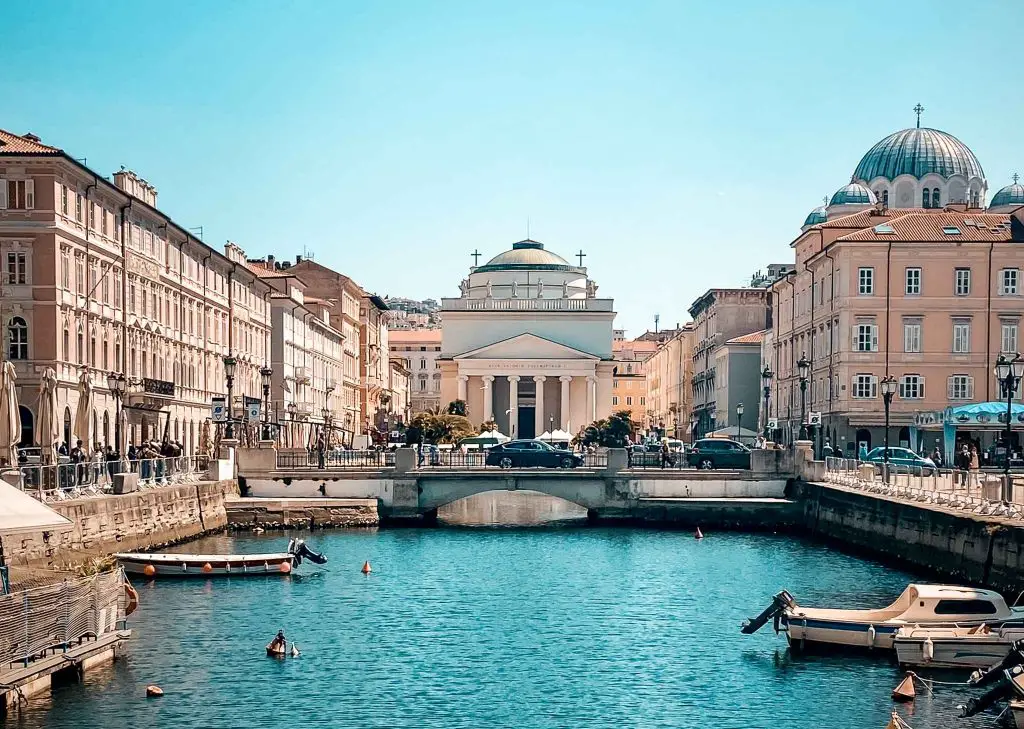
See the Arch of Riccardo in Trieste
The Arch of Riccardo is a triumphal arch in Trieste, Italy. It was erected in 1882 to commemorate the marriage of Emperor Franz Joseph I and Elizabeth of Bavaria. The arch is decorated with reliefs depicting scenes from the couple’s wedding day.
Make your way to the Synagogue of Trieste
The Synagogue of Trieste is located in the city of Trieste, Italy. It is the oldest synagogue in Europe and one of the most important Jewish heritage sites in the world. The synagogue was built in 1788 and is still in use today. It is a beautiful building with unique architecture and is well worth a visit.
Via S. Francesco D’Assisi, 19, 34133 Trieste TS, Italien
www.triestebraica.it
+39 040 371466
Descend to the netherworld at the Grotta Gigante Cave in Trieste
The Grotta Gigante cave in Trieste, Italy is a popular tourist destination for its unique features. The cave is said to be the largest cave of its kind in the world, and its size and depth make it a popular spot for spelunking and rock climbing. The cave is also home to several unusual animals, including bats, snakes, and spiders.
Stand-up Espresso at a Classic Cafe in Trieste
A classic stand-up espresso at a cafe in Trieste is a must-try experience. The coffee here is some of the best in the world , and the cafe itself has a wonderful atmosphere. You can sit and enjoy your coffee while people-watching or chatting with the friendly staff.
Watch the Sun Set Over the Gulf of Trieste on the Adriatic Sea
There’s something about watching the sunset over the water that just makes you feel at peace. And when that body of water is the Gulf of Trieste on the Adriatic Sea, you can’t help but be mesmerized by the beauty. The colors are just incredible as they reflect off the water and into the sky. If you’re ever in the area, make sure to take some time to watch the sunset over this stunning body of water.
Explore Trieste’s Roman Past
Trieste is a city located in northeastern Italy. It is situated near the border with Slovenia and has a long history dating back to Roman times. The city’s Roman past can still be seen in its architecture, with several well-preserved ruins and ancient buildings. Visitors can explore Trieste’s Roman heritage by taking a walking tour of the city, or by visiting the Archaeological Museum which houses a collection of Roman artifacts.
Stop in to the Museo del Castello di San Giusto
The Museo del Castello di San Giusto is a great place to learn about the history of the city of Trieste. The museum is located in the castle, which was built in the 13th century. The museum has exhibits on the history of the castle, as well as the history of Trieste. The museum is open every day from 9:00 am to 5:00 pm.
Cruise Along The Grande Canal in Trieste
The Grand Canal in Trieste offers a unique and wonderful way to see the city. You can cruise along the canal and take in the sights and sounds of the city while enjoying the fresh air. The canal is also a great place to take a walk or ride a bike, and you can even stop and enjoy a meal or a drink at one of the many cafes and restaurants along the way.
Stop at Molo Audace Pier in Trieste
If you’re ever in Trieste, make sure to stop by the Molo Audace Pier. It’s a beautiful spot overlooking the Adriatic Sea, and it’s also where you’ll find the city’s iconic lighthouse. The pier is a great place to relax and take in stunning views, and it’s also a popular spot for fishing. So whether you’re looking to soak up some sun or catch dinner, the Molo Audace Pier is definitely worth a visit.
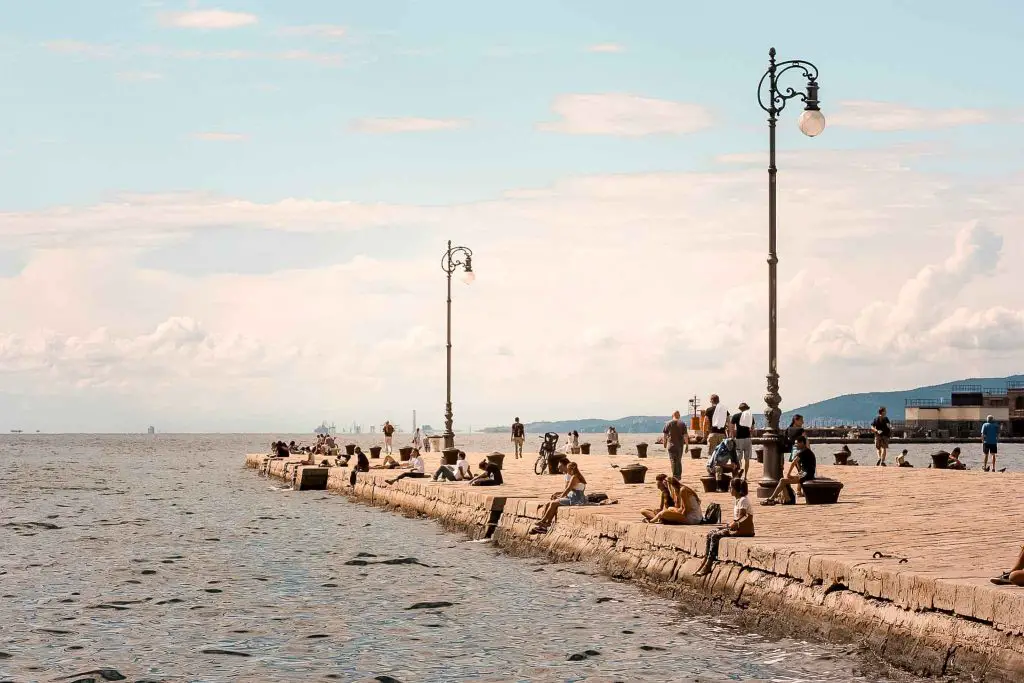
Stop for a drink in a historical cafe in Trieste – caffè san marco
If you want to take a break from exploring Trieste, head to caffè San Marco This cafe has been serving up coffee and pastries since 1913, and it’s definitely worth stopping in for a quick drink. The cafe is located in Piazza Unità d’Italia, the main square in Trieste, so it’s easy to find. And once you’re there, you can enjoy people-watching from one of the outdoor tables.
Day Trip from Trieste to Gorizia
Gorizia is a town in northeastern Italy, just a short drive from the city of Trieste. It’s a popular day trip destination for its historic center and beautiful scenery. The Gorizia Hills offer great views of the surrounding countryside, and there are several wineries in the area that offer tours and tastings. In the town itself, there are many well-preserved medieval buildings, as well as a castle and an aquarium. Gorizia is also known for its excellent food, with many restaurants offering traditional dishes from the region.
Day Trip from Trieste to Predjama Castle and Postojna Cave
A day trip from Trieste to Predjama Castle and Postojna Cave is a great way to see two of Slovenia’s most popular tourist attractions. Predjama Castle is a medieval fortress that sits atop a cliff, and Postojna Cave is one of the largest and most visited caves in Europe.
More Info and Tickets: Visit Postojna Cave, the best-known cave in the world, and Predjama Castle, the only preserved cave castle in Europe .
Day Trip from Trieste to Lake Bled and Ljubljana in Slovenia
If you’re looking for a beautiful day trip from Trieste, Slovenia is the perfect place to go. Lake Bled and Ljubljana are both stunning destinations that are definitely worth a visit. The drive from Trieste to Lake Bled is about two hours, and from there, it’s only another hour to Ljubljana. So pack a picnic lunch and enjoy a day of exploring!
Information & Tickets: Ljubljana and Bled Lake: Full–Day Bus Tour from Trieste
TOP ATTRACTIONS IN TRIESTE
Piazza unità d’italia in trieste.
The Piazza dell’Unità d’Italia is located in the heart of Trieste and is the largest square in the city. It was designed by Austrian architect Karl von Hasenauer and built between 1883 and 1886. The square is surrounded by neo-renaissance palaces and has a central fountain with a statue of King Victor Emmanuel II, the first king of Italy. The piazza is a popular meeting place for locals and visitors alike and offers a stunning view of the Adriatic Sea.
Piazza Unità d’Italia, 34121 Trieste TS, Italien
Castello di Miramare
Castello di Miramare is a castle located in Trieste, Italy. Construction of the castle began in 1856 and was completed in 1860. It was built for Austrian Archduke Ferdinand Maximilian and his wife, Charlotte of Belgium. The castle is surrounded by a 22-hectare park and features a wide range of flora and fauna. Visitors to the castle can explore the grounds, and the castle itself, and also take a boat ride out to the nearby islands.
V.le Miramare, 34151 Trieste TS, Italien
Castello di San Giusto
Castello di San Giusto is a large castle located in the city of Trieste, Italy. The castle was built in the 14th century and has been used as a military fortification, a royal residence, and a prison. Today, the castle is open to the public and houses a museum, art gallery, and restaurant.
Museum Riseria di San Sabba
Museum Riseria di San Sabba is a museum in Trieste, Italy. The museum houses a collection of equipment and tools used in the rice-growing industry. The museum is located in the former rice mill of San Sabba, which was built in the early 20th century.
Via Giovanni Palatucci, 5, 34148 Trieste TS, Italien
www.risierasansabba.it
+39 040 826202
Molo Audace and Harbor in Trieste
Molo Audace and Harbor in Trieste are two of the most popular destinations in the city. Molo Audace is a beautiful harbor with many restaurants and cafes, while Harbor in Trieste is a more traditional harbor with a wide variety of shops and businesses.
Cattedrale di San Giusto in Trieste
The Cathedral of San Giusto in Trieste is a beautiful and historic cathedral located in the city of Trieste, Italy. The cathedral dates back to the 11th century and is one of the most important religious buildings in the city. The exterior of the cathedral is decorated with intricate sculptures and stone carvings, and the interior is just as beautiful, with a stunning main altar and stained glass windows. The Cathedral of San Giusto is a must-see for anyone visiting Trieste.
Canale Grande and San Spiridione in Trieste
Canale Grande and San Spiridione are two of Trieste’s most popular tourist attractions. Canale Grande is a large canal that runs through the city, and San Spiridione is a beautiful church located on a hilltop. Both attractions are located in the heart of Trieste and are easily accessible by foot or public transportation.
Teatro Romano (Roman Theater) in Trieste
The Teatro Romano in Trieste is a Roman theater that was built during the 1st century AD. The theater was used for plays, musical performances, and other public events. The theater was rediscovered in the 18th century and has been restored several times. Today, the theater is used for cultural events and is one of the most popular tourist attractions in Trieste.
Via del Teatro Romano, 34121 Trieste TS, Italien
www.turismofvg.it
+39 040 347 8312
Faro della Vittoria in Trieste
The Faro della Vittoria is a lighthouse located in Trieste, Italy. It was built in 1856 and is one of the oldest lighthouses in the country. The lighthouse is 36 meters tall and has a range of 22 nautical miles. It is a popular tourist destination and offers stunning views of the city and surrounding area.
Str. del Friuli, 141, 34136 Trieste TS, Italien
www.farodellavittoria.it
+39 040 377 4783
Museo Civico di Storia Naturale (Museum of Natural History) in Trieste
The Museum of Natural History in Trieste is a great place to learn about the natural history of the area. The museum has a wide variety of exhibits, including a hands-on section where you can touch and feel different animals. The staff is very knowledgeable and can answer any questions you have. The Museum of Natural History is a great place to visit if you’re interested in learning more about the natural world.
Via Matteo Renato Imbriani, 5, 34122 Trieste TS, Italien
www.museostoriapatria.it
+39 040 675 4039
Joyce Museum
The Joyce Museum is dedicated to the almost eleven years that the Irish writer James Joyce spent in Trieste.
Here you will find comprehensive documentation about his life, his relationships with the city’s bourgeoisie, the numerous apartments in which he lived, the places he frequented (churches and inns, editorial offices, villas, and brothels), his family, and, above all, the Works he wrote in Trieste
Museum Joyce Museum
Via della Madonna del Mare, 13, 34124 Trieste TS, Italien
www.museojoycetrieste.it
+39 040 675 8170
[email protected]
admission free
FREQUENTLY ASKED QUESTIONS
Is trieste worth visiting.
Trieste is definitely worth visiting! This charming city has a lot to offer, from its beautiful architecture and stunning scenery to its delicious food and friendly people. Trieste is the perfect place to relax and enjoy a slower pace of life, while still being able to experience all that Italy has to offer. I would highly recommend spending a few days in Trieste, you won’t regret it!
How many days for visiting Trieste
If you’re planning a trip to Trieste, you’ll need to allow at least three days to see all the sights. Trieste is a beautiful city with plenty of history and culture to explore. You could easily spend a day wandering the streets, taking in the architecture, and stopping in at the many cafes and shops. There are also a number of museums and galleries worth visiting, as well as the Roman ruins of Basilica Giulia. And of course, no trip to Trieste would be complete without spending some time at the beach!
The best time to visit Trieste
There is no definitive answer to this question, as Trieste is a beautiful city that can be enjoyed at any time of year. Trieste has a Mediterranean climate, with warm summers and cool winters. The average annual temperature is 18.6 °C (65.5 °F). Many visitors find that the best time to visit Trieste is in the spring or autumn when the Trieste weather is milder and the city is less crowded than in the peak summer months.
Where to stay in Trieste
When deciding where to stay in Trieste, there are a few things to keep in mind. The first is that the city is quite small, so finding a hotel near the center of town is a good idea. The second is that Trieste is located on the Adriatic Sea, so staying near the water is also a great option. There are many hotels and Airbnbs to choose from in Trieste, so finding the perfect place to stay should not be difficult.
How to get around Trieste
Getting around in Trieste is easy, as most of the sights are within walking distance of each other. If you want to explore further afield, there are public buses that run regularly. You can also take a boat ride around the bay, which is a great way to see the city from a different perspective.
Is Trieste expensive?
The cost of living in Trieste is relatively high, compared to other Italian cities. Prices for basic necessities, such as food and accommodation, are higher than average. However, there are many affordable options available, depending on your budget.
Is Trieste Safe to Travel?
Trieste is safe to travel to, although there are some areas that are more dangerous than others. The city center is generally safe, but there are some areas outside of the city center that can be dangerous. It is always best to check with your hotel or hostel before venturing out into unfamiliar areas.
Where To Eat In Trieste?
If you’re looking for a good place to eat in Trieste, you won’t have to look far. There are plenty of great restaurants to choose from, whether you’re looking for traditional Italian cuisine or something else. Here are a few of our favorites:
Harry’s Piccolo in Hotel Duchi d’Aosta
T +39 (040) 660606
E [email protected]
W www.harrystrieste.it
Il Piccolo Ristorante: This cozy little restaurant is one of the best places in Trieste for traditional Italian food. The pasta is homemade and the dishes are all prepared with fresh, local ingredients.
Osteria al Ponte: This osteria, or tavern, is located right on the edge of the canals in Trieste and offers a great selection of seafood dishes. The setting is casual and the prices are very reasonable.
What to eat in Trieste?
In Trieste, there are many different types of food to try. For breakfast, you can have a cappuccino and a pastry from one of the many bakeries. For lunch or dinner, you can enjoy fresh seafood, pasta dishes, and regional specialties like jota soup. Be sure to try the local wines, which are some of the best in Italy.
The Best Things to Do in Trieste in One Day
There are a few things you can do to make the most of your time in Trieste in one day. Start by visiting the Miramare Castle, which is a beautiful 19th-century castle that overlooks the Adriatic Sea. Then, head to the Piazza Unità d’Italia, which is the largest square in Europe and home to many important political and historical buildings. After that, take a stroll through the old town to see some of the city’s most beautiful architecture, and finally, enjoy a delicious meal at one of Trieste’s many restaurants.
How to Spend 1 Day in Trieste
If you’re looking to spend a day exploring the charming city of Trieste, here are some suggestions on how to make the most of your time. Start your day by grabbing a quick breakfast at one of the many cafes lining the streets. Then, head to Miramare Castle for a dose of history and breathtaking views. Afterward, stroll through the Old Town and stop for lunch at a traditional trattoria. In the afternoon, visit the Revoltella Museum or take a walk along the city’s waterfront. End your day with dinner and drinks at one of Trieste’s lively restaurants or bars.
ONE DAY IN TRIESTE ITINERARY: HOW TO SPEND THE PERFECT 24 HOURS IN TRIESTE
How to Spend 2 Days in Trieste
There are many things to see and do in Trieste, making it a great place to visit for a few days. Some of the city’s most popular attractions include the Piazza dell’Unita d’Italia, the Miramare Castle, and the Cathedral of San Giusto. Visitors can also enjoy Trieste’s many museums, art galleries, and parks.
If you’re looking to spend a couple of days in Trieste, there are plenty of options for accommodation, dining, and entertainment. With so much to see and do, you’re sure to have an enjoyable and memorable stay in this historic Italian city.
How to Spend 3 Days in Trieste
There are many things to do in Trieste in 3 days.
On the first day, visitors can explore the city’s historical center and visit some of its most popular landmarks, such as the Piazza Unità d’Italia, the Castello di Miramare, and the Cathedral of San Giusto.
On the second day, visitors can take a day trip to nearby destinations, such as the UNESCO World Heritage Site of Aquileia or the charming medieval town of Cividale del Friuli.
On the third day, visitors can enjoy Trieste’s unique atmosphere by strolling through its neighborhoods, such as the Borgo Teresiano and Barcola, and indulging in some of its delicious food and drink.
Best Day trip destinations from Trieste
There are many great day trip destinations from Trieste. A few of our favorites include:
– The historic city of Aquileia , with its ancient ruins and beautiful mosaics
– The charming hill town of Collio , perfect for a leisurely stroll and some wine-tasting
– The picturesque seaside town of Grado , with its lovely beaches and views
No matter what your interests are, you’re sure to find a great day trip destination from Trieste!
What are the best day trips and excursions from Trieste?
There are many great day trips and excursions from Trieste. Some of the best include visiting the nearby towns of Piran and Portoroz , taking a boat ride to the beautiful island of Mljet, or going on a wine tour in the Collio region. There are also several interesting historical sites to visit, such as the Roman ruins at Aquileia or the castle at Miramare. Whatever you choose to do, you’re sure to have a great time exploring this fascinating corner of Italy.
Our most recommended things to do in Trieste
There are so many things to do in Trieste that it can be hard to narrow it down, but here are some of our top recommendations. For history buffs, a visit to the Miramare Castle is a must – this 19th-century castle sits on a cliff overlooking the sea and is full of beautiful art and furnishings. Another great option for those interested in history is the Roman ruins at Basilica Giulia – these well-preserved ruins date back to the 1st century AD and are a fascinating glimpse into the past.
For those who love the outdoors, a hike up to Monte Cavallo is a great way to get some fresh air and stunning views. And of course, no trip to Trieste would be complete without sampling some of the delicious food – from fresh seafood dishes to traditional Italian fare, there’s something for everyone to enjoy.
10 Things to Do for the Best Day in Trieste
1. Visit the Miramare Castle
2. Stroll through the lovely gardens
3. Admire the views from the castle
4. Visit the Maritime Museum
5. Learn about Trieste’s history at the Museum of the Risorgimento
6. Take a cable car up to Monte San Michele for panoramic views
7. Enjoy the views from Piazza Unità d’Italia
8. Shop for souvenirs in the Old Town
9. Sip coffee or enjoy a meal in one of Trieste’s many cafes and restaurants
10. Join in the fun at one of Trieste’s many festivals
Final thoughts on visiting Trieste
We absolutely enjoyed the time in Trieste and would definitely recommend it as a place to visit. The city has a lot to offer in terms of history, culture, and food. We were also impressed by the hospitality of the locals. Overall, we had a great experience and would love to come back.
Google Maps – Trieste Things To Do – Top Attractions
I have embedded below the Top Things do do in Trieste you can follow for your Triese Itinerary. Trieste is large, but all its main attractions are located near the Piazza dell’Unità d’Italia which is the main square of Trieste, Italy. On this Map, let’s start at the city center and proceed to all the main attractions!
I added all the best sights of Trieste as well as restaurants and hotels to check out.
3 Days in Prague: The Perfect Itinerary for First-Timers
Imlauer hotel schloss pichlarn – a top luxury hotel in styria, austria.


Friuli Venezia Giulia
A unique atmosphere can be felt in trieste, as a border town, a melting pot of at least three cultures: latin, slavic and german.
It has a retro flavour of its own, between historic literary cafés and monuments from the past as an important city of the Habsburg Empire. Trieste is the ideal destination for those who love locations rich in a complex and troubled history that has bewitched, harboured, and nurtured writers and other intellectuals. The environment is diverse, with an international outlook. A place to be experienced at least once in a lifetime.
What to see in Trieste and surroundings
- City and surrounding
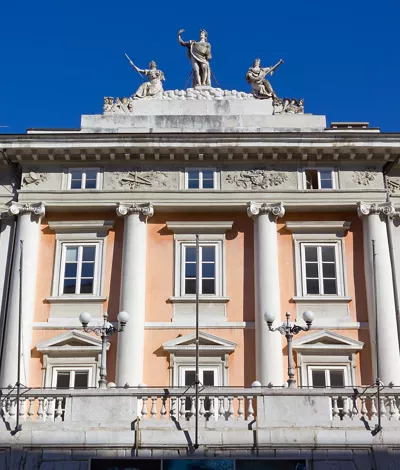
Teatro Lirico Giuseppe Verdi
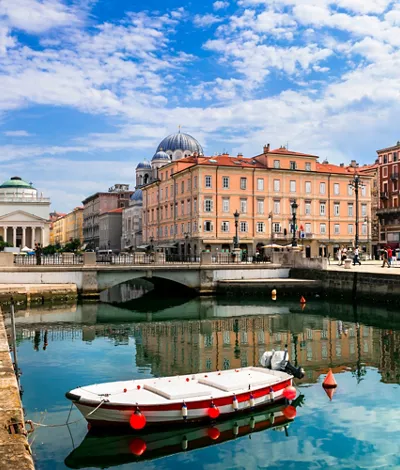
Trieste as you've never seen it: an itinerary to discover street art
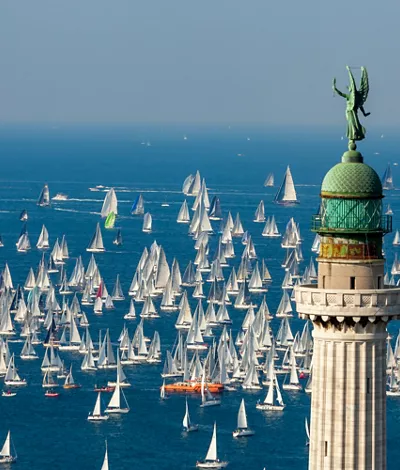
Experience the Barcolana in Trieste with children: all the extraordinary experiences
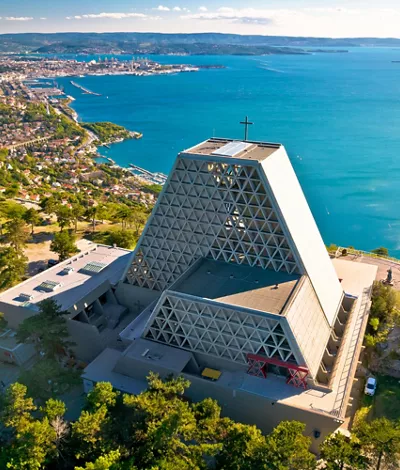
Il Santuario del Monte Grisa a Trieste, simbolo di pace e amicizia fra Occidente e Oriente
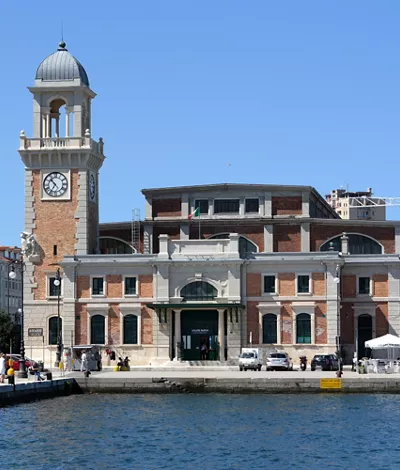
Observing Adriatic fauna and local amphibian species at The Civic Marine Aquarium of Trieste
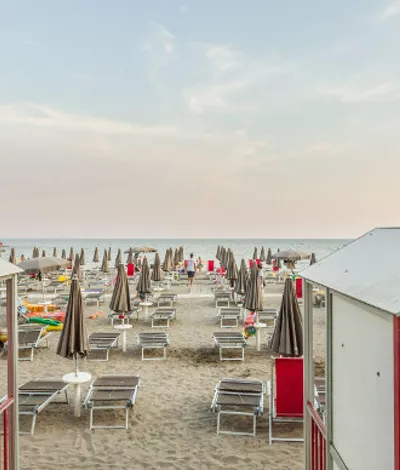
Grado beach: sea, sun and an imperial climate

Trieste Spring Run 2024

Amber Wine Festival
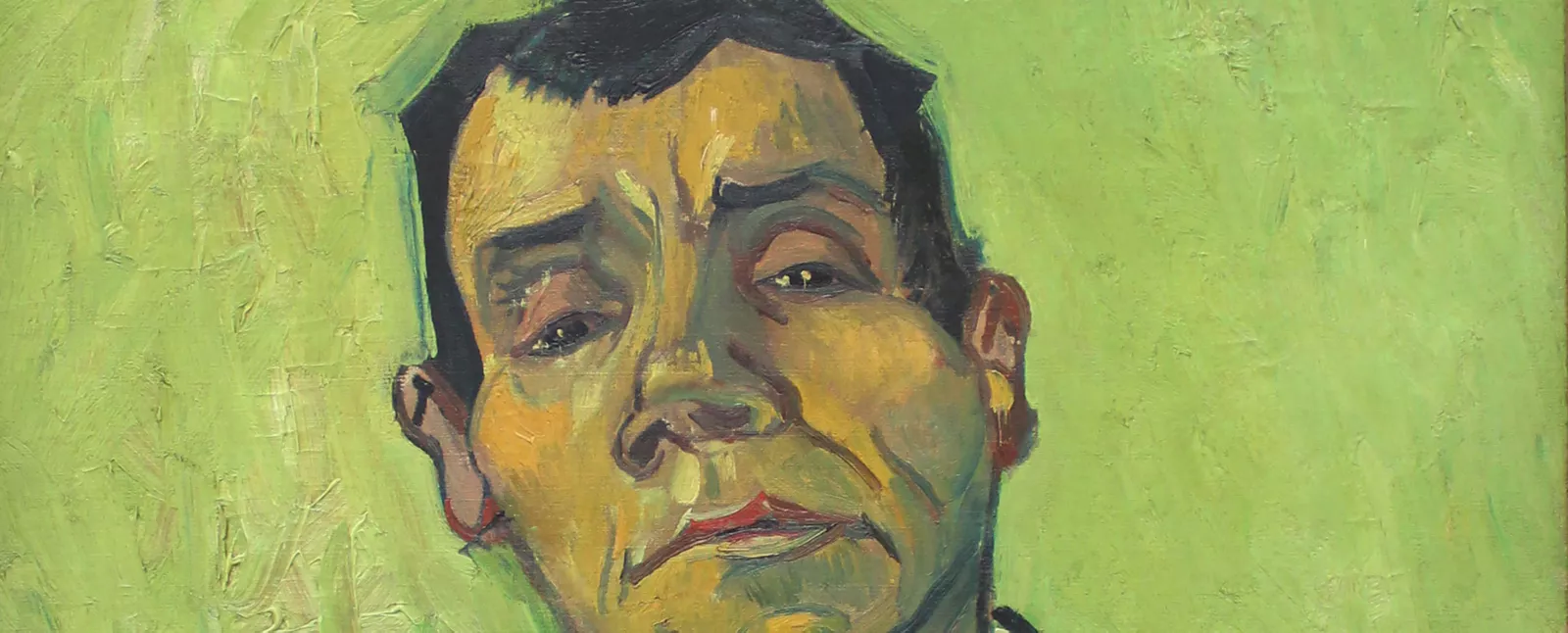
Van Gogh in Trieste

Discovering Trieste, a border city with an international soul
Trieste is truly on the fringes of many things: three different cultural settings, a meeting of the East and West, the sea and the inland area with a thousand histories, encounters, and conflicts. A true gateway, a city of transition, far away from the big crowds. Its many events which took place within its borders and its alternating fortunes as a key strategic point have profoundly influenced it. Italo Svevo was born here, and the name already says a lot about the mixture of styles.
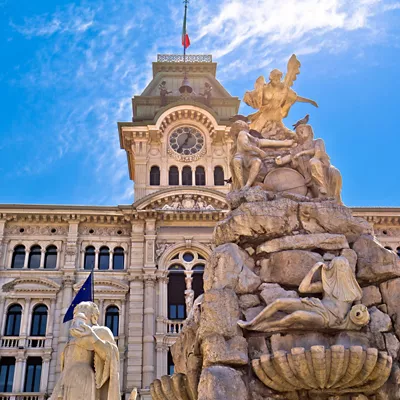
A unique atmosphere can be felt in Trieste, as a border town, a melting pot of at least three cultures: Latin, Slavic and German. It has a retro flavour of its own, between historic literary cafés and monuments from the past as an important city of the Habsburg Empire. Trieste is the ideal destination for those who love locations rich in a complex and troubled history that has bewitched, harboured, and nurtured writers and other intellectuals. The environment is diverse, with an international outlook. A place to be experienced at least once in a lifetime.
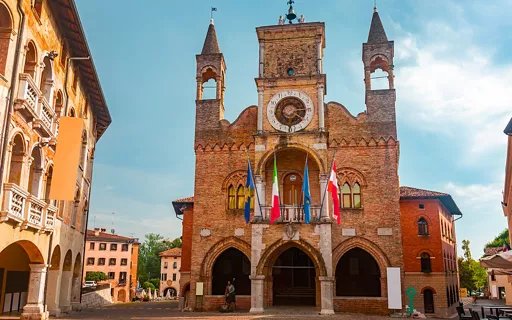
Elegant villages and natural beauty An elegant city in Friuli Venezia Giulia, Pordenone encompasses a quiet historic centre rich in historical and artistic beauty. Stroll down Corso Vittorio Emanuele in the shadow of the arcades, among the longest in Europe. Stop for a coffee in Piazza Cavour, the heart of city life, and admire the facades of the Palazzo Comunale and St Mark's Cathedral. It is impossible not to notice its Gothic-style bell tower, a full 72 metres high. On the outskirts of Pordenone, visit some of the most beautiful villages in northern Italy, such as Sacile, on the Livenza river, and Polcenigo, surrounded by greenery. In San Vito al Tagliamento you can admire what remains of the medieval village, such as the moat and the frescoed castle. For a relaxing moment away from the city, head for Lake Barcis. This corner of paradise, set in the Friulian Dolomites Natural Park, is the perfect place for those who enjoy sports such as sailing, surfing and canoeing, as well as hiking and mountain biking. And lastly, to enjoy typical Friulian cuisine, try the Frico with polenta and salami with vinegar: truly traditional flavours.
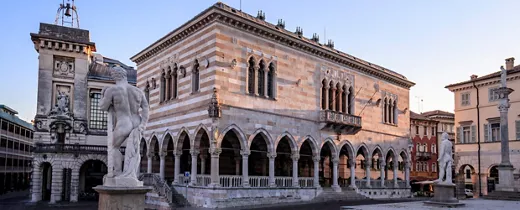
From the Alps to the sea, exploring mosaics and Baroque villas Views of the Carnic Alps, villages on gentle slopes, historic villas, lakes and forests, Roman and Lombard ruins and the golden beaches of Lignano Sabbiadoro: all this and more lies in the province of Udine, in the heart of Friuli-Venezia Giulia. Walking through the historic centre of the capital, which branches out around the castle, you will find the Loggia del Lionello, the Clock Tower, the works of Tiepolo and the Tina Modotti Gallery, dedicated to the great photographer who was born here. Immersed in a large park is the Baroque-style Villa Manin, the residence of the last doge of Venice. You can admire nature is at its best in the thousand-year-old Tarvisio forest, in Val d’Arzino and by Lake Cornino. Don’t miss the villages of Spilimbergo, with its splendid 15th-century Palazzo Dipinto, San Daniele del Friuli, to taste its famous prosciutto, the star fort of Palmanova, and Cividale del Friuli, with its Lombard ruins and the famous Devil’s Bridge. If you love fortresses, we recommend visiting Villalta Castle. To dive into history, head for Aquileia, a very well-preserved Roman city. You’re sure to love the archaeological museum, the Roman Forum, and the Basilica of Santa Maria Assunta, with its mosaic floor and the Crypt of Frescoes.
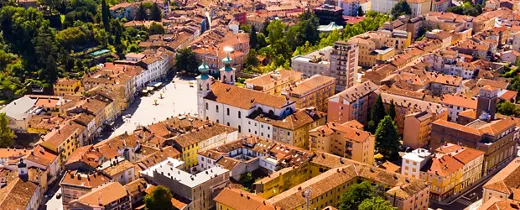
The “city in the trenches” on the border between the Latin and Slavic worlds A melting pot of Romance, Slavic and Germanic cultures on the border with Slovenia, Gorizia has several historical sites. We recommend visiting the Castle, an 11th-century fortification subsequently extended in the 17th century, and the Palazzo Coronini Cronberg in the town centre, in the old village of Grafenberg. Surrounded by a picturesque, romantic park, the building has 15 furnished rooms. To understand the spirit of this “city in the trenches”, visit the Museum of the Great War of Gorizia, in the evocative basements of the 16th-century Dornberg and Tasso Houses. It offers an invaluable testimony to the war events of 1917, covering the defeat at Caporetto, the victory on the Piave and finally the Italian-Austrian armistice of 1918. Three kilometres from the city is the Luciano Viatori botanical garden, also called the Azalea Garden, as 500 varieties of azaleas flourish there, alongside rhododendrons, rare roses, camellias and magnolias. The garden is easy to explore thanks to a well-designed system of paths and wooden walkways, for an enchanting hour-long walk. The ideal time to visit is in spring, between March and June, when the flowers bloom.

Continue living like an Italian
Subscribe to the Newsletter so as not to miss places, events and experiences for experiencing the best side of Italy: the authentic one.
Keep up to date
Would you like to learn about the most authentic experiences to be had in Italy, stay up to date on the most interesting events, discover our special offers and receive lots of insider hints and tips?
Save your favorite places
Create an account or log in to save your wishlist
Do you already have an account? Sign in

Touropia Travel Experts
Discover the World
18 Best Things to do in Trieste, Italy

Fittingly known as ‘Little Vienna by the Sea’, Trieste has a very distinct history, culture and cuisine for you to uncover. Thanks to its location, the important port is very cosmopolitan with Italian, Slovenian and Austro-Hungarian influences. This makes it fascinating to explore as its architecture and ambience are quite unlike the rest of Italy.
Occupying a narrow strip of land between the Alps, Slovenia and the Adriatic, it was actually part of Austria from 1382 until 1919. This explains all its Hapsburg-era buildings and charming historic cafes that are more Viennese in look and feel. While many of its monuments and facades date to this time, millennia-old Roman ruins can be found here and there.
Now the capital of the Friuli Venezia Giulia region in Italy, the city’s sparkling seafront is bordered by elegant buildings, squares and the Canale Grande. With incredible castles, churches and art collections to explore, there are plenty of things to do in Trieste to keep your busy for a while.
Map of Trieste
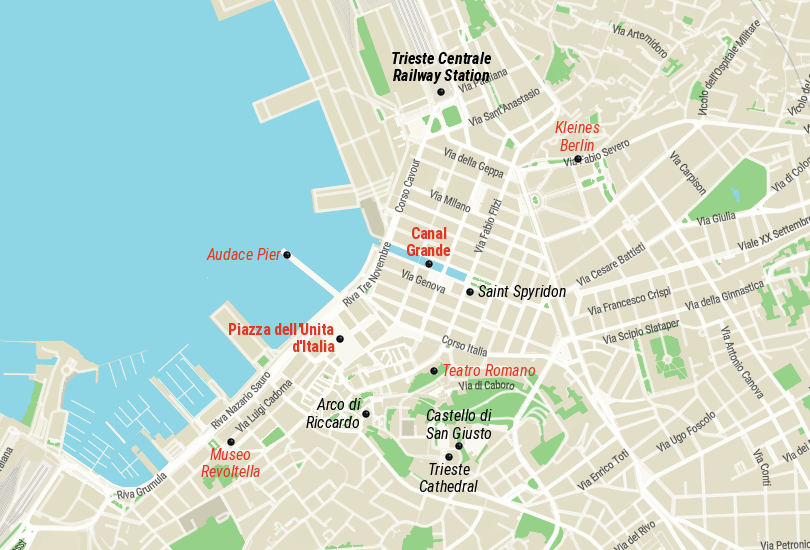
18. Saint Spyridon Church
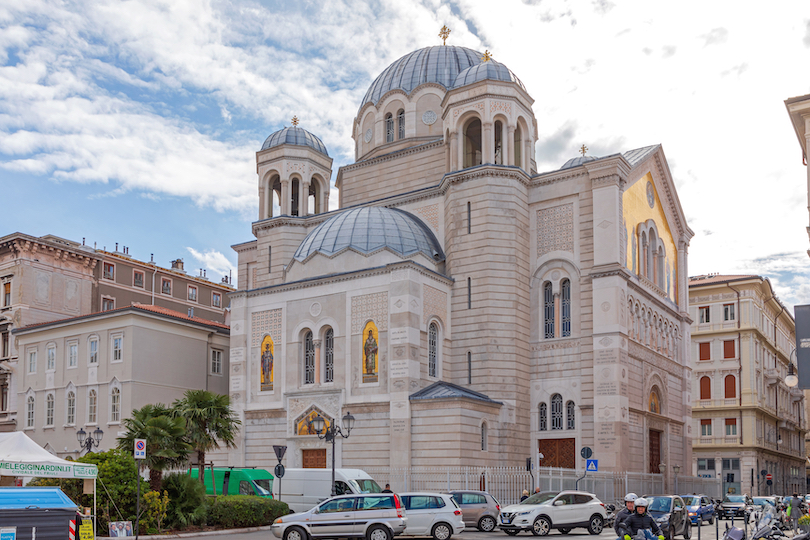
Right in the heart of the Citta Vecchia at the end of the Canale Grande is the striking Saint Spyridon Church. Exhibiting some exquisite artworks and architecture, its elegant domes and fetching facade make for some fantastic photos.
The spiritual home of the city’s Serbian Orthodox community, it was erected back in 1756, soon after Empress Maria Theresa had permitted them to freely practice their religion. Once you’ve admired all its cupolas and arches, head inside to see all its glittering treasures and beautiful colourful paintings.
Aside from its immense, gold altar, there are fine frescoes to gaze up at, coating the high up ceilings of its dome and transepts. The first Orthodox church we’ve ever come across in Italy, its atmospheric interior really was a treat to wander around.
17. Castello di San Giusto
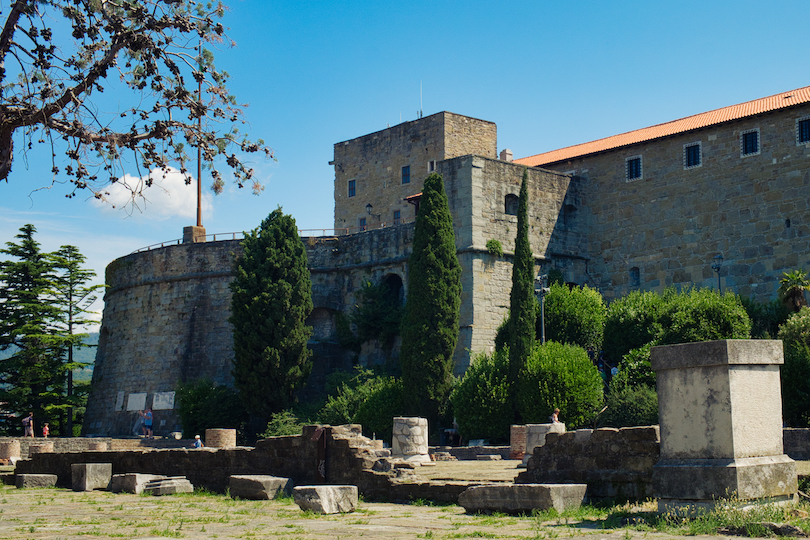
Just a short walk south of the church is the imposing Castello di San Giusto which overlooks Trieste from atop its strategic hilltop. Besides basking in sweeping views over its harbor, Old Town and the hills around it, the fort also has a fascinating past to delve into.
While fortifications have stood here since at least Roman times, the current castle ‘only’ dates to the fifteenth century. Built by the Hapsburgs, it strengthened and enlarged an already existing medieval Venetian bastion.
After sauntering across its wooden drawbridge and narrow moat, you can amble around its old halls, chapel and courtyard or venture up onto its ramparts. Its archaeological museum also contains loads of cool old weapons and exhibits on the castle’s history.
Right before its entrance too are the ruins of ancient Roman columns and the majestic mosaic-filled Trieste Cathedral. All together, they make panting your way up Capitoline Hill well worth the effort.
16. Arco di Riccardo
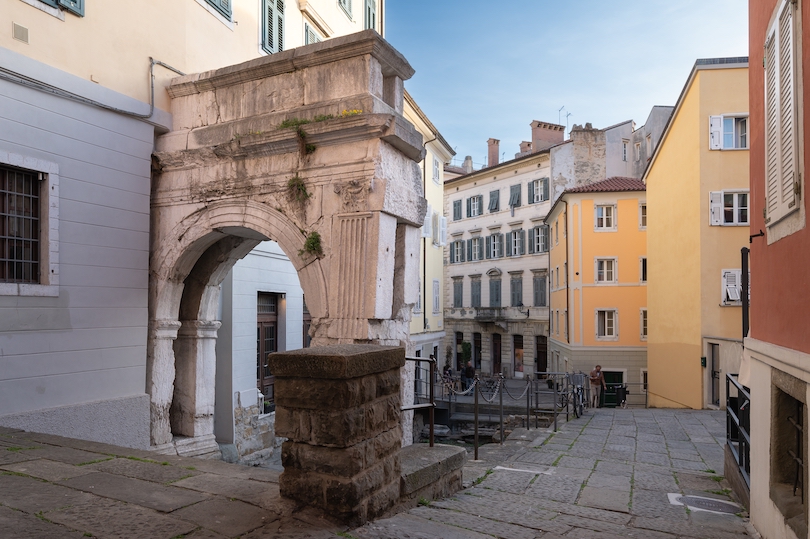
At its foot is yet another of the seaside city’s very many archaeological sites. The only remaining part of its Roman-era walls, the Arco di Riccardo is located in an otherwise quite modern-looking square in the Old Town.
Literally meaning ‘Richard’s Arch’, the gigantic marble gate was constructed in 33 BC with numerous theories abounding about its name. The most popular (yet improbable) of these is that the triumphal arch is now named after Richard the Lionheart who passed by during the crusades.
Remarkably well-preserved for its age, its seven meter-high stone blocks and faded carvings create some great photo opportunities. Now partially incorporated into the side of a building, the arch also looks awesome lit up at night. Right by it too are countless little local bars and eateries to stop off at before heading on your way.
15. Audace Pier
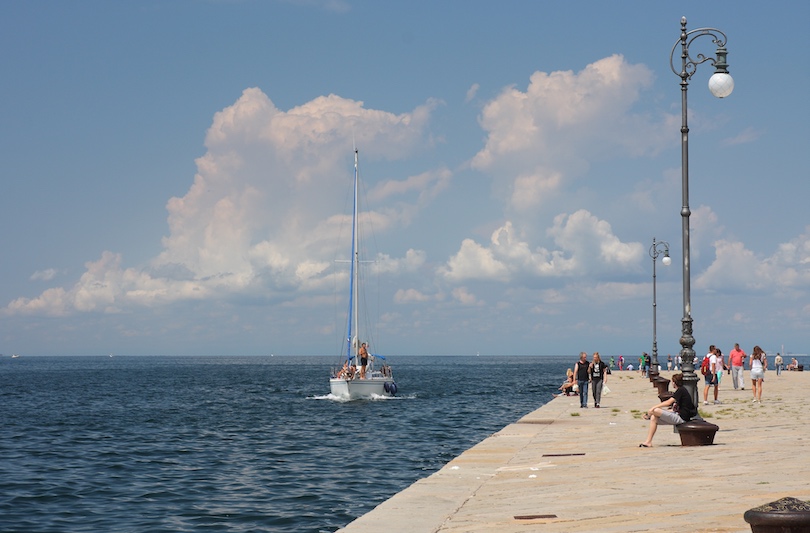
Jutting out into the glinting Gulf of Trieste is the seemingly endless Audace Pier. Set in between both the Piazza dell’Unita d’Italia and Canale Grande, it is a very picturesque spot to stroll along and take in vivid sunsets over the sea.
Stretching around about 250 meters in total, the sturdy stone walkway has been extended a number of times since its inauguration in 1751. Named after an Italian Navy destroyer – the first to dock here – the pier is now mostly only used as a pedestrian promenade.
Dotted by ornate lamp posts and old iron bollards, it really is a lovely, peaceful place to spend some time. Besides boasting breathtaking views over the Adriatic, it also offers up spectacular panoramas of Trieste’s romantic waterfront and main square. We loved watching the sunset here and seeing the city’s buildings and monuments slowly light up afterwards.
14. Kleines Berlin
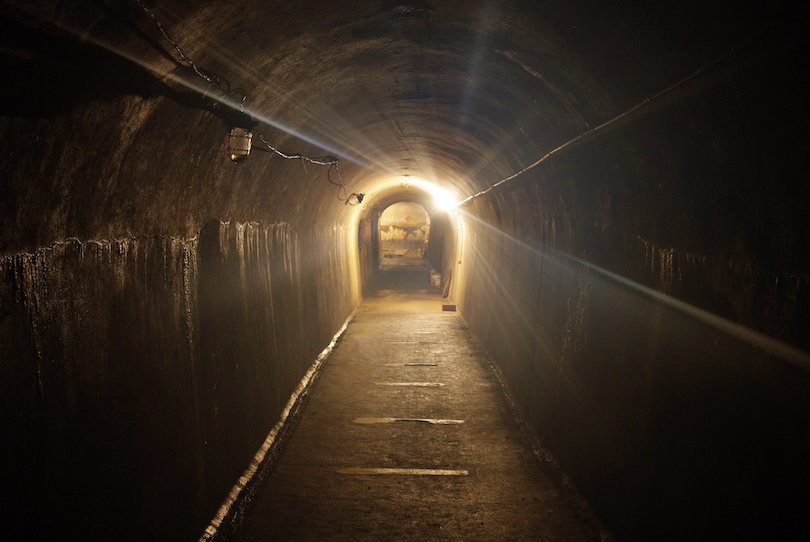
As they’re only open the last Friday of every month, it can be hard to time your trip to Trieste with an underground tour around Kleines Berlin. If you are in town, the complex of WWII air-raid shelters is a must-visit though as they provide an interesting snapshot into a seldom seen part of the city’s past.
Once they annexed Trieste in 1943, the Germans quickly set about building an extensive system of military defenses. To protect soldiers and civilians alike, the now eerie, abandoned tunnels were built under the court area around the same time.
Accompanied by an expert guide, you’ll venture down into their gloomy confines where you’ll see old artifacts and historical photographs. In either Italian or English, they’ll explain what life in the tunnels and Trieste was like during the Second World War. Utterly captivating, the big bunker, its tunnels and well-done displays are often a highlight of people’s visit to the city.
13. Museo Revoltella
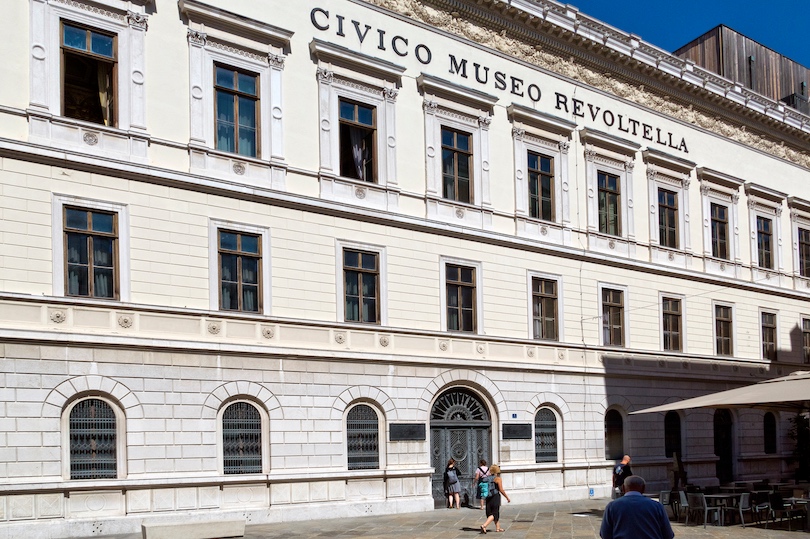
One of the country’s most important modern art galleries, Museo Revoltella lies right at the corner of Piazza Venezia. While plenty of Impressionist paintings and contemporary sculptures are displayed, the museum’s elegant rooms and antique furniture are every bit as stunning.
Bequeathed to the city by Baron Pasquale Revoltella, the superb collection occupies his extravagant Renaissance Revival-style palace. Very well-preserved, its first three floors still look almost the same as they did during the 1850s. This means lavishly decorated halls and staircases lead to resplendent rooms home to fabulous frescoes, glass chandeliers and all manner of ornate furniture.
If this wasn’t enough, its top three floors contain thought-provoking installations by local artists from the region and influential figures such as Carlo Carra, Lucio Fontana and Arnaldo Pomodoro. Once you’ve had your fill of paintings, sculptures and furniture, head to its rooftop terrace for divine views over Trieste.
12. Teatro Romano
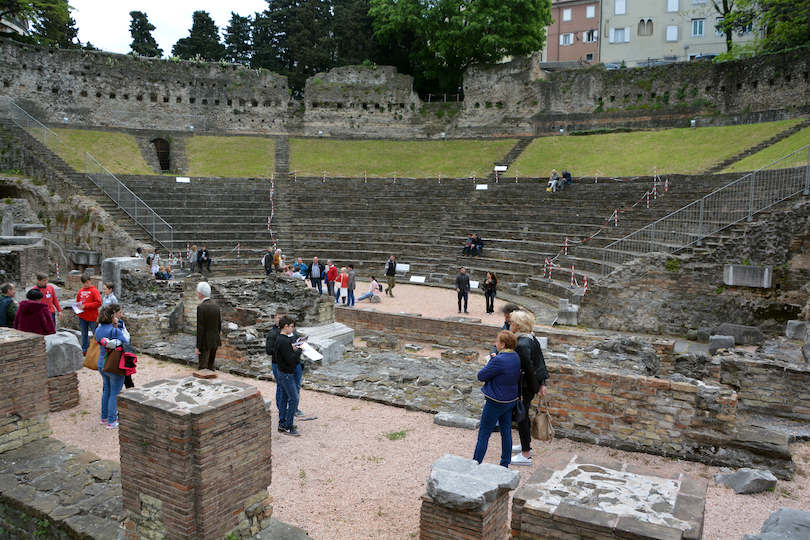
Lying right in the historic heart of town is the Teatro Romano; one of its oldest and most impressive sights. Set in the side of San Giusto hill, its ancient steps, seats and stage create quite the contrast with the chic waterfront just steps away.
Dating to around the first-century AD, the smallish amphitheater was constructed when the Romans were turning Tergeste into an important port upon the orders of Emperor Octavius. Only unearthed in 1938, its ruins were hidden for countless centuries by landfill and buildings. Back in its heyday, up to a staggering 6,000 spectators would have packed out its three semicircular seating tiers.
Since their discovery, the 2000-year-old theater has been one of Trieste’s main attractions with many passing by when exploring the Citta Vecchia. Although it is maybe not quite as extensive or dramatic as many others in Italy or around the Adriatic, we still enjoyed seeing it and snapping some photos.
11. Museum Riseria di San Sabba
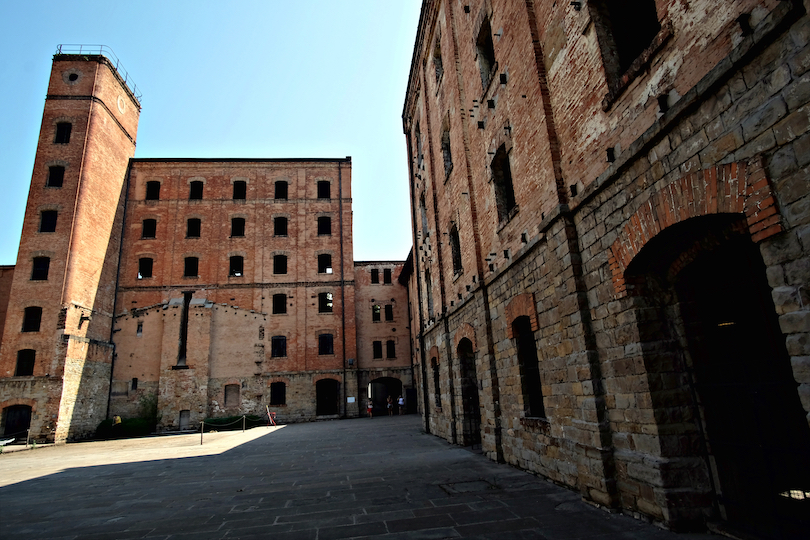
A very moving place, the must-visit Museum Risiera di San Sabba documents in painstaking fashion the tragic events that took place here during WWII. Used by the Nazis as a concentration camp, the former rice factory was also the only one in the country to contain a crematorium.
Now not much more than a hollowed-out husk, the five-story brick building was largely destroyed by the fleeing Nazis to hide the evidence of all their atrocities. From 1943 to 1944, over 25,000 Jews, partisans and politicians are thought to have been imprisoned and interrogated here. Of them, three to four thousand were tragically shot, beaten or gassed to death.
Making your way about the factory is a very sombre experience as both its wide-open empty spaces and narrow claustrophobic cells evoke a feeling of horror. Accompanying each area of the museum are informative plaques while its audio guide also provides some more detail. Situated about twenty minutes south of the center by bus, the site also acts as a memorial for all those who lost their lives.
10. Canale Grande
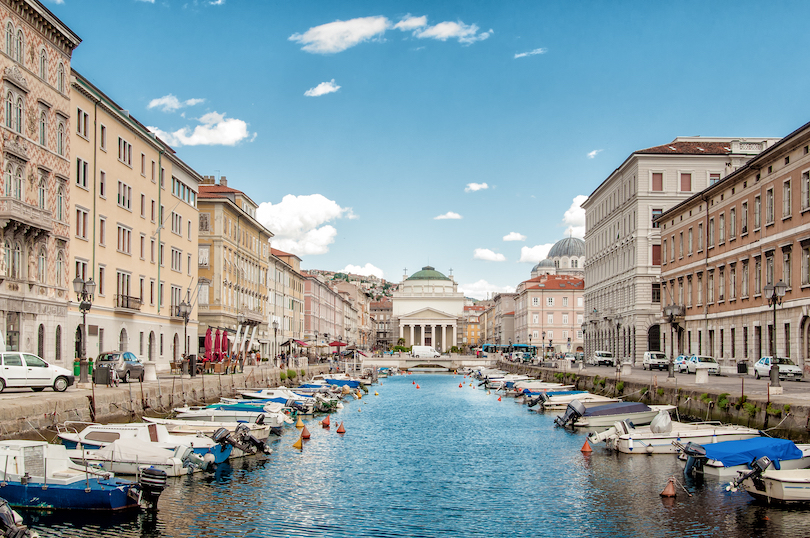
After emerging from its harrowing exhibits, the gorgeous Canale Grande makes for a very welcome change of scene and ambience. Lined by lots of beautiful old buildings and lively cafes, its reflective waters are one of the most famous and photogenic parts of the center.
Located in between Piazza dell’Unita d’Italia and the main train station, its surprisingly short channel was dug in 1756. Despite only stretching just 200 meters in total, two pretty old stone bridges and a more modern pedestrian walkway still manage to cross it before it reaches the sea. From them, you can take phenomenal photos of its glinting waters, colourful boats and the fine facades to either side.
Rising up at its very end too is the imposing Neoclassical Church of Sant’Antonio Nuovo; one of the city’s most recognizable buildings. A splendid statue of James Joyce also lies just before it along the canal. This is because the revered writer lived on and off in Trieste and wrote some of Ulysses here.
9. Enjoy a Coffee in a Historic Cafe

As Trieste was ruled by the Hapsburgs for so long, it has a decidedly different coffee culture from the rest of Italy. Central to social life, ‘little Vienna by the sea’ has tons of historic cafes where you can sit and savor strong brews while gazing out over its scenic squares and seafront.
Now rightfully known as the ‘Coffee Capital of Italy’, its reputation dates back roughly three centuries. As Austria-Hungary’s main seaport, coffee beans poured into Trieste from every corner of the globe thanks to its tax-free status. Due to this, cafes sprung up along every street with the first having been opened in 1768.
Many still even exist today with Caffe degli Specchi, Caffe San Marco and Caffe Tommaseo counting among the oldest. Aside from all their atmospheric old-world interiors and attractive outdoor terraces, some have their own brands and blends to try.
Unlike the rest of the country where you knock the coffee back quickly at a bar, here each sip is to be savored slowly. After asking for a ‘capo in B’ – sort of a small cappuccino – just relax and watch the world go by. Seemingly packed at all hours, enjoying its quaint historical cafes actually ended up being one of our favorite things to do in Trieste.
8. Grotta Gigante
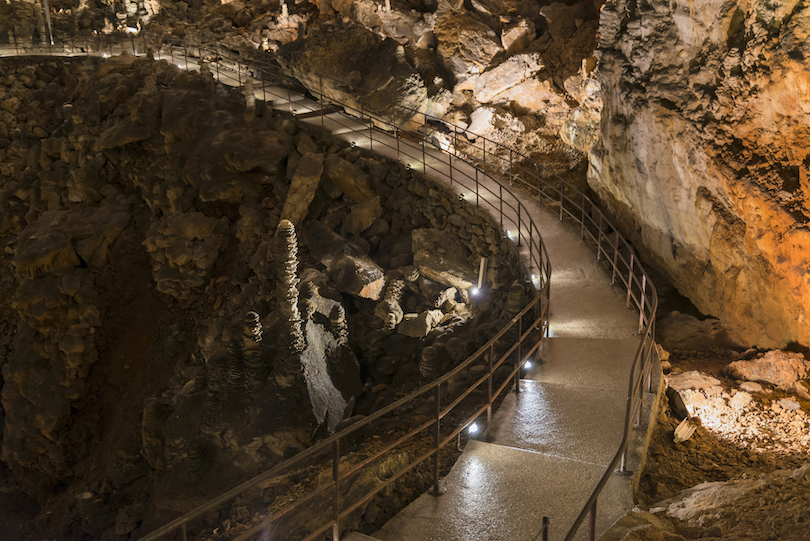
Simply jaw-dropping, the ginormous Grotta Gigante is remarkably one of the largest caves open to tourists anywhere on Earth. Full of sparkling stalactites and stalagmites, its immense natural hall lies just half an hour north of town by bus.
Slowly formed across the millennia by erosion, the cavernous cave was only discovered by accident in 1840. For well over a hundred years now, all its cool karst formations have astounded visitors with their beauty. Its stupendous size though is really what hits you as St. Peter’s Basilica in Rome could actually fit within it.
As you slowly make your way down its 500 steps to the cave floor, you can enjoy magnificent views of its softly lit walls and craggy ceiling far, far above. In total, the hall towers a whopping 107 meters in height. As it stretches 130 meters in length and is 65 meters wide, the cave really is enormous.
A firm favorite with families, it is certain to be unlike anything you’ve ever seen before. Unless that is you’ve been to the even larger La Verna cave in France!
7. Strada Vicentina
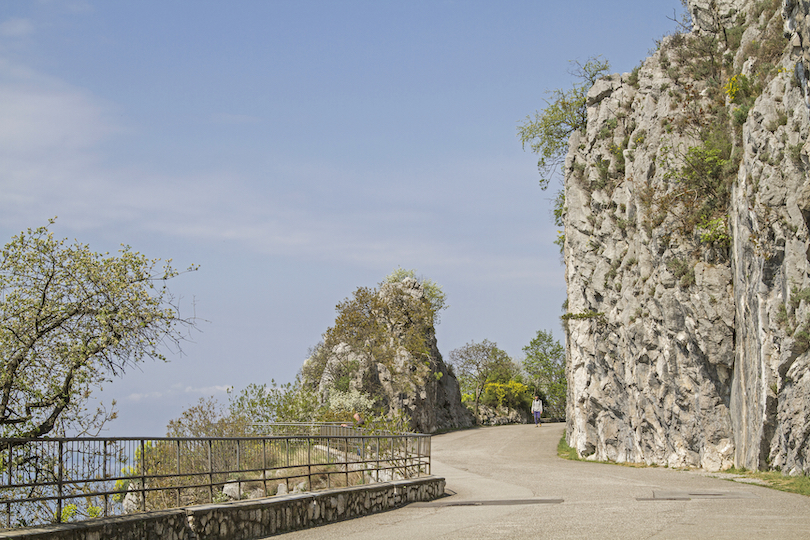
For yet more spectacular scenery, nature and views, hike along the lovely Strada Vicentina between Opicina and Prosecco. Also known locally as the Napoleonic Way, it’s easy, flat, almost straight route passes not far from Grotta Gigante.
Either cut into the sides of rugged cliffs or running alongside them, the four kilometer-long path offers spellbinding views over the Gulf of Trieste the whole way along. Its two names hail from the engineer Vicentini who planned it and the Napoleonic troops who some reckon originally created the route.
Very peaceful and picturesque, the paved path takes you by wonderful groves of trees, colourful wild flowers and rock formations. Dotted along are some sublime viewpoints and sites like the obelisk just outside Opicina and Brutalist-style Sanctuary of Monte Grisa.
6. Barcola Beach
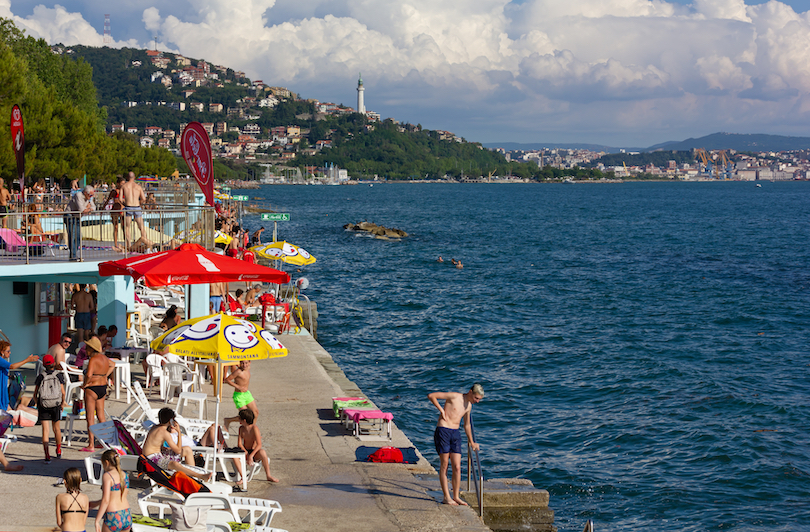
If after all the sightseeing and endless coffee sipping you just want to sit by the water and relax, then Barcola is one of the most popular places to go. Although its ‘beach’ doesn’t actually have any sand, its promenade has direct access to the sea and plenty of shady spots to go around.
Backed by groves of fragrant pines, its attractive esplanade stretches well over a kilometer in length. While there may be no sand, locals and tourists sunbathe either under the trees or all along its warm concrete. Its ten ‘topolini’ terraces also have changing rooms, showers and toilets to make use of.
As you soak up some sun, you can enjoy excellent views over the coast and Miramare Castle in the distance. Should you get too hot, just jump into the Adriatic’s enticing waters right beside you. In the evening, many people stroll along the seafront, stopping off at its numerous little lively bars.
5. Faro della Vittoria
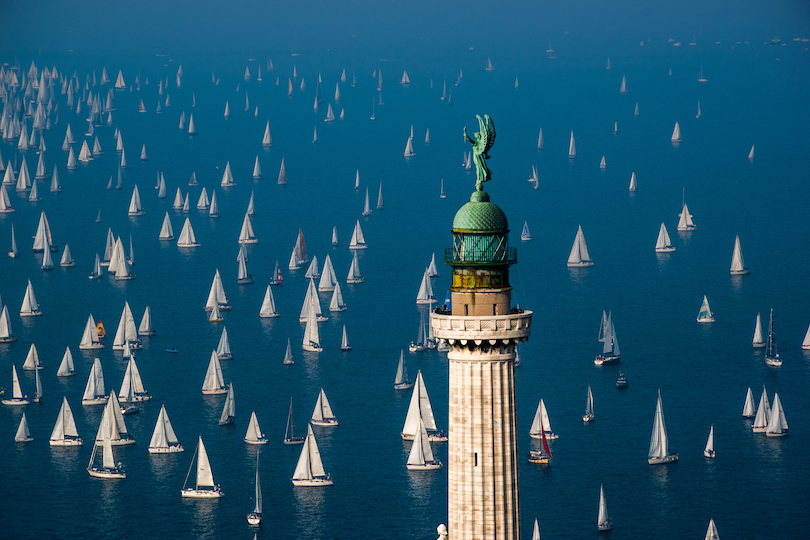
Just south of Beach Barcola on the way back into town is the Faro della Vittoria. Visible for countless kilometers around, the iconic landmark and lighthouse make for some fantastic pics with its high-up summit only being open at weekends.
Perched atop Gretta hill, its massive concrete column soars a considerable 68 meters in height. One of the tallest lighthouses in the world, it was erected in 1927 to celebrate Trieste joining the Kingdom of Italy. More sombrely, it also commemorates those who lost their lives at sea during the First World War.
Still in use today, its striking tower is topped by a large statue of Victory while one of a seaman also adorns its front. Visitors can opt to take the elevator to its observation platform or painfully pant their way up over 250 steps. Either way, you’re rewarded with phenomenal views over the city, coast and sea before you.
4. Trieste Cathedral
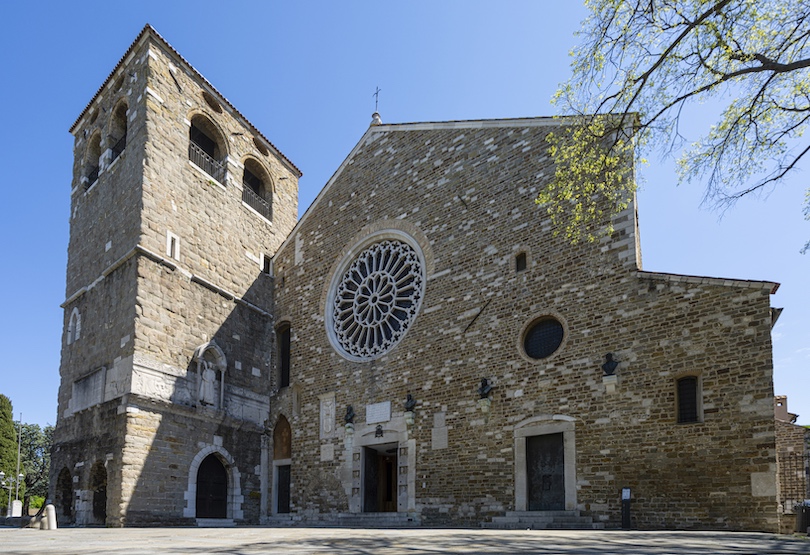
Also set atop Capitoline Hill, Trieste Cathedral can be found right next to the Castello di San Giusto. Exhibiting an intriguing mix of architectural styles, it has some impressive mosaics and important old tombs to check out inside.
Interestingly enough, the cathedral was actually created back in the fourteenth-century by combining two earlier churches together. Despite this, its weathered brick facade still looks quite unremarkable with both Gothic and Romanesque-style features on show. The highlight here though is undoubtedly its wonderful rose window.
While its interior again appears quite plain, some pretty colored patterns decorate its arches, and an almost glowing gold and blue fresco covers the ceiling above its altar. Along its aisles to either side too are some amazing mosaics and ornate tombs from the House of Bourbon. You can also climb up its bell tower for awesome views over the entire Old Town.
3. Citta Vecchia
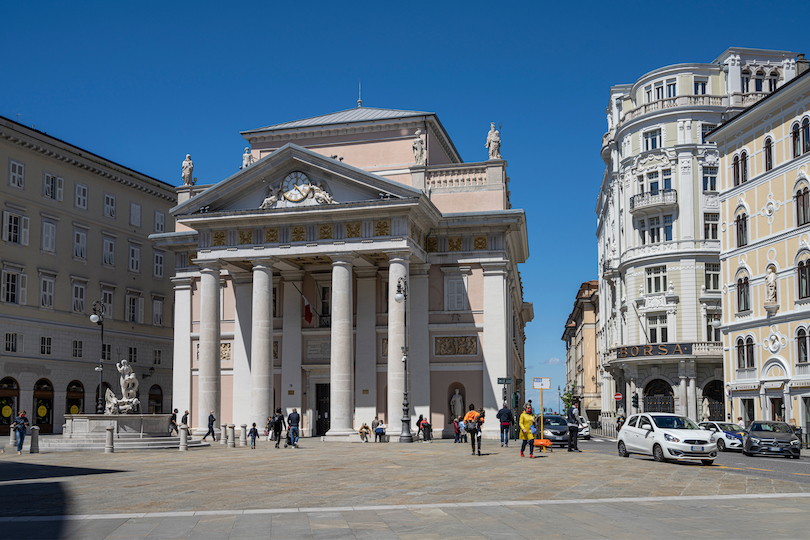
Loads of fun to get lost in, Citta Vecchia’s warren of cobblestone streets contain most of the seaside city’s main sights and many of its best dining establishments too. Besides Roman amphitheaters and arches, you can find countless quiet churches, squares and cafes at which to pass the time.
Mostly pedestrian, its mess of medieval buildings are sandwiched in between San Giusto hill and the sparkling Adriatic Sea. Quite hilly in places, the Old City has lots of lovely architecture and charming centuries-old churches like those of San Silvestro and Santa Maria Maggiore to admire. Lining all its little squares and streets too are tons of traditional bars and trattorie to try out.
After wandering about for hours, stopping for an aperitif or gelato is the ideal way to take in its lively yet laidback ambience. Along with its seafront, the Citta Vecchia was by our favorite part of Trieste.
2. Piazza dell’Unita d’Italia
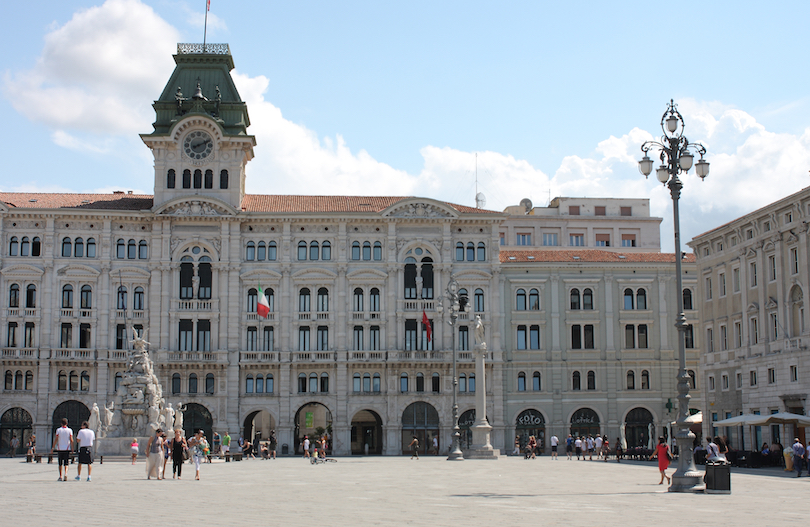
In contrast to Cavana and the Jewish ghetto’s claustrophobic alleys, the marvelous Piazza dell’Unita d’Italia stretches away endlessly before you. Europe’s largest seafront square, all its grand buildings look out over the Adriatic with everything delightfully lit up at night.
Surrounded by stupendous palazzi and public buildings, the city’s main piazza was commissioned by Empress Maria Theresa to impress visitors to Austria-Hungary’s most important seaport. It certainly achieved its goal as beautiful Baroque, Neoclassical and Art Nouveau facades line its paving stones.
Dominating one whole side of the wide-open square is Trieste’s Eclectic-style Town Hall that dates to 1875. Its central clock tower also overlooks the 1754 Fountain of the Four Continents which is made up of many striking statues. Other eye-catching landmarks include Palazzo Pitteri, Palazzo del Lloyd Triestino and the classic Caffe degli Specchi.
While Piazza dell’Unita d’Italia, its buildings and views already look incredible during the day, at night it arguably looks even better. We loved strolling around enjoying the sea breeze whilst all its facades were so magically illuminated against the dark sky.
1. Miramare Castle
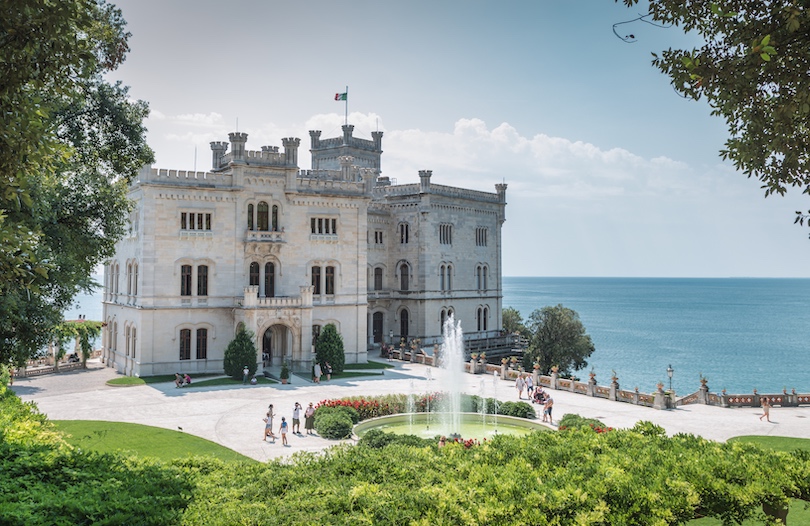
Just past Barcola along the city’s northern coastline is the majestic Miramare Castle; one of its main symbols and sights. A photographer’s dream, its bright white walls and elegant towers look stunning as they rise dramatically above the sea and shore about them.
Erected atop a small spur overlooking the Adriatic, the massive manor was built in 1860 for Austrian Archduke Ferdinand Maximilian. He and his newly-wed wife Charlotte of Belgium briefly resided here before departing for Mexico where they were crowned emperor and empress and executed a couple of years later.
Also Eclectic in style, the fairytale-like castle now has loads of lavishly decorated rooms, apartments and halls to amble around. Its antique furniture, artworks and exhibits provide more of an insight into nineteenth-century aristocratic life and that of the ill-fated couple too.
Once you’ve snapped some pics of its crenellations and gazed out over the glittering Gulf of Trieste, make sure to explore its extensive gardens too. Immaculately maintained, they’re full of exotic plants and flowers with pretty pools, statues and viewpoints dotted here and there.
Where to Stay in Trieste
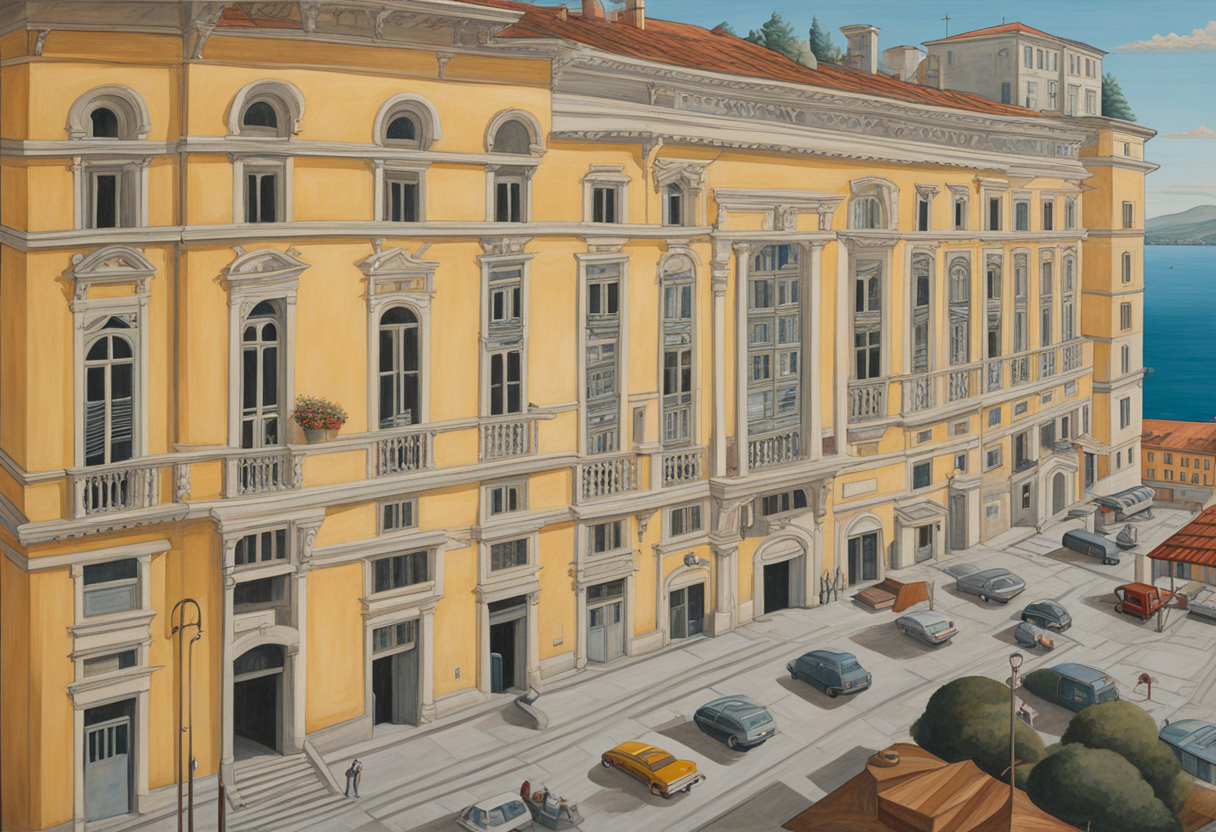
The vast majority of Trieste’s accommodation options are either clustered about Citta Vecchia or line the streets north of the Canale Grande towards the train station. As many tourist attractions in Trieste are within walking distance from here, they are very convenient spots to stay when visiting town.
One such place is the superb Hotel Solun , just a stone’s throw from the canal and seafront. Very chic and stylish, the vintage-inspired four-star hotel has clean, comfortable rooms and spacious suites for guests to enjoy. Well-equipped, they often come with balconies and even living areas. In addition, its retro-looking restaurant puts on brilliant breakfasts while the staff are very friendly and welcoming.
Just a bit further towards the train station is the very relaxed, family-run Hotel Milano . Still near to all the centre’s main sites, the three-star hotel has simple rooms for up to four guests to sleep in. Asides from being clean and comfy, they are quiet and come with minifridges and satellite TVs. Great value for money, it also has a casual bar and lobby lounge with breakfast buffets being available.
How to get there
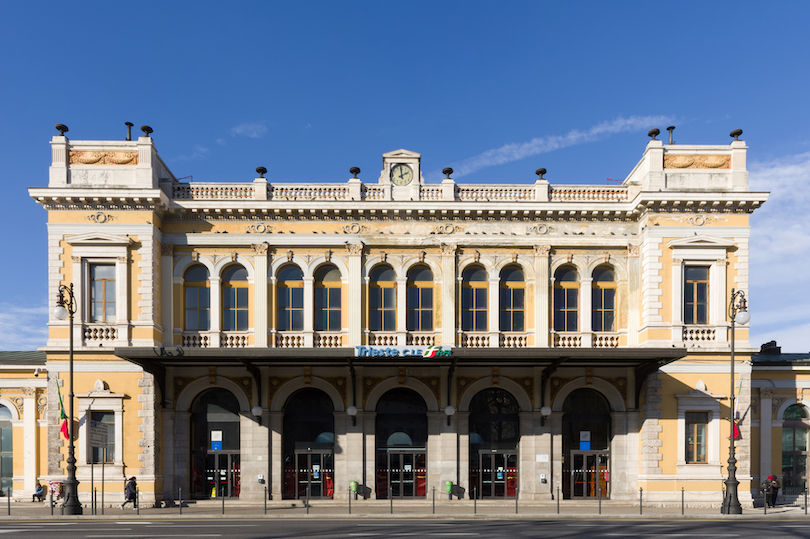
Located right in the very northeast of Italy, it is served by the rather small and regional Trieste – Friuli Venezia Giulia Airport. Flights arrive here from around about twenty different destinations both in Italy and abroad. It is then a half-an-hour train journey to the center from its terminal. Other airports within two hours of Trieste are those of Ljubljana, Pula and Rijeka.
High-speed trains also connect you to everywhere from Venice and Udine to the much further away Florence , Rome and Milan . International trains also depart for both Ljubljana and Vienna.
Other than driving, you can also take buses to and from the city from dozens of destinations around Europe. These include not just Belgrade and Berlin but Dubrovnik, Prague and Salzburg too.
Once you arrive, you can walk almost everywhere or take local buses and trains to nearby sights.
Approximate travel times:
- Venice – 2 hours by car, 1 hour 45 minutes by train
- Ljubljana (Slovenia) – 1.5 hours by car, 1.5 hours by train
- Udine – 45 minutes by car, 20 minutes by train
- Grado – 45 minutes by car, 1 hour 30 minutes by bus
- Piran (Slovenia) – 1 hour by car, 1 hour 30 minutes by bus
- Rijeka (Croatia) – 1.5 hours by car, 2 hours 30 minutes by bus
- Zagreb (Croatia) – 3 hours by car, 4 hours by bus and train
Best Time to Visit Trieste
As it lies between the Alps and the Adriatic, Trieste enjoys a pretty mild Mediterranean climate, quite unlike other cities across northern Italy. This usually means that the winters aren’t too cold nor the summers too hot. The city does receive quite a bit of rain, though this is evenly spread across the year with November being the wettest month.
The best times of year to visit are from June through to August when Trieste is sunniest and temperatures average between 25 and 28°C (77 to 82°F). While this is the busiest and most expensive period, it is also when swimming is the most comfortable and enjoyable.
May and September are also ideal as they see fewer crowds and loads of daylight, though it can rain quite a lot during the latter. Prices don’t drop much until earlier or later in the year. The beginning of October sees Trieste’s most famous event, the exciting Barcolana take place. The largest sailing regatta in the world, it has thousands of ships of all different sizes race about the Gulf of Trieste. Over the course of ten days, numerous competitions are held at sea with concerts, exhibitions and food villages also dotted about on land.
December to March is the least popular time to visit due to the cooler weather (around 8 to 12°C, so 46 to 53°F) and gloomier skies. You can find some cheaper deals at this time with its Christmas market and Trieste Film Festival being good reasons to book. The strong Bora wind that sometimes sweeps Trieste can make exploring the center less comfortable though.
Share this post:
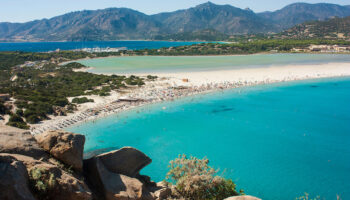
14 Best Things to do in Sardinia, Italy
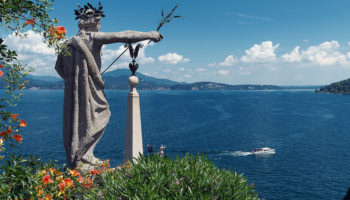
10 Best Day Trips from Milan
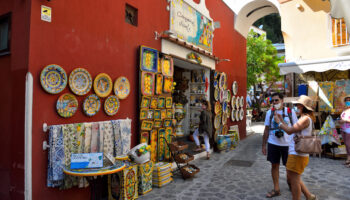
14 Best Things to do in Positano, Italy

14 Best Places to Visit in Lombardy, Italy
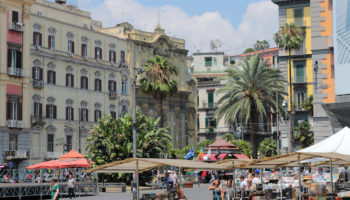
Where to Stay in Naples: Best Neighborhoods & Hotels
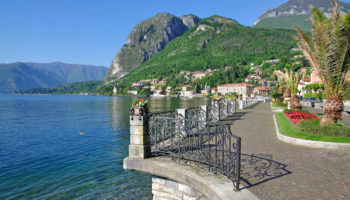
Where to Stay in Lake Como: Best Towns & Hotels
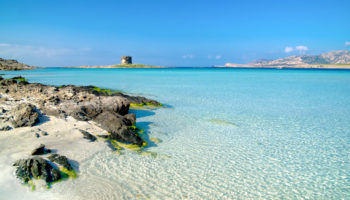
Where to Stay in Sardinia: Best Towns & Hotels
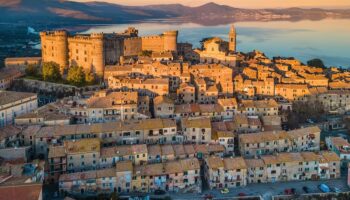
14 Best Places to Visit in Lazio, Italy
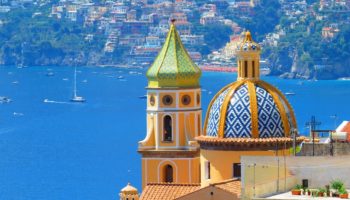
10 Most Beautiful Amalfi Coast Towns
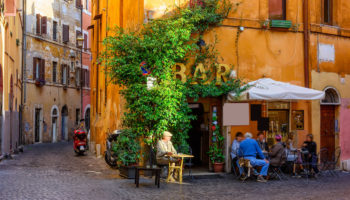
17 Best Cities to Visit in Italy
Reader interactions, leave a reply cancel reply.
Your email address will not be published. Required fields are marked *
This site uses Akismet to reduce spam. Learn how your comment data is processed .
The New York Times
Travel | 36 hours in trieste, italy.
Advertisement
Travel | 36 Hours
36 hours in trieste, italy.
By SETH SHERWOOD AUG. 29, 2017
A distinctive Adriatic experience awaits in this Old World city, with its broad, breezy plazas, coffeehouses and cozy seafood restaurants. Related Article
Trieste is famous for its cold, gale-force Bora wind, and indeed, all manner of creatures and people have blown through the seaside city in Italy’s far northeast, next to the Slovenian border. Dinosaurs and Neanderthals once roamed the limestone hills of the Karst region, and legend holds that Jason and the Argonauts sailed in with the Golden Fleece. Empires breezed in, too, notably the Roman and the Byzantine. But it was centuries of Austrian rule that left the most enduring mark. The House of Hapsburg built much of Trieste’s regal core and left a permanent mark on its gastronomy — evinced by the beer, sauerkraut and strudel on many restaurant menus. The winds also brought James Joyce, who lived intermittently in the city in the early 20th century. But Trieste is hardly a gusty relic. A new high-tech photography museum, an expanding night life area and a fancy new nearby marina, Portopiccolo , join the Old World churches, picturesque piazzas, sumptuous palazzo-museums, classic Austrian coffeehouses and cozy seafood restaurants to create a distinctive Adriatic experience.
Explore the map and find things to do in Trieste.
1) 5 P.M. Time Travel
Your crash course in history begins at the Roman amphitheater on Via del Teatro Romano. From there, ascend the staircase and steep streets to the hilltop Castello di San Giusto (admission, 3 euros, about $3.50). Built from the 1400s to 1600s on the site of the former Roman settlement, the fortress offers panoramic vistas of the city and sea. More views await inside the complex’s new attraction, the Alinari Image Museum (AIM). Opened in 2016, the museum uses technology: wall projections, touch-screen panels, virtual reality installations, 3-D films, computers and even traditional photographs — to envelop visitors in Trieste’s past. Spectral music ensures full sensory immersion. Admission, 8 euros.
2) 8 P.M. Fish School
Expect to learn some salty new vocabulary at Alla Sorgente, a rustic seafood restaurant with stone walls and wooden tables. In lieu of a menu, the matron of the house tells you (in Italian) the dishes. You might hear talk of capesante (scallops) or orata (sea bream), to say nothing of triglia (mullet) — recently served cold with thyme and vinegar-marinated leeks — or the fantastic house-made spaghetti with tiny clams and tomato chunks. Three courses cost about 40 euros a person.
3) 10 P.M. Liquor Lane
A bar for every thirst awaits on Via Torino, a surging strip of night life on a stony pedestrian street. A restaurant and juice bar by day, Draw is a vast space adorned with vintage bric-a-brac, from bicycles to suitcases-turned-tables. An older vibe suffuses Mor , a small room with antique globes, lanterns and clocks that serves artisanal booze and clever cocktails, including the Rye-N-Air (8 euros), a smooth riff on the Manhattan.
4) 10 A.M. White Market
Soap opera magazines, olive oil, Pugliese peppers, shoelaces, bouquets, old circus clown paintings, faded postcards, ginger-apple jam and that vintage Doris Day album: You can now strike these items from your shopping list. All are on offer at the Mercato Coperto , a two-level space from the 1930s with touches of Art Deco. Downstairs, the pungent smells of regional bounty emanate from produce stands, fishmongers and flower stalls. Upstairs, you’ll find a riot of secondhand furniture, electronics, housewares and collectibles.
5) Noon; Antiques and Art
Museo Revoltella is vivid proof that Italian art continued to thrive after the Renaissance. The upper floors of the museum — three combined historical palazzi — display 19th- and 20th-century Italian painters (and a few expatriated foreigners) who might not be household names, but whose works are worthy of awe: Giorgio Belloni’s moody nature scenes, Vito Timmel’s radiant characters and Edgardo Sambo’s melancholy nude women. The opulent historical rooms of the lower floors are a treasure of decorative arts, from the vast ballroom to the ornate library, lined with leather-bound volumes. Admission, 7 euros.

6) 2 P.M. Ham Session
A cannon-size mortadella greets visitors to Trattoria da Giovanni , a decades-old, wood-lined restaurant. All day, locals crowd the counter for slices from this monster or from an endless succession of fresh-cooked pink hams, which the bartenders slide into thick rolls with shaved horseradish and mustard. Grab an outdoor table and order from the chalkboard menu, which might include local treats like jota (a hearty soup that usually includes beans, potatoes and pork), or lush, sweet sauerkraut topped with plump sausages, roasted pork chunks and succulent pig’s tongue. A glass of malbec, served from a wooden cask, and a slice of strudel complete your Triestino tasting. Lunch for two costs around 20 to 30 euros.
7) 4 P.M. Grappa and Gowns
Some of the most compelling shops in Trieste line Via Felice Venezian. The eponymous proprietors of La Piccola Bottega Spiritosa di Piolo & Max distill artisanal vermouth, grappa, absinthe and divinterrano — a sweet concoction of wine, fruit juice, cinnamon and other ingredients — as well as additional boozy elixirs that they sell in their boutique. The delicacies at Delikatessen Modernariato & Collezionismo are mostly vintage furniture and design, including anatomy posters and industrial lamps. And whether you’re seeking a thimble collection, Olivetti typewriters or just a simple bust of King Tut, the dusty treasure trove known as Il Mondo di Didy can help.
8) 6 P.M. Trieste Tradition
A predinner aperitivo is a ritual here, and the Piazza Cavana area offers some of the friendliest stops for a glass and a bite. A subtle maritime theme pervades Al Ciketo , a new spot lined with distressed wooden boards from old ships and metal lampshades made from paint cans. The tasty cicchetti (snacks, 1 euro) — bread topped with salami, codfish spread, mortadella and the like — pair nicely with a glass of the warm, smooth local red blend from the Sancin winery (3.50 euros). Bigger and brighter, Life is a favorite for its free buffet — cold pasta, roasted vegetables, Parmesan cheese — and Hugo cocktails (white wine, sparkling water, elderflower juice, mint, lime; 4 euros).

9) 8 P.M. Trieste Two Ways
Experimental or traditional? Pepenero Pepebianco , a vaulted contemporary restaurant decorated in autumnal tones, sends local ingredients down both culinary paths. The adventurous trail gives an Asian touch to artichoke (fried and served with burrata foam) and red tuna (served with sesame seeds and apricot-ginger sauce), while jazzing up scallops (courtesy of black cabbage and smoked goose ham) and mussel soup (with candied tomato, seaweed and coriander). For a more classic taste of Trieste, potato gnocchi get a meaty infusion from stewed veal tail and crunch from chopped asparagus. Pistachio gelato is an earthy coda. A three-course dinner for two costs about 100 euros.
10) 10 P.M. Spirits in the Night
Stepping into Antico Caffè Torinese is like stepping into 1919 — the year of the cafe’s birth — thanks to the dark wood paneling, marble counter and chandelier. Now run by a young team, the cafe is also an ace cocktail bar where you can sip a sweet-sour-herbal Americano (6 euros) while flipping through books like “Trieste Romantica.” Spring ahead in time at Urbanis , whose glamorous-gaudy decorative mix seems plucked from 1980s Soho in New York: gold tables, shimmery gold cushions, mosaic floor, Art Deco lamps. The lengthy cocktail menu is state of the art, however. In addition to classics, famous and obscure, you can sample the sublime house Vini Vidi Vici (Laphroaig Scotch, Pineau des Charentes-fortified wine, and bitters; 13.50 euros), which comes in a large chalice filled with a carved, gemlike ice cube: a drink to honor a conqueror (or console the vanquished).
11) 10 A.M. Trieste, Unfiltered
No one has an excuse to be tired in Trieste. The city is the headquarters of the coffee company Illycaffè, and historical coffee houses dot the streets. For views, none beats Caffè degli Specchi , a 19th-century specimen on the Piazza Unità d’Italia, said to be the largest seaside square in Europe. Ringed by ornate palazzi, the outdoor tables overlook the Adriatic and the 18th-century Fountain of the Four Continents. For internal ambiance, slide into the banquettes of the voluminous, cathedral-like Caffè San Marco . Built in 1914, the soaring bookstore-cafe has marble tables, and bronze coffee leaves ring the ceiling. Coffee fills the menu, too, from smooth cappuccino (2.50 euros) to Viennese coffee heaped with whipped cream and cinnamon (2.50 euros).
12) Noon; Austrian Aristocrats
The glory of the Hapsburgs lives eternally at Miramare Castle . Built by Archduke Ferdinand Maximilian, the seaside Gothic Revival structure of white Istrian stone feels like a museum of 19th-century craftsmanship. Moving through luxurious bedrooms, ballrooms and dining halls, you find wondrously painted ceilings, exquisite marquetry furnishings, silk wallpaper and chiseled ivory chests. But the real star is the sea, which enters every room through tall windows. The gift shop provides an ongoing Trieste education, courtesy of books by James Joyce and the travel writer Jan Morris, whose account of the city is “Trieste and the Meaning of Nowhere.” Admission, 10 euros.
In the heart of the city, Palazzo Talenti 1907 (Via Saverio Mercadante 1) has 35 minimalist-modern apartments in various sizes with white walls, gray fabrics, full bathrooms and well-appointed kitchens. Studios start at 90 euros a night.
With a new owner and look since last year, the simple and cozy 12-room Hotel all’Arco (Piazzetta San Silvestro 4; hotelallarco.com ) is located on a quiet street next to trendy Piazza Barbacan. Doubles from 60 euros.
- planning your trip - - -
Flying from your area .
Staying in trieste..
Flight and Hotel information provided by Google. Prices represent a snapshot of low fares and rates for weekend trips.

36 Hours in Brussels

36 Hours in Cincinnati

36 Hours in Granada, Spain

36 Hours in Anchorage

36 Hours in the Upper Peninsula of Michigan

29 Best Things to See in Trieste, Italy
by Ryan | Mar 7, 2023 | Italy , Trieste

What Are the Best Things to See in Trieste?
Trieste , located on a thin strip of Italy sandwiched between Slovenia and the Adriatic Sea, has many distinct attributes for visitors to explore. If you’re interested in architecture, the best things to see in Trieste are:
- Unity of Italy Square
- Trieste City Hall
- Trieste Cathedral
- Palazzo del Lloyd Triestino
- Church of Santa Maria Maggiore
- Palazzo Carciotti
- Prefettura di Trieste
- Palazzo della Borsa Vecchia
- Serbian Orthodox Church of San Spiridione
Evangelical Lutheran Church
- Main Post Office Building
- Palazzo Stratti
- Palazzo del Tergesteo
Trieste Synagogue
- Roman Theatre of Trieste
- Terni-Smolars House
Neogothic Palace
- Salone degli Incanti
- Palazzo Gopcevich
- Bartoli House
- Greek Orthodox Church of Saint Nicholas
- San Silvestro Basilica
Ex Lighthouse La Lanterna
- Church of Sant’Antonio Nuovo
- San Giusto Castle
- Eataly Trieste
- Fountain of the Four Continents
- Richard’s Arch
- Statue of James Joyce
We spent all of November visiting the sights in Trieste . Based on our experience, we compiled this list of the best things to see.
If you don’t have a month to explore, you can follow our suggested Trieste Walking Tour and easily see all the best sights on our list in one day.
This website contains affiliate links that may earn us a small commission at no additional cost to you.
Best Things to See in Trieste

aka Piazza Unità d’Italia

aka Town Hall aka Palazzo del Municipio di Trieste aka Palazzo Cheba (meaning “cage”) aka Palazzo Sipario (meaning “curtain” because it hid the Old City)
The tower dominates the façade with the clock and two Moors, Mikeze and Jakeze, who ring out the hours.
The building houses the offices of the Municipality of Trieste.

aka Cattedrale di San Giusto Martire
The first religious building on the site was built in the 6th century using part of an existing structure. Two basilicas were built on the ruins of the old church between the 9th and 11th centuries. In the 14th century, the two basilicas were joined by demolishing one nave of each basilica and constructing an asymmetrical façade with a Gothic rose window .
The two lateral apses are decorated with mosaics from the 12th and 13th-century Veneto-Byzantine schools. The central apse is from 1932. The central nave’s wrought-iron chandelier, donated by the Habsburgs, was initially intended for the Throne Room in Castello di Miramare.

aka Palace of the Regional Government aka Palazzo of Lloyd Austriaco
The building was completed in 1883 for the Lloyd Austriaco company, one of the oldest maritime businesses in the city. The two fountains on either side of the façade symbolize freshwater (Thetis) and saltwater (Venus), the two liquid kingdoms on which Lloyd’s fortune was based.
Since 1991 the building has been the seat of the Presidency of the Regional Council of Friuli Venezia Giulia.

aka Church of the Immaculate Conception of the Blessed Virgin Mary aka the Baroque Church of the Jesuits
The church of Santa Maria Maggiore church was built by the Jesuits in the 17th century but has been managed by the Franciscan s since 1922. The church is at the foot of the San Giusto hill near the B asilica of Christ the Savior (formerly the Basilica of San Silvestro).

Palazzo Carciotti, the home of the Greek merchant Demetrio Carciotti, is a jewel of neoclassical architecture designed by Matteo Pertsch. The palace includes the main house, sixteen apartments, and eighteen warehouses. The dome, topped by the Napoleonic eagle, served as an astronomical observatory. The sculptures of the deities are the work of Antonio Bosa, a pupil of Canova.

aka Prefecture aka Government Palace aka Palazzo della Luogotenenza Austriaca
Formerly the Palazzo della Luogotenenza, this is the most recent building in the square. Its Byzantine-style golden mosaics glitter at sunset. The mosaics originally depicted the Austrian double-headed eagles, but were replaced in 1919 with the crosses of Savoy.
The building is now the seat of the Prefecture, the Commissariat of the Government of Trieste.

aka Palazzo of the Old Stock Exchange aka the Old Stock Exchange Building
Today, the building is Trieste’s Chamber of Commerce. Similar to the nearby Fountain of the Four Continents, the statues across the front are allegories of the four known continents. On the roof are other sculptures representing the Danube, Trieste, Minerva, and Neptune.
A giant sundial using a camera obscura traces a golden ellipse inside the building. The work of the famous watchmaker Antonio Sebastianutti was used to synchronize ships’ chronometers. In 2010, a second sundial, with fossils, was mounted on the exterior sandstone floor.

The floor plan is a Greek cross surmounted by a large dome and four small Byzantine domes. Among the colorful mosaics, frescoes, and icons covered with precious stones, a silver lamp donated by Pavel Romanov, Tsar Paul I of Russia, stands out. The façade is partly covered with stone from the quarries of Santa Croce and Brioni.

aka Lutheran Evangelical Church ( Luternasko Evangeličanska Cerkev )
One of the many effects of the Free Port regime in Trieste was a strong presence of German merchants and administrators in the city, so much so that the Augsburg (or Augustan) Confession Evangelical Community was already legally constituted by 1778. The church, consecrated in 1874, was designed in Neogothic style by the architect Zimmermann of Wroclaw.

aka Palazzo delle Poste Trieste
The majestic Palazzo delle Poste, the main post office, is an eclectic 1894 work by the Viennese architect Friedrich Selz. It now occupies the area of ancient salt pans on which the previous Customs building had been erected. The Mitteleuropa Postal and Telegraph Museum is on the ground floor, the only one in Italy.
The palace is a quadrilateral that occupies the entire block, following the model of Austrian administrative buildings. The main façade is decorated with statues representing Navigation, Railway, Commerce, Viticulture, Agriculture, and Industry.

aka Casa Stratti
Once the home of the Greek merchant Niccolò Stratti, the building is now owned by Assicurazioni Generali. The historic Caffè degli Specchi is located on the ground floor.
At the top of the façade, a sculptural group celebrates the city of Trieste, progress, and commerce.

aka Tergesteo Palace
The Tergesteo Palace is an important building in Trieste. The ground floor is a shopping arcade , while the upper floors have been offices and residential apartments since its inauguration. It was originally home to the Trieste stock exchange.
A neoclassical palazzo from the mid-19th century, traversed by a cross-shaped glassed-in arcade. The original iron and glass ceiling of the gallery was demolished and replaced with a glass block structure during restoration ending in 1957. The original roof of the gallery was restored in 2011.
The sculptures on the main façades represent Commerce, Industry, and Navigation. In the center stands the figure representing Trieste as Tethys, the goddess of the sea.

aka Israelitic Synagogue and Temple
The synagogue, one of the largest in Europe, replaced the four small preexisting ones. Today it is recognized as one of the most important places of worship for Jews in Europe.

Roman Theater of Trieste
The Roman ruins scattered throughout the city are popular tourist attractions. The most impressive is the Roman Theater. The Teatro Romano was built outside the walls, in an area by the sea at the time. It could accommodate more than 6,000 spectators. In the Middle Ages, it was buried by the houses that were built over it. After nearly 2,000 years, it was excavated and restored in 1938. Today, it is still the site of shows and artistic events during the summer months.
In addition to the theater, you can find a variety of Roman ruins in the square in front of the castle. Additionally, near the cathedral, you can walk among the remains of the ancient Roman basilica. These well-preserved ruins provide a glimpse into Trieste’s history and are a fascinating sight for history enthusiasts.
If Roman ruins are your thing, then Aquileia is a must-visit destination near Trieste. Located just a 45-minute drive from Trieste, t his ancient Roman settlement, listed as a UNESCO World Heritage site, is known for its remarkable archaeological ruins.

aka Casa Terni Smolars
This Art Nouveau building has a large round window surrounded by female figures. The windows, balconies, railings, a pensile loggia, and a protruding cornice dominated by a dome are just some of the many elements that attract attention to this building and that change floor by floor.

aka Palazzo Neogotico
The neogothic-style palace was built at the far end of the seafront in the heart of the Borgo Giuseppino.

aka Santa Maria del Guato (a reference to the size of the vaults and the tower that resembles a bell tower, see it as a basilica dedicated to the guato, the goby, a very common fish in the gulf)
Fish auctions ( incanti ) were once held in the old fish market, which is now home to events and temporary exhibitions. It has a tower that once distributed seawater to the fish counters and today supplies the tanks for the adjoining Civic Marine Aquarium of Trieste.

Inaugurated in 1850, the residence of the Serbian shipowner Spiridione Gopcevich shows a façade with yellow and red motifs inspired by the Palazzo Ducale in Venice and architectural decorations that recall the history of the Serbian people. Today it houses the Carlo Schmidl Theatre Museum.
The building is one of the first and most important examples of Eclecticism in Trieste; indeed, Giovanni Berlam was one of the first Triestine architects to work with a variety of different historic architectural styles.

The Bartoli House is one of the city’s best-known and most famous Art Nouveau buildings. It was designed by Max Fabiani, a Mitteleuropa architect, and pupil of Otto Wagner at the Vienna Polytechnic. A cascade of leaves between the windows and elegant glass and cast-iron balconies dominate the façade.

aka Greek Orthodox Church of San Nicolò
Inside are two large canvases by Cesare Dell’Acqua, Maximilian of Habsburg’s favorite painter, and an engraved silver iconostasis illuminated by the lights and colors of sunset.

Basilica di San Silvestro aka Basilica of Christ the Savior
This is the oldest place of worship in Trieste. In 1784, after the closure of many Catholic churches imposed by the Austrian Emperor Joseph II, it was sold to the Helvetic community, which now manages it with the Waldensians.
Popular belief has it that the church stands on the foundations of the birthplace of the early martyrs Euphemia and Thecla.
The bell tower may have been built for defensive purposes in medieval times. The layout has no apse.

The old lighthouse of Trieste is situated on the Molo Fratelli Bandiera, 9 where maritime signals existed in Roman times.
The unpainted white stone lighthouse was ordered by Carlo Zinzendorf and designed by the architect Matteo Pertsch. It was constructed in 1830 and went into active use in 1833. T he lighthouse is a 31 m (102 ft) round stone tower with a lantern and gallery, rising from a circular 2-story stone building intended for military defense. The Ex Lighthouse La Lanterna has been inactive since 1969.
The Victory Lighthouse ( Faro della Vittoria ) is now the working lighthouse in Trieste. Completed in 1927, this lighthouse stands 223 feet tall and offers a breathtaking panoramic view of the city and coastline. It commemorates those who lost their lives at sea during World War I. The Faro della Vittoria is the best place for panoramic views of the harbor.

Church of Sant'Antonio Nuovo
The largest church in the city. It stands on a square, also known as Sant’Antonio Nuovo, at the end of the Grand Canal.

Castle of Saint Giusto aka Castello di San Giusto
The initial core of the Castle, the so-called Casa del Capitano, was incorporated into the triangular fortress, and differently shaped bastions of the Rotondo, Lalio, and Fiorito were added over the centuries. It was opened to the public in 1936 after extensive restoration.
Today, the Castle is one of the hubs of the city’s cultural life, hosting various museums. During the summer, it becomes the venue for outdoor shows and concerts.

Antico Magazzina Vini
aka The Ancient Wine Warehouse aka Eataly Trieste
Inaugurated in 1902, the building once stored the barrels from Istria and Dalmatia, kept at a constant temperature by what was then an innovative watering system. Completely renovated and equipped with a spectacular view of the Gulf of Trieste , since 2017 it has been the home to Eataly Trieste .

The Fountain of Four Continents was created from 1751 to 1754 by the famous sculptor Giovanni Battista Mazzoleni. The fountain symbolizes the four then-known parts of the world: Europe, Asia, Africa, and America.

Richard's Arch
Arco di Riccardo
This is one of the Roman city’s gates that was built as a way to the monumental area of the hill of San Giusto.
At the beginning of the 20th century, it was the main thoroughfare of a densely-populated area of taverns and meeting places. The arch was partly uncovered by excavations conducted in 1913 and separated from the houses on one side.

The Irish writer James Joyce (1882-1941) arrived in Trieste in 1904 with his partner Nora. The couple moved often and, for a short time, lived on Piazza Ponterosso on the third floor of the building that now houses the cafè of the same name. The statue by Nino Spagnoli was placed here in 2004.
The fruit and vegetable market once held on this spot is perhaps remembered in a passage from the prose poem Giacomo Joyce, set in Trieste: “The sellers offer on their altars the first fruits: greenflecked lemons, jewelled cherries, shameful peaches with torn leaves.”
If you’re still on the fence after reading about the 29 best things to see, check out “ Is Trieste Worth Visiting .” We review a long list of factors you should consider before reserving a room and booking your flight.
Trieste Walking Tour
If you only have one day in Trieste, we suggest visiting the recommended sites in the following order:
- Richard’s Arch
- Lutheran Evangelical Church
Following the suggested route will take you past 26 of the 29 Best Things to See in Trieste and much of the Old Town! The only sights omitted are the Trieste Synagogue, Neogothic Palace, and the Ex Lighthouse Lanterna. All three are worth visiting, but they are somewhat out of the way from others on the list.
Depending on your level of urgency, it will take approximately 3 1/2 hours to complete the walking tour. This estimate allows time to stop for photos and take a peak inside the churches (along with an occasional drink of water). But it does not include tours of the attractions or lunch at Eataly.
Map of Things to See in Trieste
Our suggested Trieste Walking Tour starts and ends at the Unity of Italy Square. Along the way, you will see many interesting architectural buildings and pass through much of the Old Town.
The first part of the tour starts in the Unity of Italy Square, passes through the Piazza della Borsa, then by the Roman Theatre and up San Giusto Hill to the Trieste Cathedral and the Castle of San Giusto. After you’ve taken in the sights, you’ll descend through historic neighborhoods down to Eataly Trieste where you’ll have the chance to get a snack.
When you get to Eataly Trieste you’re past the halfway mark. Eataly is located in a historic building and has many local food (and wine) products for sale. This would be a great place to get lunch or a snack before you finish the tour.
The second part of the tour takes you down the promenade near the pier ( Molo Audace ) and past numerous churches and palaces around the Canale Grande and back to the Unity of Italy Square.
If you’re up for seeing a little more of Trieste, we recommend the tour of historic cafes . This tour will take you to many beautiful cafes and some new areas of Trieste. Note: if you take this tour, you should visit the Trieste Synagogue after an espresso at the Caffè San Marco .
City Tours in Trieste
Want to learn about Trieste’s history with a guide? Book a highly-rated city tour!
Trieste Travel Tips
What is the best time to visit trieste.
The time of the year with good weather and fewer crowds is often referred to as the shoulder season. The shoulder season in Trieste is March, April, October, and November. For many, this is the best time of the year to visit.
How to get to Trieste?
If you fly into Trieste Airport , you can get to the historic city center by train, taxi, or bus. If you can walk to your accommodation from the train station with your luggage, I recommend taking the train. There is a train station at the airport, and it is an easy journey to Trieste Centrale Station.
If you need door-to-door service, then a taxi from the airport to the front door of your hotel is best. To arrange a taxi or private transfer, we recommend GetTransfer .
Where to stay in Trieste?
There are many great places to stay in Trieste. For the best experience, we recommend staying near the Piazza Unita d’ Italia (the castle marker on the map below). Northeast of the castle marker is a great area with historic churches, cafes, the canal, and many restaurants. Southwest of the castle marker is a beautiful area with older churches and buildings, small shops, restaurants, and cafes.
Here’s an interactive map with hotel and apartment options that can be filtered to meet your needs. Select your travel dates to get specific availability and prices.
Book your stay now!
Best Cellular for a Trieste visit?
Do you need cellular data during your trip and don’t want to pay for roaming? We use eSIMs from Airalo during our travel and highly recommend them. They are cheap, easy to set up, and allow you to leave your primary sim card in your phone (so you don’t lose it). Click below for more info.
FAQs About Things to See in Trieste
What is trieste best known for.
Trieste is best known for its history, diverse culture, and stunning waterfront. Located in northeastern Italy, Trieste has a unique blend of Italian, Slovenian, and Austrian influences. It was once an important port city of the Austro-Hungarian Empire and has a fascinating mix of architectural styles, including neoclassical, baroque, and art nouveau. Trieste is also famous for its coffee culture and is home to several historic cafes where literary figures such as James Joyce used to gather. The city’s waterfront promenade offers beautiful views of the Adriatic Sea and is a popular spot for locals and tourists alike. Additionally, Trieste hosts the annual Barcolana Regatta, one of the largest sailing races in the world.
What is unique from Trieste?
Trieste is unique among Italian cities due to its location in northeastern Italy. Significantly, its cultural and historical heritage blends Italian, Austrian, and Slovenian influences due to its location near the border of these countries. Trieste also has a unique geographical position as it sits on the Adriatic Sea and is surrounded by beautiful hills and mountains.
Additionally, one of the most unique and popular things to see near Trieste is the Grotta Gigante, the largest tourist cave in the world. Located about 30 minutes from the city center, this colossal single cavern is several million years old and is truly impressive. With its central cavern being over 320 ft. high, 200 ft. wide, and 420 ft. long, it offers a breathtaking experience for visitors. Exploring this karst cave on a guided tour allows you to witness its grandeur firsthand, although it’s important to note that even a 50-minute tour cannot cover all of its wonders.
If you’re a cave or nature enthusiast, the Postojna Cave, located only 48 kilometers from the Trieste city center in neighboring Slovenia, i s a popular attraction for visitors. The Postojna Cave is known for its stunning underground formations and unique ecosystem. Visitors can take guided tours through the cave system and marvel at the beauty of stalactites, stalagmites, and other geological wonders.
Is Trieste a beautiful city?
Piazza Unità d’Italia , Trieste’s main square, is undeniably beautiful. The square and nearby Miramare Castle , along with its large park, goes a long way to making Trieste a beautiful city.
Is Trieste in Italy worth visiting?
Trieste in Italy is definitely worth visiting! This beautiful city offers a unique blend of Italian, Austrian, and Slovenian influences, resulting in a cultural and architectural heritage. Trieste is known for its stunning waterfront promenade, historic buildings such as Miramare Castle, and vibrant café culture. Additionally, the city boasts several museums, including the Revoltella Museum and the Museo del Mare (Maritime Museum), which offer fascinating insights into Trieste’s history and maritime traditions. Whether you’re strolling through the charming streets of the old town or exploring the nearby Karst region with its caves and vineyards, Trieste has something to offer every visitor. So if you’re looking for a destination off the beaten path that combines history, culture, and natural beauty, Trieste should definitely be on your travel list!
What food is Trieste Famous for?
How many days do i need in trieste.
The number of days you need in Trieste depends on your personal preferences and the activities you plan to do. Trieste is a beautiful city with many attractions, such as Piazza Unità d’Italia, Trieste Cathedral, and the nearby Miramare Castle .
If you want to fully immerse yourself in the city and visit all the major attractions, we recommend spending at least 2-3 days in Trieste. However, if you prefer a more condensed itinerary, it’s possible to see the city’s highlights in a single day. Ultimately, it’s up to you to decide how much time you want to dedicate to your visit and what activities you prioritize.
How do you spend a day in Trieste?
Trieste is a beautiful city with many attractions and activities to offer. Here’s a suggested itinerary for spending a day in Trieste:
- Start your day with a coffee or cappuccino at one of Trieste’s historic cafes.
- Visit Piazza Unità d’Italia, the main square in the heart of the city, which is a must-see attraction. Take in the stunning sea views and surrounding architecture.
- Take a leisurely stroll along the waterfront promenade, known as the Rive, where you can enjoy scenic views of the Adriatic Sea, and stop by the large Eataly store to learn all about Italian foods.
- Enjoy a leisurely lunch at a local trattoria, where you can savor traditional Italian dishes and local specialties.
- Explore the historic center of Trieste, wandering through its narrow streets and admiring the historical buildings and landmarks, such as the Cathedral of San Giusto.
- Stop by a wine bar for a glass of local wine while enjoying small bites.
- A great way to end the day is a walk along the Molo Audace pier. This is the perfect place to catch a breathtaking sunset over the sea.
- For dinner, explore Trieste’s diverse culinary scene. Choose from seafood restaurants, pizza places, or traditional Trattorias offering regional dishes.
Remember, this is just one way to spend a day in Trieste. Feel free to adjust it based on your interests and preferences. Enjoy your visit to Trieste and make the most of your time exploring this charming city.
Is Trieste Worth a Day Trip?
Trieste is well worth a day trip because it is very different from other parts of Italy. Much of the city was built when it was part of the Austro-Hungary Empire. This fact is reflected in the architecture and the food.
Do they speak English in Trieste?
Is it safe to travel to trieste, what region is trieste in.
Trieste is located in the Friuli-Venezia Giulia region of Italy. Friuli-Venezia Giulia is in northeastern Italy with Slovenia to the east, Austria to the north. the Veneto region to the west, and the Adriatic Sea to the south.
Where is Trieste?
Trieste, located on the Adriatic Sea in the northeast corner of Italy, is situated right at the border with Slovenia, with Ljubljana (Slovenia’s capital) less than 60 miles away from Trieste. Other popular cities nearby include Venice, Milan, and Bologna. If you’re planning a trip to Italy or exploring neighboring countries like Slovenia or Croatia, Trieste is definitely worth a visit.
How Far Is Trieste from Venice?
Plan Your Trip to Trieste: Best of Trieste Tourism
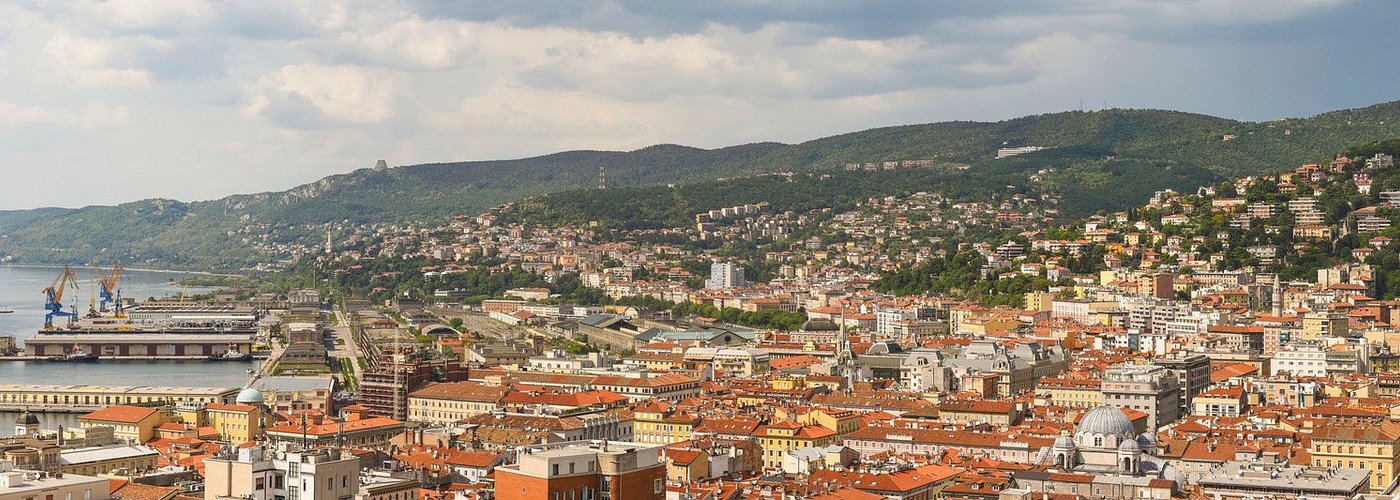
Essential Trieste
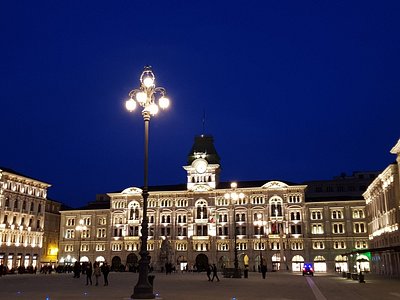
Trending in the forums
Trieste Is Great For
Art & history.
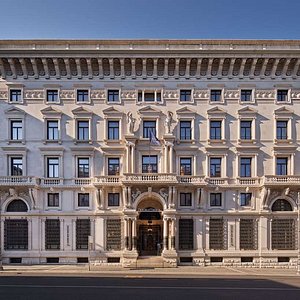
Cultural Tours

Ports of Call Tours

- Savoia Excelsior Palace – Starhotels Collezione
- DoubleTree by Hilton Trieste
- Grand Hotel Duchi D'Aosta
- Hotel Riviera & Maximilian's
- You.me Design Place Hotel
- Pizzeria La Napa
- la Pizza di Cittavecchia
- Osteria El Cassettin
- Bracerie Venete
- Buffet Clai
- Historical Museum of the Miramare Castle
- Beach Barcola
- Kleine Berlin
- Piazza dell'Unita d'Italia
- Strada Vicentina
- Lake Bled and Ljubljana Tour from Trieste
- Postojna Cave & Predjama Castle from Trieste
- Experience Trieste
- Trieste Bus Tour with Audio Guide
- Prosecco Origins Wine Experience

- Trieste: top 10 places to visit
- Places and Tours
10 unmissable places for those who visit Trieste: it's a romantic and lively city, with a multicultural soul, ancient and modern at the same time.

Like any frontier city, Trieste has an undisputed charm and bears the evidence of a complex and interesting history. While not often enough on the main tourism routes for those who visit Italy, the city is certainly worth at least a few days stay. It's definitely a place to be discovered at a leisurely pace, in fact you can easily visit it on foot. Many of the main attractions are within walking distance of each other, in pedestrian areas, and the public transport network is very efficient.
1 - The city center

2 - San Giusto Hill
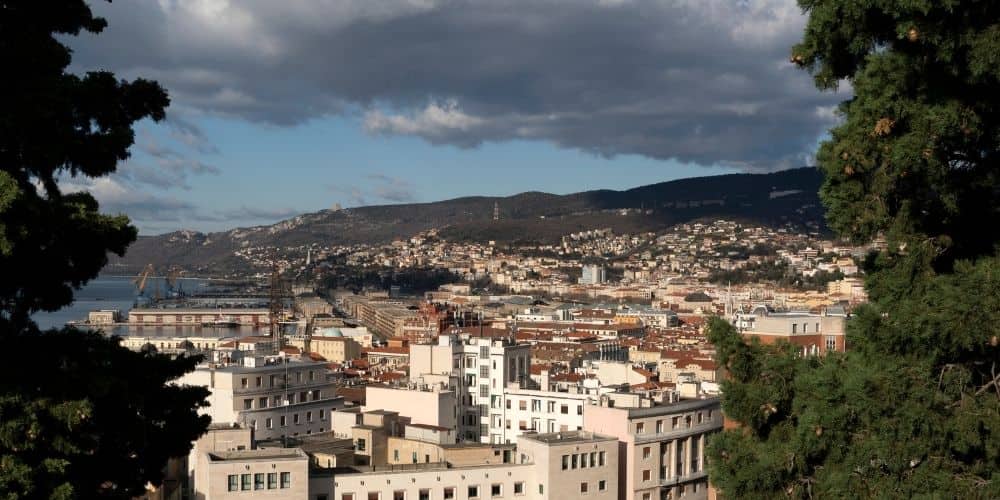
3 - San Giusto Cathedral

4 - Miramare Castle

5 - Duino Castle

6 - Revoltella Museum

7 - The cafes

8 - Risiere of San Sabba

9 - Grotta Gigante
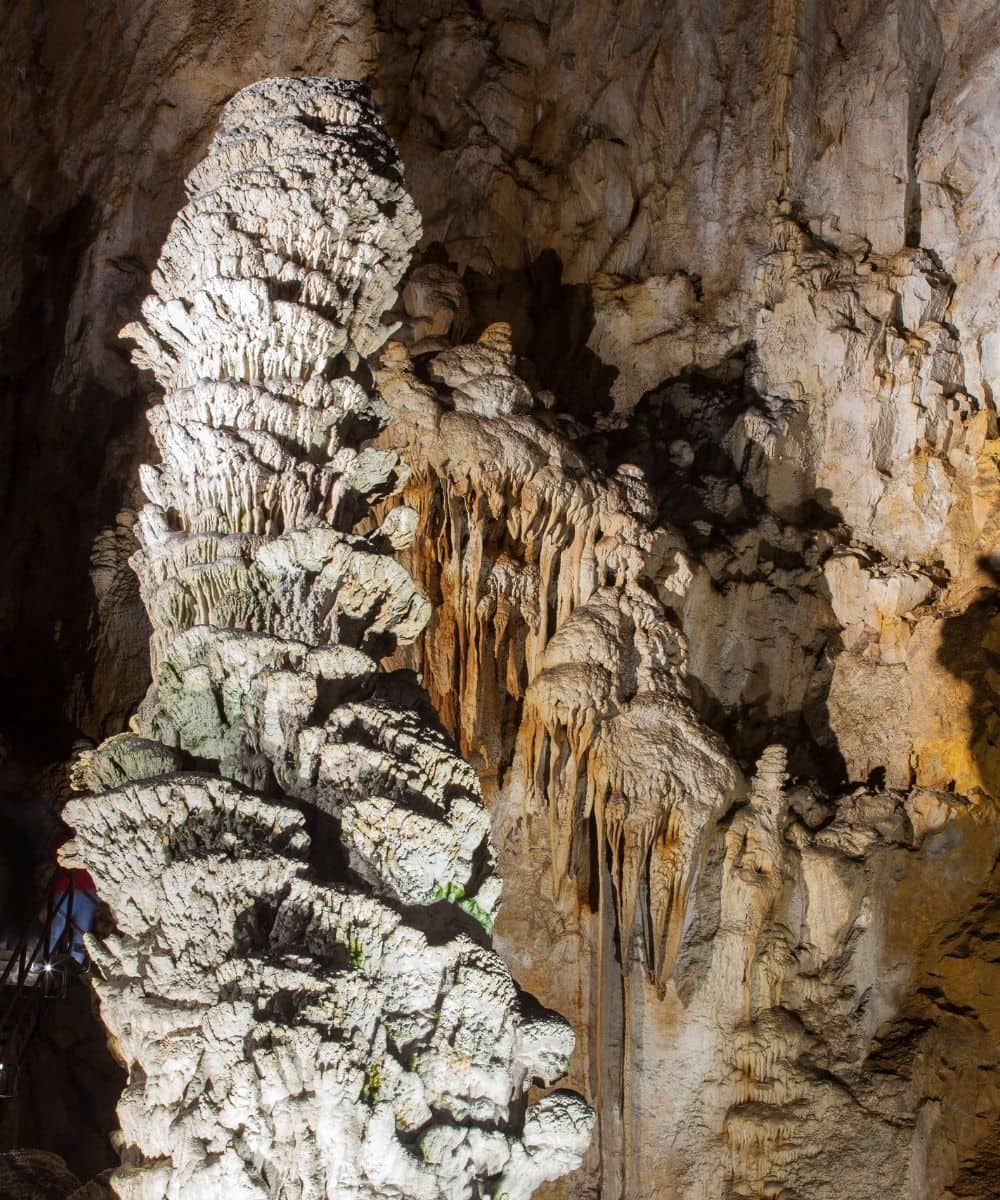
10 - Trieste's Karst
Nature lovers cannot miss the vast plateau that surrounds Trieste. The Karst is made up of valleys and bathing streams, several trekking paths, rock faces much appreciated by sportsmen, and also sinkholes and caves of different sizes. It's a truly unique place, with breathtaking views and cliffs overlooking the sea.
However, human presence has also left traces of historical events, as in the case of the trenches dug by the Austro-Hungarian army, of the Napoleonic road, of the ammunition depots. Anyway, this is also the place where Ladin, Germanic and Slavic culture meet. In fact, there are many small settlements where you can learn about typical local products, customs and folk festivals.
We recommend

- International edition
- Australia edition
- Europe edition

A local’s guide to Trieste: 10 top tips
The Italian port city has blossomed from being a frontier post at the edge of the Balkans into vibrant cultural hub – with excellent seafood
- Trieste’s Barcolana regatta – in pictures
Strada Napoleonica
Discovering Trieste also means discovering The Carso, a steep limestone plateau that follows the Gulf of Trieste and the Slovenia border, is perfect for picnicking, hiking, biking (including e-biking) and rock climbing or just picnicking. There are half-a-dozen trails, but the Strada Napoleonica is the perfect introduction. Take a number 4 bus from Piazza Oberdan to the Opicina obelisk and begin a bracing 5km clifftop hike to the village of Prosecco (it gave its name to what is now one of the world’s most popular wines, though production is now concentrated 100km west in Veneto). Like all Carso hamlets it has an osmiza , a pop-up cantina serving vino for under €1 a glass. Prosecco’s Osmiza Verginella is one of the rare ones open throughout the year, with incredible views down the wild coastline. discover-trieste.it
Trattoria alla Sorgente

Trieste is excellent for seafood lovers, with the freshest produce arriving straight from the Adriatic, cooked simply and at very reasonable prices in the many traditional osterie and trattorie . With its rustic wooden tables and sunny terrace, the friendly Trattoria alla Sorgente is an excellent for lunch choice, but popular with locals, so call first to book. The abundant antipasti misti (€14), with tender octopus, plump scallops, grilled sardines and creamy baccalà is enough for two, while the creative pastas include chunky paccheri (tubes) with baby squid and cherry tomatoes. Closer to the docks are two other top addresses: the lively Osteria Istriano , for alici impanati (€10), tiny breaded anchovies, or the more elegant Trattoria Nero di Seppia , which has a chocolate panna cotta (€6.50) to die for. 2 via della Sorgente, +39 347 939 6519
Il Posto delle Fragole

Another of Trieste’s important symbols of freedom, the Posto delle Fragole (strawberry patch) is a bar, restaurant and cultural centre in the grounds of Trieste’s former psychiatric hospital, in the extensive Parco San Giovanni above the city. Some 45 years ago, this was the first Italian city to end the forced enclosure of mentally ill people, opening the hospital gates to all in the 1970s. Today students attend university courses here, and many of the distinctive pastel-yellow Liberty buildings are venues for the performing arts, cinema, a radio station ( Radio Fragola ), concerts, and late-night summer parties. The park and its famous rose gardens are easily reached on the number 12 bus from the city centre. 4 via de Pastrovich, ilpostodellefragole.eu
Stazione Rogers

Trieste comes alive in the early evening when aperitivo time kicks off, with Aperol and Campari spritz from €3 with free snacks. There are plenty of bars in the old town, but a fun offbeat address is this once-abandoned modernist petrol station – designed in 1953 by Ernesto Rogers, editor of Domus magazine and cousin of Richard Rogers. Today, instead of serving petrol, it serves alternative culture for the city, and is especially popular with Trieste’s large student population. Inside, there is a venue for performances, exhibitions and concerts, while the forecourt is a sprawling outdoor bar overlooking the marina, that stays open till 2am, with DJs and live music. 14 Riva Grumula, stazionerogers.org
Mastro Birraio

The owner of this 35-year-old pub, knowlegeable Daniele Stepancich, showcases a great selection of beer from Italy’s artisan breweries, including Zanna , made in nearby Gorizia. It has eight pumps and a huge range of bottled brews, plus tasty pub grub, from burgers and goulash to locally cured hams, salami and cheeses. Just don’t ask for wine, as this is a beer and spirits-only locale. Wine lovers should head to Enoteca Nanut , a hole-in-the-wall cantina near the canal, with over 50 wines served by the glass. 24 via Felice Venezian, on Facebook
Boat trip to Muggia

A visit to Trieste has to include a boat trip, and a good option is the Delfino Verde ferry that links Trieste and the Venetian port of Muggia. The journey only takes 20 minutes as it hugs the bay towards the frontier with Slovenia, and Muggia is a gem, with its tiny harbour filled with fishing boats. Have a drink at the local watering hole, Ai Fumi, then, further down the street, eat a classic fritto misto at Osteria al Corridoio , owned by Sabrina, whose son Mauro is the fisherman. delfinoverde.it , return trip €7.90
Bagno Alla Lanterna

At this historic public beach, there is proof that a wall does not have to divide but can actually give liberty to people. In a unique Trieste story, male and female bathers are divided by a wall at the tiny Lanterna beach, known popularly as El Pedochin. This may sound sexist and politically incorrect but I can assure you that the opposite is true. A local documentary presented at Cannes in 2016, The Last Resort , explains how the division lets bathers be themselves. Ask anyone here – teenagers, mums with kids, retired people – no one would ever get rid of the wall. The best way to understand is to come and see for yourself. Entrance is a symbolic €1, and of course there is a bar just outside where everyone has lunch or an evening aperitivo together. Molo Fratelli Bandiera 2, sport.comune.trieste.it
Piolo & Max

There is a tradition of after-dinner digestivo all over Friuli, a strong grappa or bitter herbal amaro , but two local wine buffs, Piolo and Max, have dug further into Trieste’s Hapsburg heritage to create their own unique liqueurs by infusing local grappas and fruit brandies with magical recipes of plants, herbs and spices. Like medieval alchemists, they have a workshop/laboratory cluttered with hundreds of jars and steel containers of weird and wonderful botanicals. What started off as a dare has turned into an artisanal success story, and their minuscule store and tasting bar in the town centre stocks tipples from lemon, ginger, absinthe, coriander, chilli and camomile infusions to Newtella, a light chocolate milk-based liqueur, from €10 a bottle. 11 via Felice Venezian, pioloemax.it
Da Giovanni

No one should visit Trieste without experiencing an authentic buffet , a tradition dating back to when the city was under Austrian rule. A buffet is a temple to pork, with roast hams, boiled pork loin, smoked sausage and giant mortadellas heaving on ancient marble bars. There are a dozen locales around town but Da Giovanni is a special place, where I always bring my class for a celebratory end-of-year party. Here architects and judges sit next to students and building workers at long communal tables, talking in Triestine dialect rather than Italian, and tucking into a €3.50 crusty roll of cooked ham covered with grated horseradish accompanied by a foaming beer or local wine straight from the barrel at €1 a glass. 14 via San Lazzaro, trattoriadagiovanni.com
Faro della Vittoria

Our historic lighthouse is an emotional icon for me, as when your boat turns the corner of the coastline, the sight of the it is the first sign that you are coming home. The Barcolana regatta and the Faro are inseparable, as the race begins in the waters around the lighthouse. But few visitors realise that, though it is run by the Italian navy, the lighthouse is open to the public at weekends, free of charge, including a guided tour. The panorama is exceptional, stretching across the sea to Slovenia and Croatia. This is a genuine frontier city, with a history of families divided by international borders, but today, the lighthouse has become a symbol of liberty. 141 strada del Friuli farodellavittoria.it
Mitja Gialuz is a world champion yachtsman, law professor at Trieste University and president of Trieste’s Barcolana regatta
At a glance
Getting there Ryanair flies to Trieste from Stansted. Venice’s two airports are within 150km.
When to go Spring, summer and autumn are best: winters can be windy and cold. The town holds regular festivals including a Sardine festival with live bands every night (until 19 August), and the spectacular Barcolana regatta , which attracts about 25,000 sailors each year and is celebrating its 50th year on 14 October 2018.
Stay Aria Marina is a converted palazzo in the old town with two apartments and one double from €50 room-only. Round the corner the chic Urban hotel has doubles from €96 B&B.
Looking for a holiday with a difference? Browse Guardian Holidays now to find a range of fantastic trips
- Italy holidays
- A local's guide
- City breaks
- Weekend breaks
- Food and drink
- Europe holidays
- Short breaks
Comments (…)
Most viewed.
Valentina's Travel Guide
Where to find everything you need to plan your next vacation
How to Plan a Trip to Trieste for the First Time
Updated: Sep 9, 2023

If you plan to visit the beautiful city of Trieste , you are in the right place. In this article, I will give you all the tips & info you need to know before starting to plan your trip to Trieste, one of the most beautiful cities in Italy .
Trieste is my home town, so I know a lot about it, from when to visit Trieste to enjoy the most of it, how to move around Trieste ( the city center is walkable so no need to use any transport, but I'll give you info about them too anyway ), how to visit Trieste if you have only one day, what to see and do and where and what to eat .
After all, what is a trip without tasting all the local food? ( This is one of the main reasons I travel; is it yours too? )
Trieste is a beautiful destination spot, and its demand is growing ( maybe thanks to all my articles? Well, it's my hometown, and I obviously wish everyone would visit it ).
The question is: Do you want to know everything about how to plan a trip to Trieste? Well, that’s exactly what you will learn in this article. Make sure to read it till the end!
So, let's start planning your trip to Trieste!
Please sit back, relax, get a cup of coffee ( or a hibiscus tea, my favorite ), and let me help you plan the best trip to Trieste!
*This post contains affiliate links. I receive commissions for purchases made through those links at no extra cost to you. Please understand that I have experience with all of these companies, and I recommend them because they are helpful and valuable, not because of the small commissions I make if you decide to buy something.

Is Trieste worth visiting?
It's absolutely worth visiting Trieste in Italy, and I'm not saying it only because I grew up in Trieste.
Trieste is a beautiful city with stunning Adriatic sea views from the main square, Piazza Unita' d'Italia, from the top of the hill at San Giusto Castle, or from the long promenade called Barcola.
Trieste will surprise you with its intense Bora wind, sweeping you from your feet and making you fly like Mary Poppins ( don't worry, it doesn't blow every day ).
In Trieste, you will find delicious fresh fish and local cuisine made of Italian and Austro-Hungarian recipes.

What is Trieste Italy known for?
Trieste is a mix of cultures that create a wonderful city full of stunning buildings, hospitable locals, delicious wines, relaxed atmospheres, unmissable museums, and much more for travelers who can't wait to explore and learn everything about it.
Obviously, I am biased about Trieste because it is my hometown. But if you don't believe me, you must check out my " The most complete guide of Trieste " to see if my words are true ( they are, and you will thank me for all the info I will give you ).
If you are visiting Trieste because you will embark on a cruise starting from my beautiful city, take advantage of the opportunity to visit Trieste for at least one day.
Hi! I’m Valentina,
I help people plan the most organized trip of their life by providing all the necessary information and tips. Be part of my FREE VIP AREA to receive weekly travel discounts, itineraries, packing checklists, and more.

How many days in Trieste is enough?
Trieste city center is pretty small so if you have only one day to explore it, you can easily see the main attraction in Trieste.
If you wish to visit some museums in Trieste, like the San Giusto Castle , the beautiful Miramare Castle , the Revoltella museums with all its antiques, and the museum dedicated to the life of the famous writer James Joice , you will need at least three days in Trieste. There are many things to do in Trieste .
NO TIME TO READ IT NOW?
Save it for later!
Don't forget there are plenty of beautiful places to visit around Trieste, like the Giant Cave , the Collio region where to drink delicious wine, and also many other cities in Italy, like a day trip to Venice , to Slovenia's capital Ljubljana or the small fisherman's town of Piran ( also in Slovenia ).
There are plenty of stunning destinations to see during a day trip from Trieste , so before deciding how many days to spend in this incredible city, have a look at what to do in Trieste to make a list of all the places you wish to see and activities you want to do and to all the fabulous day trips from Trieste.
There are so many things to do and places to see you will stay longer than you thought.

Embaring a cruise that start in trieste?
Check out these helpful articles I wrote for you:
28 Top-rated Hotels near Trieste Cruise Port
The Ultimate Trieste Cruise Port Guide
How to Visit Trieste in One Day
TABLE OF CONTENTS:
Essential things to know about visiting Trieste
Booking an accommodation in Trieste
How to get to trieste, cost of visiting trieste, how to move around trieste, drinking and eating out in trieste, shopping and souvenirs in trieste, is trieste safe, tours and activities in trieste.
Important telephone numbers
If you like this article, share it with your friends; maybe someone you know is planning to visit Trieste.
*All links in every article open on a new page, so you will stay on this page while looking around!
How to plan a trip to Trieste like a pro

Essential things about visiting Trieste
What is the time zone in trieste.
Trieste, Italy, is in the Central European Time Zone, GMT +1. Italy observes daylight-saving in summer, advancing time by 1 hour to GMT +2. The changes happen on the last Saturday of March and October.
What is the best time to visit Trieste?
Trieste can be visited in every season, it depends on what you wish to get from your vacation in Trieste. There are always plenty of things to see and do in Trieste in every season. If you want to enjoy sunny days without the crowds of tourists, April, May, and September are the perfect months.
If you want to spend some time on one of Trieste's beaches, June, July, and August are your months, but be aware that Trieste can be very hot during summer, with the highest temperature reaching 38°/100F, so not so pleasant for walking all day.
If you wish to visit Trieste on a budget, months like October, November, and March could be perfect.
I would honestly avoid visiting Trieste in December ( unless you want to see the Trieste Christmas markets ), January, and February when the Bora wind is at its peak, and it can rain or snow the whole day.

What is the language spoken in Trieste?
The main language spoken in Trieste is Italian. Most locals speak the Trieste dialect, called "Triestino." In Trieste, there is a mix of cultures with people from Greece, Austria, Slovenia, and Serbia.
Wish to learn some sentences in Italian before your trip to Italy? Check out Duolingo , the free app I use to learn a new language.
What is the currency used in Trieste?
Trieste is in Italy, so the currency used is Euro.
Is it easy to find ATMs in Trieste?
You can find ATMs very easily in Trieste. Remember that many ATMs in Italy are inside the bank, so if you need to withdraw money when the bank is closed, you will need a card with a magnetic stripe to enter the bank's ATM.

Which credit cards to use in Trieste?
Almost all credit cards are accepted in Trieste. Having a Visa or Mastercard would be better because American Express or Discover might not be accepted everywhere. Remember to ALWAYS have some cash with you when in Trieste. Not every place accepts a card payment, and many shops have a minimum spend of € 5-10.
When traveling, I always use my Revolut Card , the best pre-paid travel card to use abroad! Learn here about Revolut !
Do I need vaccinations to visit Trieste?
You do not need to get any vaccinations to visit Trieste in Italy. But if you prefer to check it out, you can always consult the Vaccination Requirements for Italy.

Do I need Travel insurance to visit Trieste?
You cannot leave home for a trip without booking a good travel insurance!
I always get my travel insurance on VisitorsCoverage for short trips up to a few weeks, while SafetyWings is the best travel insurance for longer trips.
Is there a Visa Requirement to visit Trieste, Italy?
If you come from outside Europe, you might need to apply for a Visa to visit Italy . Check on Italy Visa requirements to make sure to apply for it as soon as you book your flight ticket!
What are the Voltage and adaptors needed in Trieste?
The standard voltage used in Trieste is 220-240 volts, with most sockets using European plugs of the two round-pin varieties. If you come from outside Europe, your appliances will require a voltage converter and plug adaptor to function properly.
If you frequently travel to Europe and need to use hair styling tools, purchasing a travel hair dryer and a travel curling iron is recommended so you will always have them for your next adventures!

Is it easy to find Wifi in Trieste?
You will find free wifi in Trieste in most bars and restaurants, all hotels, and on some new buses.
If you wish to always have data with you to be able to connect with your family and friends or to post your pictures on your social media, I advise you to purchase an eSim Card for Italy , as I always do when I visit my family in Trieste.
Are there any luggage storages in Trieste?
If you arrive in Trieste too early for check-in or cannot leave your luggage at your accommodation after your check-out and want to explore the city during these free hours, you can always leave your luggage at a Luggage Storage in Trieste .
When traveling, remember to always use an anti-theft backpack ( see that one I use here ) to keep your valuables safe, a TSA-approved cable luggage lock for your luggage, and please never forget to add to all your bags luggage tags ( I just bought these ones for me and Lajos ).
Hello! I'm Valentina.
I specialize in helping people plan their trips with ease and organization. Join my FREE VIP AREA to receive exclusive weekly travel discounts, detailed itineraries, helpful packing checklists, and much more to make your next trip the best one yet!

Trieste is a very popular city so you will find accommodations for every budget. Check out my best hotels in the city center ( and near the cruise port ) to chose the right accommodation for your next adventure, to be right in the middle of the city, only a short walk from all the most famous sights, or the top rated accommodations in Trieste for every budget.

You can reach Trieste by flying to Trieste Airport, which is well-connected to many European capitals and other Italian cities ( see flight connections from your airport ).
You have multiple options for transportation from Trieste Airport to the Port of Trieste Cruise Terminal.
By taxi: One of the most convenient ways is to take a taxi or arrange a private transfer . Taxis are readily available outside the Trieste airport terminal. The journey to the cruise port costs €60 and takes approximately 30 minutes, depending on traffic.
By bus: Alternatively, you can opt for a shuttle service , which provides a cost-effective and hassle-free transfer between the airport and the cruise port. These shuttle services operate regularly, offering comfortable transportation for passengers with luggage to Trieste Autostazione ( bus station ) or Trieste Cruise Port.
By train: A train stops at Trieste Airport thrice per hour and will take you to Trieste Centrale Train Station. See train schedules from Trieste Airport to Trieste Centrale here .
You are in luck, like always, and in my Trieste Cruise Port Guide , I have a complete guide on how to reach the Trieste city center from every airport in the region and even from Treviso and Venice Airports.
Read it now or bookmark it for later!
I hope you will always have a safe flight and never have to experience a flight delay, but in case it happens, Airhelp and Compensair are the websites I used when I had a flight delay and asked for some compensation.
Check them out!

Is Trieste expensive to visit?
Trieste is becoming a very popular Italian destination, but you can visit it with any budget, thanks to the info and tips I provide in my Trieste Travel Guide .
There are plenty of hotels for every type of traveler, from hostels where to meet other young travelers, budget hotels with breakfast included right in Trieste's old town, some gorgeous Boutique Hotels to visit the city in style, and some pretty new luxury hotels to have the vacation of your dreams.
Looking for the perfect hotel in Trieste?
I can help you with that, see the best hotels in Trieste city center for every budget!

Is Trieste Italy walkable?
Trieste city center is pretty small so you can easily visit it just by walking around. Only to reach San Giusto Castle you will have to walk up a hill, but you can always catch the bus 24.
Visit Trieste by bus:
Trieste has a dense bus network that is well-connected in every ward. See Trieste bus tickets prices .
If you prefer to move by bus around Trieste, remember you can pay for your ticket on the bus with a debit/credit card and see bus routes on your Google Maps.
If you want to explore the area around Trieste, renting a car to move freely is the best solution.

Hire a Taxi in Trieste:
Trieste taxis have a metered kilometer rate. The first click of the taximeter device is valid for the first 83.3 meters: € 3.50
For each subsequent 83.3 meters: € 0.10. It is pretty affordable, and in case you cannot find one straight away, call them at Trieste Radio Taxi (0039-30-77-30), and someone will come to pick you up, or they will tell you where to find the closest one.
If you don't speak Italian and prefer an app, download Radio Taxi Trieste .
Travel Tip: Do you see those two letters on the taxi's back window? ( see picture above ). AP means this taxi accepts card payments.
Move outside Trieste by Ferry:
There is a lovely way to visit the charming sea village of Muggia or get to Barcola, Grignano, and Sistiana for a swim or just a walk along the waterfront.
You can catch the Delfino Verde ferry on the left side of the Stazione Marittima (Molo dei Bersaglieri 3, 34123 Trieste) check out time schedule and prices here.
If you like my content, remember that I covered many destinations worldwide, and I keep adding more content weekly. So, let's keep in touch. SUBSCRIBE TO MY FREE VIP AREA to receive weekly updates about new destinations. Let's become friends!

What food is Trieste famous for?
One of the most famous dishes in Trieste is the soup Jota, made with sauer krauts, potatoes, beans, and pork meat, and it is Lajos's favorite I make it for him every winter.
Trieste offers many local dishes, from Austro-Hungarian to classic Italian dishes to delicious fresh fish that local chefs prepare dayly in the local restaurants.
There are also many local cakes you will love to taste, like the Pinza, Presnitz, Putizza, and much more. Read all the local food you have to try in Trieste !

Are tap water and food safe in Trieste?
Drinking water in Trieste from taps is safe, mainly because the water comes from the Alps and is very pure and tasty. You can bring your reusable water bottle and refill it at any fountains you can find around the city.
Honestly, Trieste has so much delicious food to offer that the only problem you will have is that your stomach needs to be bigger to eat everything you wish.
Food and drinks prices in Trieste:
Prices may vary from bar to restaurant also from where the place is located if near a famous, and tourist spot or a bit further, but these are the approximate prices for the most common foods and drinks in Trieste:
In Trieste supermarkets:
Bottle 1.5 L water: around 0.40-0.50 Euro
Beer 0.33 L: approximately 1.50 Euro
Bottle of Wine: 5-10 Euro
In a Trieste Bar:
Coffee-latte: 1.50 Euro
A glass of 0.5 L Beer: around 1.50-2.00 Euro
A bottle of wine: 12-20 Euro
Coke in a can: Around 2.00-2.50 Euro
A glass of wine: Around 3.50-6.00 Euro
At a Restaurant in Trieste:
Restaurant on a budget per person: Around € 15
Restaurant medium-range per person: Around € 30-40
Fine dining Restaurant per person: From € 80

There are many food activities to enjoy in Trieste, from cooking classes , to local Aperitivo to wine tastings tours , there is something for everyone to enjoy the Italian food like every travelers wish to do when visiting Italy.
Tipping guide in Trieste:
A gratuity of 10-20% in Italian restaurants is often added to the bill, so check that you still need to pay the tip before you add more to your payment.
If not, a 10-15% tip is encouraged, mostly in tourist places. The tip should reflect the customer service you received, so it is up to you to decide how much to give.
Hey Traveler!
If you enjoy this article and find it helpful, can you do me a quick favor and share it on your socials? I’d love to know that you are enjoying my content and that this is helping you!
Thank you from your super-organized travel blogger!

If you love shopping, Trieste will surprise you with many shops of the best Italian clothes, shoes and anything else you might want to buy.
The most famous shopping streets in Trieste are Corso Italia, via Mazzini, via San Nicolò, via Roma, via Carducci, and via Battisti.
There are many things to buy in Trieste as a souvenir for yourself or a gift for your family and friends. Read my what to buy in Trieste article to learn everything about the best handmade items and local food to purchase in Trieste.

Is Trieste safe for a solo woman traveler?
Trieste is pretty safe during the day with tourists and locals around the streets; the only thing you must worry about are pickpockets that, unfortunately, can be present in every tourist city.
So I advise having with you an antitheft purse or an antitheft backpack . Prudence is never enough when you are far from home, even in the safest place in the world.
Overnight I advise a solo woman traveler to keep her guard up at all times because bad things can happen anywhere, anytime, to anybody, so please take safety first.
During my solo travels, I always contacted local ladies through travel Facebook groups, and I have been lucky to meet people who took me around and showed me their city, so I felt pretty safe being out late in the evening because I wasn't alone.

In Trieste, there is a wide range of activities to choose from. You can take a walking tour of the city center , to explore its rich history and architecture.
If you're a wine lover, you can also book a wine-tasting tour in Trieste or discover the flavors of the Collio region . To taste the local cuisine, you can have an aperitivo with a local and try the delicious delicacies and wines.
If you prefer a more personalized experience, you can opt for a private guided tour of the city . Additionally, guided day trips are available to nearby destinations that are just a few hours away, allowing you to explore even more wonderful places.

Important telephone numbers in Trieste
European Emergency Number 112 ( they will direct you to the number you need )
General Emergency 113
Police ( polizia )
Financial Police ( guardia di finanza ) 117
Medical Emergency ( emergenza medica ) 118
Fire Brigade ( vigili del fuoco ) 115
Forest Fire Brigade ( guardia forestale ) 1515
Coast Guard ( guardian costiera ) 1530
Road Assistance ( soccorso stradale ) 803116 from an Italian phone and 800 116 800 from a foreign mobile.
Before you go...
If you're planning a trip to Trieste, it's important to plan ahead and book everything in advance to ensure you have the best experience.
Trieste is becoming increasingly popular among both Italians and foreigners, and this makes me very proud of my beautiful hometown, but it's best to secure your accommodations, activities, and transportation early to avoid any sold-out situations ( being a super-organized traveler means plan as much as possible in advance ).
By following my tips and gathering all the necessary information I wrote in this article, you'll be well-prepared for your trip to Trieste.
Don't forget to read my other articles about Trieste:
The complete Trieste travel guide
Where to eat local in Trieste
What are the local dishes in Trieste
Best accommodations in the heart of Trieste
What are the top-rated hotels in Trieste for every budget
Best tours and activities to do in Trieste
Best gifts and souvenirs from Trieste
Unmissable day trips only 2 hours from Trieste
The complete Trieste cruise port guide
How to spend one dy in Trieste
Your super-organized travel blogger
Xoxo Valentina
SAVE IT FOR LATER
Did you enjoy my article?
I have plenty like this one about visiting Trieste.
Feel free to comment below if you have any questions and share this article with your friends ( it would really make my day ). Maybe someone you know is planning to visit Trieste.
Also, don't forget to check out my VIP AREA to see all the itineraries, packing checklists, and much more available for you for FREE!
Psst: Don’t forget to share this article with your friends.
The sharing links are below
Related Posts
Visit Trieste: 42 Best Things to Do in Trieste
28 Best Day Trips from Trieste: Explore the Best Destinations Only 2 Hours Away
Trieste Food Guide: 45 Delicious Food and Drinks to Try in Trieste
TRAVEL RESOURCES to plan your next trip
Find a cheap flight via skiscanner, find a hotel via booking.com, find a rental car via rentalcars, get a travel insurance via safetywing, book tours & attractions via getyourguide, book bus/train via omio, click here for more....

Hi! I'm Valentina,
but you can call me Vale.
I'm an Italian with a passion for well-planned travels and food.
In my Travel Guide, you will find everything you need to plan your perfect travel around the world.
.jpg)
Unmissable Local restaurants Where to Have the Best Dinner in Rome

How to Reach Barcelona From The Airports

Everything You Need to Know Before Visiting Barcelona

IMAGES
VIDEO
COMMENTS
Plan your days of sightseeing in and around the city with our list of top attractions and things to do in Trieste. See also: Where to Stay in Trieste. On This Page: 1. Piazza dell'Unità d'Italia. 2. Castello di Miramare. 3. Castello di San Giusto.
1. Piazza dell'Unita d'Italia. 8,767. Points of Interest & Landmarks. Seaside square framed by grand Austro-Hungarian architecture, ideal for leisurely strolls, people-watching, and enjoying a coffee with views of the gulf. Rich in history and culture. See ways to experience (15) 2023.
The Museo Del Mare is a great place to visit whilst down at the Harbor to gain and insight into the history of Trieste. 10. Carso Triestino Source: turismofvg Carso Triestino. This area of Trieste lies in close proximity to the Val Rosana and is a fantastic place to admire the scenery and take some stunning photographs.
How to visit Trieste and travel around. Download the FVG Mobile app. Trieste Airport is about 35km from the city and offers direct connections to 14 destinations in Italy and Europe, including Rome, ... 27 Top things to do in Trieste. When it comes to tourist attractions, Trieste has many activities to enjoy. ...
A Brief History of Trieste. 23 Things to Do in Trieste. 1) Spend a Day in Osmiza. 2) Explore Piazza Unità d'Italia. 3) Taste the Cuisine of Trieste. 4) Walking on the Molo Audace. 5) Stop in One of the Historic Cafés. 6) Walking Along the Grand Canal. 7) Drink a "Capo in B".
PRICE: €126. Explore the Prosecco Region! 2. Visit Predjama Castle and Postojna Cave. Another one of the best day trips you can take from Trieste is definitely to visit the 800-year-old Predjama Castle, the only preserved cave castle in Europe, and to the Postojna Cave, the best-known giant cave in the world.
Trieste, located on a thin strip of Italy sandwiched between Slovenia and the Adriatic Sea, is a fascinating place to visit. A melting pot of multiple cultures, Trieste is the capital of the Friuli Venezia Giulia region in northeastern Italy and boasts a rich history.
6. A walk along Molo Audace: The Molo Audace is located on the banks of Trieste, in the city's center, near Piazza Unità d'Italia. The name "Molo Audace" was given after the first boat that entered the port of Trieste after the First World War. From it, you can take amazing pictures of the Piazza Unita' d'Italia.
Top Things to Do in Trieste, Italy: See Tripadvisor's 195,004 traveller reviews and photos of Trieste tourist attractions. Find what to do today, this weekend, or in April. We have reviews of the best places to see in Trieste. Visit top-rated & must-see attractions.
One of the most picturesque (and Instagrammable) places to visit in Trieste is Canal Grande, located halfway between the train station and Piazza Unità d'Italia. It dates back to the mid-18th century and was built to help the boats delivering goods arrive closer to the center to unload. Originally, the canal was even longer than today ...
Trieste. Italy, Europe. Tumbling down to the Adriatic from a wild, karstic plateau and almost entirely surrounded by Slovenia, Trieste is physically and psychologically isolated from the rest of the Italian peninsula. As such, it preserves its own unique border-town culture and retains a fascinating air of fluidity encapsulated in the Triestini ...
San Giusto Castle is a beautiful castle located in Trieste, Italy. The views from the castle are amazing and definitely worth a visit. The castle is also home to a museum which is definitely worth checking out. P.za della Cattedrale, 3, 34131 Trieste TS, Italien. www.castellodisangiustotrieste.it.
Although it is one of the more overlooked attractions in Trieste, the Synagogue of Trieste (Tempio Israelitico di Trieste) warrants a visit. Capable of accommodating up to 1,200 worshippers, it is one of the largest synagogues in Europe. The imposing synagogue was built in 1912 and is a testament to Trieste's once significant Jewish community.
2. Historical Museum of the Miramare Castle. 6,569. Historic Sites. Admission tickets from HK$156. The Miramare Castle and Park were commissioned by Archduke Maximilian of Hapsburg who decided — around 1855 — to build a residence worthy of his name and rank outside of Trieste, looking out to the sea and surrounded by a wide garden. The Park ...
The traditional 19th-century theater that is a symbol of Trieste It is Trieste's main opera and ballet theater. Among the oldest spaces still in activity, the theater dates back to 1800, its structure consisting mainly of 2 auditoriums, the Sala del Teatro Verdi and the Sala Ridotto. It copies the architecture of the Teatro alla Scala in ...
As many tourist attractions in Trieste are within walking distance from here, they are very convenient spots to stay when visiting town. One such place is the superb Hotel Solun, just a stone's throw from the canal and seafront. Very chic and stylish, the vintage-inspired four-star hotel has clean, comfortable rooms and spacious suites for ...
On weekends and holidays, the train is closed. See full details. 2023. 5. Cattedrale di San Giusto Martire. 1,784. Churches & Cathedrals. By dittehejberg. It is close to the city center, but visit in the not-so-hot hours of the day as it is a steep hike up.
1) 5 P.M. Time Travel. Your crash course in history begins at the Roman amphitheater on Via del Teatro Romano. From there, ascend the staircase and steep streets to the hilltop Castello di San ...
Trieste is a beautiful city with many attractions, such as Piazza Unità d'Italia, Trieste Cathedral, and the nearby Miramare Castle. If you want to fully immerse yourself in the city and visit all the major attractions, we recommend spending at least 2-3 days in Trieste.
About Trieste. With an enviable perch between the Adriatic Sea and Slovenia's peaks, Trieste is an Italian city whose food, architecture, and history have Eastern soul. Add coastal castles to sun-soaked beach resorts, and you have one of Europe's most cultured seaside getaways. Frequently Asked Questions about Trieste.
9 - Grotta Gigante. A few kilometers from Trieste there is a cave that is giant in name and in fact. Inside there is a room 280 meters long and 114 meters high, which is indeed the largest natural room in the world, also included in the Guinness Book of Records. The cave dates back to at least one million years ago and has three entrances, two ...
Mitja Gialuz is a world champion yachtsman, law professor at Trieste University and president of Trieste's Barcolana regatta. At a glance. Getting there Ryanair flies to Trieste from Stansted ...
Prices may vary from bar to restaurant also from where the place is located if near a famous, and tourist spot or a bit further, but these are the approximate prices for the most common foods and drinks in Trieste: In Trieste supermarkets: Bottle 1.5 L water: around 0.40-0.50 Euro. Beer 0.33 L: approximately 1.50 Euro.